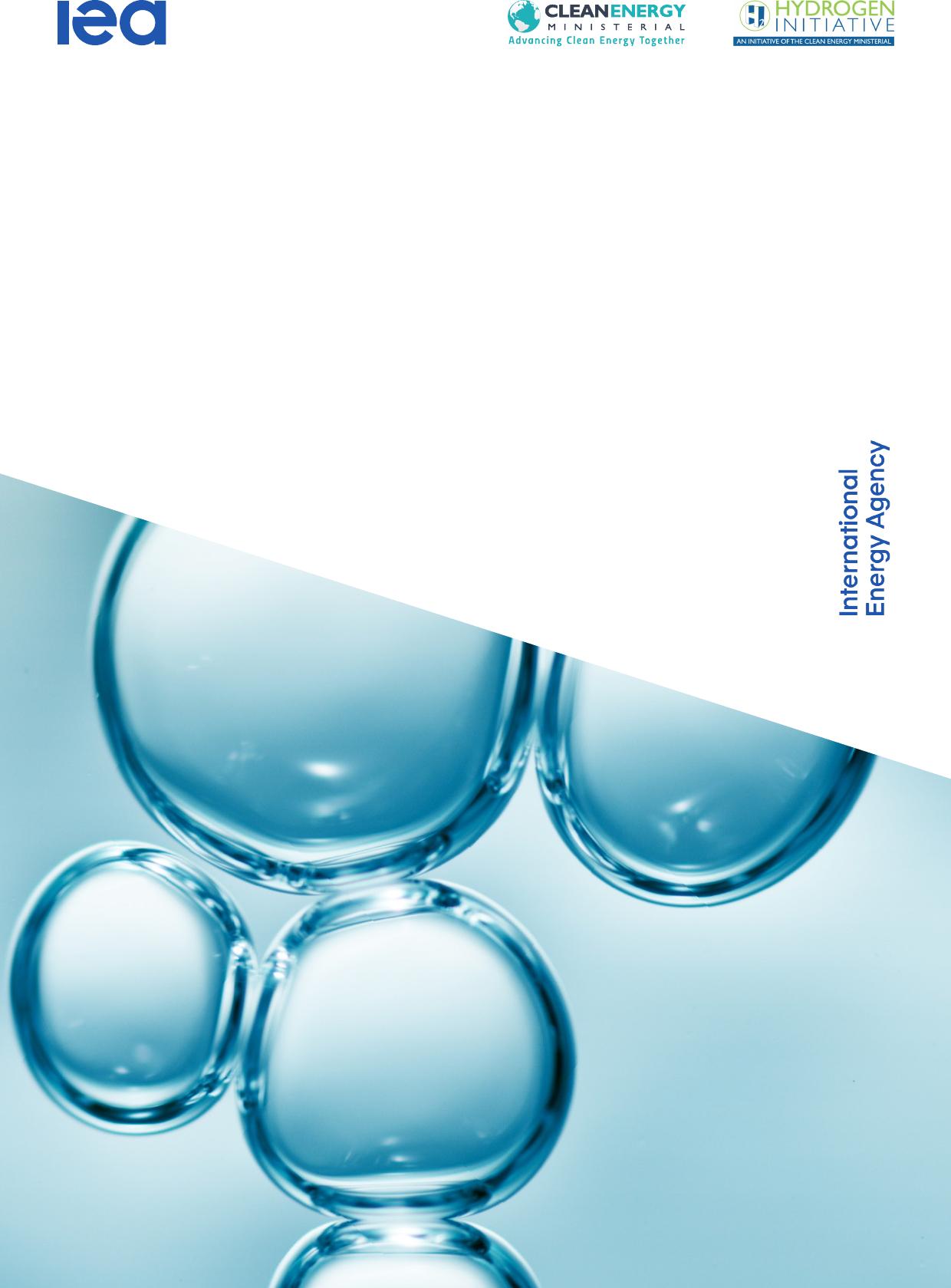GlobalHydrogenReview2023TheIEAexaminesthefullspectrumofenergyissuesincludingoil,gasandcoalsupplyanddemand,renewableenergytechnologies,electricitymarkets,energyefficiency,accesstoenergy,demandsidemanagementandmuchmore.Throughitswork,theIEAadvocatespoliciesthatwillenhancethereliability,affordabilityandsustainabilityofenergyinits31membercountries,13associationcountriesandbeyond.Thispublicationandanymapincludedhereinarewithoutprejudicetothestatusoforsovereigntyoveranyterritory,tothedelimitationofinternationalfrontiersandboundariesandtothenameofanyterritory,cityorarea.Source:IEA.InternationalEnergyAgencyWebsite:www.iea.orgIEAmembercountries:AustraliaAustriaBelgiumCanadaCzechRepublicDenmarkEstoniaFinlandFranceGermanyGreeceHungaryIrelandItalyJapanKoreaLithuaniaLuxembourgMexicoNetherlandsNewZealandNorwayPolandPortugalSlovakRepublicSpainSwedenSwitzerlandRepublicofTürkiyeUnitedKingdomUnitedStatesTheEuropeanCommissionalsoparticipatesintheworkoftheIEAIEAassociationcountries:ArgentinaBrazilChinaEgyptIndiaIndonesiaKenyaMoroccoSenegalSingaporeSouthAfricaThailandUkraineINTERNATIONALENERGYAGENCYGlobalHydrogenReview2023AbstractPAGE3IEA.CCBY4.0.AbstractTheGlobalHydrogenReviewisanannualpublicationbytheInternationalEnergyAgencythattrackshydrogenproductionanddemandworldwide,aswellasprogressincriticalareassuchasinfrastructuredevelopment,trade,policy,regulation,investmentsandinnovation.ThereportisanoutputoftheCleanEnergyMinisterialHydrogenInitiativeandisintendedtoinformenergysectorstakeholdersonthestatusandfutureprospectsofhydrogen,whilealsoinformingdiscussionsattheHydrogenEnergyMinisterialMeetingorganisedbyJapan.Focusingonhydrogen’spotentiallymajorroleinmeetinginternationalenergyandclimategoals,theReviewaimstohelpdecisionmakersfine-tunestrategiestoattractinvestmentandfacilitatedeploymentofhydrogentechnologiesatthesametimeascreatingdemandforhydrogenandhydrogen-basedfuels.Itcomparesreal-worlddevelopmentswiththestatedambitionsofgovernmentandindustry.Thisyear’sreportincludesafocusondemandcreationforlow-emissionhydrogen.Globalhydrogenuseisincreasing,butdemandremainssofarconcentratedintraditionalusesinrefiningandthechemicalindustryandmostlymetbyhydrogenproducedfromunabatedfossilfuels.Tomeetclimateambitions,thereisanurgentneedtoswitchhydrogenuseinexistingapplicationstolow-emissionhydrogenandtoexpandusetonewapplicationsinheavyindustryorlong-distancetransport.GlobalHydrogenReview2023Acknowledgements,contributorsandcreditsPAGE4IEA.CCBY4.0.Acknowledgements,contributorsandcreditsTheGlobalHydrogenReviewwaspreparedbytheEnergyTechnologyPolicy(ETP)DivisionoftheDirectorateofSustainability,TechnologyandOutlooks(STO)oftheInternationalEnergyAgency(IEA).ThestudywasdesignedanddirectedbyTimurGül,ChiefEnergyTechnologyOfficerandHeadoftheEnergyTechnologyPolicyDivision.UweRemme(HeadoftheHydrogenandAlternativeFuelsUnit)andJoseMiguelBermudezMenendezco-ordinatedtheanalysisandproductionofthereport.LauraCozzi,DennisHesseling,PaoloFrankl,TimGould,KeisukeSadamori,HiroSakaguchi,andAraceliFernandezPalesprovidedvaluable,strategicguidanceduringthereport’sdevelopmentprocess.TheprincipalIEAauthorsandcontributorswere(inalphabeticalorder):PraveenBains(hydrogen-basedfuels),SimonBennett(investment),LeonardoCollina(industry),ElizabethConnelly(transport),ChiaraDelmastro(buildings),StavroulaEvangelopoulou(productionanddatamanagement),MathildeFajardy(CCUS),AlexandreGouy(industry),MegumiKotani(policy),Jean-BaptisteLeMarois(innovation),PeterLevi(industry),RafaelMartinezGordon(buildings),ShaneMcDonagh(transport),FrancescoPavan(production,tradeandinfrastructure),AmaliaPizarro(trade,infrastructureandinnovation),NoahSloots(buildings)andChristophWinkler(production).ThedevelopmentofthisreportbenefittedfromcontributionsprovidedbythefollowingIEAcolleagues:AnaAlcaldeBascones,CarlGreenfield,IlkkaHannula,LucaLoRe,JenniferOrtiz,andNikooTajdolat.LizzieSayereditedthemanuscriptwhileLiselottFredriksson,AnnaKalistaandPer-AndersWidellprovidedessentialsupportthroughouttheprocess.ThanksalsototheIEACommunicationsandDigitalOfficefortheirhelpinproducingthereport,particularlytoCurtisBrainard,PoeliBojorquez,JonCuster,AstridDumond,MerveErdil,GraceGordon,JethroMullen,IsabelleNonain-Semelin,JuliePuech,LucileWall,ThereseWalshandWonjikYang.TheworkcouldnothavebeenachievedwithoutthefinancialsupportprovidedbytheGovernmentsofAustralia,Canada,Germany,andJapan.ThefollowinggovernmentshavealsocontributedtothereportthroughtheirvoluntarycontributiontotheCEMHydrogenInitiative:Australia,Austria,Canada,Finland,Germany,theEuropeanCommission,theNetherlands,Norway,theUnitedKingdomandtheUnitedStates.GlobalHydrogenReview2023Acknowledgements,contributorsandcreditsPAGE5IEA.CCBY4.0.Specialthanksgotothefollowingorganisationsandinitiativesfortheirvaluablecontributions:AdvancedFuelCellsTechnologyCollaborationProgramme(TCP),EuropeanPatentOffice,HydrogenCouncil,HydrogenTCPandtheInternationalPartnershipforHydrogenandFuelCellsintheEconomy(IPHE).Peerreviewersprovidedessentialfeedbacktoimprovethequalityofthereport.Theyinclude:NawalAl-Hanaee(MinistryofEnergyandInfrastructure,UnitedArabEmirates);Abdul'AzizAliyu(GHGTCP);LaurentAntoniandNoévanHulst(IPHE);FlorianAusfelder(Dechema);RutaBaltause,TudorConstantinescu,RuudKempener,EirikV.W.LønningandMatthijsSoede(EuropeanCommission);FredericBauer(LundUniversity);PrernaBhargava(DepartmentofClimateChange,Energy,theEnvironmentandWater,Australia);HeribBlanco;JoßBracker(FederalMinistryforEconomicAffairsandClimateAction,Germany);PaulaBrunetto(Enel);JamesCollins(ITMPower);HarrietCulver,KatherineDavis,LaraHirschhausenandOlivieroIurkovich(DepartmentforEnergySecurityandNetZero,UnitedKingdom);CarolineCzach,IsabelMurrayandClaudieRoy(NaturalResourcesCanada);LucieDucloue(AirLiquide);AlexandruFloristean(Hy24);DanielFraile(HydrogenEurope);MartaGandiglio(PolitecnicodiTorino);DolfGielen(WorldBank);CelineLeGoazigo(WBCSD);StefanGossens(SchaefflerAG);EmileHerben(Yara);MarinaHolgado(HydrogenTCP);MariusHörnschemeyer(DENA);RubenHortensius,SannevanSantenandAnoukZandbergen(MinistryofEconomicAffairsandClimatePolicy,theNetherlands);ShunsukeInuiandWataruKaneko(MinistryofEconomy,TradeandIndustry,Japan);LeandroJanke(AgoraEnergiewende);AdamKarl(AECOM);IlhanKim(MinistryofTrade,IndustryandEnergy,Korea);MarcosKulka(ChileHydrogenAssociation);SubhashKumar(ACME);LeifChristianKröger(thyssenkruppnucera);MartinLambert(OxfordInstituteforEnergyStudies);WilcovanderLans(PortofRotterdamAuthority);KirstenMcNeill(Sunfire);JonasMoberg(GreenHydrogenOrganisation);SusanaMoreira(H2Global);PietroMoretto(JRC);MotohikoNishimura,TakuHasegawa,AyaSaitoandTomokiTominaga(KawasakiHeavyIndustries,Ltd.);DariaNochevnik(HydrogenCouncil);MariaTeresaNonayDomingo(Enagás);KoichiNumata(Toyota);CédricPhilibert(Independentconsultant);MarkPickup(MinistryofBusiness,Innovation&Employment,NewZealand);NicolasPocard(Ballard);JorisProost(UCLouvainBelgium);AndrewPurvis(WorldSteelAssociation);NomaQase(DepartmentofMineralResources,SouthAfrica);AgustínRodriguez(Topsoe);XavierRousseau(Snam);SunitaSatyapalandNehaRustagi(DepartmentofEnergy,UnitedStates);JulianSchorpp(ThyssenkruppSteelEurope);ÁngelLandaUgarte(Iberdrola);DerekWissmiller(GTIEnergy);andMarcelWeeda(TNO).GlobalHydrogenReview2023TableofcontentsPAGE6IEA.CCBY4.0.TableofcontentsExecutivesummary................................................................................................................11Recommendations................................................................................................................15Chapter1.Introduction..........................................................................................................18Overview...............................................................................................................................18TheHydrogenInitiative.........................................................................................................19Chapter2.Hydrogenuse.......................................................................................................20Overviewandoutlook...........................................................................................................20Refining.................................................................................................................................22Industry..................................................................................................................................25Transport...............................................................................................................................29Buildings................................................................................................................................39Electricitygeneration.............................................................................................................41Creatingdemandforlow-emissionhydrogen.......................................................................45Chapter3.Hydrogenproduction..........................................................................................64Overviewandoutlook...........................................................................................................64Electrolysis............................................................................................................................68FossilfuelswithCCUS.........................................................................................................77Comparisonofdifferentproductionroutes...........................................................................80Emergingproductionroutes..................................................................................................91Productionofhydrogen-basedfuelsandfeedstocks...........................................................95Chapter4.Tradeandinfrastructure.....................................................................................99Statusandoutlookofhydrogentrade...................................................................................99Statusandoutlookofhydrogeninfrastructure....................................................................109Chapter5.Investment,financeandinnovation................................................................129Investmentsinthehydrogensector....................................................................................129Innovationinhydrogentechnologies..................................................................................140Chapter6.Policies...............................................................................................................148Strategiesandtargets.........................................................................................................148Demandcreation.................................................................................................................150Mitigatinginvestmentrisks..................................................................................................152PromotionofRD&Dandknowledge-sharing......................................................................159Standards,certificationandregulations.............................................................................163GlobalHydrogenReview2023TableofcontentsPAGE7IEA.CCBY4.0.Annex.....................................................................................................................................169Explanatorynotes...............................................................................................................169Abbreviationsandacronyms...............................................................................................171ListoffiguresFigureES.1Mapofannouncedlow-emissionhydrogenproductionprojects..............................11Hydrogenusebysectorandbyregion,historicalandintheNetZeroEmissionsby2050Scenario,2020-2030.......................................................................................20Hydrogenusebyregionandsourceofhydrogenforrefining,historicalandintheNetZeroEmissionsby2050Scenario,2019-2030.................................................23Onsiteproductionoflow-emissionhydrogenforrefiningbytechnology,regionandstatus,historicalandfromannouncedprojects,2020-2030....................................25Hydrogenuseinindustrybysubsectorandbyregionandsourceofhydrogen,historicalandintheNetZeroEmissionsby2050Scenario,2019-2030.................26Onsiteproductionoflow-emissionhydrogenforindustryapplicationsbytechnologyandstatus,historicalandfromannouncedprojects,2020-2030.............................28Hydrogenconsumptioninroadtransportbyvehiclesegmentandregion,2020-2022..................................................................................................................................30Fuelcellelectricvehiclestockbysegmentandregion,2019-2023.........................31Hydrogenrefuellingstationsbyregionandratiooffuelcellelectricvehiclestorefuellingstations,2019-June2023.........................................................................34Mobilefuelcellmanufacturingcapacitybycountry/regionaccordingtoannouncedprojectsandintheNetZeroEmissionsby2050Scenario,2022-2030...................36Fuelcellstockbyregion,2021-2022,andhydrogenuseinbuildingsintheNetZeroEmissionsby2050Scenario,2021-2050.................................................................40Capacityinpowergenerationusinghydrogenandammoniabyregion,historicalandfromannouncedprojects,2019-2030......................................................................42Potentialdemandforlow-emissionhydrogencreatedbyimplementedpoliciesandgovernmenttargets,andproductiontargetedbygovernments,2030.....................51Potentialdemandforlow-emissionhydrogenthatcanbeachievedwithannouncedprivateoff-takeagreementsby2030........................................................................54Potentialdemandforlow-emissionhydrogenthatcanbeachievedwiththecommitmentsofinternationalinitiatives,2030.........................................................58Potentialdemandforlow-emissionhydrogenfromannouncedpoliciesandtargets,privateoff-takeagreements,commitmentsofinternationalco-operationinitiativesandtheNetZeroEmissionsby2050Scenario,2030..............................................60DomesticproductioncostofammoniainEuropeconsideringdifferentsharesofrenewablehydrogencomparedwiththecostofdeliveredammoniafromtheMiddleEast..........................................................................................................................61Figure3.1Hydrogenproductionbytechnology,2020-2022.....................................................64Figure3.2Low-emissionhydrogenproductionbytechnologyroute,maturityandregionbasedonannouncedprojectsandintheNetZeroEmissionsby2050Scenario,2030....66Figure3.3Low-emissionhydrogenproductionbystatusandbysectorbasedonannouncedprojects,2030...........................................................................................................67Figure3.4Mapofannouncedlow-emissionhydrogenproductionprojects..............................68Figure3.5Globalelectrolysercapacitybytechnology,2019–2023,andbyregion,sizeandstatusbasedonannouncedprojectsby2030.........................................................69Figure3.6Electrolysercapacityin2030basedoncurrentannouncementsbystatus,andprogresssincetheGlobalHydrogenReview2022..................................................70GlobalHydrogenReview2023TableofcontentsPAGE8IEA.CCBY4.0.Figure3.7ElectrolysermanufacturingcapacitybyregionandtechnologyaccordingtoannouncedprojectsandintheNetZeroEmissionsby2050Scenario,2021-203072Figure3.8Globalelectrolysercapacityfromannouncedprojects,andcumulativeoutputfromannouncedmanufacturingcapacitycomparedtotheNetZeroEmissionsby2050Scenario,2025-2030................................................................................................73Figure3.9EvolutionofelectrolyserinstalledcapitalcostsbasedondeploymentfromannouncedprojectsandintheNetZeroEmissionsby2050Scenario,2021-2030,andtheshareofcapitalcostinthelevelisedcostofhydrogenproduction..............75Figure3.10Productionoflow-emissionhydrogenfromfossilfuelswithcarboncaptureutilisationandstorage,historicalandfromannouncedprojects,2018-2030...........................78Figure3.11Levelisedcostofhydrogenproductionbytechnologyin2021,2022andintheNetZeroEmissionsby2050Scenarioin2030...............................................................81Figure3.12LevelisedcostofhydrogenproductionbasedondifferentrenewableelectricitypricesandondifferentcostsofcapitalintheNetZeroEmissionsby2050Scenario,2030..........................................................................................................................82Figure3.13HydrogenproductioncostsandshareofsolarPVfromhybridsolarPVandonshorewindsystems,2030..................................................................................................85Figure3.14Levelisedcostofhydrogenproductionwithcarboncapture,basedondifferentnaturalgaspricesandondifferentcostsofcapitalintheNetZeroEmissionsby2050Scenario,2030................................................................................................86Figure3.15Comparisonoftheemissionsintensityofdifferenthydrogenproductionroutes,2021..................................................................................................................................89Figure3.16Globalhydrogen-basedfuelproductionbyfuel,regionandstatus,historicalandbasedonannouncedprojects..................................................................................96Figure3.17Levelisedcostsofammoniaandsynthetickeroseneforelectricity-basedpathwaysin2022andintheNetZeroEmissionsby2050Scenarioin2030..........................97Figure4.1Low-emissionhydrogentradebystatusandbycarrierbasedonannouncedprojects,2030-2040................................................................................................102Figure4.2Low-emissionhydrogentradebyexportingandimportingregionbasedonannouncedprojects,2030-2040.............................................................................105Figure4.3Potentiallow-emissionhydrogentradeflowsbasedonannouncements,2030....106Figure4.4Low-emissionhydrogentradebyimportingregionbasedonannouncedprojects,policytargetsandintheNetZeroEmissionsby2050Scenario,2030.................107Figure4.5GlobalannualinvestmentingasinfrastructureintheNetZeroEmissionsby2050Scenario,2016-2030..............................................................................................109Figure4.6GlobalhydrogentransmissionpipelinelengthintheNetZeroEmissionsby2050Scenarioandannouncedprojects,2020-2050......................................................113Figure4.7GlobalundergroundgeologicalstoragecapacityforhydrogenintheNetZeroEmissionsby2050Scenarioandannouncedprojects,2020-2050.......................120Figure4.8Existingandannouncedportinfrastructureprojectsforhydrogenandhydrogen-basedfuelstrade....................................................................................................121Figure4.9Emissionsofhydrogentransportbypipelineandtankerdependingonthedistanceandthegridemissionfactoroftheimportingregion..............................................126Figure5.1.Investmentinelectrolyserinstallationsbyregion(left)andintendeduse(right),andNetZeroEmissionsby2050Scenariorequirements,2019-2030.........................130Figure5.2.Factorsthatcouldcontributetocostinflationforanelectrolyserinstallationsince2021........................................................................................................................135Figure5.3.Financialcommitmentstohydrogenbymultilateraldevelopmentbanks,bysourceandpartnercountry,byyearofannouncement,2021-2023.................................136Figure5.4.Monthlyreturns(left)andmarketcapitalisation(right)ofhydrogencompanies,hydrogenfundsandrelevantbenchmarks,2017-2023..........................................137GlobalHydrogenReview2023TableofcontentsPAGE9IEA.CCBY4.0.Figure5.5.Venturecapitalinvestmentinenergystart-upsinhydrogen-relatedareas,forearly-stageandgrowth-stagedeals,2010-2023.............................................................138Figure5.6.Early-andgrowth-stageequityinvestmentinenergystart-upsinhydrogen-relatedareasbyregion,2018-2022...................................................................................139Figure5.7.Technologyreadinesslevelsofproductionoflow-emissionhydrogenandsyntheticfuels,andinfrastructure..........................................................................................142Figure5.8.Technologyreadinesslevelsofhydrogenendusesbysector..............................143Figure5.9.Patentingtrendsonhydrogentechnologiesinthemainworldregions,2001-2021................................................................................................................................144Figure5.10.Patentingtrendsinhydrogenproductionbytechnologies,2001-2021..................145Figure5.11.Patentingtrendsintechnologiesthatconsumehydrogen,2001-2021..................146Figure6.1Globaltargetsforlow-emissionhydrogenproduction,useinindustryandfuelcellelectricvehiclesby2030........................................................................................150Figure6.2Numberofpoliciestosupporthydrogendemandcreationannouncedandenteringinforcebysector,2021-2023.................................................................................152Figure6.3GovernmentRD&Dspendingforhydrogentechnologiesbyregion,2018-2022...160Figure6.4Co-operationagreementsbetweengovernmentsonhydrogensinceAugust2022.................................................................................................................................162ListofboxesBox2.1Traditionalandnewapplicationsforhydrogen........................................................21Box2.2Theroleofvoluntarycarboncreditmarketsinscalinguplow-emissionhydrogen..48Box3.1ElectrolysisdevelopmentinChina...........................................................................75Box3.2Canhighplantcaptureratesbeachieved?..............................................................78Box3.3Sizingrenewableelectricityforelectrolytichydrogenproduction.............................83Box3.4Usingemissionsintensitylevelsfornon-expertusers.............................................90Box4.1Domesticproductionversusimports–thecaseofnorth-westEurope..................103Box4.2Offshorehydrogennetworksorpowertransmissiontoshoretodeliverhydrogen?................................................................................................................................115Box4.3Hydrogenleakagemonitoring................................................................................127Box5.1Sizingtheglobalmarketforlow-emissionhydrogen..............................................131Box6.1FinancialincentivesintheInflationReductionAct.................................................153ListoftablesExamplesofpoliciestostimulatedemandforlow-emissionhydrogen....................52Selectedinternationalinitiativesforthedeploymentoflow-emissiontechnologies.57Low-emissionhydrogendemandandshareofsectoralhydrogendemandinrefining,ammoniaproductionandmethanolproductionintheNetZeroEmissionsby2050Scenario,2030................................................................................................62Selecteddevelopmentsfornaturalhydrogenproduction.........................................94Plannedandcompletedtradepilotprojectsforlow-emissionhydrogenandhydrogen-basedfuels,2020-2023.........................................................................100GlobalHydrogenReview2023TableofcontentsPAGE10IEA.CCBY4.0.ProgressbetweenQ32022andQ22023onhydrogentransmissionprojectsinnewandrepurposedpipelines.......................................................................................114HydrogenblendingprojectsingasdistributionpipelinesenteringoperationbetweenQ32022andQ22023............................................................................................117Callsforinterestforundergroundhydrogenstorageprojects................................118Announceddesignsforliquefiedhydrogentankersexpectedtobecommercialbefore2030............................................................................................................124Table6.1NationalhydrogenroadmapsandstrategiessinceSeptember2022....................148Table6.2PolicymeasurestomitigateinvestmentrisksinhydrogenprojectsinforceorannouncedsinceAugust2022...............................................................................156Table6.3SelectedgovernmentprogrammeswhichincludesupportforhydrogentechnologydemonstrationprojectssinceAugust2022............................................................161Table6.4Overviewofexistingandplannedregulatoryframeworksandcertificationsystemsforhydrogenandhydrogen-basedfuels................................................................165GlobalHydrogenReview2023ExecutivesummaryPAGE11IEA.CCBY4.0.ExecutivesummaryLow-emissionhydrogenproductioncangrowmassivelyby2030butcostchallengesarehamperingdeploymentThenumberofannouncedprojectsforlow-emissionhydrogenproductionisrapidlyexpanding.Annualproductionoflow-emissionhydrogencouldreach38Mtin2030,ifallannouncedprojectsarerealised,although17Mtcomefromprojectsatearlystagesofdevelopment.Thepotentialproductionby2030fromannouncedprojectstodateis50%largerthanitwasatthetimeofthereleaseoftheIEA’sGlobalHydrogenReview2022.Only4%ofthispotentialproductionhasatleasttakenafinalinvestmentdecision(FID),adoublingsincelastyearinabsoluteterms(reachingnearly2Mt).Ofthetotal,27Mtarebasedonelectrolysisandlow-emissionelectricityand10Mtonfossilfuelswithcarboncapture,utilisationandstorage.FigureES.1Mapofannouncedlow-emissionhydrogenproductionprojectsIEA.CCBY4.0.Note:Mapincludesalsoannouncedprojectsstartingafter2030.Source:IEAHydrogenProjectsdatabase.GlobalHydrogenReview2023ExecutivesummaryPAGE12IEA.CCBY4.0.Afteraslowstart,Chinahastakentheleadonelectrolyserdeployment.In2020,Chinaaccountedforlessthan10%ofglobalelectrolysercapacityinstalledfordedicatedhydrogenproduction,concentratedinsmalldemonstrationprojects.In2022,installedcapacityinChinagrewtomorethan200MW,representing30%ofglobalcapacity,includingtheworld’slargestelectrolysisproject(150MW).Bytheendof2023,China’sinstalledelectrolysercapacityisexpectedtoreach1.2GW–50%ofglobalcapacity–withanothernewworldrecord-sizeelectrolysisproject(260MW),whichstartedoperationthisyear.Chinaispoisedtofurthercementitsleadingpositioninelectrolyserdeployment:thecountryaccountsformorethan40%oftheelectrolysisprojectsthathavereachedFIDglobally.Equipmentandfinancialcostsareincreasing,puttingprojectsatriskandreducingtheimpactofgovernmentsupportfordeployment.Inflationisincreasingcapitalandfinancialcosts,threateningthebankabilityofprojectsacrosstheentirehydrogenvaluechain,whicharehighlycapitalintensive.Forhydrogenproducedfromrenewableelectricity,forexample,anincreaseof3percentagepointsinthecostofcapitalcouldraisetotalprojectcostbynearlyone-third.Severalprojectshaverevisedtheirinitialcostestimatesupwardsbyupto50%.Inflationarypressureshavecoincidedwitharecentfallinnaturalgasprices,particularlyinEurope,andwithsupplychaindisruptionsthataffectedprojecttimelines.Thismeansthatannouncedgovernmentfundingwillsupportasmallernumberofprojectsthancouldbeexpectedpreviously,asgreaterinvestmentisneededtoclosethecostgapbetweenlow-emissionhydrogenandunabatedfossilfuels-basedhydrogen.Governmentshavestartedtomakefundingavailabletosupportthefirstlarge-scaleprojects,butslowimplementationofsupportschemesisdelayinginvestmentdecisions.NorthAmericaandEuropehavetakentheleadinimplementinginitiativestoencouragelow-emissionhydrogenproduction.LargeamountsofgovernmentfundingarebeingmadeavailablethroughschemessuchastheUSHydrogenProductionTaxCredit,theEUImportantProjectsofCommonEuropeanInterestandtheUKLowCarbonHydrogenBusinessModel.However,thelengthytimelagsbetweentheannouncementoftheschemesandthemomentatwhichfundsaremadeavailabletoprojectdevelopersisdelayingprojectexecution,andevenputtingprojectsatrisk.Thishasbeenaggravatedbythelackofclarityaboutregulation,whichhasonlyveryrecentlybeenresolvedinsomejurisdictions.Electrolysermanufacturershaveannouncedambitiousexpansionplans.Manufacturershaveannouncedthataround14GWofmanufacturingcapacityareavailabletoday,halfofwhichisinChina.Electrolyserproductionin2022isestimatedtobejustover1GW.Manufacturershaveannouncedplansforfurtherexpansion,aimingtoreach155GW/yearofmanufacturingcapacityby2030,butonly8%ofthiscapacityhasatleastreachedFID.Realisingmanufacturers’GlobalHydrogenReview2023ExecutivesummaryPAGE13IEA.CCBY4.0.ambitiousplanswilldependonsoliddemandforelectrolysers,whichtodayishighlyuncertain.Suchuncertaintyisalreadyresultingindelaystotheseexpansionplans,someofwhicharebeingputonhold.Effortstostimulatelow-emissionhydrogendemandarelaggingbehindwhatisneededtomeetclimateambitionsHydrogendemandreachedahistoricalhighin2022,butitremainsconcentratedintraditionalapplications.Globalhydrogenusereached95Mtin2022,anearly3%increaseyear-on-year,withstronggrowthinallmajorconsumingregionsexceptEurope,whichsufferedahittoindustrialactivityduetothesharpincreaseinnaturalgasprices.Thisglobalgrowthdoesnotreflectasuccessofpolicyeffortstoexpandtheuseofhydrogen,butratherislinkedtogeneralglobalenergytrends.Demandremainsconcentratedinindustryandrefining,withlessthan0.1%comingfromnewapplicationsinheavyindustry,transportorpowergeneration.Low-emissionhydrogenisbeingtakenupveryslowlyinexistingapplications,accountingforjust0.7%oftotalhydrogendemand,implyingthathydrogenproductionandusein2022waslinkedtomorethan900MtofCO2emissions.Prospectsarebetterinindustry,particularlyforammoniaproduction,withrefininglaggingbehind.Measurestostimulatelow-emissionhydrogenusehaveonlyrecentlystartedtoattractpolicyattentionandarestillnotsufficienttomeetclimateambitions.Governmentactionhasbeenfocusedonsupportinglow-emissionhydrogenproduction,withlessattentiontothedemandside.Thesumofallgovernmenttargetsforlow-emissionhydrogenproductionaccountsfor27-35Mttoday,buttargetsforcreatingdemandaccountforjust14Mt,lessthanhalfofwhichisfocusedonexistinghydrogenuses.Evenifthesetargetsaremet,theyrepresentonlyone-fifthofthelow-emissionhydrogenuseintheNetZeroEmissionsby2050Scenario(NZEScenario)by2030.Withoutrobustdemand,producersoflow-emissionhydrogenwillnotsecuresufficientoff-takerstounderpinlarge-scaleinvestments,jeopardisingtheviabilityoftheentirelow-emissionhydrogenindustry.Theprivatesectorhasstartedmovingtoadoptlow-emissionhydrogenthroughoff-takeagreements,buteffortsremainatverysmallscale.Companieshavesignedoff-takeagreementsforupto2Mtoflow-emissionhydrogen,althoughmorethanhalfarepreliminaryagreementswithnon-bindingconditions.Somecompaniesaredevelopingprojectsforanadditional3Mtoflow-emissionhydrogenproductionfortheirownuse,withouttheneedforoff-takeagreements.Butevenwiththeadditionofthesequantities,low-emissionhydrogenuseisstillfarfromwhatisneededtomeetclimategoals.GlobalHydrogenReview2023ExecutivesummaryPAGE14IEA.CCBY4.0.Internationalco-operationinitiativescanhelptoaggregatedemandforlow-emissionhydrogen,butdemandsignalsfromtheseinitiativesareunclear.Governmentsandcompanieshavelaunchedaseriesofco-operationinitiativestofosterdeploymentoflow-emissiontechnologies,includinghydrogen.Basedonthecommitmentsmadebytheseinitiatives,theycouldcreate0.8-3Mtoflow-emissionhydrogendemandby2030.However,therealimpactoftheirpledgesremainstobeseen.Theseinitiativespredominantlytargetnewapplicationsofhydrogen,andthereisnodedicatedcoalitiontargetingthechemicalandrefiningsectors,whicharebetterplacedtoadoptlow-emissionhydrogenatscaleintheshortterm.Scalinguplow-emissionhydrogenuseisalsokeytoenablingthenascenthydrogentrade.Internationaltradeofhydrogenandhydrogen-basedfuelsisexpectedtobeanimportantfeatureofanetzerofuture.IntheNZEScenario,morethan20%ofdemandformerchanthydrogenandhydrogen-basedfuelsisinternationallytradedby2030.Basedonannouncedexport-orientedprojects,16Mtofhydrogenequivalentcouldbeexportedallaroundtheworldby2030,butonlythreeprojectshavereachedFID.Therealisationoftheseannouncedtradeprojectswilldependonsecuringoff-takersforthelongrun,aswellastheimplementationofcertificationschemesanddeploymentofthenecessaryinfrastructure.Progressoninfrastructureismovingslowly.Therehavebeenannouncementsforaround50terminalsandportinfrastructureforhydrogenandhydrogen-basedfuels,andforupto5TWhofundergroundstoragecapacityaimingtobeoperativeby2030,butnoneofthemhasreachedFID.Infrastructureprojectstypicallyhaveverylongleadtimes,soitiscriticaltostartdevelopingthemnowtohaveachanceofthembeingavailableby2030.TransformingmomentumaroundhydrogenintodeploymentremainsastrugglePoliticalmomentumbehindlow-emissionhydrogenremainsstrongbutdeploymentisnottakingoff.Atotalof41governmentsnowhaveahydrogenstrategyinplaceandsomeoftheearlymoversareupdatingtheiroriginalstrategies,raisingambitions.Thereisconsensusthatlow-emissionhydrogenisakeyopportunityfordecarbonisingsectorswhereemissionsarehardtoabate.TheenergycrisisarisingfromRussia’sinvasionofUkrainehasalsoturnedaspotlightontherolethatlow-emissionhydrogencanplayinenhancingenergysecurity.Inaddition,severalmajoreconomieshaverecentlyadoptednewindustrialstrategies,inwhichhydrogentechnologiesplayakeypart.Governmentpoliciesandprivatesectorplansaretranslatingintoanexpandingflowofcapitalintothelow-emissionhydrogensector.However,despitethismomentum,low-emissionhydrogenstillaccountsforlessthan1%ofglobalhydrogenproductionanduse,andwillneedtogrowmorethan100-foldby2030togetinlinewiththeNZEScenario.GlobalHydrogenReview2023ExecutivesummaryPAGE15IEA.CCBY4.0.Regulationandcertificationremainkeybarrierstoadoption,butstronginternationalco-operationcanbecrucialtofindingsolutions.Severalcountrieshavestartedputtinginplaceregulationsonhydrogen’senvironmentalattributesanddevelopingassociatedcertificationschemes.Thesehavesomecommonalities,butalsosignificantdivergences,whichmayleadtomarketfragmentation.IntergovernmentalforumsliketheG7andtheG20haverecognisedthisriskandcommittedtoworktowardsmutualrecognitionofcertificates,whichcanfacilitatemarketandregulatoryinteroperability.Referringtotheemissionsintensityofhydrogenproductioninregulationandcertification–basedonagreedmethodology–canenablemutualrecognition.1Governmentsneedstrongerpolicyactiononmultiplefrontstotapintotheopportunitythatlow-emissionhydrogenoffers.Low-emissionhydrogencanbeanopportunityforcountriestoboosttheireconomiesforthefuturebycreatingindustriesalongthesupplychainsofhydrogentechnologies.IntheStatedPoliciesScenario,themarketsizeofthelow-emissionhydrogensectorrisesfromUSD1.4billiontodaytoUSD12billionby2030,equivalenttothespendingonoffshorewindinEuropein2022.IncreasingambitionsinlinewiththeNZEScenariocouldexpandthemarketsizeuptoUSD112billion,roughlythesizeofthemarketforrooftopsolarPVinstallationsintheAsiaPacificregionin2022.However,therearechallengesaroundtheexpansionoftechnologymanufacturing,aswellasforcreatingdemandandsecuringoff-takersforlow-emissionhydrogenproduction.Thesechallengesaretobeexpectedinasectorthatneedstobuildupcomplexvaluechains,buthavebeenexacerbatedbyinflation,thefallinfossilfuelpricesandsluggishpolicyimplementation.Overcomingthesechallengesrequiresgovernmentstoactacrossthewholevaluechain,orprogresswillbedisjointedandleadtocancellationsandsetbacks.RecommendationsUrgentlyimplementsupportschemesforlow-emissionhydrogenproductionanduseGovernmentshaveannouncednumerousprogrammestosupportfirstmovers,butinmostcases,theseprogrammesarenotyetimplemented,orthefundshavenotyetbeenmadeavailable.Thisishinderinginvestmentdecisionsforplannedprojectswhoseeconomicfeasibilitydependsonpublicsupport,asituationthathasworsenedduetotheimpactsofinflation.Governmentsneedtourgentlyimplementtheseprogrammesandmakefundingavailabletoenableascale-upcompatiblewiththeirdecarbonisationambitions.1SeethereportTowardshydrogendefinitionsbasedontheiremissionsintensityformoreanalysisonhowemissionsintensitycanfacilitatemutualrecognitionofcertificates.GlobalHydrogenReview2023ExecutivesummaryPAGE16IEA.CCBY4.0.Takebolderactiontostimulatedemandcreationforlow-emissionhydrogen,particularlyinexistinghydrogenusesGovernmentsmusttaketheleadandimplementpoliciesthatencourageactionintheprivatesector,combiningsupportmeasureswithregulations(suchasquotasormandates)torequiretheadoptionoflow-emissionhydrogeninexistingapplications.Thesemeasurescanbecomplementedwithtechnology-neutralregulationsinprioritysectorswherealternativemitigationoptionsexist(suchassteel,shipping,aviation,andlong-distanceroadtransport),andwithpublicprocurementforlow-emissionandnear-zeroemissionmaterialsandproducts.Co-ordinatedactionisneededtounlockthenecessarylevelofdemandwhilefacilitatingalevelplayingfield,avoidingindustryrelocationandcarbonleakage.Theprivatesectorcanalsocontributebyestablishinganinternationalco-operationinitiativefocusedondemandaggregationinchemicalsorrefining,whicharebestsuitedtoscaleupdemandintheshortterm.Fosterinternationalco-operationtoacceleratesolutionsforhydrogencertificationandmutualrecognitionofcertificatesGovernmentsshouldkeepmovingforwardwiththeimplementationofclearregulationsandassociatedcertificationschemesforhydrogen’senvironmentalattributes.Internationalco-operationneedstobereinforcedtopreventlackofalignmentbetweentheseefforts,whichcouldleadtomarketfragmentation.Fullharmonisationseemsimpossibleinthenearterm,butgovernmentsshouldworktogethertoenablemutualrecognitionofcertificates,whichwouldallowacertainlevelofmarketinteroperability.Referringtotheemissionsintensityofhydrogenproductioninregulationsandcertifications,basedonacommonmethodologyfordeterminingtheemissions,inlinewiththerecommendationsoftheIEA’sreportforthe2023G7Climate,EnergyandEnvironmentMinisterialmeeting,Towardshydrogendefinitionsbasedontheiremissionsintensity,canfacilitatethemutualrecognitionofcertificates.Quicklyaddressregulatorybarriers,particularlyforprojectlicensingandpermittingThepresenceofaclearandstableregulatoryframeworkmustbebalancedwithadynamicapproach,calibratedtoregularmarketmonitoring,tryingtomakeregulatoryprinciplesworkabletonotdiscourageinvestments.Governmentsshouldworktomakelicensingandpermittingprocessesasefficientaspossibleandtoimproveco-ordinationamongdifferentauthoritiesinvolvedintheprocess,tominimisetheirsignificantimpactonprojectleadtimes,particularlyforcertaininfrastructuredevelopments,suchasnewpipelines,undergroundstorageandimport/exportterminals.GlobalHydrogenReview2023ExecutivesummaryPAGE17IEA.CCBY4.0.SupportprojectdeveloperstomaintainmomentumduringtheinflationaryperiodandtoextendregionalreachGovernmentscantakeactionwithinterventionsthatrespondtonear-termfinancialrisksincludingloanguarantees,exportcreditfacilitiesorpublicequityinvestmentinprojects,tohelpprojectdevelopersthatarestrugglingwithincreasesincostsforequipmentandcapital.Inaddition,advancedeconomiesneedtoraiseconcessionalfinance-beyondtheirrecentcommitments-andboostco-operationtofacilitatethedevelopmentoffirst-of-a-kindprojectsinemergingmarketsanddevelopingeconomies,includingthroughrapidstandardisationofcontracttemplatestoovercometheunfamiliarityofpartieswiththisnewsector.GlobalHydrogenReview2023Chapter1.IntroductionPAGE18IEA.CCBY4.0.Chapter1.IntroductionOverviewTheglobalenergylandscapeisundergoingaremarkableshiftastheworldendeavourstocombatclimatechangeandenhanceenergysecuritybytransitioningtocleaner,moresustainableenergysources.Inthiscontext,low-emissionhydrogen2hasemergedasanimportanttoolfordecarbonisingsectorsinwhichemissionsarehardtoabate.Therecentglobalenergycrisishasalsogivenmoreimpetustolow-emissionhydrogenasameanstobolsterenergysecurity.Asaresult,governmentshavestrengthenedtheircommitmentstoachievenetzeroemissions,andlow-emissionhydrogenhasbecomeanintegralpartoftheirplans.Inaddition,somemajoreconomieshaverecentlyadoptednewindustrialstrategies,withhydrogentechnologiesasakeyelement.Yetdespitethismomentum,therearestillsignificantchallengesthatmustbeaddressedtounlockthepotentialoflow-emissionhydrogen.ThiseditionoftheIEAGlobalHydrogenReviewtracksprogressinthehydrogensector,focusingontheroleoflow-emissionhydrogenasavitaldriverofthecleanenergytransition.Byanalysingrecentdevelopmentsandidentifyingareasrequiringattention,thereportseekstoinformgovernments,industriesandotherstakeholdersonthepathneededtoensurehydrogencanplayitsroleinthetransitiontoasustainableenergysystem.First,weconsiderthestatusofhydrogenuseandproductiontoday.Globalhydrogenuseisincreasing,butdemandremainsconcentratedintraditionalusesinrefiningandthechemicalindustryandmostproductionisstillbasedonunabatedfossilfuels.Low-emissionhydrogenproductionisyettotakeoffasamainstreamindustry.Nonetheless,thechapterontradeandinfrastructurereportssomeencouragingsigns.Thenumberofannouncedprojectskeepsgrowing,andhydrogentradeisgainingmomentum.However,progressisstilllagginginsomeareas,notablyinhydrogeninfrastructureandtechnologyinnovation.Wethengoontoconsiderthelandscapeforinvestmentandinnovation,assessingtheimpactofinflationonlow-emissionhydrogenprojects.Togetherwithsupplychaindisruptions,inflationhasputsomeinitiativesatrisk.Finally,achapteronpolicytrendshighlightstheincreasingnumberofpoliciesandstrategiesbeingannouncedtosupportscale-upoflow-emissionhydrogen.2SeetheExplanatorynotesannexforthedefinitionoflow-emissionhydrogenusedinthisreport.GlobalHydrogenReview2023Chapter1.IntroductionPAGE19IEA.CCBY4.0.Wealsoconsidernewregulationsrelatingtohydrogen’senvironmentalattributes,andtheneedforinternationalco-operationtoensurecertificatesaremutuallyrecognisedandpreventpotentialmarketfragmentation.Asthisreviewdemonstrates,scalinguplow-emissionhydrogenproductionandusewillrequireco-ordinatedactionbymarketplayersandstronggovernmentsupportacrossmultiplefronts.Weexaminetheinstrumentsandpoliciesneededtocreatefavourableconditionsforprivatesectorinvestmentanddeployment,andhowtoaddressbarrierscurrentlyhinderingprojectdevelopment.TheHydrogenInitiativeDevelopedundertheCleanEnergyMinisterialframework,theHydrogenInitiative(H2I)isavoluntarymulti-governmentalinitiativethataimstoadvancepolicies,programmesandprojectsthatacceleratethecommercialisationanddeploymentofhydrogenandfuelcelltechnologiesacrossallareasoftheeconomy.TheIEAservesastheH2Ico-ordinatortosupportmembergovernmentsastheydevelopactivitiesalignedwiththeinitiative.H2Icurrentlycomprisesthefollowingparticipatinggovernmentsandintergovernmentalentities:Australia,Austria,Brazil,Canada,Chile,thePeople’sRepublicofChina(hereafter“China”),CostaRica,theEuropeanCommission,Finland,Germany,India,Italy,Japan,theNetherlands,NewZealand,Norway,Portugal,RepublicofKorea(hereafter“Korea”),SaudiArabia,SouthAfrica,theUnitedArabEmirates,theUnitedKingdomandtheUnitedStates.Canada,theEuropeanCommission,Japan,theNetherlandsandtheUnitedStatesco-leadtheinitiative,whileChinaandItalyareobservers.H2Iisalsoaplatformtoco-ordinateandfacilitateco-operationamonggovernments,otherinternationalinitiativesandtheindustrysector.H2IhasactivepartnershipswiththeBreakthroughAgenda,theHydrogenCouncil,theInternationalPartnershipforHydrogenandFuelCellsintheEconomy(IPHE),theInternationalRenewableEnergyAgency(IRENA),theMissionInnovationCleanHydrogenMission,theWorldEconomicForum,theUnitedNationsIndustrialDevelopmentOrganization(UNIDO),andtheIEAAdvancedFuelCellsandHydrogenTechnologyCollaborationProgrammes(TCPs),allofwhicharepartoftheH2IAdvisoryGroupandparticipateinvariousactivitiesoftheH2I.Inaddition,severalindustrialpartnersactivelyparticipateintheH2IAdvisoryGroup’sbiannualmeetings,includingBallard,Enel,Engie,NelHydrogen,thePortofRotterdamAuthorityandthyssenkruppnucera.GlobalHydrogenReview2023Chapter2.HydrogenusePAGE20IEA.CCBY4.0.Chapter2.HydrogenuseOverviewandoutlookGlobalhydrogenusereached95Mtin2022,anearly3%increasefromourrevisedestimatefor20213,continuingthegrowingtrendthatwasonlyinterruptedin2020asaconsequenceoftheCovid-19pandemicandtheeconomicslowdown.Hydrogenusebysectorandbyregion,historicalandintheNetZeroEmissionsby2050Scenario,2020-2030IEA.CCBY4.0.Notes:NZE=NetZeroEmissionsby2050Scenario.“Other”includesbuildingsandbiofuelsupgrading.Hydrogenusecontinuestogrow,butremainsconcentratedintraditionalapplications,suchasindustryandrefining.HydrogenusehasgrownstronglyinallmajorconsumingregionsexceptEurope.InEurope,hydrogenusesufferedabighitduetoreducedactivity–particularlyinthechemicalindustry–asaconsequenceofthesharpincreaseinnaturalgaspricesresultingfromtheenergycrisissparkedbytheRussianFederation’s(hereafter“Russia”)invasionofUkraine.Severalfertiliserplantsreducedtheirproductionoutputorevenstoppedoperationsforprolongedperiodsoftheyear,reducinghydrogenusebynearly6%intheregion.Incontrast,NorthAmericaandtheMiddleEastobservedstronggrowth(around7%inbothcases),whichmorethancompensatedthedropinEurope.InChina,usegrewmoremodestly(around3Theestimateofhydrogendemandfor2021hasbeenrevisedto93MtfromtheGlobalHydrogenReview2022(94Mt),duetoadjustmentstohistoricvaluesinunderlyingdatasets.Inaddition,inthisreportwearenotincludingestimationsofhistoricaluseofhydrogensmalldemandsinglassmaking,electronicsandmetalprocessing(whichaccountedforaround1Mtfor2021intheestimateoftheGlobalHydrogenReview2022).0204060801001201401602020202120222030NZEMthydrogenHydrogenusebysector,2020-2030OtherPowerSynfuelsTransportRefiningIndustryNewTraditionalChina29%NorthAmerica17%MiddleEast13%India9%Europe8%Restofworld24%Hydrogenusebyregion,2022GlobalHydrogenReview2023Chapter2.HydrogenusePAGE21IEA.CCBY4.0.0.5%),butthecountryremainsthelargestsingleconsumerofhydrogenbyfar,accountingfornearly30%ofglobalhydrogenuse(morethandoublethatofthesecondlargestconsumer,theUnitedStates).Asinpreviousyears,thegrowthinglobalhydrogenuseisnotaresultofhydrogenpolicies,butratherofglobalenergytrends.Practicallyalloftheincreasetookplaceintraditionalapplications(Box2.1),mainlyrefiningandthechemicalsector,andhasbeenmetbyincreasingproductionbasedonunabatedfossilfuels(seeChapter3Hydrogenproduction).Thismeansthatgrowthhashadnobenefitforclimatechangemitigationpurposes.Theuptakeofhydrogeninnewapplicationsinheavyindustry,transport,theproductionofhydrogen-basedfuelsorelectricitygenerationandstorage–whichiskeyforthecleanenergytransition–remainsminimal,accountingforlessthan0.1%ofglobaldemand.Intheupdated2023editionoftheIEA’sNetZeroEmissionsby2050Scenario(NZEScenario),hydrogenusegrowsby6%annuallyuntiltheendofthisdecade.Thisimpliesreachingmorethan150Mtofhydrogenuseby2030,withnearly40%comingfromnewapplications.4Thischapterpresentsanoverviewofprogressintheuptakeofhydrogenindifferentsectors(includingtraditionalandnewapplications)andassessesoptionstoincreaseambitionindemandcreationforlow-emissionhydrogen5intheshortterm.Box2.1TraditionalandnewapplicationsforhydrogenHydrogeniswidelyusedtodayinrefining,thechemicalindustry(asafeedstock),thesteelindustry(asareducingagent)andforspecialapplicationsinotherindustries.Theevolutionofhydrogenuseintheseapplicationswillbedeterminedbymarketdynamicsinthesesectors.Intheory,hydrogencanalsobeusedinawiderangeofotherapplications,asafeedstockorreducingagent,andalsoasafuel.Hydrogenhasnotbeenusedatscaleintheseapplications,eitherduetoitslackofcompetitivenesswithincumbentfossilfuelsandwithotherlow-emissiontechnologyalternatives,orbecauseend-usetechnologieshavenotreachedcommercialmaturity.However,decarbonisationeffortsareexpectedtoprompthydrogenuseinsomeofthesenewapplications,particularlyinsectorswhereemissionsarehardtoabateandotherlow-emissiontechnologiesareunavailableorverydifficulttoimplement.4TheIEA’sforthcomingreportNetZeroby2050:ARoadmapfortheGlobalEnergySector-2023UpdatewillpresentaredesignedNZEScenario,basedonanin-depth,sector-by-sectorassessmentoftheprogressandsetbacksseensincethereleaseofitslandmarkreport,NetZeroby2050:ARoadmapfortheGlobalEnergySector,inMay2021.5SeetheExplanatorynotesannexforthedefinitionoflow-emissionhydrogenusedinthisreport.GlobalHydrogenReview2023Chapter2.HydrogenusePAGE22IEA.CCBY4.0.Trackinghydrogenusealoneisnotsufficienttoassessprogressonhydrogenadoption,andparticularlywhetheritishappeninginthedirectionandatthepacerequiredforhydrogentoplayitsroleinthecleanenergytransition.Itisimportanttoalsotracktheuseofhydrogenbyapplication,withaviewtoassessingtheuptakeinnewapplications.ForreportingpurposesintheIEA’sGlobalHydrogenReview,wehavedefinedtwocategoriesofapplicationsforhydrogen:Traditionalapplications,includingrefining;feedstocktoproduceammonia,methanolandotherchemicals;andasareducingagenttoproducedirectreducediron(DRI)usingfossil-basedsyntheticgas.Thiscategoryalsoincludestheuseofhydrogeninelectronics,glassmakingormetalprocessing,butthesesectorsuseverysmallquantitiesofhydrogen(around1Mtperyear)andarenotincludedinourtracking.Potentialnewapplications,suchastheuseofhydrogenasareducingagentin100%-hydrogenDRI,transport,productionofhydrogen-basedfuels(suchasammoniaorsynthetichydrocarbons),biofuelsupgrading,high-temperatureheatinginindustry,andelectricitystorageandgeneration,aswellasotherapplicationsinwhichhydrogenuseisexpectedtobeverysmallduetotheexistenceofmoreefficientlow-emissionalternatives.RefiningHydrogenuseinrefiningreachedmorethan41Mtin2022,surpassingitshistoricalmaximumfrom2018.Thelargestincreaseinyear-on-yeardemandcamefromNorthAmericaandtheMiddleEast,togetheraccountingformorethan1Mt,oraroundthree-quartersofglobalgrowthin2022(Figure2.2).Chinawastheonlymajorrefiningregionthatreduceditsdemandforhydrogen(around0.5Mt)duetoadecreaseinrefinerythroughputasaconsequenceofextensivepandemic-relatedmobilityrestrictions.About80%ofthehydrogenusedinrefinerieswasproducedonsiteattherefineriesthemselves,witharound55%resultingfromdedicatedhydrogenproductionandtherestbeingproducedasaby-productfromdifferentoperations,suchasnaphthacrackers.Lessthan1%ofthehydrogenusedinrefineriesin2022wasproducedusinglow-emissiontechnologies.Theremaining20%ofhydrogenusedwassourcedasmerchanthydrogen,6producedexternally,andmostlyfrom6Merchanthydrogensourcedbyrefineriesistypicallyproducedinplantsveryclosetotherefinery,andsometimeseveninthesamelocation,butinplantsoperatedbyanothercompany,giventhathydrogenisnotaglobalcommoditytoday.GlobalHydrogenReview2023Chapter2.HydrogenusePAGE23IEA.CCBY4.0.unabatedfossilfuels.Theproductionofhydrogenforuseinrefiningresultedin240-380MtCO2emittedtotheatmospherein2022.7Hydrogenusebyregionandsourceofhydrogenforrefining,historicalandintheNetZeroEmissionsby2050Scenario,2019-2030IEA.CCBY4.0.Notes:NZE=NetZeroEmissionsby2050Scenario.Fossilw/oCCUS=fossilfuelswithoutcarboncapture,utilisationandstorage;FossilwCCUS=fossilfuelswithcarboncapture,utilisationandstorage.Onsitereferstotheproductionofhydrogeninsiderefineries,includingdedicatedcaptiveproductionandasaby-productofcatalyticreformers.Hydrogenuseinrefiningreachedanewrecordin2022,butthefallindemandforoilproductsrequiredtoalignwiththeNZE2050Scenariowouldreversethistrend.MeetingtherequirementsoftheNZEScenarionecessitatesareversalinthetrendtowardsincreasingdemandforoilproducts,whichwillinturnresultinlowerhydrogenuseinrefining.Consequently,theuseofhydrogeninrefiningislessthan35Mtby2030intheNZEScenario.Inaddition,alargershareofthehydrogenusedinrefiningismetbylow-emissionhydrogen,whichaccountsformorethan15%ofhydrogenusein2030intheNZEScenario.Theuseoflow-emissionhydrogeninrefiningcanofferanaccessibleroutetocreatelargedemandforlow-emissionhydrogenandfacilitatethescale-upofproduction,giventhatitinvolvesalike-for-likesubstitutionratherthanafuelswitch.However,useoflow-emissionhydrogeninrefinerieshasbeenlimitedtodate,andisprogressingslowlyasaconsequenceofitshigherproductioncostswhencomparedwithhydrogenproducedfromunabatedfossilfuels(seeChapter3Hydrogenproduction)andthelackofpolicyactiontopromoteitsadoption(seeCreatingdemandforlow-emissionhydrogen).In2022,around250ktoflow-emissionhydrogenwereusedinrefineries,practicallythesameamountasin2021,giventhatonlyacoupleofsmallelectrolysispilotprojects(2.4MWand7Therangereflectsdifferentemissionallocationofby-producthydrogenproduction.Thisexcludesupstreamandmidstreamemissionsforfossilfuelsupply.05101520253035404520192020202120222030NZEMthydrogenUsebyregionNorthAmericaChinaMiddleEastEuropeIndiaOtherAsiaRestofworldGlobal2030NZE05101520253035404520192020202120222030NZESourceofhydrogenOnsite-by-productOnsite-fossilw/oCCUSOnsite-fossilwCCUSOnsite-electricityMerchantGlobalHydrogenReview2023Chapter2.HydrogenusePAGE24IEA.CCBY4.0.50kWofinstalledcapacity)startedoperatingintheyear(Figure2.3).Almostallthelow-emissionhydrogenusedinrefiningin2022wasproducedinfourfacilitiesusingfossilfuelswithCCUSthatwerealreadyinoperationinrefineriesinCanadaandtheUnitedStates8.Anincreaseintheuseoflow-emissionhydrogeninrefiningcanbeexpectedin2023.InJuly,Sinopecputintooperationtheworld’slargestelectrolysisplantinKuqa,China,(260MW),whichwillproduce20ktoflow-emissionhydrogentosupplyTaherefinery.However,thereareonlyalimitednumberofannouncedprojectsaimingtoproducelow-emissionhydrogeninrefineriestoreplacehydrogenproducedfromunabatedfossilfuels.Ifalltheannouncedprojectsarerealisedontime,1.3Mtoflow-emissionhydrogenwillbeproducedandusedinrefineriesby2030,witharound1.1MtbeingproducedfromfossilfuelswithCCUSand0.2Mtfromelectrolysis.9Thisrepresentsanincreaseofaround6%comparedtothepotentialproductioncomingfromprojectsannouncedwhentheGlobalHydrogenReview2022wasreleased.MostofthisincreaseisfromprojectsaimingtoproducehydrogenfromfossilfuelswithCCUS.Theincreasefromtheveryfewnewannouncementsbyprojectsaimingtoproducehydrogenthroughelectrolysiswasnearlycancelledoutentirelybypausesinprojectsthathadpreviouslybeenannounced.10Asnotedabove,theuseofmerchanthydrogeninrefineriesisacommonpracticetodayandcouldprovideanalternativeroutetoincreasethesupplyoflow-emissionhydrogeninrefineries.Thisoptionisbeingexploredbyrefineryoperatorsandsomeoff-takeagreementshavealreadybeensigned,suchasbetweenVertexHydrogenandEssarOiltousehydrogenproducedfromfossilfuelswithCCUSintheStanlowrefinery(UnitedKingdom).Fromananalysisofannouncedprojects,weestimatethatanadditional0.7Mtoflow-emissionhydrogencouldbesuppliedtorefineriesby2030.11IntheNZEScenario,morethan4Mtoflow-emissionhydrogenareproducedandusedinrefineriesby2030,witharoundtwo-thirdsproducedfromelectrolysisandlow-emissionelectricity,andone-thirdfromfossilfuelswithCCUS.Announcedprojectsthereforemeetonlyaround25%oftheNZEScenario’srequirements.ThegapwiththeNZEScenarioissignificantlylargerinthecaseofannouncedprojectstoproducehydrogenfromelectrolysis,whichmeetlessthan10%oftheNZErequirements.InthecaseoffossilfuelswithCCUS,announcedprojectsaccount8TherearetwomorefacilitiesinoperationinFranceandtheNetherlands,buttheseproducehydrogenfromfossilfuelswithCCU,whichisnotconsideredaslow-emissionhydrogenforthepurposeofthisreport.9Thiscouldincreaseto1.4Mt(1.15MtfromfossilfuelsandCCUSand0.25Mtfromelectrolysis)withtheinclusionofprojectsataveryearlystageofdevelopment,e.g.onlyaco-operationagreementamongstakeholdershasbeenannounced.10Argusdirect(2023),Phillips66,OrstedpauseUKgreenhydrogenplan.11Thiscouldincreaseto1Mtwiththeinclusionofprojectsataveryearlystageofdevelopment,e.g.onlyaco-operationagreementamongstakeholdershasbeenannounced.GlobalHydrogenReview2023Chapter2.HydrogenusePAGE25IEA.CCBY4.0.foraroundthree-quartersoftheNZEneeds.Moreover,theuseoffossilfuelswithCCUSinrefineriescancountonanimportantheadstartsinceprojectsoperatingtodayarealreadyabletomeet15%oftheonsiteproductionfromfossilswithCCUSintheNZEScenariorequirements.Onsiteproductionoflow-emissionhydrogenforrefiningbytechnology,regionandstatus,historicalandfromannouncedprojects,2020-2030IEA.CCBY4.0.Notes:CCUS=carboncapture,utilisationandstorage;FID=projectsthathaveatleasttakenafinalinvestmentdecision;GHR2022=GlobalHydrogenReview2022;NZE=NetZeroEmissionsby2050Scenario.Onlyplannedprojectswithadisclosedstartyearofoperationareincluded.GHR2022showstheestimatedproductionoflow-emissionhydrogenfromprojectsthatwereincludedinIEAHydrogenProjectsDatabaseasofAugust2022.Source:IEAHydrogenProjects,(Database,October2023release).Basedonannouncedprojects,1.3Mtoflow-emissionhydrogencouldbeproducedinrefineriesby2030,meetingone-quarteroflow-emissiononsiteproductionneedsintheNZEScenario.Intermsofmaturity,around10%oftheannouncedprojectstoproducehydrogenfromelectrolysistobeusedinrefininghaveatleasttakenafinalinvestmentdecision(FID),whereasnoFIDshavebeentakenforprojectstoproducehydrogenfromfossilfuelswithCCUS.Aslastyear,Europeremainstheregionwiththemostprojects,followedbyNorthAmericaandChina.IndustryOfthe53Mtofhydrogenusedinindustryin2022,about60%wasforammoniaproduction,30%formethanoland10%forDRIintheironandsteelsubsector(Figure2.4).Virtuallyallhydrogenusedinindustryisproducedfromunabatedfossilfuelsinthesamefacilitiesaswhereitisused.Carboncaptureisacommonpracticeinsomeindustrysub-sectors,althoughmostofthe140MtofCO2capturedisusedforotherindustrialapplications(suchasureaproduction)andendsupbeingreleased,withonlyahandfulofprojectsstoringCO2underground.0.00.51.01.52.02.53.03.5ByregionBystatusNZE2020202120222030MthydrogenElectrolysisNorthAmericaEuropeChinaOtherGHR22Byregion:0.00.51.01.52.02.53.03.5ByregionBystatusNZE2020202120222030FossilfuelswithCCUS2022FIDFeasibiliyConceptBystatus:GlobalHydrogenReview2023Chapter2.HydrogenusePAGE26IEA.CCBY4.0.Asaresult,industrialhydrogenproductionwasresponsiblefor680MtofCO2emissionsin2022,up2%from2021.12Hydrogenuseinindustrybysubsectorandbyregionandsourceofhydrogen,historicalandintheNetZeroEmissionsby2050Scenario,2019-2030IEA.CCBY4.0.Notes:DRI=DirectReducedIron;Fossilw/CCS=fossilfuelswithcarboncaptureandstorage;Fossilw/CCU=fossilfuelswithcarboncaptureanduse;Fossilw/oCCUS=fossilfuelswithoutcarboncapture,utilisationandstorage;NZE=NetZeroEmissionsby2050Scenario.Ammoniaandmethanolexcludefuelapplications.'Other'includesdedicatedhydrogenproductionforhigh-temperatureheatapplications.Sources:IEAanalysisbasedondatafromInternationalFertilizerAssociation,WorldSteelAssociationandWoodMackenzie.Hydrogenuseinindustryincreased2%in2022toreach53Mt,mostlyconcentratedinammonia,methanolandsteelproduction,buta4%annualgrowthratewouldbenecessarytoalignwiththeNZEScenario.Globalhydrogenuseinindustryin2022increasedby2%comparedwith2021,drivenbyglobaldemandforammoniarisingby0.4%,formethanolby5%andforDRIby4%,althoughgrowthrateswerelowerthantheaverageofthepreviousyears.Chinaremainsthemainconsumerofhydrogeninindustrialapplications,with35%ofglobalindustrialuse,followedbytheMiddleEast(14%),NorthAmerica(10%)andIndia(9%).Europewastheonlymajorconsumingregionwherehydrogenuseinindustryfellin2022,asaconsequenceoftheenergycrisissparkedbyRussia’sinvasionofUkraine.HydrogenuseinindustryinEuropedecreased18%in2022,largelyduetoa20%decreaseinactivityintheammoniasector,whichwasparticularlyimpactedbytheconflict.Attheirpeakinmid-2022,12Thisincludesdirectemissionsfromhydrogenproductionandaround290MtofCO2utilisedinthesynthesisofureaandmethanol,themajorityofwhichislateremitted.Thisexcludesupstreamandmidstreamemissionsforfossilfuelsupply.02040608020192020202120222030NZEMthydrogenSourceofhydrogenOnsite-fossilw/oCCUSOnsite-fossilwCCUOnsite-fossilwCCSOnsite-electricityOnsite-otherMerchant0%25%50%75%100%02040608020192020202120222030NZEUsebysectorAmmoniaMethanolSteelOtherShareoflowemissions(rightaxis)GlobalHydrogenReview2023Chapter2.HydrogenusePAGE27IEA.CCBY4.0.globalammoniapriceshadincreasedsix-foldcomparedtothe2020average.However,pricesdeclinedduringthefirsthalfof2023,andhavenowreturnedtotheirpre-pandemiclevel.IntheNZEScenario,hydrogenuseinindustrygrowsto70Mtby2030.Meetingthisneedwouldrequirea4%annualincreaseinproduction,comparedtojust2%overthepast4years.Furthermore,tomeetemissionreductionobjectives,aboutone-thirdofindustrialhydrogenproductioncapacityneedstobelow-emissionby2030,whichwouldrequiremostofthenewcapacitytobelow-emission,aswellasretrofitstosomeexistingstock.Beyondtraditionalapplicationsinthechemicalandsteelsectors,hydrogenusealsoincreasesinnewindustrialapplications,particularly100%-hydrogenDRIandhigh-temperatureheating,whichaccountfor16%ofglobaldemandinindustryby2030.Low-emissionhydrogenproductioninindustrialplantsin2022wasabout285kt,upfrom240ktin2021.Morethan90%ofthiscapacityreliesonfossilfuelswithCCUSwithinstallationsspreadacrossNorthAmerica,theMiddleEastandChina.TherehasbeennosignificantprogressinproductionofhydrogenfromelectrolysissincethepublicationoftheGHR2022,withonlythreerelativelysmallprojectscomingonlinein2023,oneinSpain(8MWofelectrolysistoreplacenaturalgaswithhydrogen),oneinSweden(17MWofelectrolysisforheatingsteelpriortorolling)andoneinIndia(5MWofelectrolysisformethanolproduction13).However,thenear-termoutlookispositive,asprojectsabletoproducemorethan600ktoflow-emissionhydrogenarealreadyunderconstructionorhavetakenanFID.ThevastmajorityareconcentratedinEurope(40%),China(28%)andMiddleEast(24%).ThemostnoteworthydevelopmentssincethereleaseoftheGHR2022are:•TheHydrogenEnergyMetallurgicalDemonstration(China)toproduce390ktofammoniausingelectrolysisandrenewableelectricity,whichstartedconstructioninApril2023andaimstobeginoperationin2025.•AprojectfromOCIaimingtocapture450ktofCO2annuallyfromitsIowa(UnitedStates)ammoniaplant.•ThefirstprojectofH2GreenSteelinBoden(Sweden)whichwillinstallbetween700and800MWofelectrolyserstoproducemorethan100ktofhydrogenrequiredannuallyforitssteelproduction.•TheHygencoJSLplant(India)whichshouldopeninlate2023andwillbethefirststeelplantusinghydrogenfromelectrolysisandrenewableelectricityfortheannealingprocessinthecountry.13PlattsHydrogenDaily(2023),INTERVIEW:NTPCRenewablessettoplace1GWofelectrolyzerordersby2026-27.GlobalHydrogenReview2023Chapter2.HydrogenusePAGE28IEA.CCBY4.0.Overthepastyear,numerousadditionalprojectswereannounced,increasingtheexpectedlow-emissionhydrogenproductionfromfossilfuelswithCCUSby30%andfromelectrolysisby50%(Figure2.5),thusreaching1.3Mtand1.8Mtofhydrogenproductionby2030,respectively14.Someofthenewlyannouncedprojectsinclude:•DowStade(Germany),whichplanstousearound40ktofelectrolytichydrogentoproduce200ktofmethanolannually.•PlugPowerKristinestad(Finland),whichwillinstall1GWofelectrolysercapacitytosupplyasteelDRIplantwithabout85ktofhydrogenperyear.•YaraSluiskilplant(Netherlands),whichprojectscapturing800ktofCO2peryearfromammoniaproduction.Onsiteproductionoflow-emissionhydrogenforindustryapplicationsbytechnologyandstatus,historicalandfromannouncedprojects,2020-2030IEA.CCBY4.0.Notes:CCUS=carboncapture,utilisationandstorage;FID=finalinvestmentdecision;GHR-22=GlobalHydrogenReview2022;NZE=NetZeroEmissionsby2050Scenario.Projectsexplicitlyusingammoniaormethanolasenergycarriersarenotincluded.Onlyprojectswithadisclosedstartyearareincluded.GHR2022showstheestimatedproductionoflow-emissionhydrogenfromprojectsthatwereavailableintheIEAHydrogenProjectsDatabaseasofAugust2022.Source:IEAanalysisbasedondatafromtheInternationalFertilizerAssociationandIEAHydrogenProjects,(Database,October2023release).Announcedprojectsfortheproductionoflow-emissionhydrogenintheindustrialsectorcanreach3Mtby2030,roughlyone-quarteroflow-emissiononsiteproductionneedsintheNZEScenario.14Thiscouldincreasetoacombined6.7Mtifprojectsataveryearlystageofdevelopmentareincluded,e.g.projectsforwhichonlyaco-operationagreementamongstakeholdershasbeenannounced.0123456789BysectorBystatusNZE2020202120222030MtH₂FossilfuelswithCCUSOperationalFIDFeasibilityConceptBystatus:0123456789BysectorBystatusNZE2020202120222030MtH₂ElectrolysisAmmoniaMethanolSteelOtherGHR-22Bysector:GlobalHydrogenReview2023Chapter2.HydrogenusePAGE29IEA.CCBY4.0.Nonetheless,toalignwiththenetzeroemissionstarget,theproductionoflow-emissionhydrogenfromelectrolysisusingrenewableelectricityandfossilfuelswithCCUSintheindustrysectorneedstoreach8.6and3.5Mtofhydrogen,respectively,almostquadruplingtheproductionpotentialofthecurrentprojectpipeline.Besidesonsitehydrogenproduction,asignificantnumberofprojectsaimtoproducemerchanthydrogenfordeliverytoindustrialconsumers.Merchanthydrogenprojectscanhavecertainadvantages,suchaspartneringwithmultipleindustrialclientstospreadrisk,buttransportinfrastructureisrequired.Weestimatethattheseprojectscouldsupplyanadditional0.7Mtofhydrogentoindustrialconsumersby2030iftheycansecureoff-takersforalltheirpotentialproduction.Somekeymerchanthydrogenprojectsinclude:•AprojectinOrdos(China),whereSinopecisbuildingsolar,windandelectrolysercapacitytosupply30ktofhydrogenperyeartonearbychemicalindustries.•TheCatalinaProject(Spain),whichaimstoinstall1.1GWofrenewablecapacityand500MWofelectrolysersin2027tosupplyaround40ktofhydrogenannuallytoanammoniaplantthroughadedicated221kmpipeline.•TheHyDealproject(Spain),whichisdeveloping4.8GWofsolarand3.3GWofelectrolysercapacityby2030tosupplyhydrogentosteelandammoniaproducers.•TheNorthH2Project(Netherlands),whichtargetsanelectrolysercapacityof1GWin2027and4GWby2030tosupplymorethan300ktofhydrogentoindustriesacrosstheregion.TransportHydrogenuseinroadtransportincreasedbyaround45%in2022comparedto2021(Figure2.6),albeitfromarelativelylowstartingpoint.Fuelcellelectricvehicles(FCEVs)sawtheearliestsuccessesintermsofvehiclesales,inthecarandbussegments,butasheavy-dutyfuelcelltrucksalesincrease,theirshareoftotalconsumptionisincreasingrapidly.China’sfocusonheavy-dutyvehicles,andoutsizedroleinthedeploymentoffuelcelltrucks,meansthatalthoughonly20%ofallFCEVsareinChina,theyconsumemorethanhalfofthehydrogenusedinroadtransport.GlobalHydrogenReview2023Chapter2.HydrogenusePAGE30IEA.CCBY4.0.Hydrogenconsumptioninroadtransportbyvehiclesegmentandregion,2020-2022Notes:RoW=RestofWorld;US=UnitedStates.Commercialvehiclesincludelightcommercialvehiclesandmedium-andheavy-dutytrucks.AssumptionsonannualmileageandfueleconomyhavebeenupdatedtomatchtheIEAGlobalEnergyandClimateModel.Hydrogenuseinroadtransportincreasedbyaround45%in2022,albeitfromalowbase,drivenmainlybyincreasedusefromheavy-dutyvehicles.Thevastmajorityofhydrogenuseintransportwilllikelyremainintheroadsectorforyearstocome,butrailisalsoaddingtohydrogenconsumptionashydrogentrainsarebeingtrialledandadoptedalongmoreroutes.Inaddition,severalfuelcellferriesarebeginningoperationin2023,whichwillfurtherdiversifyhydrogenusefortransportapplications.Ordersforammonia-andmethanol15-readyvesselscouldalsoresultinadditionalhydrogenuseforshippinginthecomingyearsifthesetechnologiesreachcommercialmaturity.IntheNZEScenario,theuseofsynthetickeroseneandeventhedirectuseofhydrogenasanaviationfuelinlateryearsaddtohydrogenuseintransport.TogetontrackwiththeNZEScenario,itwillbeimportanttoacceleratetheadoptionofhydrogenandhydrogen-basedfuelsandadvancetechnologiesthataretodaystillpre-commercial.IntheNZEScenarioin2030,almost8Mtofhydrogenisuseddirectlyintransport,mostlyintheroad(50%)andshipping(45%)sectors.Inaddition,around8Mtofhydrogenareusedfortheproductionofammoniaandsyntheticfuelsfortheiruseinshippingandaviation.15Low-emissionmethanolcanbebiomethanolorsyntheticmethanol(e-methanol),butonlythelattercontributestohydrogendemand.5101520253035202020212022kthydrogenCarsBusesCommercialvehicles202020212022ChinaEuropeUSJapanKoreaRoWGlobalHydrogenReview2023Chapter2.HydrogenusePAGE31IEA.CCBY4.0.Fuelcellelectricvehiclestockbysegmentandregion,2019-2023IEA.CCBY4.0.Notes:RoW=RestofWorld;US=UnitedStates.IncludesdatauntilJune2023forthecurrentyear.Sources:AdvancedFuelCellsTechnologyCollaborationProgramme;HydrogenFuelCellPartnership;Korea’sMinistryofTrade,IndustryandEnergymonthlyautomobileupdates;Chinesevehicleinsuranceregistrationdata,InternationalPartnershipforHydrogenandFuelCellsintheEconomyandCleanEnergyMinisterialHydrogenInitiativecountrysurveys.TheglobalfleetofFCEVsisclosinginon80000,withKorearemainingthemajormarketforcarsandChinafortrucks.CarsandvansBytheendof2022,thestockoffuelcellcarsandvansexceeded58000,analmost40%increasecomparedtothepreviousyear,andhasreachedaround63000inthefirsthalfof2023(Figure2.7).16About15000fuelcellcarsweresoldin2022,withKorearepresentingaroundtwo-thirdsofthatincrease.Thefirsthalfof2023sawsomethingofaslowdowninthecountry,withfewerthan3000unitssold,comparedtoalmost4900duringthesametimeframethepreviousyear,despitegovernmentplanstosubsidise16000fuelcellcarsin2023.Nevertheless,Korearemainsthelargestfuelcellcarmarketintheworld,withastockofover32000fuelcellcarsasofthefirsthalfof2023.ThesecondlargestmarketistheUnitedStates,witharound16000fuelcellcarsontheroad.WhileJapanisstillhometothethirdlargeststockoffuelcellcars,fewerthan1000unitsweresoldinthecountryin2022,meaningthatEuropeexperiencedhighergrowthwithalmost1500additions.Chinaaddedmorethan200fuelcellcarsin2022,whichisremarkablegiventhatthecountryhasoverthepastfewyearsonlydeployedFCEVsinheaviersegments.AsofJune2023,Chinaishometothemajorityoffuelcelllightcommercialvehicles,withover800unitsdeployed.16Thedeploymentoffuelcellcarsremainssignificantlylowerthanthatofbatteryelectriccars,whichreachedaglobalstockofover18millionin2022.1020304050607080902019202020212022Jun-23ThousandvehiclesCarsBusesCommercialvehicles2019202020212022Jun-23KoreaUSChinaJapanEuropeRoWGlobalHydrogenReview2023Chapter2.HydrogenusePAGE32IEA.CCBY4.0.ReflectingKorea’sdominanceindomesticfuelcellcarsales,Hyundai’sNexorepresentedthebest-sellingfuelcellcar(10000)in2022;Toyota’sMiraicameinsecond(3200).BoththeSAICEUNIQ7andHondaClaritysoldaround200fuelcellcarsin2022,despiteHondadiscontinuingproductionoftheirfuelcellcarin2021.BMWalsobegansmall-seriesproductionoftheiX5Hydrogenfuelcellcarin2022,launchingtheirpilotfleetinternationallyatthebeginningof2023.Morefuelcelllight-dutyvehiclemodelsareexpectedtoenterthemarketinthefuture.Hondahasannouncedanewfuelcellvehicle,basedontheirCR-Vcrossoversportsutilityvehicle(SUV),whichwillbeginproductionin2024intheUnitedStates.NamX,aMoroccanstart-up,haspresentedaprototypefuelcellSUVthatcanbefuelledinpartbyreplaceablehydrogencapsules,withplanstolaunchin2026.Kia,Korea’ssecondlargestcarmaker,aimstoreleasefuelcellcarsstartingfrom2027.Additionally,bothPorscheandToyotahavedevelopedprototypehydrogencarsusingcombustionengines,highlightingtheirmulti-technologyapproaches.However,FCEVsareverymuchaminoritytechnologywithcompaniessuchasVolkswagenfocusinginsteadonbatteryelectricvehicles.TheFrenchstart-upHopiumhadplanstoproducealuxuryfuelcellsedantoenterthemarketin2025,butinsteadenteredreceivershipinJuly2023.Inthelight-commercialsegment,newentrantsFirstHydrogenbegantriallingtheir“GenerationI”fuelcellvanin2023,withplanstolaunchasecondgenerationvehicleinthecomingyears.RONNMotorGrouphasalsoannouncedplanstomanufacturefuelcelldeliveryvans,aswellasmedium-dutytrucks.Intermsofestablishednames,FordhasannouncedafuelcellvantrialintheUnitedKingdom.TrucksThestockoffuelcelltruckshasgrownfasterthanlight-dutyvehicles,increasingover60%in2022tobringthetotaltomorethan7100bytheendoftheyear.Inthefirsthalfof2023,thestockreachedmorethan8000.17ThevastmajorityofsalestookplaceinChina,whichnowaccountsforover95%offuelcelltrucksglobally,drivenlargelybyamorethanfivefoldincreaseinheavy-dutyfuelcelltrucksfromtheendof2021toJune2023thankstofavourablepolicyandsupportinginfrastructure.FuelcelltrucksarealsobeingproveninpracticaluseoutsideofChina,withHyundai’sXcientaccumulating5millionkminSwitzerlandsince2020,withoperationsnowalsoinGermany,KoreaandNewZealand.AccordingtoCALSTART’sZero-EmissionTechnologyInventory(ZETI)therewerearound20medium-andheavy-dutyfuelcelltruckmodelsavailablein2022,withahandfuladditionalmodelsplannedfor2023.17Forcomparison,therewerearound300000batteryelectricmedium-andheavy-dutytrucksgloballyattheendof2022.GlobalHydrogenReview2023Chapter2.HydrogenusePAGE33IEA.CCBY4.0.InEurope,therehavebeenanumberofannouncementsforordersoffuelcelltrucks,suchasfromGermanenergycompanyGPJoule,whichordered100NikolaTreFCEVs(30tobedeliveredwithin2024);aSINTEF-ledH2Accelerateprojectinwhich150truckswillbedeployedinEurope;andH2XGlobalwinningthetendertoprovidetrucksforwastemanagementinGothenburg,Sweden.Additionally,smallerannouncementshavecomefromcompaniessuchasDuraVermeer,andfromScania,whichwillbedeliveringfuelcelltrucksinSwitzerland.Shellhavelauncheda“pay-as-you-go”schemeinGermanysimilartothatofferedbyHyundaiinSwitzerland.ProgressappearsslowerintheUnitedStates,thoughHyundaiisstartingoperationsintheUnitedStatesandIsraelin2023.Activityisalsoincreasingwithrespecttohydrogencombustion,whichallowsforretrofittingofdieselengines,asdonebyTechnocarbandCMB.TECH.Thelatteranticipateconvertingupto20truckspermonth.Cumminsalsorevealedaconcepthydrogencombustiontruck,suggestingthatIndiamaybethemarketmostsuitedtothisapproach,whichwaslaterechoedinannouncementsbyTataMotorsandJBC.NewZealandisalsotriallinghydrogencombustion,thoughindual-fuelvehicles.BusesThestockoffuelcellbusesgrewsimilarlytothatoflight-dutyvehicles,witharounda40%increasein2022comparedwiththepreviousyear.AsofJune2023,therearearound700018fuelcellbusesworldwide,about85%ofwhicharelocatedinChina,whichaddedaround1300fuelcellbusesin2022.Europehasthesecondlargeststock,followedbyKoreaandthentheUnitedStates.Comparedtotrucks,therearefewercompaniesproducingfuelcellbuses,withunder20inCALSTART’sZETI,thoughcompaniesoftenproduceanumberofvariationsfordifferentapplications.Ofthose,justFoton(China)andHyzon(UnitedStates)areproducingcoaches,andtheothersmanufacturingtransitbuses,withnonewmodelsslatedfor2023.Germany,inparticular,hasseenanumberofstakeholdersoptforFCEVs,suchasDeutscheBahn,whichapprovedthepurchaseof60fuelcellbuses,aswellasthecitiesofWeimarandFrankfurt.OtherprojectsareunderwayinLiverpoolintheUnitedKingdom,wherethefirstof20plannedfuelcellbusescameintoservicein2023,andinBrazilandUruguaywheretheChinesemanufacturerHigeristriallingfuelcellbuses.ThelargestannouncementscomefromKorea,where700fuelcell18Forcomparison,therewerearound650000batteryelectricbusesattheendof2022.GlobalHydrogenReview2023Chapter2.HydrogenusePAGE34IEA.CCBY4.0.buseswillbedeployedinIncheonbytheendof2024,and1300inSeoulby2030,partiallyfundedthroughasubsidyscheme.HydrogenrefuellingstationsGlobally,therearearound1100hydrogenrefuellingstations(HRS)19inoperationasofJune2023,withhundredsmorestationsplanned.Oftheexistingstations,wellover300areinChina,withEuropehavingaround250HRSandbothKoreaandJapanhavingaround180(Figure2.8).IntheUnitedStates,thestockofHRShasincreasedbyonly10%since2019.GiventhatthefleetofFCEVshasincreasedatahigherrate,theratioofFCEVstoHRShasincreasedsteadilyoverthistimeframe,reachingalmost240vehiclesperstationinJune2023.Since2019,theratioofFCEVsperstationinKoreahasremainedbetween140and200.Othermajormarkets(i.e.China,JapanandEurope)havefewerthan50FCEVsperHRS.Hydrogenrefuellingstationsbyregionandratiooffuelcellelectricvehiclestorefuellingstations,2019-June2023IEA.CCBY4.0.Note:FCEV=fuelcellelectricvehicle;RoW=restofworld;US=UnitedStates.Thenumberofhydrogenrefuellingstationsreferstobothpublic(retail)andprivatestations.IncludesdatauntilJune2023forthecurrentyear.Sources:AdvancedFuelCellsTechnologyCollaborationProgramme,H2stations.orgbyLBST,InternationalPartnershipforHydrogenandFuelCellsintheEconomyandCleanEnergyMinisterialHydrogenInitiativecountrysurveys.In2022,thenumberofhydrogenrefuellingstationssurpassed1000forthefirsttime.WithpolicysupportfromtheEUAlternativeFuelsInfrastructureRegulation,whichmandatesHRSevery200kmalongmajorroadnetworksandinallurbannodesfrom2030onwards,thereareplanstoexpandthehydrogenrefuellingnetworkin19ThisincludesonlyHRSforroadmobilityapplicationsandexcludesrefuellingpointsfornon-roadapplicationssuchasforklifts.040080012002019202020212022June2023NumberofhydrogenrefuellingstationsChinaEuropeKoreaJapanUSRoWGlobal01002003002019202020212022June2023RatioofFCEVstorefuellingstationsGlobalHydrogenReview2023Chapter2.HydrogenusePAGE35IEA.CCBY4.0.Europe,especiallytoservethegrowingfuelcelltruckfleet.TotalEnergiesandAirLiquideareformingajointventuretodevelopheavy-dutyHRSfocusingonBenelux,FranceandGermany,withtheaimofdeployingover100stations.H2Mobilityaimstomorethandoubleitsnetworkby2030,adding210stationsacrossGermanyandAustriatotheexisting90today.Italywillfundtheconstructionof36HRS.However,therehavealsobeenstepsbackwardsinHRSdeploymentinEurope,withShellclosingtheirthreeHRSintheUnitedKingdom.IntheUnitedStates,hydrogenandelectrictruck-makerNikolawasawardedalmostUSD42milliontoestablish6HRSinCalifornia,eachcapableofrefuelling80-100trucksperday.In2023,Nikolaalsolauncheda700barmobilerefuellerwithalmost1tofstorage.Despitefewerannouncements,theexpansionoftheHRSnetworkwasstrongestinAsiain2022,andthiswilllikelybethecaseagainin2023.Forexample,SKPlugHyverse,ajointventurebetweenSKE&SandPlugPower,willestablisharound40HRSinKorea,whileShanghai,Chinaintendstobuild70HRSby2025.Locatinghydrogenrefuellinginfrastructureatportsopensuptheopportunitytoprovidehydrogentoavarietyofpotentialusersbeyondtrucks,suchasforkliftsandcontainerstackers.ThePortofValencia,supportedbytheH2Portsproject,providessuchanexample;elsewherethePortofHamburghascontractedLindeEngineeringtobuildacompressedhydrogenrefuellingstationexpectedtobeginoperationsin2023.AirProductswillbuildacommercial-scaleliquidhydrogenrefuellingstationinthePortofZeebrugge,Belgium.IntheUnitedStates,portsarebiddingtoreceivesupporttobecome“clean”hydrogenhubs.ManufacturingcapacityisscalingupTocapitaliseongrowingdemandformobilefuelcells,HyundaiopeneditsfirsthydrogenfuelcellproductionfacilityoutsideofKoreain2023,inGuangzhou,China.Developmentsarealsobeingseeninmanufacturingofcomponentsindifferentregions.Forexample,Germany-basedEKPOwillinvestinanewproductionsitefollowingalargeorderforbipolarplates.OtherannouncementscomefromHexagonPurus,whichopenedanewhydrogenstoragecylinderfactoryintheUnitedStatesandbrokegroundonanewsmallerfactoryinCanada.Ballardareaimingtoreducethecostoftheirnextgenerationbipolarplatebyupto70%byinvestingintheirCanadianfacility,whilealsoplanningamembraneelectrodeassemblyplantinShanghai,supplyingcustomerssuchasSiemensMobility.Capacityadditionsin2022,togetherwitharevisedoutlookforFCEVdeploymentintheNZEScenario,meanthatthegapto2030continuestocloseandmobilefuelcellmanufacturerscouldmeet70%ofwhatisneededintheNZEScenarioin2030(Figure2.9).GlobalHydrogenReview2023Chapter2.HydrogenusePAGE36IEA.CCBY4.0.Mobilefuelcellmanufacturingcapacitybycountry/regionaccordingtoannouncedprojectsandintheNetZeroEmissionsby2050Scenario,2022-2030IEA.CCBY4.0.Notes:NZE=NetZeroEmissionsby2050Scenario;RoW=restofworld.Announcedcapacityincludesexistingcapacity.ThemanufacturingcapacityneededtomeetprojecteddemandintheNZEScenario(NZEdemand)isestimatedassumingautilisationrateof85%.NZEresidualcapacityrepresentsthemanufacturingcapacitythatwouldremainunused,onaverage,whichprovidessomeflexibilitytoaccommodatedemandfluctuations.Capacitiesin2022andannouncedcapacitiesincludematerialhandlingequipmentandothertransportapplications;NZEdemandforfuelcellsisbasedonfuelcellvehiclesonly.Sources:IEAanalysisbasedondatafromE4techandcompanyannouncements.Expansionprojectsindicateafourfoldincreaseinfuelcellmanufacturingformobilityapplications,reaching70%ofwhatisneededin2030intheNZEScenario.Progressinnon-roadtransportsectorsRailOneofthelargestordersforfuelcelltrainscomesfromItaly,whichisallocatingEUR24million(~USD25million)forrollingstock,andEUR276million(~USD290million)forhydrogenproductionandsupply,withspecificlinesidentifiedandprojectstohavebeencompletedbyJune2026.InGermany,Alstom’shydrogentrainshaveprogressedfromtrialstodeployment,with36fuelcelltrainsinoperationasofJune2023.Theycannowtravel1175kmonasinglerefuel,withalineoutsideofHamburgnowsettobethefirstall-hydrogenservice.SiemensMobilityalsoreceivedanorderforsevenhydrogentrainsin2022,withdeliveriesexpectedbyQ3/Q42024.PassengerhydrogentrainsarealsobeginningtrialsinCanada,SpainandJapan.ArrivaNetherlandslaunchedatenderforfourtosixhydrogentrains,aftersuccessfullytriallingthemin2020.0204060801001201402022Announced2030NZEGW/yearChinaEuropeNorthAmericaAsiaPacificRoWNZEdemandNZEresidualcapacityGlobalHydrogenReview2023Chapter2.HydrogenusePAGE37IEA.CCBY4.0.Hydrogenisalsoprogressinginfreight:CanadianPacificusedahydrogen-poweredlocomotiveonacommercialruninNovember2022,andChinaalsosawitsfirstdomesticuseofhydrogeninrailstartingwithfreight.However,severalstakeholderswhopreviouslycommittedtohydrogenhaveinsteadoptedforelectrictrains,citingloweroperatingcosts.ShippingTheGlobalMaritimeForumhasidentifiedpilotanddemonstrationprojectsforzero-emissionvesseltechnologies,ofwhichover50eachfocusonammoniacombustionandhydrogenfuelcells,30onmethanoland25onhydrogencombustion.IntermsofnumbersofApprovalsinPrinciple20,ammoniavesseldesignshaveseenthemostprogressover2022and2023.InJuly2023,theEuropeanUnionadoptedanewregulation,FuelEUmaritime,toincreaseuseoflow-carbonfuelsinshippingwithspecialincentivesfornon-biologicalfuelssuchasfromlow-carbonhydrogen.InMarch2023,thefirstliquidhydrogenferry,theMFHydra,beganoperationinNorway,usingzero-emissionhydrogen,andPowerCellsignedanagreementtoprovidetheirfuelcellsystemtotwoadditionalferriesinNorwaysettobedeliveredinlate2024.Inthesamemonth,anotherhydrogenferry,theSeaChange,becamethefirstcommercialmaritimeboatintheUnitedStatestobepoweredbyhydrogenfuelcells.Ahydrogen-poweredbargewaslaunchedintheNetherlands,withasecondretrofitunderway.Inaddition,DamenShipyardswillproducetwohydrogen-poweredvesselsforuseinoffshorewindfarmconstruction,whicharesettobedeliveredin2025.AviationSustainableaviationfuels(SAFs),includinglow-emissionhydrogen-basedfuelssuchassynthetickerosene,areatthehighestlevelsoftechnologyreadinesscomparedwithotherpotentialsolutionsforaviationdecarbonisation.Synthetickeroseneisadrop-infuelthatcandirectlyreplacefossiljetfuelwithoutanytechnologyswitch.Thiscanfacilitateitsuptake,sincetechnologybarriersaresmallandtherearealreadysomeoff-takeagreementsinplacebyaviationcompanies(seeCreatingdemandforlow-emissionhydrogen).However,itshighproductioncostisstillaverysignificantbarrier,whichlimitsthescaleofuptakeandhindersprojectdevelopersfromtakingFIDs(seetheChapter3Hydrogenproduction).InApril2023,theEuropeanUnionprovisionallyagreedtoimplementReFuelEU,aninitiativeaimedatdecarbonisingtheaviationsector.Theproposal20AsstatedinthereportbytheGlobalMaritimeForum,““ApprovalinPrinciple”referstotheevaluationandapprovalofaconceptinitsinitialdesignstages,confirmingitstechnicalfeasibilityandmovingitintofurtherdevelopmentstages.”GlobalHydrogenReview2023Chapter2.HydrogenusePAGE38IEA.CCBY4.0.includesasub-mandateontheuseofsyntheticfuels,includingsynthetickerosene.Mostannouncementsregardingthedirectuseofhydrogencomefromnewerentrants,suchasUniversalHydrogen,whichsuccessfullycompletedahydrogenpoweredflightin2023,andZeroAvia,whichcontinuestestingandadvancingitshydrogenpowertrain,andisalsopartneringwithAbsolutHydrogentodevelopliquidhydrogenrefuellinginfrastructureby2027.CranfieldAerospaceSolutionsandaircraftmanufacturerBritten-Normanhaveannouncedtheintentiontomergetheiroperationswiththeaimofcreatingtheworld'sfirstfullyintegrated,zero-emissionsub-regionalaircraftforentryintoservicein2026.Othercompaniesadvancingthistechnologyin2022wereAvioAero,andH2Fly.MoreestablishedplayerssuchasAirbusaredevelopinginnovativecryogenichydrogentanksand,inajointventurewithSafran,aredevelopinghydrogenrefuellingfacilitiesatToulousefortheirZEROeaircraft.Meanwhile,Rolls-Roycehascontinuedtestinghydrogenjetengines.Withrespecttocommercialagreements,theestablishmentofamemorandumofunderstanding(MoU)fora“hydrogenflightcorridor”betweenHamburgandRotterdampavesthewayforhydrogenflightsasearlyas2026.UnmannedcargoaircraftcompanyDymondAerospacesignedanMoUfor200hydrogen-poweredmotorsfromDuxionMotors;andZeroAviahavereceivedordersfor250powertrainsforUSregionalairlineAirCahanainCalifornia.OtherapplicationsTheuseoffuelcellmaterialhandlingequipment(e.g.forklifts)hascontinuedtoexpand.Forexample,attheendof2022therewereover60000fuelcellforkliftsinoperationintheUnitedStates,comparedtoaround50000thepreviousyear.Hydrogenapplicationsinminingtrucksaregainingmomentum,with120kWprotonexchangemembrane(PEM)fuelcellsandhydrogen-electricconversionof2wheeledexcavatorsbyzepp.solutionsbeingdeployedinIndia.Ballardarealsosupplyingfuelcellsforretrofittingminingtrucks,receivingordersinMarchandJuneof2023.JCBhashaditshydrogen-powereddiggerapprovedbytheUKgovernmentanditwillbeseenonconstructionsitesin2023.Hydrogencontinuestobeanattractiveoptionforvariousportoperations,withrecentexamplesincludingtestingofahydrogenfuelcellcontainerstackeratthePortofLosAngelesinlate2022andlaunchoftheworld’sfirsthydrogendual-fuelstraddlecarrieratthePortofAntwerpinMarch2023.ThePortofAberdeenwillinvestigateliquidhydrogen-fuelledautonomouscargoshipsin2024.Morenicheapplicationsarealsobeinginvestigated,asKawasaki,Suzuki,HondaandYamahahaveformedtheHydrogenSmallmobilityandEnginetechnologyGlobalHydrogenReview2023Chapter2.HydrogenusePAGE39IEA.CCBY4.0.(HySE)grouptodevelopenginesformotorcycles,constructionequipment,dronesandotherapplications.BuildingsThecontributionofhydrogentomeetingenergydemandinthebuildingssectorremainsnegligible,withnosignificantdevelopmentin2022.Aspartofeffortstomeetclimategoals,thereisaneedtoshifttheuseoffossilfuelsinbuildingstowardslow-carbonalternatives,butoptionssuchaselectrificationviaheatpumps,districtheating,anddistributedrenewablesappeartobewellaheadofhydrogentechnologies.TheuseofhydrogenfordecarbonisationinthebuildingssectoristhereforenegligibleintheNZEScenario(hydrogenusereachesslightlyover1Mtby2030,0.14%oftotalenergydemandinthesector).Undercurrentpolicies(intheIEAStatedPoliciesScenario,[STEPS])21,globalhydrogenuseinbuildingsreachesjust0.03Mtby2030.Hydrogenuseinbuildingscancontributetosomenicheapplications,suchasheatingoldandpoorlyinsulatedbuildingsalreadyconnectedtoanaturalgasgridincoldenvironments.However,duetotheenergylossesassociatedwithhydrogenconversion,transportanduse,hydrogentechnologiesforuseinbuildingsaremuchlessefficientthanotheravailableoptions,andtheyrequireneworrepurposedinfrastructureanddevices.Forinstance,electricheatpumpsrequirefivetosixtimeslesselectricitythanaboilerrunningonelectrolytichydrogentoprovidethesameamountofheating.Therehasbeenlittleprogressin2022onthedeploymentofbuildingstechnologiesthatmightrunonhydrogen.Currently,fuelcellsinthebuildingsectorexperiencedmodestmarketgrowthinthepastfewyears,areinstalledforthemostpartinEurope,Japan,KoreaandUnitedStatesandpredominantlyrunonfossilfuels(Figure2.10).InJapan,thankstotheENE-FARMproject,thestockofdeployedfuelcellmicro-combinedheatandpower(CHP)unitssurpassed450000atend-2022.Acrossvarioussystemsizesofstationaryfuelcells,in2022theUnitedStateshadinstalledcapacityofaround600MW,Japanabout315MW,Europearound230MWandKoreaabout20MW.21ProjectionsfortheSTEPSScenariointhisGlobalHydrogenReview2023arebasedonmodellingresultsderivedfromthemostrecentdataandinformationavailablefromgovernments,institutions,companiesandothersources,asofJuly2023.UpdateswillbeincludedintheWorldEnergyOutlook2023tobepublishedinOctober2023.GlobalHydrogenReview2023Chapter2.HydrogenusePAGE40IEA.CCBY4.0.Fuelcellstockbyregion,2021-2022,andhydrogenuseinbuildingsintheNetZeroEmissionsby2050Scenario,2021-2050IEA.CCBY4.0.Notes:H2=Hydrogen.TheaveragefuelcellinJapanisassumedtobearound700Watts.Sources:IEAanalysisbasedonInternationalPartnershipforHydrogenandFuelCellsintheEconomyandCleanEnergyMinisterialHydrogenInitiativecountrysurveys,Japan'sMinistryofEconomy,TradeandIndustry,FuelcellsandHydrogenObservatoryandFuelCell&HydrogenEnergyAssociation.Fuelcelldeploymentinbuildingsshowedverylimitedprogressin2022,withmostfuelcellsstillrunningonnaturalgas.Advancesintheuseofpurehydrogeninbuildingsarelimitedtosmallpilotsanddemonstrationprojects.Forexample,inLochem,theNetherlands,apilotwasstartedattheendof2022inwhich12historichomeswereconnectedtoahydrogensupplyandhadhydrogenboilersinstalledtoprovideheating.In2023,inStadaan’tHaringvliet,morethanthree-quartersofresidentsvotedinfavourofswitchingtheirheatingsystemsfromnaturalgasto“green”hydrogen22.However,someofthesepilotsfacelowsocialacceptance.InJuly2023,theUKgovernmentabandonedplansforatrialtotransitionthenaturalgasnetworktohydrogeninWhitby,Cheshire,citingalackofcommunitybackingastheprimaryreason.Thepotentialuseofhydrogeninbuildingsisvaguelymentionedinmultiplenationalhydrogenstrategiesorplans.OnlyJapanhassetaconcretetarget,with5.3millionmicro-CHPfuelcellstobeinstalledby2030.However,micro-CHPfuelcellscanuseotherfuels,andthetargetdoesnotexplicitlyrequiretheequipmenttorunonhydrogen.22SeeExplanatorynotesannexfortheuseoftheterm“green”hydrogeninthisreport.0.00%0.15%0.30%0.45%0.60%012342021202220302050MthydrogenHydrogenuseH₂buildingsuseShareinbuildingsspaceheatingservicedemand(rightaxis)0200400600800202120222021202220212022EuropeJapanUnitedStatesMWFuelcellinstalledcapacityGlobalHydrogenReview2023Chapter2.HydrogenusePAGE41IEA.CCBY4.0.ElectricitygenerationHydrogenasfuelinthepowersectorisvirtuallynon-existenttoday,withashareoflessthan0.2%intheglobalelectricitygenerationmix(andlargelynotfrompurehydrogen,butmixedgasescontaininghydrogenfromsteelproduction,refineriesorpetrochemicalplants).Technologiestousepurehydrogenforelectricitygenerationarecommerciallyavailabletoday,withsomedesignsoffuelcells,internalcombustionengines(ICE)andgasturbinesabletorunonhydrogen-richgasesorevenpurehydrogen.Usinghydrogenintheformofammoniacouldbeanotheroptionforelectricitygeneration.Co-firingofammoniaincoal-firedpowerplantshasbeensuccessfullydemonstratedintrialsinJapanandChina.Ammoniacouldalsobecomeafuelforgasturbines.Thedirectuseof100%ammoniawassuccessfullydemonstratedina2MWgasturbinein2022inJapan,witheffortsunderwaytodevelopa40MWturbineforpureammoniause.WhiletheuseofhydrogenandammoniacanreduceCO2emissionsinpowergeneration,nitrogenoxides(NOx)emissionsareaconcern.ModerngasturbinestodayusedrylowNOxtechnologiestomanageNOxemissions,allowinghydrogenco-firingsharesof30-60%(involumetricterms)23dependingontheburnerdesignandcombustionstrategiesimplemented.R&DactivitiesareunderwaytodevelopdrylowNOxgasturbinesthatcanhandlethefullhydrogenblendingrangeofupto100%.ForNOxemissionsfromammonia,fluegastreatmenttechnologiessuchasselectivecatalyticreductionareavailableandalreadyestablishedforcoalpowerplants.Ammoniacombustioncanalsoleadtonitrousoxide(N2O)emissions,astrongGHG,butinthe2MWdemonstrationprojectinJapanitwaspossibletoreduceoverallGHGemissions(CO2andN2Ocombined)oftheammonia-firedgasturbineby99%comparedtoagasturbineusingnaturalgas.ProjectsusinghydrogenandammoniainelectricitygenerationInterestinusinghydrogenorammoniaasafuelinthepowersectorhasbeengrowingoverthepastfewyears.SeveralutilitiesinNorthAmerica,EuropeandtheAsia-Pacificregionareexploringthepossibilitytoco-firehydrogenwithnaturalgasincombined-cycleoropen-cyclegasturbines.InAsia,severalprojectshavebeenannouncedtoexploretheuseofammoniaincoal-firedpowerplants.Inthenear-term,theuseofhydrogenandammoniacanreducetheemissionsfromexistingplants,whileinthelongertermpowerplantsrunningentirelyonhydrogenorammoniacanprovideflexibilitytotheelectricitysystem,incombinationwith23Volumetrichydrogenco-firingshareof30%and60%withnaturalgascorrespondsinenergyterms(lowerheatingvalues)tosharesof11%and31%,respectively.Ifnotstatedotherwise,hydrogensharesareonavolumetricbasis.GlobalHydrogenReview2023Chapter2.HydrogenusePAGE42IEA.CCBY4.0.large-scalehydrogenstorage.Projectstocombinehydrogenproductionfromrenewableelectricitywithlarge-scalehydrogenstorageforsubsequentreconversionofpartoftheelectricityareunderdevelopment.Forexample,intheUnitedStates(AdvancedCleanEnergyStorageandIPPRenewed),gasturbinesweredeliveredin2022foranew840MWcombined-cyclepowerplantwithahydrogenco-firingshareof30%atstart-upin2025.IntheUnitedKingdom(Saltend),aprojectaimstorefurbishanexisting1200MWnaturalgas-firedcombinedheatandpowerplantfor30%hydrogenco-firingby2027.Theannouncedprojectsusinghydrogenandammoniainthepowersectorcouldresultinaninstalledcapacityof5800MWby2030,anincreaseof65%comparedtothecorrespondingcapacityidentifiedintheGHR2022(Figure2.11).24Around70%oftheprojectsarelinkedtohydrogenuseinopen-cycleorcombined-cyclegasturbines,whiletheuseofhydrogeninfuelcellsaccountsfor10%andtheco-firingofammoniaincoal-firedpowerplantsfor3%ofthecapacityofannouncedprojects.Regionally,theseprojectsareprincipallylocatedintheAsia-Pacificregion(39%),Europe(36%)andNorthAmerica(25%).Capacityinpowergenerationusinghydrogenandammoniabyregion,historicalandfromannouncedprojects,2019-2030IEA.CCBY4.0.Note:Valuesfor2023areestimates,assumingplantswithanannouncedstartdatein2023actuallystartoperationin2023.Hydrogenandammonia-firedpowergenerationcapacitycouldapproach5800MWby2030basedonprojectannouncements,principallyfromhydrogenco-firedincombined-cyclegasturbines.24Inthecaseofco-firinghydrogenorammonia,thecapacitycorrespondstothetotalinstalledcapacitymultipliedbytheco-firingshareinenergyterms.0100020003000400050006000MWTotalinstalledcapacitybyregionNorthAmericaEuropeAsia-Pacific0100020003000400050006000MWTotalinstalledcapacitybytechnologyUnknownFuelcellInternalcombustionengineSteamcycleGasturbineCombined-cyclegasturbineGlobalHydrogenReview2023Chapter2.HydrogenusePAGE43IEA.CCBY4.0.Inaddition,severalutilitiesannouncedplanstobuildnewgaspowerplantsortoupgradeexistinggaspowerplantstobeH2-ready,i.e.abletoco-fireacertainshareofhydrogen.Inmostcases,concretedatesforstartingco-firinghavenotbeenannounced.ThehydrogenshareofthisH2-readyannouncedcapacitywouldcorrespondto3400MW,althoughthisnumbermostlikelyrepresentsalowerrange,basedonprojectsforwhichinformationonthehydrogenco-firingcapabilityhasbeenreleased.Othernewplannedgas-firedpowerplantsarealsolikelytobeabletoco-fireacertainamountofhydrogen,butnoinformationhasbeenmadeavailable.Similarly,existinggas-firedpowerplantsarealsoabletohandlecertainsharesofhydrogen,varyingfrom10%to100%,dependingonthegasturbinedesign.25Basedonavailableinformationontheinstalledexistinggasturbinesandtheirmaximumhydrogenblendingsharesfromgasturbinemanufacturers,thehydrogen-firedcapacityfromexistinggasturbinescouldamounttomorethan70GWglobally26.Again,thisrepresentsalowerbound,sincedetailedinformationwasonlyavailablefor465GWoftheexistinggas-firedcapacity.Inadditiontothegrowingnumberofannouncedprojects,severaldemonstrationprojectshavemadeprogresssincetheGHR2022,particularlyinAsia:•InJuly2023,inKorea,HanwhaImpactachieveda60%hydrogenco-firingshareinan80MWgasturbine,thelargestsharetodateinmid-to-largegasturbines.•InAustria,firsttrialsofco-firinghydrogeninanexisting395MWgas-firedcombinedheatandpowerplantstartedinJuly2023,withthegoaltoachievea15%hydrogenco-firingshareincontinuousoperation.•IntheUnitedStates,a38%hydrogenco-firingsharewasdemonstratedin2023atanexisting753MWcombined-cyclepowerplant.•ForICEs,earlierthisyearthemanufacturerWartsilä,togetherwithWECEnergy,demonstrateda25%hydrogenco-firingshareinanunmodifiedICE.NewICEsabletorunonpurehydrogenarealreadyofferedbymanufacturers.•TheJapaneseutilityJERAmovedforwardplansbyoneyeartostartthe20%co-firingofammoniaatitsHekinancoalpowerplantinthefiscalyear2023(endingMarch2024).•InApril2023theutilityKyushu(Japan)startedammoniaco-firingtrialsata700MWunitofitsReihokucoalpowerplant.•InChina,theAnhuiProvinceEnergyGrouphascompletedtrialsof10-35%co-firingofammoniaata300MWunitofitsWannengTonglingcoalpowerplantovera3-monthperiod.Thecompanyplansfurthertrialsof50%ammoniaco-firingata1GWcoalunit.25Otherfactors,suchasthecapabilityofthegassupplypipesandvalvestohandlecertainhydrogenblendingsharesarenotconsideredhere,butare,ofcourse,criticaltoassessingspecificplants.26Derivedbytakingthemaximumco-firingsharemultipliedbythetotalcapacityforindividualplants.GlobalHydrogenReview2023Chapter2.HydrogenusePAGE44IEA.CCBY4.0.•TheStatePowerInvestmentCorporation(China)isworkingonademonstrationprojecttotestpurehydrogenfiringina1.7MWgasturbinebytheendof2023.PolicydevelopmentsforhydrogeninthepowersectorSincethereleaseoftheGHR2022,severalcountrieshaveannouncedorupdatedpoliciesortargetsfortheuseofhydrogenandammoniainthepowersector.InJune2023,JapanreconfirmeditscommitmenttotheuseofhydrogenandammoniainthepowersectorinanamendmenttoitsBasicHydrogenStrategyfrom2017.By2030,Japanaimstodemonstrate30%co-firingofhydrogeninlargegasturbinesand50%ammoniaco-firingincoalpowerplants.In2021,Japansetinits6thStrategicEnergyPlanthegoalthathydrogenandammoniashouldcover1%oftheelectricitygenerationin2030.Japanalsoannouncedin2023planstoholdcapacityauctionsforlow-emissionpowertechnologies,withfirstauctionstostartbyOctober2023,andtoincludeexistingcoalpowerplantstoberetrofittedforco-firingammoniaandtheblendingofhydrogeninneworexistinggas-firedpowerplants.Inearly2023,Koreapresentedits10thBasicEnergyPlanforElectricitySupplyandDemand,whichprovidesrevisedtargets27for2030of13TWhofelectricitygenerationfromco-firingofhydrogenandammoniaatexistinggasandcoalpowerplants,and16TWhstationaryfuelcellsusingnaturalgasorhydrogen.For2036,theplanforeseeselectricitygenerationof47TWhfromhydrogenandammonia.Koreaalsoannouncedauctionsforelectricitygeneratedfromhydrogen.28Afirsttenderfor650GWhforelectricitygeneratedfromhydrogen,withoutanyconstraintsontheemissionintensities,waslaunchedinJune2023fordeliveryin2025,withfivepowerplantswinningthetenderand715GWhintotalbeingawarded.Asecondtenderover650GWhwillopeninOctober2023.Tendersfor“clean”hydrogenareplannedfor2024fordeliveryin2027,atavolumeof3000-3500GWh.Onthetechnologyside,Koreaaimstoachieve50%hydrogenco-firingingasturbinesand20%ammoniaco-firingincoalpowerplantsby2025.29Inthelongerterm,thegoalistodeveloptechnologiesallowingfor100%hydrogenfiringingasturbinesand50%ammoniaco-firingincoalpowerplants.VietNamsetinitsPowerDevelopmentMasterPlanVIIIlong-termgoalsfortheuseofhydrogeninthepowersector,aimingtoreachhydrogen-firedcapacityofaround23-28GW(4.5-5%oftotalcapacity)by2050,byconvertinggas-firedpowerplantsfromdomesticnaturalgasorliquefiednaturalgastohydrogen.Ammoniaisalsomentionedasanoptiontoreachthephase-outofcoal-firedpowergenerationby2050,butwithoutanyspecifictargets.27Argusdirect(2023),SouthKoreacommitsmorefundstoH2,slashestargets.28Argusdirect(2023),SKoreaontracktoopenhydrogenpowerbiddingmarket.29Ibid.GlobalHydrogenReview2023Chapter2.HydrogenusePAGE45IEA.CCBY4.0.IntheUnitedStates,in2023theEnvironmentalProtectionAgency(EPA)proposednewstandardsforCO2emissionsfromcombustionturbines.Thestandardswillevolveovertimeandofferseveraloptionsforcompliance.Theuseof30%hydrogenblendsinturbineswithintermediate-tohigh-capacityfactorsisproposedasacomplianceoptionfor2032.InMexico,theenergyministrysetsinits2023-2037nationalelectricitysystemdevelopmentprogramthegoaltoincreasetheshareofhydrogeninthefuelinputmixcombined-cyclegasturbine(CCGT)plantsto30%by2036,supportedbyconverting1024MWofCCGTcapacitytobeingabletoco-fire30%ofhydrogenby2036.IntheamendmenttoitsCombinedHeatandPower(CHP)Act,GermanylinksincentivestotherequirementthatnewCHPplantswithanelectricalcapacityabove10MWhavetobeH2-ready,withconversioncostsnotexceeding10%ofthecostsforbuildingasimilarnewplant.AstrategyforthepowersectorisbeingpreparedbytheGermangovernment,includingtherequirementthatnewgaspowerplantshavetobeH2-ready.Inaddition,thegovernmentplansthreetendersforhydrogenpowerplantsandconvertibleorH2-readypowerplants.Thefirsttwotenders,eachforacapacityof4.4GW,areforplantsdirectlyrunningonhydrogen,andwillbesupportedthroughtheGermanRenewableEnergyAct,whilethethirdtenderof15GWisforneworexistingpowerplants,whichcaninitiallyrunonnaturalgas,butmustswitchtohydrogenby2035.Oneofthe4.4GWtendersisforinnovativeconceptscombiningrenewableelectricitygenerationwithhydrogenproductionandstorageandreconversionintoelectricity.Creatingdemandforlow-emissionhydrogenInthequesttoscaleuptheproductionoflow-emissionhydrogen,uncertaintysurroundingitsfuturedemandhasbeenidentifiedbymarketplayersasamajorobstacle.Thisiscompoundedbythehigherproductioncostforlow-emissionhydrogencomparedwithhydrogenfromunabatedfossilfuels,thelackofinfrastructuretodeliverhydrogentoend-users,andthelackofclarityaroundregulationandcertification.Allthesebarriersareinterconnectedandcannotbeaddressedinisolationorsequentially,butrathermustbetackledinaco-ordinatedmanner.Forexample,aprogrammetosupportprojectdeveloperstoreducethecostgapbetweentheproductionoflow-emissionhydrogenandthecostofincumbentunabatedfossilfuel-basedhydrogenmaynotbesuccessfulinbringingprojectstomarketiftheregulatoryframeworkisunclearanddevelopersstruggletodemonstrateregulatorycompliance,orifthereisnodemandfromend-usersandthedevelopersstruggletofindoff-takers.Significanteffortshavebeenundertakentodevelopprogrammestosupportlow-emissionhydrogenproduction(suchastheImportantProjectsofCommonGlobalHydrogenReview2023Chapter2.HydrogenusePAGE46IEA.CCBY4.0.EuropeanInterest[IPCEI]intheEuropeanUnion,theLowCarbonHydrogenBusinessModelintheUnitedKingdomortheCleanHydrogenProductionTaxCreditintheUnitedStates)andregulations.Infrastructuredevelopmenthasonlycomeintothepolicydebateveryrecently,withmosteffortstakingplaceinEurope,whereEuropeantransmissionsystemoperatorshavestartedtoplanthedevelopmentofhydrogeninfrastructurethroughtheEuropeanHydrogenBackboneinitiative.ActivityintensifiedafterRussia’sinvasionofUkraine,whenEuropeancountriesstarteddevelopingnewgasinfrastructuretodiversifysupplyawayfromRussiangas.Thisdrewattentiontotheneedtocarefullyconsiderhowanynewgas-relatedinfrastructurecouldpotentiallysupportthefuturedevelopmentofhydrogeninthecontextofclimateambitions.Onthedemandside,measurestostimulatehydrogendemandhavealsoonlyrecentlystartedtoattractpolicyattention.Withoutrobustdemand,thereisnomarket,andtheviabilityoftheentirelow-emissionhydrogenindustryisjeopardised.Forprojectdevelopers,securingoff-takersfortheirproductisimperative,asitdirectlyimpactstheirabilitytoattractinvestorsandmaintainfavourablereturnrates.Realisingthemassivepipelineofannouncedprojectsdedicatedtolow-emissionhydrogenproductionwilldependonmeetingthechallengeofstimulatingdemandtoscaleupproductionanddecreasecosts.Inthissectionweexplorethecurrentoutlookforlow-emissionhydrogendemand,startingwithoptionsforcreatingdemandinbothexistingandnewapplications.Thenweassessthedemandthatcanbecreatedthroughtheplansandeffortsbeingmadebygovernmentsandtheprivatesector.Finally,wepresentsomeoptionstostimulatelow-emissionhydrogendemandandclosethegapbetweenexistingeffortsandwhatisneededtogetontrackwiththeNZEScenario.Atwo-prongedapproachtocreatingdemandforlow-emissionhydrogenSwitchingtolow-emissionhydrogeninexistingapplicationsThefirstpriorityistoswitchtheexistingdemandforhydrogeninindustryandrefiningfromusingunabatedfossil-basedhydrogentolow-emissionhydrogen.Replacingexistingdedicatedhydrogenproductionusingunabatedfossilfuels(80Mt)30withproductionusingwaterelectrolysiswouldrequiredeployingabout730-940GWofelectrolysiscapacity,whileretrofittingallexistingproduction30Dedicatedhydrogenproductionaccountedfor80Mtin2022,withtheremaining15Mtbeingproducedasaby-product.GlobalHydrogenReview2023Chapter2.HydrogenusePAGE47IEA.CCBY4.0.assetswithCCUSwouldrequireaCO2capturecapacityof710-880Mtperyear31.Thisunderscoresthetremendousopportunitytoscaleuplow-emissionhydrogenproductionbyreplacingexistinghydrogendemand.Thissubstitutioninvolvesalike-for-likereplacement,sohaslimitedtechnicalchallenges.However,itishinderedbythehighercostoflow-emissionhydrogen,especiallygiventhatmostofthesupplyfromunabatedfossilfuelsisfromexistingplantsoperatingonamarginalcostbasis.Closingthecostgaptofacilitatethecreationofdemandforlow-emissionhydrogenintheseapplications–includingequippingexistinghydrogenunitswithhighlevelsofCCUS–requiresoneoftwooptions,oracombinationofboth:•Oneoptionwouldbetoapplyasustained,elevatedcarbonpricethatraisescostsforallhydrogenusers,butbyaloweramountforusersoflow-emissionhydrogen.Ifallusersfacehighercosts,itwouldbeeasiertopassthemontoconsumersand,inmanycases,hydrogencostsarenotalargecomponentoftotalproductioncosts.However,onlyabout23%ofglobalGHGemissionsarecoveredbyacarbonpricetoday.Moreover,theaveragelevelofcarbonpricingappliedisstilllow,withlessthan5%ofGHGemissionscoveredbyacarbonpriceaboveUSD50/tCO2.Furthermore,carbonpricevolatilityinsomeregionsmakesitdifficulttopersuadehydrogenuserstoswitchtoanewsupply.Eveniftheyareincludedinacarbonpricingsystem,inmanycaseshydrogenconsumersarepartiallyortotallyexemptfromtherealcarbonprice:forinstance,intheUKandEUEmissionsTradingSystems(ETS),industrialfacilitiescurrentlyreceivefreeallowances(althoughintheEUETSthesewillbegraduallyphasedoutforfertiliserproducersfrom2026).Toreachcostparitywithafacilitythatproduceshydrogenfromunabatednaturalgas,acarbonpriceofUSD50-60/tCO2wouldbecurrentlyneededforthesamefacilityequippedwithCCUS,andUSD230-550/tCO2forhydrogenproducedwithrenewableelectricity.32TheEUETSpricehasfluctuatedintherangeofEUR20-100/tCO2(USD23-105/tCO2)overthepastfiveyears,and–whileitpeakedatoverEUR100/tCO2(USD105/tCO2)in2023–ithasnotyetofferedenoughstabilityorpredictabilitytobebankableforlong-durationhydrogenprojectsandcontracts.InCanada,theminimumfederalpricestartedatCAD20(Canadiandollars)/tCO2(~USD15/tCO2)in2019andincreasedtoCAD50/tCO2(~USD38/tCO2)in2022.Othercomplementarycarbonpolicyinstruments,suchasvoluntarycarboncreditmarketsmayalsoactasacatalysttobringdownthecostsoflow-emissionhydrogen(seeBox2.2).•Anotheroptionistoofferpaymentstoproducersoflow-emissionhydrogensothattheycancompeteonpricewithotherhydrogensupplies,orpaymentstoconsumerstoencouragethemtouselow-emissionhydrogenbypartiallyortotally31Assuming65-70%efficiencyand50-60%loadfactorelectrolysers;and90-98%capturerateand85-95%loadfactorforcarboncapturefacilities.32Assumingmarginalproductioncostforexistingfacilities,theCAPEXofCCUSequipmentandOPEXforretrofittedfacilitiesandthefullCAPEXandOPEXcostsforrenewable-basedfacilities.AssuminganaturalgaspriceofUSD5/MBtuandUSD25-40/MWhand25-55%loadfactorforrenewableelectricity.GlobalHydrogenReview2023Chapter2.HydrogenusePAGE48IEA.CCBY4.0.compensatingfortheadditionalcost.TheH2Globalmechanismusesacombinationofthesetwoapproaches,bycoveringthecostgapbetweenasellingpriceandabuyingprice,whichareestablishedthroughadouble-auctionmodel.Undertheseoptions,somecostsarebornebytaxpayersratherthanconsumers,butforusersthiscanofferafasterpathtoscaleupandreachcostparity.Suchsupportschemesarestillintheirinfancyinmostregions,andtheavailabilityofsomeofthemostpromisingschemeshasbeendelayed.Delayscanhaveamajorimpactonprojectsintoday’sdynamiccostenvironment,inwhichinflationhasalreadyeatenintotheattractivenessofsubsidiesthatwereannouncedayearortwoago.Electrolyserprojects,inparticular,arehavingtorenegotiatequotedpricesfromsupplierstotrytoachievefinancialviability(seeChapter5Investment,financeandinnovation).Box2.2Theroleofvoluntarycarboncreditmarketsinscalinguplow-emissionhydrogenInadditiontosupportfrompublicpolicies,itisessentialtomobilisefundinginordertofacilitatethefinancingoflow-emissionhydrogenprojects.Oneoptionistheutilisationofcarboncreditmarkets.Carboncreditscancomplementotherfundingsourcesforlow-emissionhydrogeninitiatives,inasimilarwaytowhatishappeningwithdirectaircaptureandstorageprojects.However,asofAugust2023,therearenocarboncreditsissuedbylow-emissionshydrogenbecauseofthelackofagloballyadoptedstandardmethodologyforassessingGHGemissionsfromhydrogenproduction,transportandusethatcanbeusedasareferencetodevelopastandardcreditingmethodology.Nevertheless,theHydrogenforNetZero(H2NZ)Initiativeistryingtofillthisgapandactivelyformulatingnovelmethodologiesforcreditingwithinvoluntarycarbonmarkets,withtheaimofunlockingfinancialsupportforlow-emissionhydrogenventures.Furthermore,thereispotentialtoleveragecarboncreditstohelpbridgethepricepremiumgapforhydrogen-basedfuelsasSAFs.SAFpricesarecurrentlysignificantlyhigherthanthoseofconventionaljetfuel,andconsequentlydemandislow,andSAFproducerstodayhavetorelyprimarilyonoff-takeagreements.Inordertoclosethecostgap,governmentscanalsofacilitatethecreationofdemandforlow-emissionhydrogenbyadoptingregulatorymeasuressuchasquotasormandatesthatenforcetheuseoflow-emissionhydrogeninexistingapplications.Similarlytotheadoptionofhighcarbonprices,thiswouldresultinhighersupplycoststhatwillbepassedontoconsumers,buttheimpactonthefinalproductsisexpectedtoberatherlimited:forexample,thecostofacarwouldincreaseonlymarginallywhenproducedwithsteelproducedusinglow-emissionhydrogen.GlobalHydrogenReview2023Chapter2.HydrogenusePAGE49IEA.CCBY4.0.CreatingdemandinnewapplicationsThesecondapproachtodemandcreationinvolvesexpandingthedemandforlow-emissionhydrogen(andhydrogen-basedfuels)innewapplications,whereotherlow-emissionalternativesarelimitedandwherehydrogencanthereforeplayapivotalroleindecarbonisation.However,thisexpansionpresentsagreaterchallengeasitnecessitatestheadoptionoftechnologiesthatare,inmostcases,stillunderdevelopment,aswellasinfrastructureadaptationandexpansion,andtheestablishmentoffit-for-purposestandardsandregulations.Theadoptionofstandardsandregulationsisparticularlyimportanttoavoidtheriskofunabatedfossil-basedhydrogenfillingdemandinnewapplications,whichinmostcaseswouldresultinhigherlife-cycleCO2emissionsthantheuseofincumbentfossilfuels.Topreventthisrisk,robustandsmartregulationsareimperativetoensureonlylow-emissionhydrogenisusedintheseapplications.33PoliciestostimulatedemandcreationGovernmentshavesofarsettargetsforthedeploymentofhydrogentechnologiesinexistingapplications–particularlyinindustry–andinnewapplications,predominantlyintransport.Forexample,Japanaimstohave800000FCEVsontheroadby2030,whiletheEuropeanUniontargetsmeeting42%ofindustrialhydrogendemandwithrenewablefuelsofnon-biologicalorigin(RFNBOs)34bythesameyear.Whilethesetargetscansignalintenttoproducersandconsumers,intheabsenceofothermeasures,theyareinsufficienttoencouragemarketplayerstofullycommittoscalinguptheuseoflow-emissionhydrogen,giventheassociatedhighercosts.Robustpoliciesandregulations–andnotjusttargets–arerequiredtocreatetherightinvestmentenvironment,combiningbothsupporttoincentiviseprojectdevelopersandpenaltiesfornon-compliance.Therearenumerouspotentialsupportmeasurestostimulatelow-emissionhydrogendemandinbothtraditionalandnewapplications,rangingfrommeasuresthatprioritisehydrogenandhydrogen-basedfuels(suchasmandatesforlow-emissionhydrogeninexistingapplications)tomoretechnology-neutralsectoralmeasuresthatprioritisedecarbonisation(seeTable2.1).ThelatterincludesinstrumentssuchasCarbonContractsforDifference(CCfD),bywhichthegovernmentcoversthedifferencebetweentheCO2abatementcostsofaprojectandaCO2referenceprice,buttheselectionofthetechnologytoreducetheemissionsismadebytheprojectdeveloper.Othertechnology-neutralmeasuresincludemandatesforzero-emissionvehicles(ZEVs),inwhichaminimumshare33ThisaspectisbeyondthescopeoftheanalysispresentedinthischaptersinceithasbeenaddressedindetailinourrecentreportTowardshydrogendefinitionsbasedontheiremissionsintensity.34TheRFNBOsincludehydrogenandhydrogen-basedfuelsproducedfromrenewableenergysourcesotherthanbiomass.GlobalHydrogenReview2023Chapter2.HydrogenusePAGE50IEA.CCBY4.0.ofsaleshastobemetwithZEVs,buttheautomakerdecideswhetherthatismetwithbatteryelectricvehicles(BEVs),FCEVs,oracombinationofboth.Toalargeextent,suchpolicieshavesofarbeenannounced,butnotyetimplemented.Asaresult,currentprojectionsintheSTEPSsuggestthatlow-emissionhydrogendemandmayreacharound7Mtby2030,asignificantincreasefromcurrentuseoflessthan1Mtperyear.However,thisfallsshortofmeetingglobalhydrogendemandtargetssetbygovernments,whichareestimatedtoreachnearly14Mtby2030,withsubstantialcontributionsfromtraditionalapplicationsinindustryandrefiningsectors,butalsofromthetransportsector(Figure2.12).Evenifpolicyactionwasimplementedtomeettargetsforhydrogendemand,theambitionofthesetargetsissignificantlylowerthantheobjectivessetbygovernmentsforlow-emissionhydrogenproduction.Globally,governmenttargetsforlow-emissionhydrogenproductionaccountfor27-35Mtby2030(seeChapter6Policies),farexceedingthedemandenvisagedbydemandtargets.Thecurrentpipelineofannouncedprojectsfortheproductionoflow-emissionhydrogenaccountsforupto38Mtby2030(seeChapter3Hydrogenproduction),whichisrelativelywell-alignedwiththeglobalproductiontargetsannouncedbygovernments.However,theimbalancebetweendemandandsupplyambitionsforlow-emissionhydrogenposesariskfortheannouncedhydrogenproductionprojectstoreachFID(only4%havealreadydoneso)and,therefore,toachievegovernmenttargetsforlow-emissionhydrogenproduction.Thisdiscrepancycouldalsoimpedethedevelopmentoflow-emissionhydrogensupplychains.Attheindividualcountrylevel,animbalanceinfavourofhydrogenproductiontargetsmaybeacceptabletocountriesthatcouldbecomehydrogenexporters,suchasAustralia,ChileorMiddleEastcountries.Forexample,intheSTEPS,low-emissionhydrogendemandinChilereachesslightlymorethan100ktby2030,whereastheproductiontargetisfor25GWofelectrolysis(abletoproduce2.1-2.8MtH235)by2030.Achievingproductiontargetswouldrequirethecreationofdemandforlow-emissionhydrogenatalevelabovetheproductiontargetsinregionsthatcouldbecomehydrogenimporters,suchasEurope,JapanandKorea.However,thecombineddemandforlow-emissionhydrogeninthesethreeregionsaccountsfor1.7MtintheSTEPS,whereastheirproductiontargetsaccountfor6.6-12.3Mtby203036,i.e.evenabovetheirowntargetsforlow-emissionhydrogendemand.35Assuming65-70%efficiencyand50-60%loadfactor.36ThedifferencebetweenthelowerandtheupperrangemostlyresultsfromconsiderationoftheEUFitfor55packageforthelowerrangeandtheRePowerEUplanfortheupperrange.GlobalHydrogenReview2023Chapter2.HydrogenusePAGE51IEA.CCBY4.0.Torectifythissituation,governmentsmustclarifytheirambitionswithregardstodemand.Thisshouldincludesynchronisingtargetsforlow-emissionproductionandconsumption,aswellasexpeditingtheimplementationofconcretesupportivepoliciesthatcanreduceriskinordertofosteradoptionamongfirstmovers.Potentialdemandforlow-emissionhydrogencreatedbyimplementedpoliciesandgovernmenttargets,andproductiontargetedbygovernments,2030IEA.CCBY4.0.Notes:InProductiontargets,thedashedarearepresentspolicytargets’ranges.Forcountriesthatdonothaveaproductiontarget,thelow-emissionhydrogenproductionisestimatedfromthecapacitytargetsassumingacapacityfactorof57%andanenergyefficiencyof69%forelectrolysersand90%forfossil-basedtechnologies.Meetinggovernmenttargetscouldgenerateupto14Mtoflow-emissionhydrogendemand,farlessthanthe27-35Mtenvisagedbylow-emissionhydrogenproductiontargets.010203040DemandpoliciesinforceDemandtargetsTotaldemandProductiontargetsMthydrogenDemandRefiningIndustryTransportPowerOtherProductionProductiontargetsGlobalHydrogenReview2023Chapter2.HydrogenusePAGE52IEA.CCBY4.0.IEA.CCBY4.0.Examplesofpoliciestostimulatedemandforlow-emissionhydrogenPolicyDescriptionExamplesMeasuresfocusedonpromotinghydrogenandhydrogen-basedfuelsQuotasandmandatesGovernmentscanestablishaminimumshareoflow-emissionhydrogenorhydrogen-basedfuelconsumptioninaspecificsector.IndustryImplemented:Romaniapassedalawthatmandatesindustrialhydrogenuserstomeet50%oftheirdemandwithlow-emissionhydrogenby2030.Announced:theNetherlandsannouncedthatitwillsetrenewablehydrogenmandatesforindustryfrom2026;Indiaannouncedplanstointroduceamandatorylow-emissionhydrogenpurchaseobligationforthefertiliserandrefiningsector.TransportImplemented:Romaniapassedalawmandatingtransportfuelsupplierstomeet5%oftheirfuelsaleswithrenewablehydrogen-basedfuelsby2030.Announced:InApril2023,theEuropeanCouncilandParliamentreachedapoliticalagreementontheReFuelEUaviationinitiative,whichincludesaminimumshareof1.2%ofsyntheticfuelsinaviationtobeimplementedfrom2030,andtheFuelEUMaritimeinitiative,whichincludesasubtargetof2%ofRFNBOinmaritimefuelfrom2034,ifthesefuelshavenotreached1%by2031.End-usesubsidiesGovernmentscanofferfinancialbenefitstoend-usersthatpurchaselow-emissionhydrogenandhydrogen-basedfuels.Cross-sectoralImplemented:IntheUnitedStates,ColoradoandIllinoispassedbillscreatingaUSD1/kgH2taxcreditfortheuseof“clean”hydrogeninsectorswhereemissionsarehardtoabate.Announced:inAugust2023,NewZealandlaunchedaconsultationonaconsumptionrebateschemetobeimplementedfrom2025.TheNetherlandsandtheUnitedStates(USD1billionbudget)haveeachannouncedtheyareexploringend-usesubsidiesfortheuseoflow-emissionhydrogen.CAPEXandOPEXsubsidiesGovernmentscanoffersubsidiestocoverthecapitalexpendituresofindustrialprojectstowardsthepurchaseoffuelcellvehiclesorhydrogen-poweredequipmentandtocoveroperatingexpenses(similartotaxcreditsforfuelelectricityorfuelsubsidiesforhydrogenuseintransport).IndustryandrefiningImplemented:theEuropeanCommissionprovidesgrantsthroughtheInnovationFundandapprovedEUR5.2billion(USD5.5billion)fortheHy2Use(IPCEI)tofundprojectsaimingtouserenewablehydrogeninindustrialapplications.GovernmentsincludingCanada,Italy,PolandandSpainhavealsoprovidedsubsidiesforprojectsaimingtouselow-emissionhydrogeninindustryandrefining.TransportImplemented:severalcountries,suchasKorea,JapanandtheUnitedStateshavesubsidiesforFCEVs.Announced:NewZealandallocatedNZD30million(NewZealanddollars)(USD19million)initsBudget2023tocreateaCleanHeavyVehicleGrantforheavy-dutyZEVs,includingfuelcellheavyvehiclesTechnology-neutralsectoralmeasuresCarbonContractsforDifference(CCfD)GovernmentcanpayprojectdevelopersthedifferencebetweentheircostpertonneofCO2avoided(fixedinanauction)andaCO2referenceprice.IndustryAnnounced:theGermangovernmentannouncedaCCfDprogrammetoacceleratethephasing-outoffossilfuelsinenergy-intensiveindustries,replacingthemwithlow-emissiontechnologies(includinghydrogen),withthefirstauctionexpectedattheendof2023.GlobalHydrogenReview2023Chapter2.HydrogenusePAGE53IEA.CCBY4.0.IEA.CCBY4.0.PolicyDescriptionExamplesPublicprocurementGovernmentscanusetheirpurchasingpowertoencouragecontractorstoprioritisetheprocurementofnear-zeroemissionmaterialsandZEVs.IndustryImplemented:inDecember2021theUSgovernmentlaunchedtheFederalBuyCleanInitiativetoprioritiseprocurementoflow-carbonconstructionmaterials,inparticularsteelandconcrete.Announced:inMarch2023theUnitedKingdomlaunchedaconsultationonmeasurestopreventcarbonleakagerisk,includingpublicprocurementofindustrialproductssuchassteelandcement.TransportImplemented:inNovember2020,Norwaysetrulesforthetenderofthelargestferryconnectioninthecountrytousehydrogen;inJuly2021,IrelandtranscribedintolawtheEUCleanVehiclesDirective,whichdefinesprocurementtargetsforcleanlight-andheavy-dutyvehiclesforgovernmentfleets.Announced:inJuly2023UKNationalHighwaysannouncedthepurchaseof“low-carbon”hydrogentobeusedinconstructionmachinery.Fueleconomy/CO2emissionsstandardsGovernmentscanestablishstandardsonvehiclefueleconomyorCO2emissions,whichcanincentivisetheadoptionofZEVs,includinghydrogenvehicles.TransportImplemented:inApril2023,theEUParliamentandCounciladoptedanamendedregulationtostrengthenCO2emissionstandardsfornewpassengercarsandlightcommercialvehicles;ChinaiscurrentlyinPhaseVofitsfuelconsumptionstandards,whichrequirescarmakersmeetfleet-wideaveragetargetsof4.0l/100kmby2025and3.2l/100kmby2030.Announced:inApril2023,theUSEPAproposedGHGstandardsforheavy-dutyvehicles(HDVs).ZEVmandatesGovernmentscanmandateaminimumshareofZEVs,whichcanencourageFCEVadoption.CreditsrelatedtomeetingZEVmandatesareoftencombinedwithfueleconomy/CO2standards.TransportImplemented:California(UnitedStates)hasaZEVmandatesince1990.ThecurrentpolicyrequiresthatZEVs(andplug-inhybridelectricvehicles)represent100%ofnewcarsalesby2035.Announced:asanoutcomeofconsultation,theUnitedKingdomhasproposedazero-emissioncarandvanmandatethatwouldrequire100%ZEVsalesfrom2035.CarbontaxesGovernmentscanapplyataxtoCO2orotherGHGemissionsinspecificsectorsoracrossthewholeenergysystemtopenaliseemittersIndustryImplemented:Since2017,Chilehasbeenapplyingacarbontaxonthepowerandindustrysectors,notablyoninstallationswithaninstalledthermalpowerexceedingaspecifiedthresholdcapacity.ThecarbontaxinPortugalalsocoversindustrysectoremissions.TransportImplemented:Denmark,IrelandandPortugalhaveacarbontaxinplacecoveringemissionsthatareoutsidethescopeoftheEUETS,inparticularemissionsfromthetransportsector.EmissionsTradingSystems(ETS)GovernmentsmaysetalimitonCO2emissionsinspecificsectors,oracrossthewholeeconomy.Governmentsallocateemissionsallowancesamongentitiesoperatinginthosesectors.Ifcompaniesreducetheiremissionsundertheirallocatedallowance,theycantradethedifferencewithcompaniesthatemitovertheirallocatedthresholdsandneedtopurchaseallowancestocomplywiththeirETSobligations.Cross-sectoralImplemented:over30ETSarealreadyinoperationatnational(e.g.China,theEuropeanUnionandtheUnitedKingdom)andsub-national(e.g.CaliforniaandQuébec)level.Some,suchastheEuropeanUnion,theUnitedKingdomandQuébec,alsocoverhydrogenproduction.Note:SeeExplanatorynotesannexfortheuseoftheterm“low-carbon”and“clean”hydrogeninthisreport.GlobalHydrogenReview2023Chapter2.HydrogenusePAGE54FirststepsfromindustrialstakeholdersTheprivatesectorhasmadefirstmovesinadoptinglow-emissionhydrogen,drivenbyvariousfactorsincludingcompliancewithdecarbonisationpolicies,governmentsignalsfavouringhydrogenadoption,publicreputationconsiderations,andstrategicdecisionstoleadintechnologydevelopmentandnewmarkets.Asaresult,manycompanieshaveinitiatedoff-takeagreementsforlow-emissionhydrogenandhydrogen-basedfuels.Mostoftheseagreementsarestillpreliminary,oftenintheformofMoUsorHeadsofAgreement,buttheycanlaythegroundworkforpotentialtransactions.Anestimateofmorethan2Mtoflow-emissionhydrogendemandcanbeunlockedby2030fromtheoff-takeagreementsthathavebeenpubliclyannouncedbycompanies,butonlyaroundhalfofthatdemandcomesfromfirmdeals(Figure2.13).Potentialdemandforlow-emissionhydrogenthatcanbeachievedwithannouncedprivateoff-takeagreementsby2030IEA.CCBY4.0.Notes:“Unknown”includesoff-takeagreementsforwhichtheenduseofhydrogenandhydrogen-basedfuelshasnotbeendisclosed.Onlyoff-takeagreementsdisclosingtheamountoflow-emissionhydrogenandhydrogen-basedfuelsagreedandstatingthattheywilltakeplacebefore2030havebeenincluded.Source:IEAanalysisbasedonannouncementsofoff-takeagreementsforhydrogenandhydrogen-basedfuels.Theprivatesectorhassignedoff-takeagreementsaccountingformorethan2Mtoflow-emissionhydrogendemand.Theindustrialsectorhasbeenattheforefrontofthismovement,withoff-takeagreementsforalmost1.3Mtofdemandforlow-emissionhydrogen.Aroundhalfofthisdemandcomesfromfirmagreements,reflectingastrongcommitmenttotransitioningtocleanerenergysources.Withintheindustrialsector,thechemical0.000.250.500.751.001.251.50BytypeofagreementBysectorBytypeofagreementBysectorBytypeofagreementBysectorIndustryTransportOtherMthydrogenFirmoff-takesPreliminaryoff-takeIndustryChemicalsIron&steelOtherindustryTransportRoadShippingAviationOthertransportOther/UnknwonRefiningPowerNotspecifiedBytypeofagreementBysectorGlobalHydrogenReview2023Chapter2.HydrogenusePAGE55subsectoraccountsforasignificant85%ofthevolumesagreed,showingthattraditionalapplicationsforhydrogenaremorepreparedtotakeuplow-emissionhydrogenintheshortterm.Severalnotableagreementshavebeenforgedforlow-emissionammoniasupply.Forinstance,Lindehascommittedtosupplylow-emissionhydrogentoOCIfortheproductionof1.1MtofammoniainanewplantintheUnitedStates.Additionally,IberdrolaandTealhavesecuredagreementstoprovide0.9Mtoflow-emissionammoniatoTrammo.Inthesteelsector,H2GreenSteelhasbeenproactiveinsigningcustomercontractsforover1.5MtofDRIperyear(constitutingaround60%oftheirplannedinitialproductioncapacity),whichwouldrequirearound100ktofhydrogenproducedfromelectrolysisandrenewableelectricity.Althoughthetransportsectorhasshownslowerprogresscomparedtotheindustrialsector,somesignificantagreementshavebeenmade.Theshippingsector,inparticular,hasseensubstantialactivity,withprominentlogisticscompaniessigningagreementsforsyntheticmethanolandsyntheticmarinedieseltodecarbonisetheiroperations.Intheaviationsector,althoughthefocushasbeenonlower-costbiojetfuels,hydrogen-basedfuelsareexpectedtogaingroundinthefutureduetotheirgreaterresourcepotentialandlife-cycleemissionsreductions.Presently,themajorityofdealsintheaviationsectororiginatefromUScompanies.Therefiningandelectricitygenerationsectorshavealsoseenalimitednumberofoff-takeagreements,buttheyrepresentconsiderablevolumes.Forexample,YaraandCFIndustriessecuredatendertosupply90ktofhydrogenintheformofammoniatoJERAforco-firingincoalpowerplants.VERTEXandEssarOilUKhaveagreedtosupplyhydrogenproducedwithnaturalgasandCCUStotheStanlowrefineryintheUnitedKingdom.Therehavebeenalsosomeoff-takeagreementslinkedtodevelopmentofinternationalhydrogentradeforwhichtheenduseofhydrogenandhydrogen-basedfuelshasnotbeendisclosedorisexpectedtocovernumerousapplicationsinthedestinationregion,suchastheonebetweenDAIInfrastructureandFreepanHoldings(for800ktNH3/yr)ortheonebetweenRWEandHyphen(300ktNH3/yr).Althoughthecurrentdemandforlow-emissionhydrogenthatcanbegeneratedfromthesedealsstandsmorethanto2Mt,thisshouldbeconsideredaconservativeestimateoftheprivatesector'spreparednesstoadoptlow-emissionhydrogenandhydrogen-basedfuels.Manyagreementshavenotbeenmadepublic,or–iftheyhave–thedetailsofthedealareundisclosedduetothecompetitivenatureofthemarketandcompanies'desiretoprotecttheirstrategies.Moreover,withinrefiningandtheindustrialsector,somecompaniesarealreadydevelopingprojectstoproducetheirownlow-emissionhydrogentomeetpartofGlobalHydrogenReview2023Chapter2.HydrogenusePAGE56theirtotalhydrogendemand,withouttheneedtosignanoff-takeagreementwithanexternalsupplier.Thismirrorsthewayinwhichthosecompaniesproduceandusetheirownhydrogenfromunabatedfossilfuelstoday.SomeadvancedexamplesincludeprojectsdevelopedbyShellandSinopecfortheuseoflow-emissionhydrogeninrefining,orbyYarafortheuseoflow-emissionhydrogeninfertiliserproduction.Lookingahead,thepipelineofannouncedprojectsindicatespotentialself-producedlow-emissionhydrogenvolumesofmorethan2Mtintheindustrialsectorandover1Mtinrefining.However,firmcommitmentsforself-productionoflow-emissionhydrogenpresentlyrepresentlessthan1Mtinindustryandaround0.3Mtinrefining.Internationalco-operationtoaggregatedemandBothgovernmentsandtheprivatesectoracknowledgetheformidablechallengeofscalinguptheproductionanduseoflow-emissionhydrogenattherequiredpacethroughindividualactionalone.Recognisingtheimportanceofcollaborationonaglobalscale,internationalco-operationhasemergedasakeypillarinthepursuitofthisobjective.Inrecentyears,governmentsandcompanieshavelaunchedaseriesofinitiativestofostercollaborationinthedeploymentoflow-emissiontechnologies,includingthoserelatedtohydrogen(Table2.2).Theseambitiousendeavoursaimtobringtogetherdiversestakeholders,comprisingnumerousgovernmentsandprivatesectorplayers,unitedintheirpursuitofcommongoalsforthewidespreadadoptionoflow-emissiontechnologiesandfuels,alongwithambitiousemissionreductiontargets.Whilevariousinitiativeshavebeensetinmotion,itisnoteworthythat,withtheexceptionoftheGreenHydrogenCatapult,mostlackaspecificfocusonhydrogen.Instead,theirprimaryemphasisliesonthebroaderadoptionoflow-emissiontechnologiesandthereductionofemissionsacrossvarioussectors.Thetransportsectorgarnerssignificantattention,withasecondaryfocusontheindustrialsector.Certaininitiatives,suchastheFirstMoversCoalitionandtheMissionPossiblePartnership,encompasscommitmentsspanningmultiplesub-sectorscrucialforhydrogen,includingindustry(aluminium,cement,chemicalsandsteel)andtransport(aviation,shipping,andtrucking).GlobalHydrogenReview2023Chapter2.HydrogenusePAGE57Selectedinternationalinitiativesforthedeploymentoflow-emissiontechnologiesInitiativeDescriptionandpledgesFirstMoversCoalitionCoalitionofcompaniesusingtheirpurchasingpowertocreateearlymarketsforinnovativecleantechnologiesacrosssectorsinwhichemissionsarehardtoabate,includingcommitmentsonaluminium,aviation,carbondioxideremoval,cementandconcrete,shipping,steelandtrucking.MissionPossiblePartnershipPrivate-ledcoalitiondrivingindustrialdecarbonisationacrosstheentirevaluechainofthehighest-emittingheavyindustryandtransportsectors,withstrategiesforaluminium,aviation,cementandconcrete,chemicals,shipping,steelandtrucking.GreenHydrogenCatapultGlobalprivate-ledinitiativewhosegoalistodriveamassivelow-emissionhydrogenscale-up(80GW)tobeusedintrucking,aviation,shipping,fertilisers,steelandmethanol.CleanEnergyMinisterialIndustrialDeepDecarbonisationInitiativeGovernmentinitiativeaimingtostimulateglobaldemandforlow-carbonindustrialmaterialsbyencouraginggovernmentsandtheprivatesectortobuylow-carbonsteelandcement,includingthroughaGreenPublicProcurementPledge.SteelZeroCoalitionofcompaniescurrentlypledgingtoprocure50%low-emissionorresponsiblesteelby2030and100%near-zerosteelby2050.C40citiesGlobalnetworkofmayorsoftheworld’sleadingcitieswithcommonemissionreductiongoal,includingatargettoreduceembodiedemissionsofnewconstructionsby50%by2030.CleanEnergyMinisterialGlobalCommercialDrivetoZeroCampaignCoalitionofleadingcountriescommittedtoworkingtogethertoenable100%zero-emissionnewtruckandbussalesby2040withaninterimgoalof30%ZEVsalesby2030.AcceleratingtoZeroCoalitionofgovernmentsfromleadingandemergingmarkets,regionalgovernments,automotivemanufacturers,fleetoperators,andmore,committedtoallsalesofcarsandvansbeingzero-emissionby2040,andnolaterthan2035inleadingmarkets.EV100+Aprivateindustrypledgewheresignatoriescommittotransitiontheirmediumandheavy-dutyvehiclestozero-emissionby2040inleadingmarkets.FederalBuyCleanInitiativeTheUSgovernmentpledgestoprioritisetheprocurementoflow-carbonmaterialsmadeintheUnitedStates,suchassteelandcement,usingtheirimportantpurchasingpowertohelpnationalindustries.MissionInnovationZeroEmissionsShippingMissionCoalitionofgovernmentsandmaritimecompanieswithpledgestodeployatleast200shipsusingzero-emissionfuels,useatleast5%ofzero-emissionfuelsinshippinganddeployfuellinginfrastructureinatleast10largeportsby2030.ClydebankDeclarationCoalitionofgovernmentsaimingtoestablishatleastsixzero-emissionmaritimeroutesbefore2030.Basedonthecommitmentsmadebytheseinitiatives,wehaveestimatedapotentialtocreatedemandforlow-emissionhydrogenintherangeof0.8to3Mtbytheyear2030(Figure2.14).Allfoursectorscoveredbytheseinitiatives(industry,roadtransport,aviationandshipping)canachievesimilarlevelsofhydrogendemand,withcentralestimatesrangingbetween0.4and0.6Mtineachsectorby2030.However,despitethepositiveintentoftheseinitiatives,theimplementationoftheirpledgesandtheirrealimpactremainstobeseen.Inaddition,toensurethattheinitiativescanmosteffectivelycontributetotheadoptionoflow-emissionhydrogen,therearesomeissuesthatneedtobeaddressed.Manysectoralinitiatives,particularlyinthetransportsubsector,shareaverysimilarmembership,GlobalHydrogenReview2023Chapter2.HydrogenusePAGE58withcommitmentsoftenoverlapping,resultinginduplicationofeffortsinsteadofameaningfulcumulativeimpact.Potentialdemandforlow-emissionhydrogenthatcanbeachievedwiththecommitmentsofinternationalinitiatives,2030IEA.CCBY4.0.Notes:Aviationincludeshydrogendemandtoproducesynthetickeroseneandforthehydrogenationofbiofuels.Dashedareasdenotethevariabilitybetweenthemostconservativeandboldestestimates.Forindustry,intheFirstMoverCoalition,thesteeldemandofmemberswasestimatedbasedontheirindustrialactivity.FortheIndustrialDeepDecarbonationInitiative,itisassumedthatall9currentlymembercountriesmakeapledgetouse10%low-emissionsteelintheirpublicprocurement.Forroadtransport,cumulativesalesoffuelcellelectricvehicles(FCEVs)inlinewiththeDrivetoZeroandAcceleratingtoZerocampaignsincountriesthatsignedthedeclarationswereassumedtoresultin0.4-1.4%and0.05-0.15%of2030fuelconsumptionintheheavy-dutyandlight-dutyfleets,respectively,beinghydrogen.Forshipping,inlinewiththeZeroEmissionsShippingMissionandClydebankDeclaration,5%and10%ofenergywasassumedtocomefromlow-carbonfuelsrespectively,withcampaignsassumedtocover5-10%and0.1–0.3%ofglobaldemandrespectively;thelowerandupperlimitswerefoundbyassuming50%ofdemandbeingservedbysyntheticmethanolandupto100%servedbylow-emissionammonia.Foraviation,theFirstMoversCoalitionandCleanSkiesforTomorrowCoalitionprovidesustainableaviationfueltargetsof5%and10%respectively:thesearetranslatedintohydrogendemandwiththelowerlimitusinghydrogenonlyinbiofuelupgrading,andtheupperlimitalsoincludingsyntheticfuelproduction.Initiativeswhichdidnothaveatargetthatcouldbetranslatedintoahydrogenvolumewerenotincluded.Pledgesfrominternationalinitiativescouldcreateupto3Mtofdemandforlow-emissionhydrogen,butestimatesareuncertainsincepledgesaremostlytechnology-neutral.Whiletheseinitiativesservetosignalpotentialhydrogendemand,theirtechnology-agnosticnatureintroducesuncertaintyonhowmuchdemandtheycaneffectivelycreate,asshownbythewidevariabilityoftheprojectionspresentedinouranalysis.Thisishinderingpotentialhydrogensuppliersfromaccuratelygaugingtheextentofthedemandtheycananticipate.Inanefforttoaddressthischallengeandprovidegreaterclarity,duringthe27thConferenceoftheParties(COP27)(undertheframeworkoftheBreakthroughAgendadialogues)theFirstMoversCoalitionpledgedtopresentacomprehensiveestimateofhydrogendemandarisingfromtheirmembers'commitmentsatCOP28.AninitialestimatemadebytheFirstMoversCoalitionsuggeststhatthecommitmentsofitsmemberscangeneratebetween0.5and0.9Mtofhydrogendemandby2030.TheCoalitionisexpectedtoreleasefurtherdetailsofthisestimate,includingthesectoralbreakdown,laterthisyear.Ifotherinitiativesweretofollowsuitandtransparently0.000.250.500.751.00RoadShippingAviationIndustryTransportMthydrogenGlobalHydrogenReview2023Chapter2.HydrogenusePAGE59communicatepotentialestimatesforhydrogendemandresultingfromtheiractivities,itwouldsignificantlybolsterthesignalsenttolow-emissionhydrogenproducers,therebycatalysingfurtherprogress.Animportantobservationisthattheseinitiativespredominantlytargetnewapplicationsofhydrogen,butthereisanobviousabsenceofadedicatedcoalitionbringingtogethercompaniesfromthesectorsthatalreadyusehydrogentoday:thechemicalandrefiningsectors.OnlytheMissionPossiblePartnershiphasactivitieswithinthechemicalsectorand,moreconcretely,onammoniaproduction,butdoesnothaveanyspecificcommitment.Aninitiativeofthisnature,withasharedobjectiveofadoptinglow-emissionhydrogeninexistingapplications,presentsaripeopportunitytoexpeditetherapidscalingupoflow-emissionhydrogenproductionanduseintheshortterm.ClosingtheambitionandimplementationgapwiththeNetZeroEmissionsby2050ScenarioWhilegovernmentsandtheprivatesectorhavetakenfirststepstopromotetheadoptionoflow-emissionhydrogen,theseactionsareinsufficienttoalignwithgovernments'climateobjectivesandtoscaleuplow-emissionhydrogenproductionaccordingly,whichiscrucialtodrivedowncosts.Thegapbetweencurrentactionsandthedemandforlow-emissionhydrogenrequiredtoputtheworldonapathwaycompatiblewithachievingnetzeroemissionsby2050isevenmoresignificantwhenconsideringthespeedofdeploymentneededintheshortterm.IntheNZEScenario,demandforlow-emissionhydrogenreaches70Mtby2030,comparedtothe3-14Mtthatcouldbeachievedthroughcurrentgovernmentandprivatesectoractivities.Thedisparityisevenmorepronouncedwhencomparedtooff-takedealsalreadysignedbytheprivatesector(Figure2.15).Inthiscontext,thereisclearlyanurgentneedforbolderactiontostimulatedemandforlow-emissionhydrogen.Governmentsmusttaketheleadandimplementpoliciesthatencourageactionintheprivatesector,combiningsupportmeasureswithregulatoryframeworkstoenforcetheadoptionoflow-emissionhydrogeninsectorswhereitistheonlydecarbonisationalternative:refining,ammoniaproductionandmethanolproduction.Inotherprioritysectorssuchassteel,shipping,aviationandlong-distanceroadtransport,wherealternativemitigationoptionsexist(e.g.ironoreelectrolysisinironmaking;batteryelectrictrucks),regulatorystructuresshouldalsobedesignedtoprovidetechnology-neutralincentivesforequivalentoptions.Internationalregulatorybodies,suchastheInternationalMaritimeOrganizationandtheInternationalCivilAviationOrganization,shouldalsotakeactiontoacceleratetheadoptionoffuelstandardsandmandatesofsustainablefuelsininternationaltransport,ensuringthatallplayersaresubjecttothesamerules,GlobalHydrogenReview2023Chapter2.HydrogenusePAGE60whichcanunlocklargedemandsforhydrogen-basedfuelsinshippingandaviation.Policiesaddressingthefuelsupplyside(suchasphasingoutfossilfuelsubsidies,whichtheIEAhaslongbeenrecommending)canalsohelpbridgethecostgapbetweenlow-emissionhydrogenandfossil-basedalternatives.Potentialdemandforlow-emissionhydrogenfromannouncedpoliciesandtargets,privateoff-takeagreements,commitmentsofinternationalco-operationinitiativesandtheNetZeroEmissionsby2050Scenario,2030IEA.CCBY4.0.Notes:NZE=NetZeroEmissionsby2050Scenario.In“Initiatives”,thedashedareacorrespondstotherangebetweenthemostconservative(low)andboldest(high)estimatesofthedemandthatcanbegeneratedbyinternationalinitiatives.Actionsfromgovernments,internationalco-operationinitiativesandtheprivatesectorfallveryshortoftheeffortneededtogetontrackwiththeNZEScenario.Publicprocurementisanotherpotentiallypowerfulpolicytoolthatgovernmentscanleveragetocreatedemandforlow-emissionhydrogen.Publicprocurementrepresentsonaverage13-20%ofGDPtoday,andgovernmentscanmakeuseofthispurchasingpowertocreatedemandforlow-emissionandnear-zeroemissionmaterialsandproductsininfrastructureprojects(suchassteelorcement)thatcanbeproducedusinglow-emissionhydrogen,forexample.Itcanalsobeusedtocreatedemandforalternativefuels(whichcanincludehydrogenandhydrogen-basedfuels)forpublictransportandpublicservice(e.g.refusecollection)andothergovernmentvehicles(potentiallyevenincludingapplicationsinshippingandaviation).Aone-size-fits-allapproachwillnotworkforstimulatingdemandinallsectors.Insomeareas,wherehydrogenend-usetechnologiesarenotyetcommerciallyavailable,incentivescombinedwithinnovationanddemonstrationeffortsmaybemoreappropriate.Inothersectorswheretechnologiesarereadilyavailable,morecoercivemeasureslikemandatesandambitiousemissionsstandardscandrivefasteradoption.01020304050607080PoliciesOff-takeagreementsInitiativesNZE2030MthydrogenPoliciesInforceTargetsOff-takeFirmoff-takesPreliminaryoff-takeInitiativesLowHighNZE2030GlobalHydrogenReview2023Chapter2.HydrogenusePAGE61However,imposingregulationsfortheadoptionoflow-emissionhydrogeninindustrieswithgloballytradedproducts,suchassteelandfertilisers,requirescaution.Theindividualadoptionofstringentregulationsatthenationallevel,withoutco-ordinationacrosscountriestoensurealevelplayingfield,canimpactthecompetitivenessoftheseindustries(Figure2.16),whichcouldstruggletofindconsumersoutsideofcertainnichemarketswhereconsumersarewillingtopayapremiumforlow-emissionornear-zeroemissionproducts.ThismayresultinindustryrelocationtootherareaswherethesemeasuresarenotadoptedandwhereregulationstoaddressGHGemissionsarelaxer,leadingtoanincreaseinglobalemissionsand,ultimately,slowingdowntheadoptionoflow-emissionhydrogen.Theadoptionofcarbonaccountingmechanismsforimportedproductscanhelptopreventthisrisk,butsuchregulationsshouldcomplywithWorldTradeOrganizationprinciplestomakesurethattheydonotconstituteabarriertoglobaltrade.DomesticproductioncostofammoniainEuropeconsideringdifferentsharesofrenewablehydrogencomparedwiththecostofdeliveredammoniafromtheMiddleEastIEA.CCBY4.0.Notes:VRE=variablerenewableenergysources;UnabatedNG=naturalgas-basedproductionwithoutcarboncapture,utilisationandstorage.CostofdomesticproductioninEuropecomputedwithanaturalgaspriceofUSD1.5-6/MBtu,CO2priceofUSD100-150/tCO2andrenewableelectricitypriceofUSD25-40/MWh.Toensureaminimumloadof85%forthesynthesisprocesswhenfedbyrenewablehydrogen,thecostofcompressedhydrogenstorageisincluded.CostofammoniaimportedfromtheMiddleEastcomputedwithanaturalgaspriceofUSD1.5-3/MBtuandatransportcostofUSD20/tNH3.Sources:BasedondatafromMcKinsey&CompanyandtheHydrogenCouncil;NREL(2022);IEAGHG(2017).Unilateraladoptionofdomesticquotasforlow-emissionhydrogeninsupplychainsexposedtoglobaltradewithoutadditionalmeasurestoreducethelow-emissionpremiumcanaffectthecompetitivenessoflocalindustries.0100200300400500600700800900NoCO₂priceWithCO₂priceUnabatedNG10%20%30%ProducedfromunabatedNGProducedfromVREUnabatedNGwithrenewablehydrogenquotaImportedfromtheMiddleEastDomesticproductioninEuropeUSD/tammoniaUSD150/tCO2USD100/tCO2GlobalHydrogenReview2023Chapter2.HydrogenusePAGE62Reachingthescale-upneededtoachieveclimategoalsrequiresmorethanjustindividualaction.Governmentswillneedtoworktogetherandco-ordinateactiontounlockthenecessarylevelofdemand.Agreeingonminimumquotasforlow-emissionhydrogenuseinsectorswithcommerciallyavailableend-usetechnologies,orthoseexpectedtobecomecommercialby2030,canprovidetheconfidenceneededinmarketstosignificantlyboostdemandwhilehelpingtotackletherisksofindustryrelocationandcarbonleakage.TheNZEScenariocanprovideguidanceforestablishingsuchquotas.Theadoptionofquotasfortheuseoflow-emissionhydrogeninrefining,ammoniaproductionandmethanolproductioninlinewiththeNZEScenariocanunlockalevelofdemandequivalentto40-50%ofcurrentgovernmentproductiontargetsand35-65%ofthepotentialproductionfromannouncedprojectsforlow-emissionhydrogenproductionby2030(Table2.3).Thiswouldallowforasignificantscale-upoflow-emissionhydrogenproductionanddrivedownitsproductioncosttoenablewideruptakeinothersectors,therebyreducingtheeconomicburdenongovernmentswhenhelpingtobridgepremiumcosts.Low-emissionhydrogendemandandshareofsectoralhydrogendemandinrefining,ammoniaproductionandmethanolproductionintheNetZeroEmissionsby2050Scenario,2030ApplicationLow-emissionhydrogendemand(Mt)Shareoflow-emissionhydrogenintotalsectoraldemandProductionofammonia3.515%Productionofmethanol3.520%Refining7.020%Note:Theshareoflow-emissionhydrogendemandforammoniaiscalculatedexcludingproductionequippedwithCCUforureasynthesis.Thesequotascouldbecomplementedwithquotasforlow-emissionfuelsinshippingandaviation.TheEuropeanUnionhastakenthefirststepinthisdirectionbymandatingtheuseofSAF(includingRFNBO)aspartofRefuelEUAviationInitiative.IntheNZEScenario,almost15%ofshippingandaviationdemandismetbylow-emissionfuelsby2030.Thesequotaswillnotsendadirectdemandsignalforlow-emissionhydrogenandhydrogen-basedfuels,butitcanbeexpectedthattheywouldleadtoimportantdemandsforlow-emissionhydrogen,nevertheless.Forexample,meetingjust0.5%ofaviationdemandwithsynthetickeroseneby2030couldleadtocloseto1Mtofhydrogendemand.Internationalco-operationisvitalinthisendeavour.Countriesshouldleverageexistingplatformsandforums,suchastheHydrogenEnergyMinisterial,theCleanEnergyMinisterialHydrogenInitiative,theG7andtheG20,tofosterdialogue,co-ordinatepolicies,andreachaglobalagreementonpromotinglow-emissionhydrogenadoption.GlobalHydrogenReview2023Chapter2.HydrogenusePAGE63Insummary,achievingthenecessarydemandforlow-emissionhydrogenasquicklyaspossiblerequiresacomprehensiveapproachthatcombinesincentives,regulations,andinternationalco-operation.Boldactionsfromgovernmentsandtheprivatesectorarecrucialtodriveupdemandtoalevelconsistentwithanetzeroemissionsfuture.GlobalHydrogenReview2023Chapter3.HydrogenProductionPAGE64IEA.CCBY4.0.Chapter3.HydrogenproductionOverviewandoutlookCurrentstatusGlobalhydrogenproductionreachedalmost95Mtin2022,anincreaseof3%comparedto2021(Figure3.1).37Asin2021,productionwasdominatedbytheunabateduseoffossilfuels.Naturalgaswithoutcarboncapture,utilisationandstorage(CCUS)accountedfor62%ofglobalproduction,whileunabatedcoal,mainlylocatedinChina,wasresponsiblefor21%ofglobalproduction.By-producthydrogen,whichisproducedatrefineriesandinthepetrochemicalindustryduringnaphthareforming,andoftenusedforotherrefineryandconversionprocesses(e.g.hydrocracking,desulphurisation),accountedfor16%ofglobalproduction.Hydrogenproductionbytechnology,2020-2022IEA.CCBY4.0.Note:CCUS=carboncapture,utilisationandstorage.Globalhydrogenproductiongrewby3%in2022toreach95Mt,butlow-emissionhydrogenproductionaccountedforlessthan1%ofallproduction.Low-emissionhydrogenproductionin2022waslessthan1Mt(0.7%ofglobalproduction),verysimilartoin2021andalmostentirelyfromfossilfuelswith37Thisincludes75Mtofpurehydrogenproductionandaround20MtH2mixedwithcarbon-containinggasesinmethanolproductionandsteelmanufacturing.Itexcludesaround30MtH2presentinresidualgasesfromindustrialprocessesusedforheatandelectricitygeneration:asthisuseislinkedtotheinherentpresenceofhydrogenintheseresidualstreams,ratherthantoanyhydrogenrequirement,thesegasesarenotconsideredhereinthedemandandsupplyofhydrogen.By-producthydrogenfromthechlor-alkaliindustryisnotincludedhere.Naturalgasw/oCCUS62%Oil0.5%Coal21%By-product16%Fossilfuelsw/CCUS0.6%Electricity0.1%0102030405060708090100202020212022MtH₂ElectricityFossilfuelsw/CCUSBy-productCoalOilNaturalgasw/oCCUSGlobalHydrogenReview2023Chapter3.HydrogenProductionPAGE65IEA.CCBY4.0.CCUS.38Productionfromwaterelectrolysiscontinuedtoberelativelysmall,stillbelow100ktH2in2022,whichrepresents35%growthcomparedtothepreviousyear.Onaregionallevel,Chinaaccountedforalmost30%ofglobalproduction,reflectinglargedomesticdemandsforrefineriesandthechemicalindustry.Morethan70%ofglobalproductionwasinChina,theUnitedStates,theMiddleEast,IndiaandRussiain2022(indescendingorderbyshareofproduction).Outlookupto2030Alargenumberoflow-emissionhydrogenproductionprojectsareunderdevelopmentaccordingtoourtrackingofannouncedprojects.Annualproductionoflow-emissionhydrogencouldreachmorethan20Mtin2030,ifalltheannouncedprojectsforhydrogenproducedfromwaterelectrolysisandfossilfuelswithCCUSarerealised39(Figure3.2).ThecorrespondingnumberintheGlobalHydrogenReview2022(GHR2022)was16MtH2by203040,implyingamorethan30%increaseintheannouncedprojectsoflow-emissionhydrogenproductionwithinoneyear.Halfoftheproducedhydrogenfromtheannouncedprojectsby2030comesfromprojectsthataretodayundergoingfeasibilitystudies,followedbyprojectsthatareatveryearlystages(morethan45%intermsofproductionlevel).Projectsthatarecurrentlyunderconstructionorhavetakenafinalinvestmentdecision(FID)accountforonly4%oftheannouncedprojectsintermsofproduction.Oftheseprojects,almosthalfarelinkedtoexistinghydrogenusesinrefineriesandthechemicalindustry(Figure3.3).Electrolyserprojectsdominateamongtheannouncedhydrogenproductionprojects:morethan70%oflow-emissionhydrogenproductionin2030couldcomefromelectrolysis.However,55%oftheannouncedelectrolyserprojectsareatearlystagesofdevelopment.Giventhatfurtherdevelopingtheseprojectstakestime,effortsoverthecomingyearswillbecriticaltoensuringthattheseprojectscanbecomeoperationalby2030.Basedontheannouncedprojects41sofar,intermsofproductionEuropeandAustraliaaccountforalmost30%and20%,respectively,ofallannouncedelectrolytichydrogenprojectsin2030(Figure3.2andFigure3.4).38SeeExplanatorynotesannexforlow-emissionhydrogendefinitioninthisreport.39Thiscouldincreaseto38MtH2,ifprojectsataveryearlystageofdevelopment(e.g.onlyaco-operationagreementamongstakeholdershasbeenannounced)areincluded.40Theannualproductionoflow-emissionhydrogenintheGHR2022,includingprojectsattheveryearlystageofdevelopment,was24Mtby2030.41Theregionaldiscussionofannouncedprojectsincludesearly-stageprojects.GlobalHydrogenReview2023Chapter3.HydrogenProductionPAGE66IEA.CCBY4.0.Low-emissionhydrogenproductionbytechnologyroute,maturityandregionbasedonannouncedprojectsandintheNetZeroEmissionsby2050Scenario,2030IEA.CCBY4.0.Notes:FID=Finalinvestmentdecision;CCUS=carboncapture,utilisationandstorage;NZE=NetZeroEmissionsby2050Scenario;RoW=restofworld.Intheleft-handsidefigure,the‘2022’labelreferstooperationalprojects,andthelabelFID2030includesprojectsthatareunderconstructionandprojectsthathavereachedFID.“FID”includesprojectsthathavereachedatleasttheFID,thereforeunder-constructionprojectsarealsoincluded;“Feasibility”includesprojectsundergoingafeasibilitystudy;“Earlystage”includesprojectsatveryearlystages,suchasthoseinwhichonlyaco-operationagreementamongstakeholdershasbeenannounced.Theright-handsidefigureincludesoperationalprojectsandprojectsthathavetakenFID,atadvancedplanningandatearlystages.Source:IEAHydrogenProjects,(Database,October2023release).Announcedprojectscorrespondtolow-emissionhydrogenproductionof20Mt,and38Mtwhenearly-stageprojectsareincluded,butonly4%havereachedfinalinvestmentdecisionorareunderconstruction.ThefrontrunnersinEuropeareSpain,Denmark,GermanyandNetherlands,withthefourcountriesaccountingforalmost55%ofEurope’selectrolytichydrogenproduction.In2022,inthesecondroundoffundingapprovalsforhydrogen-relatedImportantProjectsofCommonEuropeanInterest(IPCEI),theEuropeanCommissionfocusedonprojectsboostingthesupplyoflow-carbonandrenewablehydrogenandannouncedthefirstauctionsoftheEuropeanHydrogenBankfortheendof2023.TakingadvantageofitsgoodrenewablesourcesforsolarPVandwind,Australia’slow-emissionhydrogenproductionviawaterelectrolysiscouldreachcloseto6Mtby2030,withmanyoftheprojectsaimingtoreachexportmarkets.HydrogenproductionfromelectrolysisinLatinAmericacouldreachalmost6Mtby2030basedonannouncedprojects,inparticularinChile(representing45%oftheelectrolytichydrogenproductionoftheannouncedprojectsinLatinAmerica),BrazilandArgentina(representinga30%oftheelectrolytichydrogenproduction).IntheUnitedStates,9GWofelectrolyserprojectswereannouncedinthepast12monthsfollowingtheannouncementoftheCleanHydrogenProductionTaxCredit.Inaddition,significantdevelopmentofelectrolyserswasrealisedinChina.Accordingtothelatestannouncements,manyGlobalHydrogenReview2023Chapter3.HydrogenProductionPAGE67IEA.CCBY4.0.projectsinChinaarecurrentlyunderconstruction(almost40%intermsofproductionlevel)andfurtherprojectdevelopmentsareexpectedforthefuture(Box3.1).InAfrica,hydrogenproductionfromannouncedelectrolyserprojectscouldreach2Mtby2030.Morethan20projectswithanelectrolysercapacityatorabove100MWhavebeenannouncedinKenya,Mauritania,Morocco,NamibiaandSouthAfrica,with9projectshavingaplannedelectrolysercapacityintheorderof1000MWormore.Low-emissionhydrogenproductionbystatusandbysectorbasedonannouncedprojects,2030IEA.CCBY4.0.Notes:FID=Finalinvestmentdecision.“Operating&FID”includesprojectsthatareoperatingandthathavereachedatleastFID,thereforeprojectsunderconstructionarealsoincluded;“Feasibility”includesprojectsundergoingafeasibilitystudy;“Earlystage”includesprojectsatveryearlystages,suchasthoseinwhichonlyaco-operationagreementamongstakeholdershasbeenannounced.“Other/undefined”includesprojectsforwhichtheusehasnotbeenspecified,andotherhydrogenuses.Low-emissionhydrogenproductionprojectsunderconstructionorhavingreachedfinalinvestmentdecisionareoftenlinkedtoexistinghydrogenuses.ForhydrogenproductionfromfossilfuelswithCCUS,theUnitedStatescouldaccountfor4Mtby2030,basedonannouncedprojects.Europecouldreachmorethan3MtH2in2030,withprojectsproducedprimarilylocatedintheUnitedKingdom,theNetherlandsandNorway.Productionfromtheannouncedprojectscorrespondstomorethanhalfofthelow-emissionhydrogenproductionofalmost70MtH2by2030envisagedintheNetZeroEmissionsby2050Scenario(NZEScenario).Theremaininggapof30MtH2betweenalltheannouncedprojectsandtheNZEScenarioiscomposedof25MtH2forproductionviaelectrolysis,and8MtH2forproductionfromfossilfuelswithCCUS.GlobalHydrogenReview2023Chapter3.HydrogenProductionPAGE68IEA.CCBY4.0.Mapofannouncedlow-emissionhydrogenproductionprojectsNote:Mapalsoincludesannouncedprojectsstartingafter2030.Source:IEAHydrogenProjects,(Database,October2023release).AnnouncedprojectsaresofarconcentratedinEuropeandAustralia,butagrowingnumberareplannedinAfrica,China,India,LatinAmericaandtheUnitedStates.ElectrolysisCurrentstatusWaterelectrolysis(hereaftersimplyreferredtoaselectrolysis)accountsforjust0.1%oftoday’sglobalhydrogenproduction,butinstalledcapacityandthenumberofannouncedprojectshavebeengrowingrapidlyinrecentyears.About600projectswithacombinedcapacityofmorethan160GWhavebeenannouncedsincetheGHR2022.Bytheendof2022,theglobalinstalledwaterelectrolysercapacityforhydrogenproductionreachedalmost700MW,a20%increasecomparedtothepreviousyear(Figure3.5).GlobalHydrogenReview2023Chapter3.HydrogenProductionPAGE69IEA.CCBY4.0.Globalelectrolysercapacitybytechnology,2019–2023,andbyregion,sizeandstatusbasedonannouncedprojectsby2030IEA.CCBY4.0.Notes:ALK=alkalineelectrolysers;FID=finalinvestmentdecisionandunderconstruction;PEM=protonexchangemembraneelectrolysers;RoW=restofworld;Aus&NZl=AustraliaandNewZealand;2023e=estimatefor2023capacity,basedonprojectsplannedtostartoperationsin2023andthathaveatleastreachedFID.“Other”technologyreferstosolidoxideelectrolysis,anionexchangemembraneelectrolysisoracombinationofdifferenttechnologies.TheunitisGWofelectricalinput.Onlyprojectswithadisclosedstartyearareincluded.Source:IEAHydrogenProjects,(Database,October2023release).Globalinstalledelectrolysercapacitycouldreachmorethan2000MWbytheendof2023.Basedonannouncedprojects,175GWcouldbereachedbytheendofthedecade,andeven420GWincludingearly-stageprojects.Plantswithacombinedcapacityof120MWstartedoperationsin2022.Thisisonlyroughlyhalfofthenewcapacityadditionsseenin2021;however,2021wasanexceptionalyearthatincludedcommissioningofasingleprojectinChinawithacapacityof150MW.Chinaislikelytoagainleadthelistofthelargestelectrolysersbeingcommissionedin2023,witha260MWplantbySinopechavingstartedoperationsinJuly2023,andmorethan550MWofprojectsunderconstruction.BasedonprojectsthathaveatleastreachedFIDorareunderconstruction,installedglobalcapacitycouldmorethantripleto2GWbytheendof2023(equivalenttoabout0.2Mthydrogenproduction),assumingallprojectsarerealisedasplanned,thoughseveralprojectsaresufferingfromdelays.Alkalineelectrolysersaccountedfor60%oftheinstalledcapacitybytheendof2022,followedbyprotonexchangemembrane(PEM)electrolyserswitharound30%.Basedonannouncements,thisisexpectedtochangeinthecomingyears,withPEMgainingmarketshareoveralkalineelectrolysers,althoughmanyfutureprojectshavenotyetdecidedordisclosedwhichelectrolysertechnologywillbedeployed.Solidoxideelectrolysers(SOEC)representlessthan1%ofinstalledcapacitytoday.Intermsofgeographicaldistribution,ChinaandEuropeeachGlobalHydrogenReview2023Chapter3.HydrogenProductionPAGE70IEA.CCBY4.0.accountedforone-thirdoftheinstalledcapacityattheendof2022,whilefortheUnitedStatesandCanadathecombinedsharewas10%.RapidlygrowingnumberofannouncedprojectsBasedonannouncedprojects,globalinstalledelectrolysercapacitycouldreach175GWby2030,anincreaseof30%comparedtotheannouncementsintheGHR2022.Thecapacityin2030increasesto420GWwhenprojectsatearlystagesofdevelopment42arealsotakenintoconsideration(Figure3.6).Electrolysercapacityin2030basedoncurrentannouncementsbystatus,andprogresssincetheGlobalHydrogenReview2022IEA.CCBY4.0.Notes:GHR=GlobalHydrogenReview;FID=finalinvestmentdecision;RoW=restoftheworld.“FID”includesprojectsthatareunderconstructionandprojectsthathavereachedFID;“Earlystages”includesprojectsatconceptstatus,suchasthoseinwhichonlyaco-operationagreementamongstakeholdershasbeenannounced.Thelowernumberinthecapacityrangeexcludesthe“Earlystage”projects.Thepercentagesharesinclude“Earlystage”projects.Onlyprojectswithadisclosedstartyearareincluded.Source:IEAHydrogenProjects,(Database,October2023release).Basedonallannouncedprojects,electrolysercapacitycouldreach420GWby2030,butmorethanhalfoftheprojectsareatearlydevelopmentstages.Europecouldbehometoone-thirdofthiscapacity,followedbyLatinAmericaandAustraliawith20%eachone.However,recentprogressinChina(Box3.1)andtheimpactoftheInflationReductionAct(IRA)intheUnitedStatesarelikelytochangethispicture,withthesetwocountriesexpectedtotakealargershareoftotalinstalledcapacitythancanbeseenintheannouncedprojectstoday.Therealisationofallannouncedprojectsisstillhighlyuncertain,aslessthan4%ofthecapacityofallannouncedprojectshasreachedFIDorisunderconstruction.Almost40%ofthecapacityisundergoingorhascompletedafeasibilitystudy.42e.g.projectsforwhichonlyaco-operationagreementamongstakeholdershasbeenannounced.GlobalHydrogenReview2023Chapter3.HydrogenProductionPAGE71IEA.CCBY4.0.SincethepublicationofthelasteditionoftheGlobalHydrogenReviewinSeptember2022,morethan3.8GWofelectrolyserprojectshavereachedFIDorstartedconstruction.ThisismainlyduetoconstructionstartingontheNEOMGreenHydrogenProjectinSaudiArabia,whichisplannedtogoonlinein2026,andisthebiggestprojectintheworldtohavestartedconstruction.Recently,financialclosurehasbeenachievedfortheGreenHydrogenProjectinOman,expectedtoproduce100ktofammoniaperyear,andplannedtohaveacapacityof3.5GWonceatfullscale.Thescale-upininstalledelectrolysercapacityisalsoaccompaniedbyatrendtowardslargerprojectsbeingannounced.Whiletheaveragesizeofelectrolyserplantsisabout12MWtoday,itcouldgrowtoseveralhundredsofMWinfewyearsandto1GWby2030,withGW-scaleprojectsrepresentingmorethan75%ofannouncedcapacityfor2030.ElectrolysersupplychainsBytheendof2022,theavailablemanufacturingcapacitypublicisedbyelectrolysermanufacturersreachedashighas14GW/yr,halfofwhichwasinChina,toservearapidlygrowingdomesticmarket,andafurtherone-fifthinEurope(Figure3.7).However,outputtodatehasbeenmuchlowerthanthis:weestimateitatjustabove1GW/yrin2022basedonwater-splittingprojectsenteringoperationandthehistoricalmarketforchlor-alkalielectrolysers,whichcontinuetodominatefactoryoutput.Nonetheless,thereappearstobesufficientcapacitytorealisethe1.1GWofprojectsunderconstructionfordeliveryin2023and5GWfor2024.Giventhelargegapbetweencurrentoutputandstatedmanufacturingcapacitiesbymanufacturers,italsoseemsfeasiblethatmanufacturerscouldrampupoutputbyseveralgigawattsintwotothreeyearsiftheyreceiveordersfromprojectsseekingtotakeadvantageoffinancialincentivesinNorthAmericaandEurope.Basedoncompanies’announcements,globalelectrolysermanufacturingcapacitycouldreach155GW/yrby2030,withone-quarterofthemanufacturingcapacitylocatedinChina,one-fiftheachintheUnitedStatesandEurope,and6%inIndia.However,20%oftheexpansionplansby2030havebeenannouncedwithoutadisclosedlocation,whichmeansthatthegeographicaldistributioncouldchange,forexampleifinfluencedbypolicysupporttostimulatelocaldemandandlocalmanufacturing(suchastheIRAintheUnitedStates,theNetZeroIndustryActintheEuropeanUnionortheincentiveschemesforelectrolysermanufacturinginIndia).GlobalHydrogenReview2023Chapter3.HydrogenProductionPAGE72IEA.CCBY4.0.ElectrolysermanufacturingcapacitybyregionandtechnologyaccordingtoannouncedprojectsandintheNetZeroEmissionsby2050Scenario,2021-2030IEA.CCBY4.0.Notes:ALK=alkalineelectrolyser;NZE=NetZeroEmissionsby2050Scenario;PEM=protonexchangemembraneelectrolyser;RoW=restoftheworld;SOEC=solidoxideelectrolyser.Themanufacturingcapacityfor2023isanestimateincludingfacilitiesunderconstructionthatareplannedtobeoperationalbytheendof2023.Source:IEAanalysisbasedonannouncementsbymanufacturersandpersonalcommunications.Electrolysermanufacturingcapacityalmostdoubledbetween2021and2023.Announcedplantscouldcover90%oftheneedsintheNetZeroEmissionsby2050Scenario.Three-quartersofmanufacturingcapacitytodayisforalkalineelectrolysers–ofwhich70%isinChina–whilePEMandSOECaccountfor2GW/yrand1.5GW/yr,respectively.Partofthemanufacturingcapacityforthesetwotechnologies,however,isusedtoproducefuelcellsinthesamefactories,giventhetechnologysimilarities,whichmeansthatthecapacityusedforelectrolysersmaybelower.By2030,PEMmanufacturingcapacitycouldgrowtoreachalmostone-quarteroftheglobalcapacity,withtheshareofalkalineelectrolysersdecliningthoughstilldominantat54%.Only8%oftheannouncedmanufacturingcapacityhasreachedFIDorisunderconstruction.About30%oftheoverallannouncedmanufacturingcapacityisanexpansionofplantsthatalreadyexist,oralaterexpansionofnewmanufacturingplantstobebuilt,announcedwithoutaspecifictargetyear.Sinceplannedexpansionsofexistingplantsoftenhaveshorterleadtimescomparedtobuildingagreenfieldplant,companiesmaytakemoretimetodecidewhethertomoveforwardwiththeseplansbasedonfuturedemanddevelopments.Thisaddsfurtheruncertaintyonwhetherannouncedexpansionswilleventuallyberealised.Overall,theannouncedmanufacturingcapacitiesof155GW/yrby2030represent90%ofthe170GWofmanufacturingcapacityenvisagedin2030intheNZEScenario.GlobalHydrogenReview2023Chapter3.HydrogenProductionPAGE73IEA.CCBY4.0.Globalelectrolysercapacityfromannouncedprojects,andcumulativeoutputfromannouncedmanufacturingcapacitycomparedtotheNetZeroEmissionsby2050Scenario,2025-2030IEA.CCBY4.0.Notes:FID=finalinvestmentdecision;NZE=NetZeroEmissionsby2050Scenario.Themanufacturingoutputhasbeencomputedassumingan85%utilisationrateofthecumulativeannouncedmanufacturingcapacity,andoneyearbetweenthefull-scaleoperationofthemanufacturingfacilityandtheinstallationofthemanufacturedelectrolyser.Manufacturingcapacityannouncedwithoutadisclosedtargetyearhasbeenallocatedto2030.Source:IEAanalysisbasedonannouncementsbymanufacturersandpersonalcommunications,andonIEAHydrogenProjects,(Database,October2023release).Announcedmanufacturingcapacitycouldbesufficienttosupportthedeploymentofannouncedelectrolyserprojectsby2030.Ifalltheannouncementsfrommanufacturersarerealisedontimeandatscale,thepotentialoutputoftheelectrolysermanufacturingfacilitieswouldbesufficienttosupportthedeploymentofalltheannouncedproductionprojectsby2030(Figure3.8).Ifonlytheannouncedcapacitythathasreachedfinancialclosure(FID)orisunderconstruction(i.e.iscommitted)isconsidered,thepotentialoutputwouldbenotonlysufficienttosatisfytheproductionprojectsthathavereachedFID,butissuchthatby2030itcouldalsocoverthedemandofelectrolysersfromproductionprojectscurrentlyundergoingfeasibilitystudies.Theimbalancebetweencommittedproductionprojectsandmanufacturingcapacitycould,however,meanthatifproductionprojectsfor2030thatarecurrentlyatfeasibilitystudystageprogressmoreslowlythanplanned,thiswouldresultin2030inalowutilisationrateofthecommittedmanufacturingplants.ThecostofelectrolytichydrogenTheinstalledcostofelectrolysershasincreasedsignificantlyinthepastfewyearsduetoincreasesinmaterialsandlabourcosts.Thecapitalcostforaninstalledelectrolyser(includingtheequipment,gastreatment,plantbalancing,andGlobalHydrogenReview2023Chapter3.HydrogenProductionPAGE74IEA.CCBY4.0.engineering,procurementandconstructioncost)rangesbetweenUSD1700/kWandUSD2000/kW(foralkalineandPEMrespectively,basedondatafromindustryandprojectdevelopers),ayear-on-yearincreaseofabout9%comparedtothecapitalcostrangeobservedin2021.However,inEurope,someprojectdevelopershaveobservedevenhigherinflationvalues,upto40%incertaincases.AlkalineelectrolysersmanufacturedinChinaare,intermsofCAPEX,muchcheaperthanthosemanufacturedinEuropeorNorthAmerica,ataroundUSD750-1300/kWforaninstalledelectrolyser,butcouldbeaslowasUSD350/kWaccordingtosomesources.ThecostfigurereflectstechnicalstandardsandconditionsinChina.Forexports,adjustmentstobemadetoChineseelectrolyserstocomplywithstandardsinothercountriesmayleadtohighercosts.TheinflationontheCAPEXoftheelectrolyserscouldtranslateintoa20%costincreaseinthelevelisedcostofhydrogenproduction(assumingallotherparametersremainconstant),astheCAPEXtodayrepresentsthemaincostcomponent.Recentinflationandincreasesinlabourcosthavehadaconsiderableimpactonprojectsunderdevelopment,whosefirstcostestimateshavebeenrevisedupwardsinseveralcases(seeChapter5Investment,financeandinnovation).ThecostofSaudiArabia’sNEOMGreenHydrogenprojecthasrisenfromUSD5billiontoUSD8.5billion,accordingtoastatementfromthebeginningof2023,duetoinflation,supplychain-relatedcostincreases,andanenlargementoftheprojectscopetoinclude,forexample,transmissionlinesandsomeotherinfrastructureequipment.Similarly,theGermanBadLauchstädtEnergyParkprojecthasseencostsriseby50%fromthefirstestimate.Basedonthedeploymentofelectrolysersinthenextdecadeenvisagedincurrentannouncements,thecapitalcostcoulddecreaseduetoeconomiesofscaleandmassproduction.43Basedoncapacitydeploymentoftheannouncedprojects,thecostofaninstalledelectrolysercouldgodowncomparedto2023by50%by2025andby60%by2030,reachingaboutUSD720-810/kW(Figure3.9).BasedontheelectrolyserinstallationsrequiredtomeetneedsintheNZEScenario,thecostreductioncouldreach65-70%by2030,leadingtobelowUSD600/kWinstalledcost.SuchacostreductionalonecouldhalvetheshareofCAPEXinthelevelisedcostofhydrogen(assumingalltheotherparametersremainconstant)toaround25%.43Toassessthecostreduction,alearningrateof18%hasbeenusedfortheelectrolyserstack,representingabouthalfofthesystemcost,andbetween5-12%fortheothercomponentsandthebalanceofplant.GlobalHydrogenReview2023Chapter3.HydrogenProductionPAGE75IEA.CCBY4.0.EvolutionofelectrolyserinstalledcapitalcostsbasedondeploymentfromannouncedprojectsandintheNetZeroEmissionsby2050Scenario,2021-2030,andtheshareofcapitalcostinthelevelisedcostofhydrogenproductionIEA.CCBY4.0.Notes:CAPEX=capitalexpenditure;CF=capacityfactor;LCOH=levelisedcostofhydrogen;NZE=NetZeroEmissionsby2050Scenario;y-o-y=year-on-yearvariation.Left-handsidechart:“Projects”referstothecapacitydeployedaccordingtoannouncedprojects,whichis55GWby2025and175GWby2030;inthecaseoftheNZEScenario,thisis590GWby2030.Thelearningratefortheelectrolyserstackis18%,whilefortheothercomponentsitis5-12%.Right-handsidechart:electricitycostofUSD20/MWh,electrolyserefficiencyof69%lowerheatingvalue,8%costofcapital.Sources:IEAanalysisbasedondatafromMcKinsey&CompanyandtheHydrogenCouncil,communicationswithcompaniesandtheIEAHydrogenProjects,(Database,October2023release).WhileelectrolyserCAPEXincreasedin2023by15%comparedto2021,CAPEXcouldbereducedby60-70%by2030.Box3.1ElectrolysisdevelopmentinChinaChinacurrentlyproducesmorehydrogenthananyothercountryaroundtheworld,witharound33Mtproducedin2020,mainlyfromcoalandnaturalgas,butrecentlysignificantgrowthhasbeenrealisedintheproductionofhydrogenthroughwaterelectrolysis.By2022,30%ofglobalelectrolysercapacitywasinstalledinChina.Sincethebeginningof2023,Chinahasmadesignificantprogressonhydrogenproductionthroughwaterelectrolysis,andbytheendoftheyear,theinstalledelectrolysercapacityisexpectedtoreach1.1GW,whichwouldrepresent50%oftheglobalshare.AsofSeptember2023,halfofthisexpectedcapacityisalreadyinoperation,whiletherestisunderconstruction.Besidesthestronggrowthintotalinstalledelectrolysercapacity,oneoftheworld’slargestelectrolyserplantsisgoingtobecommissionedbytheendof2023;theChifengAmmoniaDemonstrationProject,withayearlyhydrogenproductionof24200tH2/yr(around140MWofelectrolysercapacity).By2024,8electrolytichydrogenprojects,whicharecurrentlyunderconstructionwithelectrolyserGlobalHydrogenReview2023Chapter3.HydrogenProductionPAGE76IEA.CCBY4.0.capacitygreaterthan125MWareplannedtostarttheiroperationinChinanextyear.TheelectrolytichydrogenprojectplannedbySinopecatitschemicalfacilityinOrdosisoneofthe8hydrogenprojectsthatareunderconstruction,anditcouldbeamongthelargestintheworld,with30ktofannualhydrogenproduction(correspondingtoabout350MWofelectrolysis,assuminga50%capacityfactor).ProjectannouncementsforelectrolyserdevelopmentsinChinarepresentsignificantgrowthinthecomingyears,followingwiderglobaltrends.Comparedto2023,theexpectedinstalledelectrolysercapacityinChinaissettotripleto3.3GWby2024,andtoreachalmost5.4GWby2025.ElectrolysercapacityinChinaIEA.CCBY4.0.Notes:FID/Construction=projectsthathavereachedfinalinvestmentdecision(FID)orareunderconstruction.Electrolysercapacityfrom2023to2025includesannouncedprojectsunderconstructionorthathavereachedFID,assumingtheywillstartoperationbasedonschedule.Source:IEAHydrogenProjects,(Database,October2023release).Furthermore,theaverageprojectsizeisgrowingfast:thenumberofprojectswithacapacityintherangeof100-500MWisincreasinginChina.About60%oftheannouncedprojectsin2023areincludedinthiscategory.AnexampleistheKuqaprojectfromSinopec,withacapacityof260MWandhavingstartedoperationinJune2023.Larger-scalefacilitiesof500-1000MWareplannedtobeinstalledfrom2025onwards.Bythatyear,giga-scaleprojectswillrepresentalmost20%ofthecapacitythathasatleastreachedFID.Besidestheprogressinelectrolyserdeployment,Chinesecompanieshavealsodevelopedlargerandmoreefficientelectrolysers.InDecember2022,PericHydrogenEnergyTechnologiespresentedthelargestsingleunithydrogenalkalineelectrolyser,withahydrogencapacityof2000Nm3/horabout9MW44,andLongiHydrogenunveiledinFebruary2023anewalkalinemodelthat–withadirectcurrentelectricityconsumptionof4kWh/Nm3(correspondingto44.5kWh/kgH2)–ismoreefficientthanmostelectrolysersonthemarket.44Assuminganelectricitydemandof52kWhperkgH2or4.7kWhperNm3H2.GlobalHydrogenReview2023Chapter3.HydrogenProductionPAGE77IEA.CCBY4.0.FossilfuelswithCCUSSixteenhydrogenfacilities45aroundtheworldareequippedwithCCUS,capturingaround11MtCO2peryear.MostfacilitiesareretrofittedhydrogenproductionunitsinrefiningandfertiliserproductioninNorthAmerica,withfirstoperationdatingfromtheearly1980s.Onlyaround1MtofthecapturedCO2isinjectedindedicatedstorage(attheQuestfacilityinCanada),andtheremainderisinjectedforenhancedoilrecovery(EOR)orusedinapplicationssuchasthefoodandbeverageindustryorforboostingyieldsingreenhouses.Moreover,mostfacilitieswereretrofittedwithpartialcapture,meaningonlyprocessemissionswhichhaveahighconcentrationofCO2arecaptured(Box3.2).Thisresultsinonlyaround0.6MtofH2productionqualifyingaslow-emissionoutofthe0.8-1.2Mtproduced46,with0.35Mtfromnaturalgasreforming(4MtCO2peryearcaptured),and0.25Mtfromcoalandoilgasification(7MtCO2peryearcaptured).HydrogenisoneoftheleadingapplicationsinCCUSdeploymentplans.Morethanone-quarterofCO2capturecapacityunderconstructionorinplanninginvolveshydrogenorammoniaproductionacrossarangeofapplications,includingdedicatedproduction,refineries,fertiliserandironandsteel.IntheUnitedStates,whileCO2demandforEORwastheprimarydriverforthefirstplantstocaptureemissions,the45Qtaxschemefirstintroducedin2008andincreasedthroughtheIRAin2022uptoUSD85pertonneofCO2stored(aroundUSD0.80/kgH247),anduptoUSD60pertonneofCO2used(aroundUSD0.55/kgH2),continuestosupportdevelopment,withmorethan30hydrogenprojectswithCCUScurrentlyinplanning.InCanada,thesectorisbenefitingfrombothCCUSand“clean”hydrogeninvestmenttaxcredits,aswellasfundingforcarbonstoragehubs.InEurope,theUnitedKingdomisleadinggas-CCUShydrogenprojectdevelopment,supportedbygovernment-fundedindustrialdecarbonisationprogrammes,followedbytheNetherlandsandNorway.Intotal,Europecouldaccountforaround40%oflow-emissionproductionby2030.48Ifallannouncedprojectsarerealised,low-emissionhydrogenproductionfromfossilfuelswithCCUScouldincreasealmostfifteen-foldfromaround0.6Mtperyearin2022toaround9Mtperyearby2030,withpotentialtoincreaseto12MtCO2/yrifaccountingforveryearly-stageprojects(Figure3.10).Thevastmajoritycomesfromgasreforming,andlessthan1Mtfromcoaloroilgasification.45Onlyprojectswithacapturecapacityabove100000tCO2peryearareconsideredhere.46Low-emissionhydrogenproductionisestimatedfromtheplantCO2capturecapacity,andthereforeonlyincludeshydrogenproductionforwhichCO2iscapturedandstored.Therangeoftotalhydrogenproductionisestimatedassuminga40-60%overallunitcapturerateforgas-basedproductionand90-95%forcoalandoil-basedproduction(Box3.2),includingprojectscapturingCO2forutilisation.47Assuminggas-basedproduction,0.9105kgCO2emittedperNm3H2and90%capturerate.48Thiscoulddecreasetoone-third,ifprojectsataveryearlystageofdevelopment(e.g.onlyaco-operationagreementamongstakeholdershasbeenannounced)areincluded.GlobalHydrogenReview2023Chapter3.HydrogenProductionPAGE78IEA.CCBY4.0.Thisisstillaround10Mtperyearshortofthecirca17Mtoflow-emissionhydrogenproductionfromfossilfuelswithCCUSneededin2030intheNZEScenario.Productionoflow-emissionhydrogenfromfossilfuelswithcarboncaptureutilisationandstorage,historicalandfromannouncedprojects,2018-2030IEA.CCBY4.0.Notes:CCUS=carboncapture,utilisationandstorage;FID=finalinvestmentdecision.FIDreferstoprojectsunderconstructionorwhichhaveatleasttakenFID.Onlyincludesprojectswithanannouncedoperatingdatebefore2030,assumingtheywillstartoperationonschedule.Source:IEAHydrogenProjects,(Database,October2023release).Despiterecentmomentum,plannedcarboncapture,utilisationandstorage-basedhydrogenproductionremainslow,andisconcentratedinNorthAmericaandEurope.Projectsunderdevelopmentarelikelytoneedfurtherpolicyandfinancialsupporttocometofruition.Todate,only6%ofplannedproductionfor2030iscurrentlyunderconstruction,though2ofthe11FIDtakenforCCUS-basedprojectsin2022wereformerchanthydrogenorammoniaproduction,whichcouldsuggesthigherinvestorconfidenceinthesector.Box3.2Canhighplantcaptureratesbeachieved?Alongwithlowmethaneemissionsfromfuelsupply,highplantcaptureratesareessentialtominimiseresidualemissionsfromfossilfuel-basedhydrogen-CCUSproductionroutes,ormaximiseCO2removalfrombiomass-basedproduction(seesectionEmergingproductionroutesbelow).Whilecaptureefficienciesashighas99%canbeachievedwithmarginaladditionalenergyinput,overallplantcaptureratesalsodependonprocessconfigurationandpointofcapture.Mostoperatingsteammethanereforming(SMR)facilitiestodayoperateatpartialcapture:onlytheCO2intheshiftedsyngasiscaptured,andnotGlobalHydrogenReview2023Chapter3.HydrogenProductionPAGE79IEA.CCBY4.0.theCO2resultingfromfuelcombustionfromthereformerfurnace.Thistypicallyresultsinoverallplantcaptureratesbetween40%and60%.Processmodellingstudieshaveshownthatplantcaptureratesof96%andupto99%canbeachievedinaSMRplantbyburningtheunconvertedoff-gaswithnaturalgasinthereformerfurnace,andcapturingCO2fromthefurnaceexhaust,atlevelisedcosts50-60%higherthanunabatedSMR.Intheautothermalreformer(ATR)process,mostoftheprocessCO2isavailableforcaptureintheshiftedsyngas,resultinginoverallcaptureratesbetween93-98%.Thegaspartialoxidation(POx)processdevelopedbyShellisreportedtoyieldoverallplantcaptureratesupto99%.Plantcaptureratesbetween94%and98%havealsobeensimulatedforcoalgasification.Todate,nooperationalplanthasachievedtheselevelsofcapture,buttwoATRprojectstargeting90-95%capturearecurrentlyunderconstructioninNorthAmerica(seeChapter5Investment,financeandinnovation).Supplychainchallengesforfossil-basedhydrogenproductionwithCCUSLarge-scalehydrogenproductionwithCCUSdoesnotfacethesamesupplychainmanufacturingconstraintsaselectrolytichydrogen.Whilelarge-scalehydrogenplantsrequiremass-manufacturedequipmentsuchascompressors,pumps,fans,heatexchangers,separationcolumnsandstoragetanks,themanufacturingofthesedevicescanbenefitfromsynergieswithotherindustriesinwhichthisequipmenthasbeenusedfordecades,notablyoilandgas,chemicalsandpowergeneration.Producerscanthereforeaccessalargeanddiversepoolofsupplierslocatedindifferentregionswithwell-establishedmanufacturingfacilitiesandsupplychains.Plantandinfrastructuredevelopmentleadtimesfortheplantarelikelytobethemainbottleneck.Giventhatmostoperatingplantsarecapital-intensivefirst-of-a-kindfacilities,projectleadtimeshavehistoricallybeenlong,rangingfrom1.5to10years,withanaverageofaround4years.Permittingandfinancingoftenconstituteanimportanthurdle,takingonaveragealmostaslongasconstruction.ProjectsthatrequirethedevelopmentofnewCO2managementinfrastructureforCO2transportandstoragealsotendtohavelongerleadtimes,duetolongleadtimesassociatedwithdevelopingandpermittingnewstorageresources,orthedifficultyofco-ordinatinginfrastructurewithcapturedevelopments.ThiswasthecaseoftheAlbertaCarbonTrunkLineproject,forexample,whichtookaround10yearstoreachcommissioning.GlobalHydrogenReview2023Chapter3.HydrogenProductionPAGE80IEA.CCBY4.0.SitingnewhydrogenfacilitiesclosetoindustrialclusterscanleveragelocalhydrogendemandandhelpshareconstructioncostsforCO2transportandstorageinfrastructurewithotheremitters,whichcouldcutoverallprojectleadtimesonceinfrastructureisinplace.Aroundtwo-thirdsofplannedCO2capturecapacityforhydrogenproductionarebeingdevelopedaspartofCO2transportandstoragehubscateringformultipleindustrialsources.Co-ordinationofcaptureandinfrastructuredevelopmentswithintheseCCUShubs,anddesignoflegalandregulatoryframeworkswhicharefitforpurpose,willbecrucialtoavoiddelays.ComparisonofdifferentproductionroutesHydrogenproductioncostsThecostofhydrogenproductiondependsonthetechnologyandcostoftheenergysourceused,whichusuallyhassignificantregionaldifferences.PriortotheglobalenergycrisissparkedbyRussia’sinvasionofUkraine,thelevelisedcostofhydrogenproductionfromunabatedfossil-basedsourceswasintherangeofUSD1.0-3.0/kgH2(Figure3.11).In2021,theseproductionroutesofferedthecheapestoptiontoproducehydrogen,comparedwiththeuseoffossilfuelswithCCUS(USD1.5-3.6/kgH2)ortheuseofelectrolysiswithlow-emissionelectricity(USD3.4-12/kgH2).Thecostofhydrogenproducedusingelectrolysisisdrivenbythecapitalcostofelectrolysersandthecostoftheelectricityusedtopowertheelectrolyser.Asdiscussedabove,thecapitalcostsofelectrolysersaresettodecreasesignificantlyintheshortterm,thankstoeconomiesofscaleandfurthertechnologyinnovation.Thecostofrenewableelectricityhasalreadydecreasedsharplyinthelastdecade(80%reductioninthecostofsolarmodulesbetween2010and2020).Therecentincreasesincommoditypricesmayslowdownfurthercostdeclinesintheneartermbutareunlikelytostopthemaltogetheroverthelongerterm.Iflarge-scaledeploymenttakesplaceasenvisagedintheNZEScenario,theproductioncostsofelectrolytichydrogenusingelectricityfromsolarPVcouldfalltoUSD1.6/kgH2by2030inregionswithexcellentsolarirradiation,suchasAfrica,Australia,Chile,ChinaandtheMiddleEast.WhilesolarPV-basedelectrolysiscouldbecomethecheapestwaytoproducehydrogenbytheendofthedecade,locationswithexcellentwindresources(offshoreoronshore)couldalsoseeasignificantdropinthelevelisedcostofhydrogen,reachingvaluesunderUSD2.1/kgH2inthenorth-westEuropeanregionandunderUSD2.3/kgH2intheUnitedStates.GlobalHydrogenReview2023Chapter3.HydrogenProductionPAGE81IEA.CCBY4.0.Levelisedcostofhydrogenproductionbytechnologyin2021,2022andintheNetZeroEmissionsby2050Scenarioin2030IEA.CCBY4.0.Notes:CCUS=carboncapture,utilisationandstorage;PV=photovoltaic;NZE=NetZeroEmissionsby2050Scenarioin2030.SolarPV,windandnuclearrefertotheelectricitysupplytopowertheelectrolysisprocess.NZEvaluesreferto2030.NaturalgaspriceisUSD5-15/MBtufor2021,USD6-36/MBtufor2022andUSD1-8/MBtufor2030NZE.CoalpriceisUSD40-180/tonnefor2021,USD50-360/tonnefor2022andUSD30-70/tonnefor2030NZE.SolarPVelectricitycostisUSD22-120/MWhfor2022,USD13-80/MWhfor2030NZE,withcapacityfactorof12-35%.OnshorewindelectricitycostisUSD25-130/MWhfor2022,USD25-120/MWhfor2030NZE,withcapacityfactorof15-53%.OffshorewindelectricitycostisUSD50-225/MWhfor2022,USD30-125/MWhfor2030NZE,withcapacityfactorof32-67%.Thecostofcapitalis6%.ThedashedarearepresentstheCO2priceimpact,basedonUSD15-140/tCO2fortheNZEScenario.Moretechno-economicassumptionswillbemadeavailableinaseparateforthcomingAnnex.Sources:IEAanalysisbasedondatafromMcKinsey&CompanyandtheHydrogenCouncil;IEAGHG(2014);NREL(2022);IEAGHG(2017);E4Tech(2015);KawasakiHeavyIndustries.Withnaturalgaspricessubsidingfromtheir2022highs,renewablehydrogencouldbecomecompetitivewithhydrogenfromfossilfuelsby2030.Electricitycostsareamajorcomponentofthecostofhydrogenproducedfromelectrolysis,accountingfor25-45%oftotallevelisedcostfromsolarPVtoday.Lowelectricitycostsandhighcapacityfactorsfortheelectrolyserfavourlowerelectricitycostsharesandloweroverallhydrogenproductioncosts,whilereductionsinelectrolyserCAPEXincreasetheshareofelectricitycostsinthetotalhydrogenproductioncosts(Figure3.9).Bringingdownthecostoflow-carbonelectricitywillbecriticaltoreachlowhydrogenproductioncostsfromelectrolysis.ElectricitycostsofUSD20/MWhareequivalenttohydrogencostsofUSD1/kgH2(at70%efficiency,lowerheatingvalue)–whenleavingoutanyCAPEXandfixedOPEXcostsfortheelectrolyser.TakingintoaccountCAPEXandfixedOPEX,electricitycostswouldneedtobeevenlower,asillustratedinFigure3.12,inwhichhydrogenproductioncostsfromsolarPVatlocationswithexcellentsolarconditionscouldfalltoUSD1.6/kgH2by2030,assumingdrasticcostreductionsforelectricitytoUSD13/MWh,thatalignwiththeNZEScenario.EvenwithhydrogencostsapproachingUSD1/kgH2,itisimportanttokeepinmindthathydrogendoesnotbecomealow-costfuel:ahydrogenpriceofUSD1/kgH2,GlobalHydrogenReview2023Chapter3.HydrogenProductionPAGE82IEA.CCBY4.0.whenexpressedinnaturalgaspriceunits,translatesintoUSD8.8/MBtu,orinelectricitypriceunitsintoUSD30/MWh.LevelisedcostofhydrogenproductionbasedondifferentrenewableelectricitypricesandondifferentcostsofcapitalintheNetZeroEmissionsby2050Scenario,2030IEA.CCBY4.0.Notes:NZE=NetZeroEmissionsby2050Scenario;WACC=weightedaveragecostofcapital.Left-handsidefigure:pointsrepresentelectricityandhydrogenproductioncostsfordifferentregionsaroundtheworld,takinglocalrenewableresourceconditionsintoaccount.Thecostofcapitalis6%.Right-handsidechart:thecapacityfactorforsolarPVis28%,foronshorewindis40%andforoffshorewindis56%.Techno-economicassumptionswillbemadeavailableinaseparateforthcomingAnnex.Renewableelectricitycostsandthecostofcapitalarekeyfactorsinhydrogenproductioncosts.Doublingcostofcapitalfrom5to10%increasesproductioncostsbyalmost40%.Hydrogenproductionfromrenewableelectricityisacapital-intensiveproductionroute.Upfrontinvestmentsarenotonlyrequiredfortheelectrolyser,butalsoforrenewableelectricitygeneration.ForhydrogenproductionusingelectricityfromsolarPV,a1%-pointincreaseintheweightedaveragecostsofcapital(WACC)resultsin2030intheNZEScenarioroughlyinacostincreaseofaroundUSD0.2/kgH2.Inthecurrentcontextofgrowinginterestrates,increasingWACCcanhaveaprofoundimpactontheeconomicviabilityofprojectsandtheirhydrogenproductioncosts.Forexample,aWACCincreasefrom5%to10%resultsinanalmost40%increaseinhydrogenproductioncosts,dependingontherenewableelectricitysource.Forprojectdevelopersinemerginganddevelopingeconomiesinparticular,accesstofinancingcanbeamajorbarrier,reflectedinaWACCthatisoftenhighercomparedtoadvancedeconomies.AnincreaseinWACCfrom6%to15%forexamplewouldincreasethecostofhydrogenproductionfromsolarPVbymorethan70%.4949The6-15%rangereflectsthecostsofcapitalbeingobservedforutility-scalesolarPVprojectsinemergingmarketsanddevelopingeconomies.GlobalHydrogenReview2023Chapter3.HydrogenProductionPAGE83IEA.CCBY4.0.Box3.3SizingrenewableelectricityforelectrolytichydrogenproductionManyelectrolyserprojectsforhydrogenproductionincludededicatedrenewableelectricityplants,oftensolarPV,onshoreoroffshorewind.Forexample,theNEOMprojectunderconstructioninSaudiArabiaplanstouse4.6GWofsolarPVandonshorewindcapacitytoprovideelectricityforamorethan2GWelectrolyser,withthehydrogenbeingusedinaHaber-Boschsynthesisprocessforammoniaproduction.Theinvestmentsforrenewableelectricitygenerationoftenaccountforthemajorityoftheoverallinvestmentsofahydrogenprojectinwhichanelectrolyseriscombinedwithadedicatedrenewableelectricitysupply.Thedesignofsuchaproject,inparticularintermsoftheinstalledelectrolysercapacityandtherenewablegenerationcapacity,dependsonvariousfactors.Iftheproducedhydrogenisusedinfurthersynthesisprocesses,suchastheHaber-Boschprocessforammoniasynthesis,arelativelystablehydrogensupplyandhighfullloadhoursforthesynthesisprocessaredesirable.Thiscanbeachievedbyalargercapacityratioofrenewablegenerationtotheelectrolyser(andthedesignalsodependsontheoveralleconomicsincombinationwithothermeasures,suchasaddinghydrogenstorageoralsousinggridelectricityforsomeofthetime,ifavailable).Insuchaconfiguration,partoftherenewableelectricity,ifnotstoredinbatteriesorusedotherwise,maybecurtailed,butoverall,suchadesigncanhelptoincreasetheoverallfullloadhoursoftheelectrolyserandthesynthesisprocess.Similarly,relativelylowCAPEXcostsforrenewablegenerationcapacityincomparisontotheelectrolyserCAPEXcanfavouralargercapacityratioofrenewablecapacitytoelectrolyser.RelativelylowCAPEXfortheelectrolyserandthesynthesisprocess(orrelativelyhighrenewableCAPEX)mayfavouraconfigurationwithalowercapacityratioofrenewablegenerationtotheelectrolyser,i.e.overall,thebenefitsoflowerinvestmentsinrenewablecapacityoffsetthelowerutilisationoftheelectrolyser(andapotentialdownstreamsynthesisprocess).Theserelationshipsareillustratedforthecaseofproductionofammonia,usingaHaber-Boschsynthesisprocess,anelectrolyserandsolarPVfortheelectricitysupplyaswellasbatterystorageandhydrogenstoragetanks.InthebasecasewithasolarPVCAPEXofUSD600/kWandanelectrolyserCAPEXofUSD615/kW,asolarPVtoelectrolysercapacityratioof1.8resultsinthelowestammoniaproductioncosts.HalvingthesolarPVCAPEXleadstoanoptimaldesignwithacapacityratioof2.9,whilethecapacityfactoroftheHaber-Boschsynthesisprocessincreasesfrom82%to84%.WithlowersolarPVcosts,thecostcurvealsobecomesflatter,i.e.withlowersolarPVcosts,theimpactoftheelectricitycostsontheammoniaproductioncostsbecomeslesspronounced.IfthesolarPVCAPEXincreasestoUSD900/kW,theoptimalsolarPVtoelectrolysercapacityratiodecreasesto1.5andthecapacityfactoroftheHaber-Boschsynthesisto80%.GlobalHydrogenReview2023Chapter3.HydrogenProductionPAGE84IEA.CCBY4.0.CombiningsolarPVandonshorewindcanbeanotherwaytoincreasethecapacityfactoroftheelectrolyserandtheHaber-Boschsynthesis.IncludingonshorewindinthebasecaseincreasesthecapacityfactoroftheHaber-Boschsynthesisto87%comparedto82%whenusingonlysolarPVastherenewableelectricityoption.Theammoniaproductioncostsdeclineby4%.InthecasethatbothsolarPVandonshorewindareavailable,highersolarPVCAPEXdoesnotnecessarilyleadtoalowerrenewabletoelectrolysercapacityratio.Atthelocationconsideredhere,renewablegenerationshiftswithhighersolarPVCAPEXtoonshorewind,butalsotoareplacementofgridelectricitybyonshorewind,sothattheoverallrenewabletoelectrolysercapacitywithhighersolarPVCAPEXisactuallylargerthaninthebasecaseforsolarPVCAPEX.AmmoniaproductioncostfromsolarPVandfromsolarPVandonshorewindhybridsystemsIEA.CCBY4.0.Notes:LCOA=levelisedcostofammoniaproduction;CAPEX=capitalexpenditure.Theanalysisisbasedonthefollowingassumptions:solarPVCAPEXisUSD600/kWinthebasecase,USD300/kWinthelowsolarPVCAPEXcaseandUSD900/kWinthehighsolarPVCAPEXcase,reflectingtheregionalCAPEXrangeforutility-scalesolarPVintheNetZeroEmissionsby2050Scenarioin2030.CAPEXforonshorewindiskeptconstantatUSD1270/kW.CAPEXforelectrolysersisUSD615/kW,forbatterystorageUSD180/kWhandforhydrogenstoragetanksUSD350/kgH2.FirmgridelectricityisavailableatcostsofUSD100/MWhinadditiontorenewableelectricityavailablefortheelectricityneedsoftheHaber-Boschsynthesis.Locationwithannualaveragecapacityfactorof26%forsolarPVand40%foronshorewind.Furthertechno-economicassumptionswillbemadeavailableinaseparateforthcomingAnnex.Analysiswasdonebydeterminingthecostoptimalconfigurationforgiventechnologycosts,hourlysolarPVandonshorewindcapacityfactorsandgivenrenewabletoelectrolysercapacityratios.TheleftfigureonlyconsiderssolarPVasarenewableelectricitysource,whiletherightfigureconsidershybridsystemsofsolarPVandonshorewind.Variousregionsaroundtheworldhaveexcellentrenewableresourceconditionstoproducehydrogenfromrenewableelectricityatlowcosts(Figure3.13).GlobalHydrogenReview2023Chapter3.HydrogenProductionPAGE85IEA.CCBY4.0.HydrogenproductioncostsandshareofsolarPVfromhybridsolarPVandonshorewindsystems,2030Notes:LCOH=levelisedcostsofhydrogenproduction.Foreachlocation,productioncostsaredeterminedbyoptimisingthemixofsolarPV,onshorewind,electrolyser,batteryandhydrogenstoragecapacities,resultinginthelowestcosts.Onshorewindhasbeenexcludedinpermafrostregionsduetomorechallengingrequirementsforthefoundationofwindturbines,sothatsolarPVisthesolehydrogenproductionoption,whichexplainsthehighsolarsharesintheseregions.BasedonanelectrolyserCAPEXofUSD615/kW,regionalsolarPVandonshorewindCAPEXreflecting2030valuesintheNetZeroEmissionsby2050Scenarioandaweightedaveragecostofcapitalof6%.Source:AnalysisbyIEK-3,ResearchCentreJülichusingtheETHOSmodelsuite.Variousregionsaroundtheworldhaveexcellentrenewableresourcesforlow-costhydrogenproduction.CostscouldfallbelowUSD1.5kgH2by2030.GlobalHydrogenReview2023Chapter3.HydrogenProductionPAGE86IEA.CCBY4.0.Iftheselow-costrenewableresourcesexceedtheamountsneededdomestically,theseresourcescanbeanopportunityforcountriestoexporttherenewableelectricityintheformofhydrogenorproductsusinghydrogen(e.g.steel,ammonia)toregionsthathavedemandbutlimitedpotentialforlow-emissionhydrogenproduction.Theoverallcostsandthusthecompetitivenessoftheseexportswillnotonlydependonthehydrogenproductioncosts,butalsothetransportcosts,asillustratedinBox4.1inChapter4Tradeandinfrastructure.Usingasinglerenewableresource,suchassolarPVoroffshorewind,canbethecheapestoptionforrenewablehydrogenproductioninmanylocations.AhybridapproachthatcombinessolarPVandonshorewind,forexample,canleadtohigherCAPEXcosts,butresultsinhigherfullloadhoursoftheelectrolyser,suchthatthiscombinationcanresultinthelowestproductioncostsatsomelocations.hisholdstrueevenforsomeexcellentsolarPVlocationsinNorthernAfricaandAustraliaaslongaswindcapacityfactorsaresufficientlyhigh.CombiningsolarPVwithwindreducesthehydrogenproductioncostsdespitehighercostsforwindelectricity.Thehigherfullloadhoursrealisedbythishybridapproachcanalsobenefittheeconomicsandoperationofsubsequentsynthesisprocesses,suchasammoniaproduction.Otheroptionstoincreasethefullloadhoursoftheelectrolyseralsoexist,suchasoversizingtherenewablegenerationcapacity,asdiscussedinBox3.3.Levelisedcostofhydrogenproductionwithcarboncapture,basedondifferentnaturalgaspricesandondifferentcostsofcapitalintheNetZeroEmissionsby2050Scenario,2030IEA.CCBY4.0.Notes:LCOH=levelisedcostofhydrogen;MBtu=millionBritishthermalunits;TTF=TitleTransferFacility;WACC=weightedaveragecostofcapital.WeeklyaveragehistoricnaturalgasclosingpricesforTTFinEuropeandHenryHubintheUnitedStateshavebeenusedtocalculatethehydrogenproductioncostfromnaturalgaswithcarboncapture,utilisationandstorage(CCUS)intheleft-handsidefigure.Thecapturerateis93%.Sources:BasedondatafromMcKinsey&CompanyandtheHydrogenCouncil;NREL(2022);IEAGHG(2017).NaturalgaspricesarethekeycostfactorforhydrogenproductionfromnaturalgaswithCCUS.Doublingtheweightedaveragecostofcapitalfrom5%to11%increasestheproductioncostsbyaround3%to17%.GlobalHydrogenReview2023Chapter3.HydrogenProductionPAGE87IEA.CCBY4.0.ThecostofproducinghydrogenfromnaturalgaswithCCUSisstronglyinfluencedbythenaturalgaspriceanditsfluctuations(Figure3.14).GaspricelevelsofuptoUSD70/Mbtu,asseeninEuropein2022followingtheRussianinvasionofUkraine,meanthathydrogenfromnaturalgasbecomesaveryexpensiveoption.Sincethen,naturalgaspriceshavefalleninEuropetoanaverageofUSD14/MBtuoverthefirstmonthsof2023.Atthisgasprice,hydrogenproductionfromnaturalgaswithCCUSwouldcostaroundUSD3/kgH2.IntheUnitedStates,averagegaspricesinthefirsthalfof2023havebeenmuchlower,atUSD2.7/MBtu,correspondingtoacostofhydrogenproductionwithCCUSofUSD1.2/kgH2.ForhydrogenproductionfromnaturalgaswithCCUS,reachingproductioncostsofUSD1/kgH2requiresthegaspricetobebelowUSD1/MBtu.TheimpactoftheWACConthecostofhydrogenproductionfromnaturalgaswithCCUSismuchlowerthanforrenewablehydrogenproducedwithelectrolysis,giventhatthecostofproductionfromelectrolysisusingrenewableelectricityisalmostentirelybasedonCAPEX,whereasforproductionfromnaturalgastheCAPEXshareis5-30%.A2%-pointWACCincreasefrom3%to5%resultsinacostincreaseofaroundUSD0.1/kgH2.AdoublingoftheWACCfrom5%to11%resultsinacostincreaseof3-17%,dependingonthegaspriceandtheimpactofWACCchangesbeinglargeratlowergasprices.EmissionsintensityofhydrogenproductionroutesTheemissionsassociatedwithhydrogenproductioncanvarysignificantlybetweenproductionroutes,dependingonthefuel,technologyandtherateatwhichcarboncaptureandstorage(CCS)isapplied.Inadditiontodirectemissionsoccurringintheproductionofhydrogen,indirectemissionsfromtheproduction,conversionandtransportoftherequiredinputfuels,suchasnaturalgasorelectricity,canaffecttheoverallemissionsassociatedwithhydrogenproduction.BasedonthemethodologydevelopedbytheInternationalPartnershiponHydrogenandFuelCellsintheEconomy(IPHE)andusingIEAdatafortheproductiontechnologiesandupstreamandmidstreamemissions,Figure3.15providesanoverviewoftheemissionsintensitiesofdifferentproductionroutes.50ThedirectemissionsofhydrogenproductionfromnaturalgaswithoutCCSusingSMRarearound9kgCO2equivalentperkgofhydrogen(CO2-eq/kgH2).Furtheremissionsoccurintheproduction,processingandtransportofnaturalgas,eitherintheformofmethaneemissionsfromventingorleakages,orasCO2emissionsfromflaringmethaneatgasfieldsorlinkedtotheenergybeingusedtoproduceandtransportnaturalgas(e.g.emissionslinkedtotheelectricityforcompressingnaturalgas).Theglobalupstreamandmidstreamemissionsfromgasproductiontodayrangefrom4.5kgCO2equivalentpergigajouleofproducednaturalgas50MoredetailscanbefoundintheIEAreportTowardshydrogendefinitionsbasedontheiremissionsintensity.GlobalHydrogenReview2023Chapter3.HydrogenProductionPAGE88IEA.CCBY4.0.(kgCO2-eq/GJNG)to28kgCO2-eq/GJNG,withamedianvalueof15kgCO2-eq/GJNG.Usingthismedianvalue,upstreamandmidstreamoperationsresultinadditionalemissionsof2.4kgCO2-eq/kgH2,andtotalemissionsof10-13kgCO2-eq/kgH2fortheSMRproductionroutefromnaturalgaswithoutCCS.ApplyingCCStothevariousdirectCO2sourcesattheSMRhydrogenplantcanreducethedirectemissionsto0.7kgCO2-eq/kgH2(capturerate93%)andthetotalemissionsto1.5-6.2kgCO2-eq/kgH2whenincludingtheupperandlowerendofglobalupstreamandmidstreamemissionsfornaturalgassupplytoday.HydrogenproductionfromcoalgasificationwithoutCCSresultsintotalemissionsof22-26kgCO2-eq/kgH2,dependingontheupstreamandmidstreamemissionsforcoalmining,processingandtransport,whichrangebetween6-23kgCO2-eq/GJcoalwithamedianof8kgCO2-eq/GJcoal.Morethan80%oftheemissionsintensityofhydrogenproductionfromcoalisfromdirectemissionsattheproductionplantandlessthan20%islinkedtocoalmining,processingandtransport.ApplyingCCSwithatotalcapturerateof93%reducestheemissionsintensityofthecoalpathwayto2.6-6.3kgCO2-eq/kgH2,arangesimilartothatofnaturalgasSMRwithCCS.Theemissionsfromwaterelectrolysisaredeterminedbytheemissionsofelectricitygenerationandtransport.UsingthecurrentaverageglobalCO2intensityof460gCO2-eq/kWhresultsinanemissionsintensityforhydrogenof24kgCO2-eq/kgH2,similartotheemissionsforhydrogenfromunabatedcoal,buttheemissionsintensitycanbeaslowas0.5kgCO2-eq/kgH2inacountrysuchasSweden,whichhasoneofthelowestemissionfactorsforgridelectricityproductionintheworldtoday(10gCO2-eq/kWh).Nuclearelectricitycanbeanothersourceforhydrogenproduction.Althoughthedirectemissionsofanuclearpowerplantarezero,thenuclearfuelcycleofuraniummining,conversion,enrichmentandfuelfabricationresultsinemissionsof2.4-6.8gCO2-eq/kWh.Takingthoseemissionsintoaccount,theemissionsintensityofhydrogenproductionfromnuclearelectricityisintherangeof0.1-0.3kgCO2-eq/kgH2.FollowingtheIPHEmethodologyandtheglobalassumptionforrenewableelectricityregardlessofitsapplication,renewableelectricityfromwind,solarPV,hydropowerandgeothermalenergyhaszeroupstreamanddirectemissions,i.e.theemissionsassociatedwiththemanufacturingofsolarPVsystemsorwindturbinesarenottakenintoaccount.Asaresult,waterelectrolysersusingtheseformsofrenewableelectricityalsohavezeroemissions.GlobalHydrogenReview2023Chapter3.HydrogenProductionPAGE89IEA.CCBY4.0.Comparisonoftheemissionsintensityofdifferenthydrogenproductionroutes,2021IEA.CCBY4.0.Notes:CCS=carboncaptureandstorage;POx=partialoxidation;SMR=steammethanereforming.UpstreamandmidstreamemissionsincludeCO2andmethaneemissionsoccurringduringtheextraction,processing,andsupplyoffuels(coal,naturalgas)orproduction,processing,andtransportofbiomass.Errorbarsfornaturalgasandcoalrepresenttheimpactoftheobservedrangeofupstreamandmidstreamemissionstodayonemissionsintensities.Fornaturalgas,thelowerboundcorrespondstobestavailabletechnologytoday(4.5kgCO2-eq/GJ),andtheupperboundtothe95%percentileoftheworldrange(28kgCO2-eq/GJ).Forcoal,thelowerboundcorrespondstothe5%percentile(6kgCO2-eq/GJ)andtheupperboundtothe95%percentile(23kgCO2-eq/GJ)ofglobalupstreamandmidstreamemissionsofcoalsupply.The2021worldgridaverageisbasedonageneration-weightedglobalaverageofthegridelectricityintensity,withtheerrorbarsrepresentingthe10%percentile(50gCO2-eq/kWh)and90%percentile(700gCO2-eq/kWh)acrosscountries.ThegridelectricityintensitiesincludedirectCO2,methane(CH4)andnitrousoxide(N2O)emissionsatthepowerplants,butnotupstreamandmidstreamemissionsforthefuelsusedinthepowerplants.Electrolysisreferstolow-temperaturewaterelectrolysiswithanassumedoverallelectricitydemandof50kWh/kgH2,includingcompressionto30bar.HydrogenproductionfromnaturalgasviaSMRisbasedon44.5kWh/kgH2fornaturalgasinthecaseofnoCO2capture,on45.0kWh/kgH2fornaturalgasinthecaseof60%capturerate,andon49kWh/kgH2fornaturalgasand0.8kWh/kgH2forelectricityinthecaseofa93%capturerate.HydrogenproductionfromnaturalgasviaPOxisbasedondemandsof41kWh/kgH2fornaturalgasand0.6kWh/kgH2forelectricityinthecaseofa99%capturerate.Hydrogenproductionfromcoalisbasedongasification,withdemandsforcoalof57kWh/kgH2andforelectricityof0.7kWh/kgH2inthecaseofnoCO2capture,demandsforcoalof59kWh/kgH2foraCO2capturerateof93%anddemandsforcoalof60kWh/kgH2foraCO2capturerateof98%.Emissionsintensitycanvarysignificantlybetweendifferentproductionroutes.HighcaptureratesandminimisingupstreamemissionswillbecriticalforfossilrouteswithCCS,whileforelectrolytichydrogenalowemissionsintensityoftheelectricityisimportant.GlobalHydrogenReview2023Chapter3.HydrogenProductionPAGE90IEA.CCBY4.0.Theemissionsintensityofhydrogenproductionprovidesatransparentindicatortobeusedbygovernmentsinregulations,bycertificationbodiesorbymarketparticipantsintradetransactions(seeChapter6Policies).Nevertheless,stakeholderssuchasinvestors,somefinalconsumersofhydrogen-basedproductsandthegeneralpublicmayalsofindvalueinasimplerpresentationoftheemissionintensities,usingintensitylevelsaspresentedinBox3.4.Box3.4Usingemissionsintensitylevelsfornon-expertusersThepreciseemissionsintensityofhydrogenproductionislikelytobeakeyindicatorforgovernments,regulatoryauthorities,certificationbodiesandmarketparticipants.Forotherstakeholders,itmaybelessintuitive.Investors,financialinstitutions,finalconsumersofhydrogen-basedproductsandthegeneralpublicmaystruggletointerprettechnicaldetailsortoquicklygrasptherelativescaleofemissions.Theimportanceofcommunicatinginsimpletermscanalreadybeseenintheextenttowhichtheterms“blue”and“green”hydrogenarebeingusedbyexpertsandnon-expertsalike.Whenshiftingfromdescribinghydrogenusingcolourstousingamoreaccuratemeasureofemissionsintensityitisnotnecessarytoentirelydoawaywiththesimplicityofdistinguishingbetweenasmallsetofhydrogenarchetypes.Asystemthatgroupstheemissionsintensityintoasmallersetofdistinctlevelscouldprovideavaluablecomplement,allowingforeasilyaccessiblecommunicationoftheemissionsimplications.Onepossibleapproachcouldbetouseasetofdistinct,technology-neutrallevels,rangingfromemissionsintensitiesbelowzero(level“A”)toanuppervalue,asillustratedinthefigurebelow.Theproposedlevelsreflectknownhydrogenproductionroutesthatcanachieveloweremissionsthanunabatedfossil-basedroutes,whilealsoconsideringpotentialforfutureimprovementintheproductiontechnologiesandfuelsupplychains,suchasreductionsinupstreamandmidstreammethaneemissionsinnaturalgassupply.Systemscouldalsobedesignedtoincludeunabatedfossil-basedproductionroutesormoregranularityatlowerlevels,tobetterreflectexistingregulationssetupbycountries.Ifhydrogenusebecomeswidespreadacrosstheenergysectorandrelevanttothewiderpublicthensomestakeholders,suchastheinvestmentcommunityandgeneralpublic,mayappreciatethesimplicityofquotingtheaggregated“level”ofemissionsintensity.Forexample,hydrogenonsaleatrefuellingstationscouldbepresentedbyitsleveltoinformconsumersoftheirenvironmentalchoicesinamannerequivalenttoenergyefficiencylabellingofappliancesandbuildings.GlobalHydrogenReview2023Chapter3.HydrogenProductionPAGE91IEA.CCBY4.0.ExampleofapotentialquantitativesystemforemissionsintensitylevelsofhydrogenproductionIEA.CCBY4.0.Notes:CCS=carboncaptureandstorage;CR=capturerate;NG=naturalgas;POx=partialoxidation;SMR=steammethanereformer.Source:IEA(2023),Towardshydrogendefinitionsbasedontheiremissionsintensity.EmergingproductionroutesOtherlow-emissionhydrogenproductionrouteshavegainedsomeattentionlately,particularlybiomass-basedroutes,naturalhydrogenandmethanedecomposition.Hydrogencanbeproducedfrombioenergy(eitherfrombiomassorwaste)usingdifferenttechnologies.Theuseofbioenergyhasthepotentialtoproducelow-emissionhydrogenwithverylowemissionsintensity,evenreachingnegativeemissionsintensitywhencoupledwithCCUS(seeFigure3.15Figure3.1).However,theemissionsintensityofbioenergy-basedrouteswillstronglydependonupstreamemissionsofthebiomasssupplychain.Inthecaseofusingwaste,itscompositionplaysanimportantrole.Wastetendstobeamixofmaterialsthatcanhavebothbiogenic(e.g.foodwaste)orfossilorigin(e.g.plastics)andcanhaveaveryheterogeniccomposition,whichinthecaseofmunicipalsolidwastecanvarybetweendifferentregionsdependingonculturalhabitsandeveninthesameregionbetweendifferentperiodsoftheyear.Thebiogenicwastefractionhasthepotentialforproducinglow-emissionhydrogen(dependingonupstreamGlobalHydrogenReview2023Chapter3.HydrogenProductionPAGE92IEA.CCBY4.0.supplychainemissions),whereastheplasticwastefractioncannotnotresultinlow-emissionhydrogenunlesstheproductionprocessincludesCO2captureandstorage.Biomassgasificationisthemostdevelopedtechnology.Itproducessynthesisgasbybreakdownoftheorganicmatterofsolidbiomassathightemperaturesandthepresenceofanoxidant(whichcanbesteam,oxygenorcarbondioxide).TherearealreadydemonstrationprojectsoperatinginJapanandFrance,bothusingwastewatersludgeasafeedstock.51Inaddition,somepre-commercialscaleplantsareexpectedtobeoperativesoon.InFebruary2023,SGH2reachedFIDonaplanttoproduce4.5ktH2/yusingitsplasma-enhancedgasificationtechnologyinLancaster(UnitedStates).Mote(aUS-basedcompany)isdevelopingtwobiomassgasificationprojects,withonecouplingCCUStotheprocess.YosemiteCleanEnergy,intheUnitedStates,andOMNI,inCanada,havealsoprojectsatadvancedstagesofdevelopment.UScompanieshavebeenleadingthedevelopmentofbiomassgasification,butIndiahasalsoshownastronginterestinbiomass-basedtechnologies.ReliancesuccessfullytestedinAugust2023thegasificationoftorrefiedbiomass52forhydrogenproductionandplanstodevelopapre-commercialdemonstratortoproduce18ktH2/yusingcatalyticgasification.TheIndianOilCorporationandtheIndianInstituteofSciencearedevelopingasmallplant(88tH2/yr)todemonstratebiomassgasification(usingsteamandoxygenasoxidants)forhydrogenproduction,aimingtostartoperationinDecember2023.TheIndiangovernmentisalsopromotingbiomass-basedroutesandhasearmarkedfundstospecificallysupport40ktH2/yofcapacityproductionfrombiomassaspartofitsincentiveschemefor“green”hydrogenproduction.53Biomasspyrolysisisanothertechnologyalternative,similartogasification,althoughitdoesnotinvolvetheuseofanyoxidant.Pyrolysisproducesacombinationofliquidorganicproducts,gasesandacarbonaceousresidue,withtheliquidfractionbeingtheonewithhigheryields.Forthisreason,pyrolysisseemstobebetterfitforliquidbiofuelsproductionandhasattractedlessinterestthangasificationforhydrogenproduction.However,KoreInfrastructurehasapilotplantoperatinginLosAngeles(UnitedStates)since2021.Biomethanecanbeusedinreformerstoproducehydrogeninthesamewayasnaturalgas.Morethan70facilitiesarecertifiedintheCaliforniaLowCarbonFuel51Thesedemonstrationprojectsaimtousebiomassgasificationfordedicatedhydrogenproduction.Otherprojectshavedemonstratedtheuseofbiomassgasificationforotherpurposes,suchascombinedheatandpowergeneration.52Argusdirect(2023),India’sRelianceeyesgreenH2productionfrombiomass.53SeeExplanatorynotesannexfortheuseoftheterms“green”,“blue”and“clean”hydrogeninthisreport.GlobalHydrogenReview2023Chapter3.HydrogenProductionPAGE93IEA.CCBY4.0.Standardprogrammeforblendingbiomethaneorlandfillgasinnaturalgasreformerstodecreasethecarbonintensityoftheirproductionfacilities.Methanedecompositionhasprogressedsignificantlyintermsoftechnologymaturityoverthepastyears,particularlyplasmadecomposition,inwhichtheenergydemandoftheprocessissuppliedbyelectricity,whichignitestheplasma(anionisedgas).Theplasmareachestemperaturesintherangeof1000-2000°Candsplitsmethaneintoitselements.Plasmadecompositioncanalsooccuratlowtemperature,butthetechnologyisatamuchearlierstageofdevelopment.In2021,MonolithMaterials,atechnologydeveloperbasedintheUnitedStates,putintooperationthefirstcommercial-scalefacilitytoproducehydrogenandcarboninsolidform(carbonblack)usinghigh-temperatureplasmadecomposition.Thenextphaseofthisproject,calledOliveCreek2,willcommerciallygeneratehydrogentoproduceammonia(200ktH2/year)from2025.Thereisnoothercommercial-scaleplantcurrentlyoperating,butcompaniessuchasGraforce(Germany)andSpark(France)arealsodevelopingthistechnology.Catalyticdecompositionisalessdevelopedtechnology,inwhichmethaneisdecomposedathightemperatures(thoughlowerthaninplasmapyrolysis)inthepresenceofacatalyst.Hazer,anAustralia-basedtechnologydeveloper,isbuildingacommercialdemonstrationplant(100tH2/yr),withstart-upexpectedforlate2023.ThecompanyhasalsoannouncedthedevelopmentofcommercialprojectsinCanada,FranceandJapan(2500–10000tH2/yr).Atasmallerscale,Hycamite,aFinnishcompany,hassecuredpermitsandraisedfundstostartconstructionofademonstrationfacility.C-Zero,acompanybasedintheUnitedStates,hasraisedUSD34millioninfundingtobuilda146tH2/yrfacility.Athirdtechnology,andtheleastdeveloped,isthermaldecomposition.Ekona,aCanadiandeveloper,isworkingonademonstrationprojectwiththeaimofbecomingoperationalin2023.Aurora,anotherCanadiancompany,isworkingonaninnovativeprocesstoapplymicrowaveheatingtothermaldecompositionofmethane.TheEarthcontinuouslyproducesnaturalhydrogenundergroundthroughaseriesofchemicalreactions(oxidationofferrousironminerals,waterradiolysis,organicmattermaturationandoutgassingfromtheEarth'smantle).Agrowingnumberofdiscoveriesofundergroundnaturalaccumulationsofhydrogenhavetriggeredinterestinnaturalhydrogenasacomplementtootherlow-emissionhydrogenproductiontechnologies.Naturalhydrogenpresentsseveraladvantages:itisanenergysourceandnotanenergyvector,thuseliminatingtheneedforfossilfuelsandelectricityinitsproduction(resultinginreducedemissionsandavoidingenergytransformationlosses).Additionally,productionisnotsubjecttointermittency(asinrenewable-basedproduction),productionsiteshavealimitedlandfootprintandthereisnoneedforpurifiedwaterorCO2storage.GlobalHydrogenReview2023Chapter3.HydrogenProductionPAGE94IEA.CCBY4.0.However,extractingnaturalhydrogenrequirescompressionandpurificationsystemssincenaturalhydrogenaccumulationscontaindifferentimpurities(suchasnitrogen,methane,CO2,heliumandargon)andthehydrogencontentcanvarywidely(2.4-100%involume)dependingonthelocation,thetypeofaccumulationandthedepth.Thesefactorscanaffectthelife-cycleemissionsofnaturalhydrogenproduction.Initialstudiessuggestthatthesecanbelow(<1kgCO2/kgH2)butvaryoverthelifetimeofthewell(duetoreducedwellproductivity),andcanbehighlyimpactedbyimpurities(particularlymethane).InitialestimatessuggestthattheEarth'shydrogenpotentialexceedscurrentdemandandcouldevenbecapableofmeetingthegrowingrequirementsofdecarbonisationscenarios.However,thepotentialexploitationofnaturalhydrogenpresentschallengesandremainshighlyuncertain.Detailedgeologicalsurveystrackingnaturalhydrogenaccumulationsarenotreadilyavailable,impedingacomprehensiveunderstandingofitsformation,migrationandcommercialexploitability.Thereisapossibilitythattheresourceistooscatteredtobecapturedinawaythatiseconomicallyviable.Whileproponentsclaimlowerproductioncostscomparedtoothermethods(intherangeofUSD0.5-1/kgH2),suchasnaturalgas,theexactcostimplicationsremaintobeseen.Thenumberofcompaniesengagedinnaturalhydrogenexplorationhassignificantlyincreased,with40activecompaniesasofmid-2023,comparedtoonly3companiesin2020.However,thelackofregulatoryframeworksinsomecountrieshassloweddownprojectdevelopment,althoughprogresshasbeenmadeinothers,withlicensingalreadyhappeninginAustralia,France,Mali,SpainandtheUnitedStates(Table3.1).Sofar,developmenthasbeenspearheadedbysmallwildcatters,butsomemajorenergycompanieshavestartedtoshowinterestinthetechnology,includingShell,BPandChevronjoiningaconsortiumledbytheUSGeologicalSurveyandColoradoSchoolofMines,focusingonstudyingnaturalhydrogen.SelecteddevelopmentsfornaturalhydrogenproductionCountryLocationDevelopersStatusAustraliaYorkepeninsulaGoldHydrogenDrillingpermitgranted.ExplorationfromOctober2023.AustraliaEyrePeninsulaH2EXPermitgranted.AustraliaAmadeusBasinSantosDrillingwellstoevaluateresource.FranceLorrainebasinLaFrançaised’ÉnergieApplicationforexclusiveminingexplorationpermitsubmitted.MaliBourakebougouHydromaOperationalsince2012,demonstration.SpainPyreneesHeliosAragonDrillingpermitgranted.Explorationfrom2024.UnitedStatesArizonaDesertMountainEnergyApplicationforexplorationpermitsubmitted.GlobalHydrogenReview2023Chapter3.HydrogenProductionPAGE95IEA.CCBY4.0.CountryLocationDevelopersStatusUnitedStatesKansasNaturalHydrogenEnergyExploratorydrillingcompletedin2019.UnitedStatesNebraskaHyTerraDrillingcompleted.Potentialproductionfrom2023.Thecompanyisfocusingonheliumproductionwithasecondaryfocusondevelopinghydrogenassetslocatedwithintheirheliumfields.Productionofhydrogen-basedfuelsandfeedstocksHydrogen-basedfuelsandfeedstocks,includingammonia,methanolandsynthetichydrocarbons(syntheticmethaneandFischer-Tropschproductssuchasdieselandkerosene),areeasiertostoreandtransportthanpurehydrogen,andcanoftenmakeuseofexistinginfrastructuresuchasnaturalgaspipelinesandend-usetechnologysuchasaeroplanes.Despitetheadvantageswithregardstostorageandtransport,producinghydrogen-basedfuelsentailsadditionalcosts,energyandfeedstockstoconverthydrogenintothesefuels.During2022,projectsforacumulatedpotentiallow-emissionhydrogenproductionequivalentof0.02Mthavebegunoperation,bringingthetotalnumberofprojectsto80andtheglobaltotalproductionto0.3MtH2,oraroundhalfofthetotallow-emissionproductionin2022.Mostofthisincreasecomesfromhydrogentoproduceammoniaforuseasafuelandfeedstock,whichreached0.17MtH2in2022.Syntheticmethanecontinuestobethesecondlargestshareofhydrogen-basedfuelprojectsonahydrogen-equivalentbasis,althoughlittletonoadditionalproductionbeganin2022.Announcedprojectsaresettorapidlymultiplythe2022productioncapacity,with17MtofH2equivalentslatedtobeginoperationby203054(Figure3.16)fromatotalof325projects,overtwicethenumberofprojectsthatwereidentifiedintheGHR2022.Thesetrendscontinueto2030,asammoniacapturesaround80%ofannouncedproduction.Thehighshareofammoniacouldbeasignofthefertiliserindustry’sreadinesstodirectlyabsorbthelow-emissionalternativeasadrop-infeedstockforitsexistingprocesses.Ammoniadoesnotrequirecarbon,simplifyingsupplychainsandmakingitanattractiveearlymoveramonghydrogen-basedfuels.Additionally,ammoniacanbeusedasalong-distancecarrierforhydrogen,takingadvantageofexistingknow-howontransportingammoniaaroundtheworldestablishedbythefertiliserindustry.However,nitrogenoxides(NOx)andnitrousoxide(N2O)emissionsmustbeminimisedwhenammoniaiscombustedasafuel54Thiscoulddecreasetoalmost10Mtifprojectsataveryearlystageofdevelopment(e.g.onlyaco-operationagreementamongstakeholdershasbeenannounced)areexcluded.GlobalHydrogenReview2023Chapter3.HydrogenProductionPAGE96IEA.CCBY4.0.(seesectiononElectricitygenerationinChapter2Hydrogenuseformoreinformation).Otherhydrogen-basedfuelsmakesignificantinroadsto2030intheannouncedprojectscomparedto2022,includingFischer-Tropsch(FT)fuelsandsyntheticmethanol,drivenbydemandfromtheaviationandshippingsector,respectively.Globalhydrogen-basedfuelproductionbyfuel,regionandstatus,historicalandbasedonannouncedprojectsIEA.CCBY4.0.Notes:FID=finalinvestmentdecision;FT=Fischer-Tropsch;RoW=restofworld.Source:IEAHydrogenProjects,(Database,October2023release).Hydrogen-basedfuelsproduction,inparticularforammonia,couldgrowrapidlyby2030basedonannouncedprojects,accountingforalmost50%ofhydrogenproductionfromallprojects.Theannouncedhydrogen-basedfuelsprojectsreflectabroadgeographicaldiversity,withsignificantcapacityplannedforallmajorregionsintheworld.AustraliaandNorthAmericaclaimthelargestsharesofannouncedprojects,eachwith4.7MtH2equivalent55in2030,comingfromaround75projectscombined.NorthAmericaclaimsthelargestshareoftheannouncedprojects,witharound30.CentralandSouthAmericaandEuropearethenextlargestcontenders,accountingby2030foraround2.6Mtand1.8MtH2equivalent.5655Thiscoulddecreaseto0.9MtforAustraliaand2.8MtforNorthAmerica,ifprojectsataveryearlystageofdevelopment,e.g.onlyaco-operationagreementamongstakeholdershasbeenannounced,areexcluded.56Thiscoulddecreaseto1.7Mtand1.2Mtrespectivelyifprojectsataveryearlystageofdevelopment,e.g.onlyaco-operationagreementamongstakeholdershasbeenannounced,areexcluded.GlobalHydrogenReview2023Chapter3.HydrogenProductionPAGE97IEA.CCBY4.0.Overall,only5%ofhydrogen-basedfuelsprojects(intermsofMtH2equivalentproduction)havereachedFIDorareunderconstruction,withthemostnascentprojectsfocusedonsynthetichydrocarbons.Convertinghydrogenintootherfuelsandfeedstocksaddstothecostofproduction.Forammoniafromelectrolytichydrogen,theinvestmentcosttodayrepresentsmorethan50%oftheproductioncosts,mainlyduetotheelectrolyserCAPEX(Figure3.17).Aselectrolysiscostsfall,sotoodooverallproductioncosts,andelectricityfeedstockcouldbecomethemaincostcomponentwitha40-50%share,dependingontheregion.ForammoniaproducedfromnaturalgaswithCCUS,thefuelcostsharecanrangefrom35%foragaspriceofUSD5/MBtu,to75%atagaspriceofUSD35/Mbtu.Levelisedcostsofammoniaandsynthetickeroseneforelectricity-basedpathwaysin2022andintheNetZeroEmissionsby2050Scenarioin2030IEA.CCBY4.0.Notes:CAPEX=capitalexpenditure;OPEX=operationalexpenditure;NH3=ammonia;NG=Naturalgas-basedproduction,withcarboncapture.“MiddleEast-NG”referstotheintegratedsteammethanereformerwithcarboncapturefortheproductionofammonia.Valuesfor2022refertoelectricityproductionfromsolarPVinMiddleEast;2030valuesarebasedontheNetZeroEmissionsby2050Scenario,withthebestrenewable-basedproductionroutesineachregion.Hydrogenstoragecosttoreachaminimumof80%capacityfactorofthesynthesisprocessesisincluded.CurrentfossilpricereferstothepricesfromMay-August2023fortheproductionofammoniafromnaturalgaswithoutCCUSandforfossilkerosene.Sources:BasedondatafromMcKinsey&CompanyandtheHydrogenCouncil;NREL(2022);IEAGHG(2017).Hydrogen-basedfuelsfromelectrolytichydrogenaretodaymoreexpensivethanfromunabatedfossilfuels.By2030,costscouldfallbyaround40%duetoreductionsinthecostofrenewableelectricityandelectrolysers.ForFTliquidssuchassynthetickerosenefromelectrolytichydrogen,productioncostsvarygreatlybasedonthesourceofCO2.If,forexample,biogenicCO2fromethanolproductionisusedatacostofUSD30/tCO2,thenelectrolysisandconversionlossesaccountforthree-quartersofproductioncosts,whilethesynthesiscontributesone-fifth.BiogenicCO2willbelimitedbythebioenergyGlobalHydrogenReview2023Chapter3.HydrogenProductionPAGE98IEA.CCBY4.0.availabilityandlinkedtothefuturedeploymentofbioenergywithcarboncaptureandstorage(BECCS).Directaircapture(DAC)-sourcedCO2doesnotfacethesamesupplyconstraintsbutcomesatamuchhighercost.DACtechnologyisstillatanearlydevelopmentstage,withonlyafewplantsinoperationworldwide.CurrentDACcreditsonthemarketarearoundUSD600-1000/tCO2,butwithfurtherdeploymentandtechnologyimprovements,costscouldfalltoUSD200-700/tCO2by2030.Asaconsequence,theproductioncostsofsynthetickerosenefromrenewablehydrogen,whichtodayareintherangeofUSD450-820perbarrel(bbl),aremuchhigherthanconventionalkerosene(atalmostUSD100/bbl),butcouldfalltoUSD200-550/bblby2030.GlobalHydrogenReview2023Chapter4.TradeandinfrastructurePAGE99IEA.CCBY4.0.Chapter4.TradeandinfrastructureHydrogentradecouldbecomeanimportantcornerstoneforthedevelopmentofhydrogenmarkets.Tradewouldallowcountrieswithlimiteddomesticresourcesforlow-emissionhydrogenproduction–butwithaneedforhydrogentodecarbonisetheirenergysystems–toimporthydrogenfromregionswithamplelow-costresourcesforlow-emissionhydrogenproductionthatexceeddomesticneeds.Exportingcountriescouldthereforebenefiteconomicallyfromexportinghydrogenorproductsproducedfromhydrogen,whileforimportingcountrieshydrogentradecanbeanopportunitytoimproveenergysecuritybyreducingfossilenergyimportsanddiversifyingthesupplycountriesforhydrogenimports.Infrastructuretotransportandstorehydrogenisanimportantenablerforhydrogentrade.However,sincehydrogenhasarelativelylowvolumetricenergydensityandlowliquefactiontemperature,transportingandstoringhydrogenistechnicallymorechallengingthanthehandlingoffossilfuelstoday.Thisincludestheneedtoliquefyorcompresshydrogen,ortoconverthydrogenintocarrierssuchasammoniaorliquidorganichydrogencarrier(LOHC).Developingtradeinmerchanthydrogenwouldentailcomplexitiesrequiringcarefulconsiderationofthecost,benefitsandpotentialtrade-offsinexportingandimportingcountriesalike.StatusandoutlookofhydrogentradeInternationaltradeinhydrogenistodayataverynascentstage,notleastwhencomparedtotheneedsforhydrogentradeintheNetZeroEmissionsby2050Scenario(NZEScenario),inwhichmorethan20%ofmerchantdemandforhydrogenandhydrogen-basedfuelsismetthroughinternationaltradeby2030.Today,hydrogentradeflowsarelimitedtoafewexistinghydrogenpipelinesconnectingindustrialareasinBelgium,FranceandtheNetherlands,andtoafewpilotprojectstodemonstratehydrogentradebyship.Theonlyexceptionsareammoniaandmethanol,whicharealreadygloballytradedasfeedstocksforthechemicalindustry.Around10%ofglobalammoniademandwasmetthroughinternationaltradein2021,andformethanolthetradesharewas20%.However,existingtradeislinkedtouseinthechemicalindustry,andinternationaltradeinammoniaandmethanolforfuelpurposeshasonlybeentestedinsomefirstpilotprojects.RecenttradeprojectsVarioustechnologyoptionscanbeusedtotradehydrogeninternationally.Forseabornetrade,theshipmentofhydrogenintheformofliquefiedhydrogenandGlobalHydrogenReview2023Chapter4.TradeandinfrastructurePAGE100IEA.CCBY4.0.LOHChavebeendemonstratedinfirstprojects,whileexperienceinshippingammoniaexistsinthefertiliserindustry.In2020,thefirstinternationaltradeof102tH2tookplacefromBruneitoJapan,usingmethylcyclohexaneasanLOHC.Forliquefiedhydrogen,afirstcargoof75tH2wasdeliveredin2022fromAustraliatoJapanaspartoftheHydrogenEnergySupplyChain(HESC)project,withplanstoscaleupthetradevolumesto225ktperyearinthe2030s.KawasakiHeavyIndustryispreparingafeasibilitystudyforanotherprojectthatplanstoship36.5ktH2peryearfromtheportofTownsville,Australia,toJapan.In2020,forthefirsttime,ammoniaforuseasafuelwasshippedfromSaudiArabiatoJapan.MoreshipmentsofammoniafromSaudiArabiaandtheUnitedArabEmiratesoccurredin2022and2023orareplannedforlaterthisyear(Table4.1).Plannedandcompletedtradepilotprojectsforlow-emissionhydrogenandhydrogen-basedfuels,2020-2023TradepilotprojectHydrogencarrierYearQuantitytradedSaudiArabiatoJapanAmmonia202040tNH3BruneitoJapanLOHC2020102tH2AustraliatoJapanLH2202275tH2SaudiArabiatoKoreaAmmonia202225000tNH3UnitedArabEmiratestoGermanyAmmonia202213tNH3BruneitoJapanLOHC2022ChiletoUnitedKingdomSyntheticgasoline20232600LSaudiArabiatoJapanAmmonia2023SaudiArabiatoIndiaAmmonia20235000tNH3SaudiArabiatoChinaAmmonia202325000tNH3SaudiArabiatoKoreaAmmonia-25000tNH3SaudiArabiatoBulgariaAmmonia202325000tNH3SaudiArabiatoEuropeanUnionAmmonia50000tNH3SaudiArabiatoChineseTaipeiAmmonia2023Theshippedhydrogenwasproducedfromunabatedcoal,althoughthecommercialphaseoftheprojectplanstoincludecarboncapture,utilisationandstorage(CCUS).Notes:Thistabledoesnotincludethealreadyexistingammoniatradeinthefertiliserindustry.Around10%ofglobalammoniaproductionforthefertiliserindustryisalreadytradedtoday,butthisisalmostentirelybasedonammoniaproductionfromunabatedfossilfuels.Projectscharacterisedas“low-carbon”or“blue”ammoniaorhydrogenareincluded,althoughinformationontheemissionreductioncomparedtotheunabatedproductionfromfossilfuelsisnotalwaysavailable.NH3=ammonia;H2=hydrogen;LH2=liquefiedhydrogen;LOHC=liquidorganichydrogencarrier.Forsynthetichydrocarbonfuels,thepilotphaseoftheHaruOniprojectinChilestartedproductionofsyntheticgasolineinDecember2022,andafirstshipmentof2600litres(L)ofsyntheticgasolineleftChilefortheUnitedKingdominMarch2023.Thecurrentpilotplanthasaproductioncapacityof130000LperyearGlobalHydrogenReview2023Chapter4.TradeandinfrastructurePAGE101IEA.CCBY4.0.(correspondingtotheannualfuelconsumptionof200gasolinepassengercars)57,withtheplantorampupthecapacityto55millionLby2025(83000cars)and550millionLby2027(830000cars).Synthetichydrocarbonliquidfuelsorsyntheticmethanecantakeadvantageofexistingfossilfuelinfrastructure.AnnouncedtradeprojectsBasedonannouncedexport-orientedprojects,16Mtofhydrogenequivalent(MtH2-eq)58couldbeexportedallaroundtheworldby2030,andthisnumbercouldriseto25MtH2-eqby204059(Figure4.1).Thisisbasedonannouncedexportplansforwhichthereisanassociatedhydrogenproductionproject,includingthoseplansatveryearlystagesofdevelopment(e.g.projectsthathavenotyetstartedafeasibilitystudy).Export-orientedprojectsrepresentmorethan40%ofthelow-emissionhydrogenproductionof38Mtfromallannouncedprojectsin2030,indicatingthatthepotentialexportmarketisastrongdriverinthedevelopmentofprojects.Comparedtolastyear’seditionoftheGlobalHydrogenReview,the16MtH2ofannouncedtradeprojectsrepresentamorethan25%increase.Despitethisgrowthinannouncedtradeprojects,progressinpre-existingprojectshasbeenslow.Onlythreeprojectsareatadvancedstagesofdevelopment,i.e.havingatleastreachedafinalinvestmentdecision(FID):theNEOMprojectinSaudiArabia,theGreenHydrogenandChemicalsSPCprojectinOmanandCFIndustries’plantinDonaldsonvilleintheUnitedStates.Allthreeoftheseprojectsaimtouseammoniaasthecarrierforacombinedexportvolumeoflessthan0.3MtH2-eqby2030.Three-quartersoftheexport-orientedprojectsplannedfor2030orsoonerarestillatearlystagesofdevelopmentandonlylessthanone-quarterisundergoingafeasibilitystudy.Moreover,lessthanone-thirdofthevolumethatcouldbetradedby2030hasalreadyidentifiedapotentialoff-taker–althoughonlyafewhavereachedFIDorsignedabindingoff-takeagreement.ThisisthecaseoftheNEOMGreenHydrogenProjectinSaudiArabia:a30-yearoff-takeagreementhasbeensecuredwithAirProductsforthelow-emissionsammoniaproducedfrom2026onwards.Therealisationoftheannouncedtradeprojectswilldependnotonlyonthedeploymentoftheproductionfacilityandthenecessaryinfrastructure,butalsoonsecuringoneormoreoff-takersforthelongrun:thesetwoaspectsshouldbepursuedinparalleltoensurethatprojectsarerealisedontimeandareeconomicallysustainable.Despitethestrongmomentumaroundhydrogenexportannouncementsinthepastfewyears,thesmallshareoftradeprojectsthathave57Assumingafuelefficiencyof6.6Lper100kmandanannualmileageof10000km.58Forhydrogen-basedfuelsandfeedstocks,theequivalenthydrogenamountcorrespondstothestoichiometrichydrogeninputsneededtoproducethesefuelsfeedstocks,assuminga2%hydrogenlossinthereaction.Thehydrogenrequirementsare0.18kgH2perkgNH3,0.13kgH2perkgmethanol,0.52kgH2perkgofFischer-Tropschsynfueland0.55kgH2perkgofmethane.59Inthecaseofhydrogen-basedfuelsascarriers,thehydrogenequivalentamountrepresentsthehydrogenfeedstockneededtoproducethecarrierchosenfortrade.GlobalHydrogenReview2023Chapter4.TradeandinfrastructurePAGE102IEA.CCBY4.0.reachedadvancedplanningstagesdemonstratessignificantuncertaintyaroundtheabilitytodevelopanexportmarketatscaleoverthenextdecade.Figure4.1Low-emissionhydrogentradebystatusandbycarrierbasedonannouncedprojects,2030-2040IEA.CCBY4.0.Notes:FID=finalinvestmentdecision;LOHC=liquidorganichydrogencarrier.“Compressedhydrogen”includesbothprojectsaimingtotransportgaseoushydrogenviapipelinesandprojectsplanningtoshipitincompressedhydrogencarrier.“Synthetichydrocarbons”includesprojectsaimingtotradesyntheticmethaneorsyntheticoilproducts.“NoFID”referstoprojectsundergoingfeasibilitystudyoratearlystage,while“FID”indicatesprojectsthathavealreadyreachedafinalinvestmentdecision.“Potentialoff-taker”referstoprojectswhichhaveidentifiedapotentialbuyerorend-user,evenifabindingoff-takeagreementhasnotbeensignedyet.Theamountofhydrogenequivalenttradediscomputedfromthecapacityofeachplant,byconsideringaveragecapacityfactors(reportedinthetechnicaldocumentationoftheIEAHydrogenProjectsDatabase)andbyassumingthatacertainshareofproductionwouldbeavailablefortrade,inthecaseofprojectsaimingatmultipleend-uses.Foreachproject,a50%availabilityfactorisassumedforthefirstyearofoperation.Onlyprojectswithadisclosedstartyearareincluded.Source:IEAanalysisbasedonmultiplesources,includingcompanyannouncements.Plannedhydrogenexportscouldreach16Mtby2030,thoughalmostallprojectsareatearlystagesandfewerthanone-thirdhaveidentifiedapotentialoff-taker.Themajorityofannouncedprojects–accountingfor80%ofpotentialproduction–prioritiseammoniaforthetransportofhydrogen,inmanycasesaimingforafinalusethatdoesnotrequirereconversionbacktohydrogen(Figure4.1).Thisincludesuseasfeedstockinthefertiliserindustry,orasafuelforco-firinginpowergeneration.Reconversionbacktohydrogenrequiresenergyandaddssignificantcost,potentiallyalteringtheeconomiccompetitivenessofthesupplychain(seeInfrastructureatports).Manyprojectsareatanearlystageofdevelopment,andforseveralofthemthecarrierhasnotyetbeenchosen.By2040,about5%ofthetradedvolumebasedontheannouncedtradeprojectscouldbeintheformofsyntheticliquidhydrocarbons,4%ascompressedgaseoushydrogenviapipeline,and2%intheformofliquefiedhydrogen.GlobalHydrogenReview2023Chapter4.TradeandinfrastructurePAGE103IEA.CCBY4.0.Thecostsofimportinghydrogencomparedtodomesticproductionarealsoinfluencedbytheforminwhichthehydrogenwilleventuallybeneeded,asillustratedinBox4.1.Box4.1Domesticproductionversusimports–thecaseofnorth-westEuropeThecostoftransportinghydrogenfromtheexportingtotheimportingregioncanbesubstantial,andsoassessingthetotalcostofsupply–forproductionandtransport–isessential.Dependingonthecarrierandthetransportdistance,transportcostscanshiftthecompetitivenessinfavourofdomesticproduction.Forexample,atUSD2.1/kgH2,levelisedproductioncostsinLatinAmericaarecheaperthandomesticproductionfromoffshorewindinnorth-westEurope.However,addingthetransportcostsofUSD2.5/kgH2(includingconversionintoammoniaintheexportingcountryanditsreconversionintohydrogeninnorth-westEurope)makesdomesticproductionthecheaperoption,althoughconstraintsonrenewableresourcesoralternativeusesfortherenewableelectricitycouldlimitdomesticproduction.Supplycostsofhydrogenandammoniainnorth-westEuropecomparedtoimportsIEA.CCBY4.0.Notes:“H2”=hydrogen;“NH3”=ammonia;“LH2”=liquefiedhydrogen;“LOHC”=liquidorganichydrogencarrier.Domesticproductioninnorth-westEuropeusesoffshorewind;productioninotherregionsusessolarPV.“Conversion”includesacompressedhydrogenstoragecosttoallowforstableinputtothesynthesisandtotheliquefactionprocesses.Thecostofcapitalisassumedat6%.CostsrefertotheNetZeroEmissionsby2050Scenario(NZEScenario)in2030.Moretechno-economicassumptionsareavailableinaseparateforthcomingAnnex.Sources:BasedondatafromMcKinsey&CompanyandtheHydrogenCouncil;IRENA(2020);IEAGHG(2014);IEAGHG(2017);E4Tech(2015);KawasakiHeavyIndustries;ElementEnergy(2018).Transportingcompressedhydrogenviapipelinecanbethemostcompetitiveoptionintermsofcost,addingonlyaboutUSD0.4-0.5/kgH2fora3000kmGlobalHydrogenReview2023Chapter4.TradeandinfrastructurePAGE104IEA.CCBY4.0.distancewithanew48-inchdiameterpipeline(75-100%designcapacity).Thiscostcanbeevenlowerifrepurposedpipelinesareavailable.However,thefeasibilityofthistypeofinfrastructurecanhavetechnicalandgeopoliticalchallenges.Theforminwhichtheimportedhydrogenwilleventuallybeusedstronglyinfluencesthechoiceofhydrogencarrierandthesupplycosts.Ifhydrogenisconsumedintheformofammoniaandnothydrogen,forexampleinthefertiliserindustry,theimportedammoniacanbeuseddirectly,avoidingthecostsofreconvertingammoniabackintohydrogen.Inthiscase,importingammoniafromNorthAfrica,LatinAmericaortheMiddleEastcanactuallybecheaperthandomesticallyproducingammoniainnorth-westEurope.Giventhatsomeofthetechnologiesrequiredforconversion,shippingandreconversionareatarelativelyearlystageofdevelopment,withjustafewpilotordemonstrationprojectshavingbeenrealisedsofar,theeconomicsofthedifferenttradeoptionsmaychangeinthefuture,astechnologiesadvance.Australiaishometohalfofthetradeprojectsbyexportvolume,thankstoitsabundantrenewableresourcesanditsproximitytotheAsianmarket,whichcouldpotentiallybecomeoneofthebiggestimportersoflow-emissionhydrogenandhydrogen-basedfuels.SeveralGW-scalerenewables-basedhydrogenproductionprojectsareplannedinAustraliaandmanyofthem,suchastheMurchisonprojectandtheAustralianRenewableEnergyHub,aimtoexporttointernationalmarkets.CentralandSouthAmericaandNorthAmericatogethercouldrepresentone-thirdoftheexportedhydrogenby2030.AfricaandEuropecouldaccountfor6%and8%by2030,respectively.However,alloftheEurope-basedexportedhydrogenissettoremainwithinthecontinentastheprojectsaimtoconnectcountrieswithrelativelygoodrenewableresources(suchasDenmark)withdemandcentresintheNetherlandsandGermany.Large-scaleexport-orientedprojectshavealsobeenannouncedinOmanandtheUnitedArabEmirates,buttheyrepresentonlyafewpercentoftheglobaltradevolumeby2030,withtheMiddleEastregionaccountingfor6%ofglobalexportby2040only.Around60%oftheannouncedprojectsby2030havenotyetidentifiedadestinationcountry,andoftheprojectsthathavedoneso,abouttwo-thirdshaveidentifiedapotentialoff-taker.Basedonthecurrentannouncedprojects,Europecouldreceive5MtH2-eqby2030,withone-fifthofithavingbeenproducedandtradedinsidetheregionitself.Thiscoulddoubletoaround10MtH2-eqby2040,withtwo-thirdsoftheseimportsintheformofammonia.Japancouldreceive1MtH2-eqby2030,withsupplycomingpredominantlyfromNorthAmericaandAustralia.GlobalHydrogenReview2023Chapter4.TradeandinfrastructurePAGE105IEA.CCBY4.0.Figure4.2Low-emissionhydrogentradebyexportingandimportingregionbasedonannouncedprojects,2030-2040IEA.CCBY4.0.Notes:Theamountofhydrogenequivalenttradediscomputedfromthecapacityofeachplant,byconsideringaveragecapacityfactors(reportedinthetechnicaldocumentationoftheIEAHydrogenProjectsDatabase)andbyassumingthatacertainshareofproductionwouldbeavailablefortrade,inthecaseofprojectsaimingatmultipleend-uses.Foreachproject,a50%availabilityfactorisassumedforthefirstyearofoperation.Onlyprojectswithadisclosedstartyearareincluded.Source:IEAanalysisbasedonmultiplesources,includingcompanyannouncements.Australiaaccountsforhalfoftheannouncedexportprojectsby2030,whilearoundone-thirdoftheannouncedexportsgloballyareearmarkedforEurope.Still,around60%ofexportprojectshavenotyetidentifiedadestinationcountry.ThemajortraderoutesthatcanbeidentifiedbasedonannouncedprojectsconnectAustraliawithEuropeandwiththeAsianmarket(JapanandKoreainparticular),LatinAmericancountrieswithEurope,andNorthAmericancountrieswiththeAsianmarket(Figure4.3).Onalltheseroutes,ammoniaisexpectedtobethemaincarriertotransportlow-emissionhydrogenby2030.Althoughmoreandmorecountriesarepublishingnationalhydrogenstrategies,orroadmapsdefininghydrogendevelopmentmilestonesforthenextdecades,notallofthemhavequantitativeobjectivesforproduction,andonlyafewforexpectedtradevolumes(Figure4.4).TheREPowerEUplansetsatargetof10MtofrenewablehydrogenimportsintotheEuropeanUnionby2030,ofwhich40%shouldbeintheformofammoniaorotherderivatives.Koreaaimstoimport1.94MtH2by2030,accordingtotheBasicPlanforImplementationofHydrogenEconomy.Thesecombinedtargetstogetherrepresentalmost12Mtofhydrogenimportsby2030,morethantwicethevolumefromannouncedprojectsplanningtodelivertothesedestinations(includingthoseatveryearlystagesofdevelopment).Reachingthosetargets–andalsoreachingtheambitionlevelsreflectedinprojectannouncements–willrequirerapidandconcreteactionsforreachingFIDsandmovingforwardwithconstruction,notonlyoftheunderlyinghydrogenproductionprojects,butalsoofthetradeinfrastructure.GlobalHydrogenReview2023Chapter4.TradeandinfrastructurePAGE106IEA.CCBY4.0.Figure4.3Potentiallow-emissionhydrogentradeflowsbasedonannouncements,2030IEA.CCBY4.0.Notes:LOHC=liquidorganichydrogencarrier;UAE=UnitedArabEmirates;Mt=milliontonnes.Inmilliontonnesofhydrogenequivalent,onlyflowslargerthan150ktH2equivalentperyearareshown.Source:IEAanalysisbasedonmultiplesources,includingcompanyannouncements.Severaltradeprojectsareunderdevelopment,withAustralia,CentralandSouthAmerica,NorthAmericaandAfricaaskeyexporters,whileonlyafewimportingcountrieshavebeenidentified.Whereaprojectcannottakeadvantageofpre-existingterminalsorpipelines,infrastructurewillneedtobedevelopedinparalleltoplantconstruction,asbuildingnewinfrastructurecanoftenbethelengthiestpartofallconstruction,withpipelinesandportterminalstakingupto9yearsonaverage.Atthesametime,contractswithoff-takersneedtobesecuredtoguaranteetheeconomicsustainabilityoftheproject.GlobalHydrogenReview2023Chapter4.TradeandinfrastructurePAGE107IEA.CCBY4.0.IntheNZEScenario,14Mtofhydrogenequivalentaretradedinter-regionally60by2030,correspondingtoabout25%oflow-emissionmerchanthydrogenproduction.ThevolumeoftheannouncedtradeprojectsiscomparablewiththetradevolumeintheNZEScenario.ThoseprojectswithadefineddestinationrepresentonlyhalfofthetradeintheNZEScenarioin2030andthosewithapotentialoff-takeronlyone-third.Almosttwo-thirdsofthetradeintheNZEScenarioisintheformofammonia,whilearoundhalfofthehydrogentradedinitspureformistransportedviapipeline.Figure4.4Low-emissionhydrogentradebyimportingregionbasedonannouncedprojects,policytargetsandintheNetZeroEmissionsby2050Scenario,2030IEA.CCBY4.0.Notes:NZE=NetZeroEmissionsby2050Scenario.Theamountofhydrogenequivalenttradediscomputedfromthecapacityofeachplant,byconsideringaveragecapacityfactors(reportedinthetechnicaldocumentationoftheIEAHydrogenProjectsDatabase)andbyassumingthatacertainshareofproductionwouldbeavailablefortrade,inthecaseofprojectsaimingatmultipleend-uses.Foreachproject,a50%availabilityfactorisassumedforthefirstyearofoperation.Sources:IEAanalysisbasedonmultiplesources,includingcompanyannouncements,RePowerEU,KoreaBasicPlanforImplementationofHydrogenEconomy.Policytargetsbycountriesforhydrogenimportsaretwiceashighastheannouncedexportprojectstodelivertothosecountries.Onecurrentobstaclefortradeisthelackofacommoninternationallyagreedmethodologytodeterminetheemissionintensityofhydrogen,whichcouldpotentiallyleadtoafragmentedmarketforhydrogen(seeChapter6).60Inthescenarioanalysis,onlythetradeflowsbetweenthemodelregionsoftheIEA’sGlobalEnergyandClimateModel(GEC-M)arerepresented,whichmeansthattradebetweencountriesthatarepartofthesameregionisnotcaptured.Forannouncedprojects,bilateraltradeflowsbetweencountriesarerepresented.GlobalHydrogenReview2023Chapter4.TradeandinfrastructurePAGE108IEA.CCBY4.0.TradecontractsBilateraltradearrangements,oftenbetweencompanies,butinsomecasesalsoinvolvinggovernmentinstitutions,currentlyaccountforthemajorityofannouncedtradeprojectswithanidentifiedoff-taker.Thesebilateraltradecontractswithclearpricingmechanismsorfixedpricesprovideinvestmentsecuritytodevelopcapital-intensivehydrogenprojectssuchasproductionfacilitiesortradeinfrastructure.Auctionsareanotherinstrumentforawardingtradecontracts:bycreatingabiddingcompetitionforacontract,auctionscanhelpmovethedemand-andsupply-sidepricelevelscloser.Theyalsoallowthemarketpricetorespondmorereadilytochangessuchasproductioncostdeclinesorincreasedwillingnesstopay.OneofthemostdevelopedsupportinstrumentsforhydrogentradetodayistheH2Globaldouble-auctionprogrammeinitiatedbyGermany.Usingamarketintermediary,anauctionwillbeheldtopurchasehydrogenfromsuppliersoutsidetheEuropeanUnionthroughfixedprice10-yearcontracts.Aseparateauctionwillthenbeheldtosellthehydrogentobuyersusingcontractsofroughly1year.H2GloballaunchedfirsttenderswithabudgetofEUR900millionforammonia,syntheticmethanolandsynthetickeroseneproducedfromrenewablehydrogenattheendof2022,withdeliveriesplannedtobeginin2024.ThetenderswereclosedbytheendofMay2023.TheGermangovernmenthasallocatedafurtherEUR3.5billionforfuturetendersupto2036.ThetenderconditionsfollowtherulesoftheEURenewableEnergyDirectiveIIandthedelegatedactonrulesfortheproductionofrenewableliquidandgaseoustransportfuelsofnon-biologicalorigin.Thismeansthattheelectricitymustcomefromdirectlyconnectedrenewables,fromanelectricitygridwithatleasta90%renewableshareorfromapowerpurchaseagreement(PPA).ForthePPAs,H2Globalrequireshourlycorrelation,i.e.renewableelectricitygenerationanditsuseinhydrogenproductionmustbalancewithinanhour.Thisisstricterthantheuseofmonthlycorrelation(i.e.balancingwithinamonth)until2030stipulatedinthefinalversionofthedelegatedact.TheH2GlobalinitiativeisnotlimitedtoGermany,butcanbeusedbyothercountries,andtheDutchgovernmentannounceditwilluseH2Globalforauctionsofhydrogenimportsin2024,withallocatedgovernmentsupportofEUR300million.In2023,theEuropeanCommissionestablishedtheEuropeanHydrogenBanktostimulaterenewablehydrogenproductionanduse.TheEuropeanHydrogenBankplansapilotauctiononafixedpremiumforrenewablehydrogenproductionwithintheEuropeanUnionforQ32023,withabudgetofEUR800millionandwithcontractstobeawardedbymid-2024.SimilartendersforrenewablehydrogenimportsfromoutsidetheEuropeanUnionarealsoplanned.JointauctionsoftheEuropeanHydrogenBankandH2Globalarebeingdiscussed.GlobalHydrogenReview2023Chapter4.TradeandinfrastructurePAGE109IEA.CCBY4.0.Theuseofauctionsandtendersisnotlimitedtogovernments.InFebruary2022,theJapaneseutilityJERAissuedatenderforupto500000t/yroflow-emissionammoniatobeco-firedinitsHekinancoalpowerplant,withdeliveriesstartingin2027-28andlastingintothe2040s.Twocompanies,YaraandCFIndustries,wonthetenderandplantoproducetheammoniaintheUnitedStatesfromnaturalgaswithCCUS.StatusandoutlookofhydrogeninfrastructureTransportandstoragearecriticalelementsofthelow-emissionhydrogensupplychain.Infrastructureisneedednotonlytoconnectregionswherelow-emissionhydrogencanbeproducedatlowcostwithcentresofdemandandtomanagefluctuationsinproductionanddemand,butalsotoensuretheresilienceofthesystemintheeventofsupplydisruptions.Figure4.5GlobalannualinvestmentingasinfrastructureintheNetZeroEmissionsby2050Scenario,2016-2030IEA.CCBY4.0.Notes:H2=hydrogen;HRS=hydrogenrefuellingstations;LH2=liquefiedhydrogen.Totalinvestmentinnaturalgasandhydrogeninfrastructureremainssteady,withUSD35billiondedicatedtohydrogenbytheendofthisdecadeintheNZEScenario.IntheNZEScenario,globalannualinvestmentinlow-emissionhydrogenandhydrogen-basedfuelstransport,includingpipelines,storagefacilities,terminalsandrefuellingstations,reachesaroundUSD35billionoverthesecondhalfofthisdecade.Thisamountrepresentsapproximately40%ofcurrentannualspendingonnaturalgaspipelinesandshippinginfrastructure(Figure4.5).However,asinvestmentinnaturalgasinfrastructuredeclinesintheNZEScenario,theoverallGlobalHydrogenReview2023Chapter4.TradeandinfrastructurePAGE110IEA.CCBY4.0.levelofinvestmentininfrastructureforgasandhydrogeninfrastructurecombinedremainsrelativelysteadythroughoutthedecade.Thedevelopmentofenergyinfrastructureprojectsgenerallytendstohavelongleadtimes,averagingbetween6and12yearsfornaturalgaspipelines,portterminalsandundergroundgasstoragefacilities.Gasinfrastructureprojectsarelargecivilengineeringprojects,oftenspanningseveraljurisdictions,whichcanentaildelaysduetopermittingissuesandalackofsocio-politicalsupport.Itisthereforecriticaltostartinfrastructureplanningwellinadvance,evenbeforeproductionanddemandarefullyestablished.Currently,therearearound1millionkmofnaturalgastransmissionpipelinesinoperation,60000kmunderconstructionandover150000kmunderconsideration.Asnaturalgasconsumptiondeclines,repurposingthisexistinginfrastructureforhydrogenwouldprovideanopportunitytomitigatetheriskofstrandedassets.Itwouldreducetheenvironmentalimpactassociatedwithmanufacturingandlayingnewpipelines,therebyloweringinvestmentcostsandpotentiallyreducingleadtimes.Around5000kmofhydrogenpipelinesarealreadyinoperationworldwide,mainlyintheUnitedStatesandEurope.Thesepipelinesarerelativelysmall,withdiametersoflessthan18inches,connectingrefineriesandchemicalcomplexes,operatingunderstaticloadsandallonshore.However,newhydrogenpipelinesconnectingcountriesorcontinentsmaybelarger,withdiametersaslargeas48inches.Thesepipelinescouldconnectdifferentcountriesandevencontinents,withsomeofthembeingoffshore,andcouldprovideacertaindegreeofflexibilitytothesystemastheyshouldbeabletowithstandpressureswingsresultingfromcyclicloadingandsomelinepack.61Sucha–ratherfuturistic–hydrogentransmissionsystemwoulddiffersignificantlyfromexistinglocalnetworks,andwouldmorecloselyresemblecurrentnaturalgastransmission,albeitonasmallerscale,ashydrogenconsumptionwouldbelowerthantoday’snaturalgasconsumption,evenintheNZEScenario.Globalundergroundnaturalgasstoragecapacityisaround490bcm,equivalenttoapproximately12%ofannualgasdemand.InEurope,thisfigureisashighas25%inordertocoverseasonalincreasesinheatingdemand.Around90%ofexistingcapacityisinporousreservoirs,mainlydepletedgasfields.Thecapacityrequirementsandthetypeofstorageneededforlow-emissionhydrogenareexpectedtobedifferenttothosefornaturalgas.Hydrogendemandmaybelessseasonal,butcountrieswillstillneedtodetermineanappropriatelevelofstorageforsecuritypurposes,consideringimportdependencies.However,intra-seasonal61Linepackreferstothevolumeofgasstoredinapipeline.Thegascanbecompressed,increasingthepressureofthepipeline.Sincethepipelinecanoperatewithinasafepressurerange,theamountofgasinjectedintoapipelinemaydifferfromtheamountofgaswithdrawnataspecifictime,providingshort-termoperationalflexibilitytomatchsupplyanddemand.GlobalHydrogenReview2023Chapter4.TradeandinfrastructurePAGE111IEA.CCBY4.0.fluctuationsduetothevariabilityofrenewableenergygenerationwillmeanthathydrogenstoragewouldrequireundergroundfacilitiesthatcangothroughmultiplecycleswithinayear.Dependingongeologicavailability,saltcavernstorageorlinedhardrockcavernstoragearefavourableoptionsformanagingfluctuationsinrenewableenergyandhydrogenproduction,eveniftheyaremoreexpensiveintermsofratedcapacity.Porousreservoirsaremorecommonlyavailable,buttheirflexibilitytorapidlyrampupanddownisstilluncertain,andthetechnologyhasnotyetbeendemonstratedforpurehydrogenstorage,buttheycouldpotentiallyplayakeyroleinenhancingsecurity.Totransporthydrogenoverlongdistanceswherepipelinetransmissionisnotfeasible,orinregionswithoutsuitablegeologicalconditionsforundergroundstorage,hydrogenneedstobeconvertedintodenserforms.Amongsuchalternatives,liquefiedhydrogen(LH2)orcarrierssuchasammoniaandLOHCsarepromisingoptions.However,whiletheconversionofhydrogentoammoniaforuseasammoniaisalreadywellestablished,ifconversionbacktohydrogenisneededthetechnologiesrequiredarenotyetavailableonacommercialscale.TransportbypipelineWheneverhydrogentransportbypipelinereacheseconomiesofscale(~100kilotonnesperyear[ktpa]fora20-inchpipelineand~2000ktpafora48-inchpipelineoperatingat75%oftheirdesigncapacityand50-80bar),itwillbecomethecheapestoptionforhydrogentransportuptoadistanceof2000-2500km,particularlyinthecaseofrepurposedpipelines.Large-diameterpipelinesmaybecheaperforlongerdistances,buttheirconstructionismorechallenging,especiallyiftheycrossdifferentjurisdictions.Someregionsandcountriesarealreadyworkingonthelegalandregulatoryadjustmentsneededtotriggerdeploymentofdedicatedhydrogeninfrastructure.InDecember2021,theEuropeanCommissionadoptedalegislativeproposaltorecastthe2009EUGasDirective,proposingaHydrogenandDecarbonisedGasmarketspackage,whichaimstoputforwardmeasurestosupportthecreationofdedicatedhydrogeninfrastructure.InMarch2023,EUenergyministersagreedontheCouncil’sposition,andthelegalactsshouldbeformallyadoptedonceanagreementisreachedwiththeEuropeanParliament.Thehydrogenpackageproposalseekstodevelopcompetitivehydrogenmarkets,unbundling62hydrogentransmissionandsettingaseriesofincentivesforrepurposingnaturalgasinfrastructure,andtoattractinvestmentsforcross-borderinfrastructure.62Unbundlingreferstotheseparationofactivitiespotentiallysubjecttocompetition,suchashydrogenproduction,fromthosewherecompetitionisnotpossibleorallowed,e.g.transmissionanddistribution,whichisaregulatedmonopolyintheEuropeanUnion.Thiswouldallowtheindependenttransmissionsystemoperatormodelundercertainconditions.GlobalHydrogenReview2023Chapter4.TradeandinfrastructurePAGE112IEA.CCBY4.0.BelgiumalreadyhasanextensivehydrogennetworkconnectingtoFranceandtheNetherlands,spanningaround600km(thelargestnetworkinEuropeandsecondintheworldaftertheUnitedStates)andownedbyAirLiquide.Belgiumpassedpioneeringlegislationonthetransportofhydrogenbypipelines,thefirstofitskindintheworld,whichenteredintoforceinAugust2023.Thislawaimstoregulatehydrogentransmissionnetworks,establishcriteriafordesignatingasinglehydrogentransmissionsystemoperator,andentrustitwithvariousresponsibilities,includingstrategicplanning,ensuringfreeandnon-discriminatoryaccesstothenetworkandguaranteeingthequalityofthehydrogentransported.InMay2023,theDanishgovernmentselectedthestate-ownedcompaniesEnerginetandEvidatoownandoperateDenmark’sforthcominghydrogenpipelines.ThisdecisionfollowsthePower-to-XtenderthatDenmarklaunchedinApril2023.Thegovernmentalsoannounceditsintentiontopresentafinancingproposalforthehydrogentransmissionnetworkbytheendof2023.AlsoinMay2023,theGermanFederalCabinetpassedadraftlawtocreatethelegalandregulatoryframeworkforafuturehydrogentransmissionsystem,expectedtobeoperationalby2032.InJuly2023,Germany’sgassystemoperatorspresentedadraftofapotentialhydrogentransportnetworkof11200kmand60%ofrepurposednaturalgaspipelines,withafinalversiontobesubmittedtotheregulatorBNetzAforapprovalbyQ32023.InAugust2023,theUKgovernmentpublishedproposalsforhydrogentransportbusinessmodels,asaresultofaconsultationprocess.TheproposalssuggestaRegulatedAssetBasemodelalongsideanexternalsubsidymechanismintheearlystages,avoidingveryhightransportcostswhenthenetworkisnotyetfullyutilised,whilepreventingexcessivereturnstodevelopers.ProjectannouncementsfordedicatedpipelinesTherehavebeensubstantialprojectannouncementsforhydrogentransmissionpipelinesacrossandbetweencountriesduringthepastyear,andadetailedlistofprojectannouncementsfortheconstructionofnewhydrogenpipelinesortherepurposingofnaturalgaspipelinesforhydrogencanbefoundintheIEAHydrogenInfrastructureDatabase.63InEurope,theEuropeanHydrogenBackboneinitiativeinvolves33gasinfrastructureoperatorsfrom25EUmemberstates,aswellasNorway,SwitzerlandandtheUnitedKingdom.Thisinitiativeenvisionsa33000kmpan-Europeanhydrogenpipelinenetworkby2030,basedonrepurposednaturalgaspipelineswhereverpossible.The2022revisedTrans-EuropeanNetworksfor63ForreleaseinOctober2023.GlobalHydrogenReview2023Chapter4.TradeandinfrastructurePAGE113IEA.CCBY4.0.Energy(TEN-E)Regulation,whichfocusesonlinkingtheenergyinfrastructurebetweenEUcountries,nowincludessupportforhydrogeninfrastructure.Itidentifiesthreepriorityhydrogencorridors:hydrogeninterconnectionsinWesternEurope,hydrogeninterconnectionsinCentralEasternandSoutheasternEurope,andaBalticEnergyMarketInterconnectionPlaninhydrogen.OutsideofEurope,China’sfirsttrans-regionalhydrogenpipelinehasbeenincludedinitsImplementationPlanfortheConstructionofaNationalOilandGasNetwork,issuedin2023.ThiswouldtransporthydrogenfromUlanqab(NorthChina’sInnerMongoliaAutonomousRegion)toBeijing,withalengthofmorethan400kmandacapacityof100-500ktpa.In2023,thestate-ownedChinaPetroleumPipelineEngineeringCorporationsuggestedthatthecountrymayneed6000kmofhydrogenpipelinesby2050.InOman,theMinistryofEnergyhasstatedthathydrogenpipelineinfrastructurewillinitiallybesituatedaroundtheportsinthesouthofthecountry,potentiallyconnectingtonearbysaltcaverns,andlateronothernortherncitiescouldbeconnectedtothepipelinenetwork,includingMuscat.InJune2023,OQGasNetworks,Oman’sgastransportationsystemoperator,signedamemorandumofunderstandingwithHydrogenOman(Hydrom)toexplorethedevelopmentofahydrogennetwork.Figure4.6GlobalhydrogentransmissionpipelinelengthintheNetZeroEmissionsby2050Scenarioandannouncedprojects,2020-2050IEA.CCBY4.0.Note:km=kilometre.ThelengthofannouncedhydrogenpipelinesoverthenextdecadeisinlinewiththeneedsoftheNZEScenario,ifprojects–mostofwhichareatanearlystage–cometofruition.Nooffshorehydrogenpipelineisinoperationtoday.Despitethislimitedexperienceandrelateduncertainties,severaloffshorepipelineprojectshavebeenannounced.InJune2023,GasunielaunchedatenderforafeasibilitystudyforanGlobalHydrogenReview2023Chapter4.TradeandinfrastructurePAGE114IEA.CCBY4.0.offshorehydrogenpipelineintheNorthSea,includingthedesignoftheoffshoreplatform(compression/electrolysis)andthepipelinerouting.InJanuary2023,NorwayandGermanycommissionedajointfeasibilitystudytoassesslarge-scaletransportofhydrogenfromNorwaytoGermany,andCO2transportfromGermanytoNorwayforoffshorestorage.ThefeasibilitystudyisbeingcarriedoutbyGassco(Norway’sgasoperator)anddena(theGermanenergyagency),andinSeptember2023thetwocountriessetupajointtaskforcetofollowupontheresults.Otheroffshorepipelinesarebeingconsidered,albeitstillataconceptualstage,betweenSpainandFrance(H2Med-Bar-Mar);Algeria/TunisiaandItaly(SoutH2Corridor);Finland,Sweden,DenmarkandGermany(BalticSeaHydrogenCollector);DenmarkandGermany(H2InterconnectorBornholmLubmin).OffshorepipelinesintheNorthSeaarebeingconsideredmoregenerally,suchastheAquaDuctusproject(Germany),andashighlightedbytheOstendDeclarationofEnergyMinisterssignedinApril2023byBelgium,Denmark,France,Germany,Ireland,Luxembourg,theNetherlands,NorwayandtheUnitedKingdom.Ifoffshorewindisgoingtobeusedforhydrogenproduction,theoffshoreproductionofhydrogenanditsdeliverytothecoastbypipelinecan,insomecases,becomeanalternativetotransportingelectricityforonshorehydrogenproduction(Box4.2).Nevertheless,uncertaintiesinproductionanddemand,andthecurrentlimitedregulatoryframework,maynotbesufficienttoprovidefinancialandlegalcertaintytopotentialinvestorsinlow-emissionhydrogeninfrastructure.Whilethelengthofannouncedprojectsaddsuptoalmost30000kmby2030,andisalignedwiththeneedsoftheNZEScenario(Figure4.6),thecombinedlengthofprojectshavingreachedFIDisminimal(Table4.2).However,asafirststep,severalcallshavebeenlaunchedin2023toconfirminterestinhydrogentransmissioninfrastructure,typicallyincludinganinitialnon-bindingphasetounderstandmarketneedsandconductfeasibilitystudies.Thiswillbefollowedbyasecondbindingphasetocontracttransmissioncapacity,whichwillleadtoinvestmentdecisions.ProgressbetweenQ32022andQ22023onhydrogentransmissionprojectsinnewandrepurposedpipelinesCountryLengthDateStatusAustralia43kmMay2023APAcompletedpressurised100%hydrogentestinginarepurposedsectionoftheParmeliaGasPipeline.Detailedconversionplanswillfollow.Belgium-July2023MinistersCouncilagreedonaEUR250millionsubsidytodevelopahydrogenpipelinenetworkconnectingtoGermanyandindustrialclustersinGhent,Antwerp,Mons,CharleroiandLiège.France150kmJanuary–GRTgazlaunchedanon-bindingcalltoconfirmeconomicinterestintheHynframedproject,linkingupGlobalHydrogenReview2023Chapter4.TradeandinfrastructurePAGE115IEA.CCBY4.0.CountryLengthDateStatusMarch2023theFos-sur-MerindustrialandportareawithstoragefacilitiesinManosque,expectedby2028.ThiswillbefollowedbyabindingOpenSeasonprocesstocontractuallydeterminetransmissioncapacities.France-Belgium70kmJune–September2022GRTgazandFluxyslaunchedacall(non-bindingphase)toassessinterestinahydrogenpipelinebetweenValenciennes(France)andMons(Belgium).17companiesexpressedtheirinterest,andafeasibilitystudywaslaunched.Germany50kmJune2023FIDforBadLauchstädtEnergyPark,includingapipelinetoTotalEnergiesRefinery.Hungary-July–September2023FGSZhaslaunchedacallforinterest(non-bindingphase)forhydrogentransmissioncapacityintheHungariannetworkandinterconnectionpointswithAustria,Croatia,Romania,Serbia,Slovakia,SloveniaandUkraine.Netherlands30kmJune2023GasuniereachedFID(morethanEUR100million)forthefirstsectionofitsplannedhydrogenbackbone(1200km)inRotterdam,fromtheTweedeMaasvlaktetoPernis.ConstructionstartinginQ3/Q42023andcommissioningexpectedby2025.Netherlands270kmMay-July2023Publicationofthe“Intentionandproposalforparticipation”fortheDeltaRhineCorridor,whichenvisagestheconstructionofseveralpipelines,includingforhydrogen,betweenRotterdam,viaMoerdijk,toChemelotindustrialparkinGeleenandtotheGermanborder.TheDutchMinistryofEconomicAffairsandClimateandGasunieinvitedstakeholderstocontributetothespatialplanningforthedesignoftheproject.Spain-September–November2023Enagásislaunchinganon-bindingcallforinterestforhydrogentransportinfrastructure.Basedontheresults,abindingOpenSeasonprocesscouldbelaunchedin2025.Box4.2Offshorehydrogennetworksorpowertransmissiontoshoretodeliverhydrogen?Lessthan10%ofannouncedlow-emissionhydrogenproductionby2030couldrelyonoffshorewind,equivalenttoabout3MtH2.Whileoffshorewindparksaretodaylocatedrelativelyclosetothecoast,newprojectsarebeingplannedfurtherouttosea.Thecostofoffshorepowertransmissionforonshorehydrogenproductionincreasesrelativelyquicklywithdistance,whereasoffshorehydrogenproductionandsubsequenttransportincursfixedcosts,suchasplatformsfortheelectrolysersandAC/DCinverters,leadingtohighertransportcostsforshorterGlobalHydrogenReview2023Chapter4.TradeandinfrastructurePAGE116IEA.CCBY4.0.distancescomparedtooffshorepowertransmissionandonshorehydrogenproduction.Fordistancesoflessthan300kmtoshore,powertransmissionmaybecheaperthanoffshorehydrogenproductionandpipelinetransport.However,forlongerdistances,offshorehydrogenproductionandtransmissionmaybecomemorecost-effective,especiallyifitcanbenefitfromtheeconomiesofscaleofpipelines.Therearesomeuncertaintiesabouttheoperatingpressuresofoffshorehydrogenpipelines.Whileoffshorenaturalgaspipelinesoperateathigherpressures,thiscouldincreasetheriskofembrittlementwithhydrogenandfurtherresearchisneeded.CostofoffshorehydrogenandpowertransmissionIEA.CCBY4.0.Notes:HVAC=highvoltagealternatingcurrent;HVDC=highvoltagedirectcurrent.Forshortdistancesofoffshorehydrogentransport,non-metalliccompositepipelinesarebeingexploredfortheirlightweight(easiertransportandlaying),ductility,spoolabilityandcorrosionresistance.Strohm,adeveloperofthermoplasticcompositepipelines,hassignedmemorandaofunderstanding(MoUs)withEvonik,SiemensGamesa,SeanoventandLhyfetoexploretheuseofpipelinesfrompolyamide12,whichhaslowhydrogenpermeation.TheHOPEproject,aconsortiumco-ordinatedbyFrenchcompanyLhyfe,aimstoproduce4tH2/dayandtransportit,forthefirsttime,viaa1kmoffshorecompositepipelinetotheportofOstend(Belgium)by2026.Othercompanies,suchasSoluForceandPipelife,havedevelopedareinforcedthermoplasticpipelineforhydrogenapplicationsupto42bar,andLongPipeshasdevelopedacompositepipelinetechnologycalledHydrogenHighway.01234510030050070090011001300150017001900210023002500USD/kgH₂kmHVAClineOffshorepipeline,20-inchHVDClineOffshorepipeline,36-inchOffshorepipeline,48-inchGlobalHydrogenReview2023Chapter4.TradeandinfrastructurePAGE117IEA.CCBY4.0.HydrogenblendingBlendsofnaturalgasandhydrogenarealreadybeingusedinseveraltowngasnetworksinSingapore,HongKongandHawaii,whichplantoeventuallyreplacefossil-basedhydrogenwithlow-emissionhydrogen.64SincetheGHR2022,afewhydrogenblendingdemonstrationprojectshaveenteredoperationaroundtheworld(Table4.3);nevertheless,hydrogenblendingindistributionnetworksmaysometimesmeetstronglocalopposition.Forinstance,theUnitedKingdom’sfirsthydrogenvillagetrialproposalisnolongerunderconsiderationbythegovernmentduetoalackofsupportfromresidents.HydrogenblendingprojectsingasdistributionpipelinesenteringoperationbetweenQ32022andQ22023ProjectnameCountryLocationBlendingvolumeAnnouncedsizeATCOCommunityBlendingprojectAustraliaCockburn2-5%2700customersATCOAlbertablendingprojectCanadaFortSaskatchewan5%2100customersGasvalpoEnergasCoquimboChileCoquimbo5-20%2000customersNTPC-GGLinSuratIndiaSurat5%200customersFloeneSeixalPortugalSeixal20%82customers20HyGridproject–DelgasGridRomaniaDârlos20%75customersDominionEnergyUtahUnitedStatesDelta5%1800customersHydrogenblendinginthetransmissionnetworkisalsobeingconsidered,asitcouldenabletheco-utilisationoftheexistingnetworkuntildedicatedinfrastructureisinplace,ifdeblendingandpurificationtechnologiesbecomeavailableandcost-efficient.Thiswouldlikelyrequireasystemofguaranteesoforigin,suchasthatinplaceintheNetherlands.InFebruary2023,Kogas(Korea)selectedDNVtoassessthefeasibilityofblendinghydrogenintothecountry’s5000kmtransmissionnetwork,asitaimstoachieve20%blendingby2026.InMarch2023,theEuropeanUnionalteredtheEUGasProposal,sothatthemaximumblendingofhydrogenintothenaturalgastransmissionsystemwouldbe2%insteadof5%toensureaharmonisedqualityofgas.InApril2023,ChinaNationalPetroleumCorporationannouncedthatithadtransportedblendedhydrogen(24%)usinga397kmgaspipelineinNingxiafor100days.InMay2023,XcelEnergy(UnitedStates)awardedWorleyastudytoassessthefeasibilityofinjecting64AlistofhydrogenblendingprojectsandtheirstatuscanbeaccessedthroughtheIEAHydrogenInfrastructureDatabase(October2023release).GlobalHydrogenReview2023Chapter4.TradeandinfrastructurePAGE118IEA.CCBY4.0.blendedhydrogeninits58000kmdistributionpipelinesand3500kmtransmissionpipelines,includingtheassessmentofblendingrates.InJune2023,Portugal’sRENannouncedthatithadstartedadaptingitshigh-pressurenaturalgasgrid(1375km)toallowittocarryupto10%hydrogen.However,deblendingtechnologyisnotyetavailableonalargescale.InJanuary2022,Lindecommissionedtheworld'sfirstfull-scaledemonstrationplantinDormagen(Germany),whichcanproducehydrogenwithaveryhighpurityfromblendsof5-60%usingmembraneseparationfollowedbypressureswingadsorption.UndergroundhydrogenstorageAshydrogensupplyexpands,undergroundgeologicalfacilitiescouldbeneededforstoragetobalancesupplyfluctuationscausedbyvariablerenewableelectricityusedinelectrolysersandfromseasonalchangesindemand,aswellastobolsterenergysecurity.SaltcavernshavebeenutilisedforhydrogenstorageinTeesside(UnitedKingdom)since1972andintheGulfCoastinTexas(UnitedStates)since1983,primarilyforchemicalandpetrochemicalprocesses,withatotalcapacityof500GWh.Newsaltcavernfacilitiesforhydrogenstoragehavebeenannouncedandsomehavemadeadegreeofprogressonplanning,butnoneofthemhavereachedFIDyet.AdetailedlistofprojectannouncementsfortheconstructionofnewundergroundhydrogenstoragefacilitiesortherepurposingofnaturalgasstoragefacilitiesforhydrogencanbefoundintheIEAHydrogenInfrastructureDatabase.65In2023,forthefirsttime,severalcallshavebeenconductedtoconfirmandquantifyinterestinundergroundhydrogenstoragefacilities(Table4.4).ThesecallsprovidevaluableinputforestimatingfacilitysizingandultimatelyreachingtheFID.Theyareoftenorganisedinatleasttwophases,startingwithanon-bindingphase,followedbyabindingphaseifthereissufficientinterest.TheUKgovernment’sproposalsforhydrogenstoragebusinessmodelssuggestaminimumannualrevenuefloorforstorageproviderswithcontractsnegotiatedbilaterallybetweenthestorageprovidersandthesubsidyprovider,protectingagainstthedemandrisk.CallsforinterestforundergroundhydrogenstorageprojectsOrganiserCountryCalldatePhaseDescriptionGéométhaneFranceFebruary-March2023Non-bindingAssessinterestinhydrogenstorageintwopotentialsaltcaverns(200GWhofhydrogen)inManosque.65ForreleaseinOctober2023.GlobalHydrogenReview2023Chapter4.TradeandinfrastructurePAGE119IEA.CCBY4.0.OrganiserCountryCalldatePhaseDescriptionHyStock(subsidiaryofGasunie)NetherlandsJune-July2023Non-bindingCalltoreservecapacity(fixedproportionofinjection,withdrawal,andstoragecapacity)intheA5hydrogensaltcavern(216GWh)inZuidwending.Reservationsexceedthecapacityoffered,andanauctionwillallocatecapacity.TerégaFranceJune-October2023Non-bindingAssessinterestinhydrogenstorageinasaltcavern(500GWh)withintheHySoWproject(HydrogenSouthWestCorridorofFrance).Furthermore,severalsaltcavernhydrogenstorageprojectsareprogressing.InJune2022,theAdvancedCleanEnergyStorageprojectinUtah(UnitedStates)securedaconditionalDepartmentofEnergy(DOE)loanguaranteeofUSD504million.AlthoughFIDhasnotyetbeenreached,WSPcompleteddrillingandmechanicalintegritytestingoftwosaltcavernswells(300GWh)inMay2023.FromNovember2022,theH2CASTprojectconductedatwo-monthleaktestinEtzel(Germany),confirmingthetightnessofthesaltcavernandtheuseofboreholeequipmentwithhigh-pressurehydrogen.TheH2CASTprojectplanstotesttheconversionofafirstsaltcavern,formerlyusedfornaturalgasstorage,forhydrogenstoragebytheendof2023.Meanwhile,theHyPSTERproject(Etrez,France)aimstodemonstratetheimpactofhydrogencyclicstorageinsaltcaverns.InMarch2023,itstartedworktoreplacetheexistingequipmentinthesaltcavernwithhydrogen-compatibleequipmentinpreparationforupcomingtests.Inadditiontosaltcaverns,hydrogenmightalsobestoredundergroundinporousmediaformationssuchasdepletedoilandgasreservoirsorsalineaquifers,althoughtheyhavenotyetbeenprovedforpurehydrogenstorage.Hydrogenreactivityhasbeenobservedinporousreservoirswhentowngaswasinjected,sometimesresultinginveryhighconsumptionofstoredhydrogen.However,itremainstobeassessedwhetherthesefindingswouldalsoapplytopurehydrogenstorage.In2016,intheUndergroundSunStoragepilotproject(Austria),115000Nm3ofgascontaining10%H2wasinjectedintoadepletedgasfieldfor3months.About18%ofthehydrogenwasnotrecoveredduetodiffusion,mixing,dissolutionandconversion,whileidentifiedmethane-producingbacteriaconverted3%ofthehydrogen.InApril2023,2yearsafterthestartoftheUndergroundSunStorage2030project,thefacilitytotestthestorageofpurehydrogeninadepletedgasfieldenteredintooperationinGampern(Austria),withacapacityof4.2GWhofelectricitystorage(i.e.approx.2.5GWhofhydrogenstorage).Snam(Italy)verifiedthepossibilityofstoringupto100%hydrogeninalabtestunitoftwodepletedgasfields,andplanstoconductfurtherteststhroughout2023.InSeptember2023,intheHyStorageproject,UniperwillcarryoutthefirsthydrogenGlobalHydrogenReview2023Chapter4.TradeandinfrastructurePAGE120IEA.CCBY4.0.injections,testingdifferentmethane-hydrogenmixtureswith5%,10%and25%hydrogencontentandstoringthemfor3monthsinaporousrockformationattheBierwangundergroundgasstoragefacility(Germany).IntheUnitedStates,theDOEisprovidingUSD6.75millioninfundingfortheSubsurfaceHydrogenAssessment,Storage,andTechnologyAcceleration(SHASTA)project.SHASTA,runningfrom2022to2024,aimstoassessthefeasibilityofstoringpurehydrogenandhydrogenblendsinporousreservoirs.Inaddition,in2023theDOEawardedfundingforfundamentalresearchtoassessthefeasibilityofusingdepletedoilandgasfieldsinOklahoma,NorthDakotaandtheAppalachianregionforhydrogenstorage.Figure4.7GlobalundergroundgeologicalstoragecapacityforhydrogenintheNetZeroEmissionsby2050Scenarioandannouncedprojects,2020-2050IEA.CCBY4.0.Notes:bcm=billioncubicmetres;TWh=terawatt-hour;NZE=NetZeroEmissionsby2050Scenario.TheNZEScenarioassumesthatstoragecapacityequals3%oftotalannualhydrogendemandin2030and10%in2050.“Announcedprojects”areprojectsthatarenotyetoperational,includingthoseunderconstruction,withafinalinvestmentdecision,underfeasibilityassessmentandprojectsthathavebeenpubliclyannounced,e.g.throughapressreleaseoramemorandumofunderstanding.Theyear2050illustratesannouncedprojectswithoutaspecifiedstartyear.Source:IEAHydrogenProjects,(Database,October2023release).ThelongleadtimesassociatedwithundergroundhydrogenstorageprojectsmeanthatacceleratedactionisurgentlyrequiredtogetontrackwiththeNZEScenario.Despiterecentannouncements,thecapacityofundergroundhydrogenstoragefacilitiesprojects–5TWhby2030and30TWhby2050–fallswellshortofwhatisrequiredintheNZEScenario(Figure4.7).Inaddition,duetohydrogen’slowdensity,storinganequivalentamountofenergyashydrogenrequiresthreetofourtimesthevolumecomparedtonaturalgasatthesamepressure.IntheNZEScenario,74TWh(26bcmatnormalconditions)ofundergroundhydrogenstoragewouldbeneededby2030,comparedto4800TWh(490bcm)ofundergroundnaturalgasstoragetoday.By2050,undergroundhydrogenstorageneedswouldincreasealmosttwenty-fold,andthissubstantialriseinphysicalstorageneedswouldbringthemtoalevelcomparable(intermsofvolume)tothelong-standingundergroundnaturalgasstoragefacilitiesdevelopedovermorethanhalfacentury.100200300400500300600900120015002020203020402050bcmTWhNZEAnnouncedprojects510152025303520302050TWhAnnouncedprojectsAquiferDepletedgasfieldHardrockcavernSaltcavernGlobalHydrogenReview2023Chapter4.TradeandinfrastructurePAGE121IEA.CCBY4.0.InfrastructureforshippingForlongdistancesofmorethan2500km,thetransportofhydrogenorhydrogencarriersbytankercanbeacost-effectiveoption.Inadditiontotheships,thiswouldrequirededicatedinfrastructureatports,includingaccesstodeep-waterinfrastructureandfacilitiestoconverthydrogenintohydrogencarriers,insomecasesattheexportingport,and,insomeinstances,facilitiesforreconversionbacktohydrogenattheimportingport.Hydrogencanbetransportedasammonia,methanolorsyntheticfuels,usinganLOHCorintheformofliquefiedhydrogen(LH2).InfrastructureatportsCurrently,exportinfrastructurefornaturalgasandammonia,suchasliquefactionplants,ismainlylocatedinregionswithabundantnaturalgasresources.Incontrast,importinfrastructuresuchasregasificationplantsismorewidespread,duetotherebeingmoreimportingcountriesthanexportingcountries.Worldwide,therearemorethan100naturalgasliquefactionplantsinmorethan40portsandmorethan160naturalgasregasificationplantsinnearly150ports.Approximately150terminalsandportscanhandleammonia(Figure4.8).Figure4.8Existingandannouncedportinfrastructureprojectsforhydrogenandhydrogen-basedfuelstradeIEA.CCBY4.0.Notes:LOHC=liquidorganichydrogencarriers.Almost150terminalsforammoniaalreadyexistand–whileammoniadominatesthenewprojectannouncements–portfacilitiesforothercarriersarealsobeingplanned.GlobalHydrogenReview2023Chapter4.TradeandinfrastructurePAGE122IEA.CCBY4.0.Althoughtheexistingammoniainfrastructurecouldalreadybeusedforhydrogen-basedfueltrade,currentglobalammoniatradeisaround20Mt,equivalenttoaround3.5MtH2.Thisiswellbelowtheannounced12MtH2by2030forammonia-basedprojects(Figure4.1).Meetingthisdemandwouldrequireatriplingofexistingammoniatradeinfrastructurewithinthisdecade.Whilesomecapacitycouldbeintegratedintoexistingplants,potentiallyreplacingfossil-basedammoniatrading,orincreasingannualplantutilisationwithminoradjustments,realisingthefullpotentialofannouncedtradeprojectswouldrequiresignificantexpansion.Inaddition,countrieswithgoodrenewableenergyresourcesthathavenotpreviouslyplayedaroleinenergyorammoniatrademaybegintodoso,requiringnotonlynewammoniastoragetanksbutalsonewdeep-waterportsandberthingfacilities.Someprojectsareexploringthepossibilityofexportingcompressedorliquefiedhydrogen,whichwillrequirenovelinfrastructurethatisnotyetcommerciallyavailable.Bringingsuchinnovationstoscaleinthenearfuturewillrequiresignificantinnovationefforts.Inaddition,othertradeprojectsareconsideringtheuseofalternativecarriers,suchasLOHCsormethanol,whichcouldusethemoreabundantoil-relatedinfrastructureinports,therebyminimisinginvestmentrequirementsfornewinfrastructure.Basedonannouncedprojects,around50terminalsandportinfrastructureforthetradeofhydrogenandammoniacouldberealisedbytheendofthedecade.Morethanhalfarenewammoniaexportterminals,ofwhichmorethantencouldbelocatedinAustralia.InEurope,particularlyintheNetherlands,BelgiumandGermany,severalammoniaimportterminalshavebeenannounced.IntheportofRotterdam,OCIreachedFIDfortheexpansionofitsexistingammoniaterminal(June2022)anditisassessingthefeasibilityofbuildinganewstoragetank,GunvorcontractedMcDermottfortheFront-EndEngineeringDesign(FEED)ofanewammoniaimportterminal(September2022),andothernewammoniaimportterminalsunderconsiderationintheportareACETerminalandKooleTerminals.Someliquefiednaturalgas(LNG)regasificationterminalshaveannouncedtheirinterestinimportingsyntheticmethane.InJuly2023,theEuropeanUnionapprovedEUR40millionsupportforaland-basedLNGterminalinBrunsbüttel(Germany),toreplacethecurrentfloatingone,ontheconditionthattheterminalbeconvertedtoimportrenewableenergycarriersby2043atthelatest.Adetailedlistoflow-emissionhydrogeninfrastructureprojectsatportscanbefoundintheIEAHydrogenInfrastructureDatabase.66Inadditiontorelatedportinfrastructure,severallarge-scaleammoniacrackingprojectshavebeenannounced,althoughthetechnologyisnotyetprovenonacommercialscale.FacilitiesarebeingconsideredinWilhelmshaven,RostockandBrunsbüttel(Germany),intheportofAntwerp(Belgium),intheportsofLiverpool66ForreleaseinOctober2023.GlobalHydrogenReview2023Chapter4.TradeandinfrastructurePAGE123IEA.CCBY4.0.andImmigham(UnitedKingdom),aswellastwofacilitiesintheportofRotterdam(Netherlands),whichcouldcrackammoniatosupplyaround1.5MtH2by2030.TankersforhydrogentransportExistingtankerscancarrylow-emissionhydrogen-basedfuelsandLOHCs,apartfromLH2.Ammonia,agasatambienttemperature,requiresliquefiedgastankers,whilemethanol,syntheticfuelsandLOHCs,beingliquids,canbeshippedinchemical(includingdedicatedmethanoltankers)oroilproducttankers.Currently,around40tankersexclusivelytransportammonia,alongwithupto200gastankerscapableofcarryingammonia.However,meetingthepotentialtriplingofammoniatradeinthisdecadewouldrequireasignificantincreaseinthenumberofgastankers.Thismaybehamperedbytherelativetechnicalcomplexityofliquefiedgastankers,withonlyfewshipbuildingyardsinKorea,JapanandChinabuildingthesetankers.Thiscouldpotentiallycreatebottlenecksintheshortterm.Inaddition,addressingmaritimedecarbonisationremainsachallengeforalltankers,asthecarbonintensityoflow-emissionhydrogenmustaccountforemissionsfrompossibletransport.In2016,thefirstdual-fuelmethanoltankersthatcanrunontheirmethanolcargowereintroduced,andbyearly2023,therewere23dual-fuelmethanoltankers.Existingfleetscanpotentiallybeadaptedforlow-emissionmarinefuels,contingentonthespaceneededfornewtanksandadditionalequipment.Thedecarbonisationofammonia,chemicalandproducttankersmustprogressinparallelwiththegrowthoflow-emissionhydrogentrade.Therearecurrentlynocommerciallyavailabletankersforshippingliquefiedhydrogen.TheSuisoFrontier,withacapacityof1250m3(~75tonnes[t]ofLH2),wastheonlydemonstrationproject,withanLH2shipmentfromAustraliatoJapanin2022.However,avalvemalfunctioninthegascombustionunitforhydrogenboil-offresultedinafirewhiletheshipwasberthedinAustralia.Lessonslearnedfromthisincidentwillbeincorporatedintoanewdesignofthegascombustionunitforalarger20000m3tanker(~1200tLH2).Giventhecriticalaspectofdealingwithhydrogenboil-offgas,ShellsignedanMoUwithAlfaLavalinDecember2022todevelopagascombustionunitforexcesshydrogenboil-off.Severalcompaniesaredevelopingliquefiedhydrogentankers,expectedtobeoperationalby2030,withahydrogencargocapacityofupto160000m3(~9600tLH2)(Table4.5).Inaddition,effortstousehydrogentopowershipsmayhavepositivespill-overeffects,asthetechnologiescouldbeappliedtoLH2tankerstoallowpartofthecargotobeusedasfuel.GlobalHydrogenReview2023Chapter4.TradeandinfrastructurePAGE124IEA.CCBY4.0.Compressedhydrogenshippingisbeingconsideredalongsideliquefiedhydrogenasanoptionforshippinghydrogen,particularlyatsmallerscales.InDecember2022,ProvarisEnergy(Australia)receiveddesignApprovalinPrinciplefromtheAmericanBureauofShipping(ABS)fora26000m3(250bar,430tH2)hydrogentankercalledH2Neo,withfirstunitsexpectedby2026,andisdevelopingalarger120000m3tanker,H2Max(2000tH2).IntheGermanOffsH2oreproject,Kongsteinhasdevelopedaconceptforacompressedhydrogentankerfortheoffshorewindindustry.Hydrogenproducedoffshorecouldbecompressedto500bar,loadedontoa400-tonneH2-tankerandshippedtoshore.Announceddesignsforliquefiedhydrogentankersexpectedtobecommercialbefore2030CompanyH2cargocontainmentCountryApprovalinprincipleVolume(m3)KoreaShipbuilding&OffshoreEngineering(KSOE),HyundaiMipoDockyardSphericalKoreaKoreanRegisterofShipping(KRS)20000SamsungHeavyIndustriesTypeCKoreaABS20000Houlder,Shell,CB&ISphericalUnitedKingdomDNV(H2containment)20000C-JobNavalArchitects,LH2EuropeSphericalNetherlands-37500TotalEnergies,GTT,LMGMarin,BureauVeritasMembraneFranceExpectedfromBureauVeritas150000KawasakiHeavyIndustries(KHI)Spherical(technologicaldevelopmentcompleted)JapanNipponKaijiKyokai(ClassNK)160000SamsungHeavyIndustriesMembraneKoreaLloyd’sRegister160000AnApprovalinPrincipleisanindependentassessmentofconceptualandinnovativeshipbuildingwithinanagreedframework,confirmingthattheshipdesignisfeasibleandthatnosignificantobstaclesexisttopreventtheconceptfrombeingrealised.Note:m3=cubicmetre.CarbonintensityofhydrogentransportThecomplexitiesoftransportinglow-emissionhydrogenoverlongdistancesmayresultinapotentiallyhighercarbonfootprintcomparedtonaturalgas,iftheenergyinputsrequiredtotransporthydrogenarenotdecarbonised.Emissionsfromhydrogentransmissionbypipelinedependontheelectricityusedforcompression,andemissionfactorsarelikelytobelowerwhencompressiontakesplaceneartheproductionsite,aslow-emissionelectricityshouldalreadybeavailablewhenproducingelectrolytichydrogen,forexample.However,ifthepipelinecrossesdifferentregionsandcountries,low-emissionelectricitymaynotalwaysbeavailablealongthepipelineroute,sotheelectricityusedforGlobalHydrogenReview2023Chapter4.TradeandinfrastructurePAGE125IEA.CCBY4.0.intermediatecompressionstagesmaysignificantlyincreasetheemissionsforhydrogentransport.Using,forexample,electricitywithanemissionfactorof540gCO2-eq/kWh(worldaverageemissionfactorfornaturalgas-basedelectricitygeneration,includingupstreamemissions)tocompresshydrogenfor5000kmina48-inchpipeline(operatingat100%ofitsdesigncapacity)wouldresultinemissionsof1kgCO2-eq/kgH2.Alternatively,compressorsmaybepoweredbyhydrogenfromthepipeline,i.e.drivenbyhydrogenturbinesinsteadofelectricalmotors,minimisingtheemissionsassociatedwithtransmissiontothoseassociatedwiththelow-emissionhydrogenusedforcompression.Forlong-distancetransport,hydrogencanbeconvertedintoadenserform,eitherbyliquefactionorconversionintoamoreeasilytransportablechemicalcarrier,suchasammoniaoranLOHC.Thetransportofhydrogenviatankercanleadtotwotypesofemissions:emissionsfromconvertinghydrogenintohydrogencarriersaswellasreconvertingitbackintohydrogen,andemissionsfromthefuelusedbythetanker(Figure4.9).Ifhydrogenisliquefied,mostoftheenergyisconsumedatthepointofexport,andinthecaseofelectrolytichydrogen,thismeansitcouldpotentiallyhaveaccesstolow-emissionelectricity,unlesstheexportportisfarawayfromtheproductionsite.However,ifhydrogenistransportedasachemicalcarrier(ammoniaorLOHC),itsreconversiontopurehydrogen(ifrequired)wouldresultinsignificantenergyconsumptionattheimportlocation.IfammoniacrackingandLOHCdehydrogenationprocessesusesomeofthelow-emissionhydrogenbeingtransportedtomeettheirheatrequirements,theresultingemissionsdependontheemissionsassociatedwiththelow-emissionhydrogentransportedandtheelectricityconsumptionatthefacility.Forexample,ifhydrogenwithanemissionintensityof1kgCO2-eq/kgH2istransported(usingzero-emissionmarinefuel),theimpactofammoniacrackingandLOHCdehydrogenationwouldbeslightlylessthan1kgCO2-eq/kgH2inadditiontotheemissionsassociatedwithproduction.However,iftheemissionfactorforelectricityis600gCO2-eq/kWh,theemissionsassociatedwiththereconversiontohydrogencouldriseto2kgCO2-eq/kgH2.GlobalHydrogenReview2023Chapter4.TradeandinfrastructurePAGE126IEA.CCBY4.0.Figure4.9EmissionsofhydrogentransportbypipelineandtankerdependingonthedistanceandthegridemissionfactoroftheimportingregionIEA.CCBY4.0.Notes:ASU=airseparationunit;LH2=liquefiedhydrogen;LOHC=liquidorganichydrogencarrier;MWh=megawatt-hour;NH3=ammonia.Theillustrativeanalysisisbasedonanemissionintensityofhydrogenproductionof1kgCO2-eq/kgH2,anemissionintensityofelectricityof20kgCO2-eq/MWhattheexportportanddifferentgridemissionfactorsattheimportinglocation.Illustratedvaluesarecumulative,e.g.iftheimportingregionhasagridemissionfactorof400kgCO2-eq/MWh,thoseareasbelowthatvalue(0and200kgCO2-eq/MWh)shouldalsobeconsidered.Hydrogentransportbypipelineassumesa48-inchpipelineusedat100%ofitsnominalcapacity.CargofuelreferstousingtheshippedcargoasfuelinthecaseofLH2andammonia.Zero-emissionfuelrepresentsashippingfuelwithzerodirectgreenhousegasemissions.Fortheuseofmarinefueloil,thedirectemissionsareincluded,butnotanyupstreamandmidstreamemissionsrelatedtooilproductionandrefining.Emissionsincludeconditioning,i.e.theconversionofhydrogenintoothercarriersattheexportportandthereconversionbackintohydrogenattheimportport.Ammoniacrackingisassumedtoburnimportedammoniatoprovideprocessheat,whileLOHCdehydrogenationisassumedtousedehydrogenatedhydrogenforprocessheat.Theareas"Ammoniacracking,marinefueloil"and"Dehydrogenation,marinefueloil"illustratetheemissionsassociatedwiththetransportofthefuelbyship,i.e.ammoniaordehydrogenatedhydrogenusedtoprovideprocessheatfortheammoniacrackingandLOHCdehydrogenationprocesses,respectively,withoutbeingdeliveredtotheconsumer.Emissionsfromunburnedboil-offhydrogenorfugitiveemissionsofhydrogenarenotconsidered.Hydrogentransportcanhaveasignificantcarbonfootprint,andthemaritimesectorisnotyetdecarbonised,especiallywithregardstolowerdensityshippingtechnologies.012345671005000100001500020000kgCO₂-eq/kgH₂Compression,0kgCO₂-eq/MWhCompression,200kgCO₂-eq/MWhCompression,400kgCO₂-eq/MWhCompression,600kgCO₂-eq/MWhPipeline012345671005000100001500020000kmLiquefactionShipping,cargofuelRegasification,0kgCO₂-eq/MWhRegasification,200kgCO₂-eq/MWhRegasification,400kgCO₂-eq/MWhRegasification,600kgCO₂-eq/MWhLH₂012345671005000100001500020000kgCO₂-eq/kgH₂ASU+HaberBoschShipping,cargofuelShipping,marinefueloilAmmoniacracking,cargofuel,0kgCO₂-eq/MWhAmmoniacracking,cargofuel,200kgCO₂-eq/MWhAmmoniacracking,cargofuel,400kgCO₂-eq/MWhAmmoniacracking,cargofuel,600kgCO₂-eq/MWhAmmoniacracking,marinefueloilNH₃012345671005000100001500020000kmHydrogenationShipping,zeroemissionfuelShipping,marinefueloilDehydrogenation,zeroemissionfuel,0kgCO₂-eq/MWhDehydrogenation,zeroemissionfuel,200kgCO₂-eq/MWhDehydrogenation,zeroemissionfuel,400kgCO₂-eq/MWhDehydrogenation,zeroemissionfuel,600kgCO₂-eq/MWhDehydrogenation,marinefueloilLOHCGlobalHydrogenReview2023Chapter4.TradeandinfrastructurePAGE127IEA.CCBY4.0.Theemissionsfromthetankertransportwilldependonthefuelusedforthevoyage.IfLH2isusedasamarinefuel,theassociatedemissionswouldremainsmallandproportionaltotheemissionsassociatedwiththeproductionofthetransportedhydrogen,thetransportdistance,theamountofunburnedboil-offhydrogenandotherfugitiveemissions.Shippinghydrogenintankersthatdonotuselow-emissionfuels,particularlyusingmarinefueloil,wouldresultinahighcarbonfootprint.Forinstance,shippingammoniaorLOHCover15000kmwouldresultinemissionsof1.2kgCO2-eq/kgH2or3.9kgCO2-eq/kgH2,respectively.Theseemissionstakeintoconsiderationthatsomeofthehydrogenisusedinternallyinthereconversionprocess,i.e.itistransportedtotheimportportbutwillnotbedeliveredtoafinalconsumer.Astheemissionsassociatedwithimportedhydrogenincreaseasmarinefueloilisconsumedduringthevoyage,theemissionsfromtheuseofthatammonia/hydrogenintheammoniacrackingorLOHCdehydrogenationprocessalsoincrease,addingtothetotalemissionsassociatedtoshipping.Ensuringthedecarbonisationoftankertransportitselfisthereforecrucialtoenablethedeliveryoflow-emissionhydrogenoverlongdistanceswithoutsignificantlyincreasingthecarbonfootprint,andmayposeachallengeforcompliancewithregulatoryframeworkswithwell-to-pointofdelivery(orwell-to-tank)andwell-to-wheelsystemboundaries,suchasthe3.4kgCO2-eq/kgH2oftheEURenewableEnergyDirectiveII.WithhydrogenbeinganindirectGHG,itisalsoimportanttobetterunderstandandaccountforpotentialleakagesalongthehydrogensupplychain,includingstorage,loading/unloadingandtransport(Box4.3).Box4.3HydrogenleakagemonitoringHydrogenisnotadirectGHG,butitinteractswithothercompoundsintheatmosphere,affectingtheconcentrationoftheGHGsmethane,troposphericozoneandstratosphericwatervapour.WhilehydrogendoesnothaveanIntergovernmentalPanelonClimateChange(IPCC)-definedglobalwarmingpotential(GWP),thelatestscientificestimatessuggestthathydrogencouldhaveaGWPovera100-yeartimehorizonof11.6±2.8kgCO2-eq/kgH2.Hydrogenhasashortatmosphericlifetime,andestimatessuggestthatitsglobalwarmingpotentialovera20-yearhorizonwouldbemorethanthreetimeshigherthanits100-yearimpact.Givenhydrogen’ssmallmoleculesize,highdiffusivityandlowviscosity,leakagecanoccurthroughoutitsvaluechain,withtransportandstorageposinghigherrisks.However,quantitativeinformationonhydrogenleakageremainslimited.MitigatingpotentialclimateimpactswillrequirefurtherresearchtoGlobalHydrogenReview2023Chapter4.TradeandinfrastructurePAGE128IEA.CCBY4.0.developtechnologiesandoperationalpracticesthatminimiseleaks,aswellasrobustleakdetectionandrepairmechanisms.Toassesshydrogenleakage,newregulationsmustprioritisedetectionandmonitoring,particularlyintransportandstorage.However,partlyduetoalackofsuchregulation,onlyafewtechnologiesexistforhydrogenleakagedetection.Thesearecurrentlyinsufficientastheyfocusonidentifyinglarge,potentiallyexplosiveleaksforsafetyreasons,andlackthespeedandsensitivitytomeasuresmallerleaks.Despitethelackofcommerciallyavailabletechnology,severalprojectsareunderway:InMarch2023,UScompanyAerodyneResearch,incollaborationwiththeEnvironmentalDefenceFundandwithfundingfromtheDOE’sSmallBusinessInnovationResearchProgram,unveiledahydrogensensorusinglaserspectroscopycapableofdetectingleaksaslowas10ppbwithinasecond.However,thesensorremainsexpensive(estimatedataroundUSD100000persensor,comparedtodevicesformethanethatcancostafewthousanddollars)andhasnotyetreachedcommercialisation.InMarch2023,UScompanyNETLwasgrantedapatentforanoptichydrogensensorcapableofmeasuringhydrogenatundergroundstoragefacilitiesattheppmlevel,utilisingmultiplesensingpoints.In2023,theUSDOEannouncedUSD2.2millionfundingforimprovingtheunderstandingofhydrogenasanindirectGHGandUSD8.6millionforR&Dactivitiestodevelopppb-levelhydrogensensors.InJanuary2023,theGreen2TSO-OPTHYCSprojectstarted,withaEUR2.5milliongrantfromtheEUHorizonCleanHydrogenJointUndertakingprogramme,ledbySpanishEnagás.Theprojectaimstodevelopnewopticalfibresensorsforcontinuoushydrogenleakdetectioninproduction,transportandstorageprocesses.GlobalHydrogenReview2023Chapter5.Investment,financeandinnovationPAGE129IEA.CCBY4.0.Chapter5.Investment,financeandinnovationInvestmentsinthehydrogensectorInvestmentinprojectsinoperationandunderconstructionGovernmentpoliciesandtheplansofprojectdevelopersaretranslatingintoanexpandingflowofcapitalintothelow-emissionhydrogensector.Basedonprojectsinoperationandconstruction,weestimatethatspendingonelectrolyserinstallationshitanewrecordin2022,atUSD0.6billionglobally,doublethe2021value(Figure5.1).AnadditionalUSD0.5billionwasspentin2022onprojectsunderconstructiontoproducelow-emissionhydrogenwithcarboncapture,utilisationandstorage(CCUS).ReachingtheUSD41billionofspendingonelectrolyserinstallationsin2030envisagedintheNetZeroEmissionsby2050Scenario(NZEScenario)wouldrequire70%annualinvestmentgrowthfortheremainderofthisdecade.Since2021,investmentinhydrogenproductionhasbeendominatedbyarelativelysmallnumberofverylargeprojects.Severalfinalinvestmentdecisions(FIDs)in2022mobilisedanunprecedentedlevelofspending,eventhoughthecapacitythatenteredoperationin2022waslowerthanin2021,whenasingle,verylarge150MWinstallationstartedoperation.AmongtheseFIDs,thelargestwereforthe2GWNEOMGreenHydrogenprojectinSaudiArabiaand320MWGreenHydrogenandGreenAmmoniaprojectinOman,bothaimingtoproduceammoniaforexportsfrom2026.Thesewerefollowedbya260MWfacilityatarefineryinXinjiang,China,whichenteredoperationinJune2023andsetsanewbenchmarkforthescaleofanoperationalplant.Another80MWprojectinChinawascommissionedinJune2023foruseinacoal-to-chemicalsfacility.InEurope,Shell’sHollandHydrogenIintheNetherlands(200MW)willhaveacapacitytentimesthatofEurope’slargestexistingplant,andisaimingtosupplyanexistingrefineryby2025.InSweden,H2GreenSteeldrewclosertoanFIDforanelectrolyserofover700MWandanewsteelproductionplant:ithassecuredEUR3.5billion(~USD3.7billion)ofdebtandEUR1.8billion(~USD1.9billion)ofequitysince2022.GlobalHydrogenReview2023Chapter5.Investment,financeandinnovationPAGE130IEA.CCBY4.0.Investmentinelectrolyserinstallationsbyregion(left)andintendeduse(right),andNetZeroEmissionsby2050Scenariorequirements,2019-2030IEA.CCBY4.0.Notes:NZE=NetZeroEmissionsby2050Scenario.2022valuesareestimatedannualisedspendingonprojectsthatareunderconstructionandduetoenteroperationin2023.Estimatesarebasedoncapitalcostassumptionsandannouncedcapacitiesofelectricityinputorhydrogenoutputvolumesperproject,andincludeelectrolysersforhydrogensupplyusedforenergypurposesorasanalternativetofossilfueluseinindustry(suchaschemicalproductionandoilrefining).“Mobility”includesprojectsforwhichthehydrogenoutputisintendedforuseinvehicles;hydrogenintendedforconversiontohydrogen-basedfuelsisincludedin“Other”.TheseestimatessupersedethosepublishedinIEAWorldEnergyInvestment2023.Investmentinelectrolysersisgrowingfast,butwouldrequire70%annualgrowthuntil2030togetontrackwiththeNZEScenario.TwoprojectsforproducinghydrogenfromnaturalgasequippedwithCCUSalsotookFIDsin2022.Together,theirhydrogencapacitywillbethreetimeslargerthanalltheinstalledelectrolysersintheworldtoday.IntheUnitedStates,financialclosewasreachedinFebruary2023onafacilityinTexastoproduce0.2Mtofhydrogenforfertiliserproductionfrom2025,withover90%oftheCO2capturedandsenttodedicatedgeologicalstorage.Thecapacityisequivalenttoaround0.8GWofelectrolysisrunning90%ofthetime.AhydrogenenergycomplexisunderconstructioninCanadatoproducearound0.15Mtofhydrogenfrom2024tobeusedinrefining,petrochemicals,transportationandpowergeneration,with95%oftheCO2capturedandsenttodedicatedgeologicalstorage.Thecapacityisequivalentto0.6GWofelectrolysisrunning90%ofthetime.IthasgrantfundingfromtheFederalandaprovincialgovernment(Alberta).WhileseveralsimilarprojectsarewelladvancedinEuropeandtheMiddleEast,themorefavourableinvestmentenvironmentinNorthAmericahasmadeittheleaderinhydrogenproductionwithCCUS.Asspendingontheseelectrolysis-andCCUS-relatedhydrogenprojectsflowsalongthevaluechaintosuppliersandcontractors,thetotalmarketsizeforlow-emissionhydrogenisexpandingaccordingly(Box5.1).GlobalHydrogenReview2023Chapter5.Investment,financeandinnovationPAGE131IEA.CCBY4.0.Box5.1Sizingtheglobalmarketforlow-emissionhydrogenAsdemandforlow-emissionhydrogenandhydrogen-basedfuelsgrows,annualcapitalinvestmentsinprojectswillconvergetowardstotalspendinginthevaluechainsoftheseprojects.Moneythatstemsfromhardwarepurchasesandinstallationcontractswillflowtosuppliersandfundtheirprocurementofinputs.Thesumofthesesalesrepresentsthemarketvalueofthehydrogenandhydrogen-basedfuelssector.In2022,theUSD1billionspentonprojectstoproducelow-emissionhydrogeninthesameyearmaynothaveperfectlymatchedthefullmarketvalueofthesectorbecausesomeoutlayonequipmentandcomponentfactoriesmustprecedeprojectspending.By2030,however,projectspendingonproduction,transportandconversiontohydrogen-basedfuelsshouldbeareliableproxyformarketsize.In2030intheStatedPoliciesScenario(STEPS),marketsizerisestoUSD12billion,equivalenttothespendingonoffshorewindinEuropein2022.IntheNZEScenario,itrisesmuchmorequickly,toUSD117billion,roughlythesizeofthemarketforrooftopsolarPVinstallationsintheAsia-Pacificregionin2022.BillionUSD(2022)20222030STEPSNZEElectrolysisinstallations0.74.741CCUS-equippedplants0.50.616Infrastructure0.25.536Hydrogen-basedfuelsproduction02.025Total1.412117Equivalentpartoftheenergysectorin2022LNGinfrastructureinAfricaandEuropeOffshorewindinEuropeRooftopsolarPVinstallationsinAsia-PacificNotes:LNG=Liquefiednaturalgas;NZE=NetZeroEmissionsby2050Scenario;STEPS=StatedPoliciesScenario.Itismorechallengingtoprojectthetotalmarketvalueofthehydrogenandhydrogen-basedfuelsproducedfrominstalledassetsin2030forseveralreasons.Productioncostsin2030willdependtoalargeextentonuncertainelectricitycostsforelectrolyseroperators,orfuelandCO2pricesforoperatorsofCCUS-equippedplants.Theshareofthesecoststhatisbornebytaxpayersandconsumerswilldependonpolicydecisionsthatarenotyetfullyformulated.Finally,costsmaybearlittlerelationshiptolow-emissionhydrogenprices,forwhichthemeansofmarketdiscoveryremainhighlyspeculative.Insomesectors,hydrogenpricesmaybepeggedtothepriceofthefueltheysubstitute,suchasnaturalgasordiesel.Wherelong-termcontractsareavailable,suchasthoseunderwrittenbygovernments,pricesmayfollowlevelisedcostsplusthecostofhydrogentransport,storageandGlobalHydrogenReview2023Chapter5.Investment,financeandinnovationPAGE132IEA.CCBY4.0.aprofitmargin.Inothersituations,pricesmayreflectthepricesoflow-emissionalternatives,suchasbioenergy,directelectrificationorlow-emissionfuelimports.Forhydrogen-basedfuels,pricesformeetingtargetsharesofsustainableaviationandmaritimefuelsmaybesetbythemarginalinternationalproductioncost.Thesealternativescouldleadtowidedifferences:iftheaverageglobalpricefordeliveredhydrogen(includingtransport,storageanddistribution)wereUSD3/kgin2030,thetotalmarketvalueintheNZEScenariowouldbeUSD200billion;ifitwereUSD7.5perkgin2030,thiswouldrisetoUSD500billion.PolicysupportfornewinvestmentsLookingahead,additionallargeFIDsarewidelyexpectedinEuropeandNorthAmericaasaresultofmajorpolicyinitiativesandassociatedfunding,whichhavebeenstrengthenedduetotheongoingenergycrisisandregionalambitionstosecurevaluechains.Thebiggestboosttoinvestmentislikelytostemfromthe2022USInflationReductionAct,coupledwiththeHydrogenHubsinitiativelaunchedin2021andanexpansionofthebudgetoftheLoansProgrammeOffice.Thepay-for-performanceapproachandmagnitudeofthetaxcreditsystemcomparedtoproject-basedfundingcompetitionshasledtospeculationthattheActmightleadtotherelocationofprojectstotheUnitedStates,especiallyelectrolyserandcomponentfactories.ThisconcernwaspartlyfuelledbyuncertaintyabouttheenvironmentalrequirementsforhydrogentoqualifyforEUincentives,whichhassincebeenmostlyresolved.WhilemanynewUSprojectshaverecentlybeenannounced,thereisonlyanecdotalevidencetodatethatthesedevelopers’otherprojectsoutsidetheUnitedStatesnolongerhavetheirfullcommitment.Moreclarityisexpectedbytheendof2023,whentheenvironmentalrequirementstoqualifyforUStaxcreditsarelikelytobefinalised.AmongsupportmeasuresintheEuropeanUnion,themostnotableistheestablishmentinMarch2023oftheEuropeanHydrogenBank,aEuropeanCommissionfundinginstrument.Itsinitialmandatewillbe“reverseauctions”thatawardfundingfromtheexistingInnovationFundtothelowestbiddersforsupportperunitofhydrogenmeetingtheEuropeanUnion’senvironmentalcriteria.ThebudgetforthefirstauctionwillbeEUR800million(~USD842million).TheEuropeanCommissionisexploringwhetheritcouldalsocarveoutabudgettohelppotentialexternalexportersofhydrogenintotheEuropeanUnion,aswellastosupportelectrolysermanufacturers.ThiswouldcomplementsupportfrommemberstatesviatheImportantProjectsofCommonEuropeanInterest(IPCEI)provisions,approvedin2022.AlsoinEurope,theUnitedKingdom’sMarch2023budgetpromisedGBP20billion(~USD25billion)over20yearstoCCUS-GlobalHydrogenReview2023Chapter5.Investment,financeandinnovationPAGE133IEA.CCBY4.0.equippedfacilities,and408MWofelectrolysisprojectswereshortlistedinMarch2023aspartofGBP240million(~USD296million)availablefunding.Severalinvestmentshavebeenmadeintohydrogen-relatedinfrastructure.TheseincludeanFIDbyfertilisercompanyOCItoexpandby200%its0.4MtammoniaimportterminalintheNetherlandsbytheendof2023.AlsointheNetherlands,DutchgastransmissionoperatorGasunietookanFIDformorethanUSD110millioninto30kmofhydrogenpipelinetobeoperationalby2025.Someconcernshavebeenraisedthatthesubstantialpublicfundingavailableforhydrogen-relatedinvestmentsinEuropeandNorthAmericamightplaceprojectsinemergingmarketsanddevelopingeconomies(EMDEs)atadisadvantage.Thisisbecause,insomecases,projectdevelopersmightprioritiseprojectsinlocationswherepublicsupportleadstothehighestprofits.Somedevelopersmayalsoseektoestablishandensureaccesstodomesticvaluechains,forexampleinlightoftheUSInflationReductionActincentives.However,therearealsoreasonstobelievethatthisneednotprecludeinvestmentelsewhere.Unlikeforotherenergytechnologies,theUShydrogentaxcreditshavenolocalcontentrequirements,andhydrogenincentivesproposedbytheEUNetZeroIndustryActarenothighlyrestrictiveinthisregard.Inaddition,arangeofmultilateralandbilateralsourcesoffundshavebeenannouncedsince2022toaddressfundamentalinvestmentchallengesinEMDEs(seebelow).InstrumentssuchastheGermanH2Globalprogrammehavebeendesignedtoofferstablecontractsforpurchaseoflow-emissionhydrogenfromoverseas.Costinflationfornewlow-emissionhydrogenprojectsInflationhasgrippedtheglobaleconomysince2022,significantlyincreasingthepricesofequipmentandinterestratesonloans.Withintheenergysector,thesefactorsparticularlyraisecostsfordevelopersofcapital-intensiveenergysuppliessuchasthosefromrenewableelectricitygeneration,batteriesorelectrolysishydrogen.Somehydrogenprojectswithfeasibilitystudiesthatwereconductedbeforemid-2022havehadtoreworktheircostestimatesandre-evaluatetheirfinancialplanstoaccommodatecostincreasesofmorethan50%.WhilemostintenseinEuropeandleastconsequentialinChina,costinflationisdepressinginvestmentactivityaroundtheworld.Itincreasesthegapbetweenavailablepublicsupportandproductioncosts,itmeansthatpublicfundscannotbesharedacrossasmanyprojectsanditcreatesamuchlargerfinancialpackagetobefinancedforeachproject.However,thisrecentreversalinthetrendtowardslowercostsforlow-emissionhydrogenplantsisnotexpectedtobepermanentand,withcostsrisingmoreslowlynow,themainimpactmaybedelaystoFIDsratherthancancellations.GlobalHydrogenReview2023Chapter5.Investment,financeandinnovationPAGE134IEA.CCBY4.0.Thereareseveraldifferentsourcesofcostinflation:•higherequipmentcosts•higherlabourcostsforinstallationandoperation•higherinterestratesfordebt(alsoknownasthecostofcapital)•morecompetitiontoworkwithasmallnumberofengineering,procurement,andconstruction(EPC)contractorsthatcanofferguaranteesthatenableborrowingatalowercostofcapital•higherfuelandelectricityprices.Forelectrolyserinstallations,theimpactsofthesefactorscanbeespeciallyharmful(Figure5.2).Likerenewableelectricityplants,suchassolarPVandwind,electrolysercostsarelargelyborneupfront,withlowoperationalcostsafterconstructionifdedicatedrenewableelectricitycapacityisinstalledtosupplytheelectrolyser.Anincreaseinthecostofcapitalfrom,forexample,5%to8%(inlinewitha3percentage-pointriseinrisk-freerates),raisestoday’sprojectcostbynearlyone-third.However,electrolyserinstallationandoperationareunlikethoseforsolarPVduetotheneedforpipework,pressurisedequipment,specialistgashandlingexpertise,interfacesbetweenelectrical,chemicalandmovingpartsandotherelementsthatrequiresophisticatedengineering.67ThehigherlabourinputsforelectrolyserinstallationshavemeanthigherrecentcostincreasescomparedwithsolarPV,forexample.Thesecostincreasesexacerbateanexistingtensioninthesectorcausedbyadisconnectbetweenpolicytargets,costexpectationsandthestatusofmanufacturingtoday,especiallyinEuropeandNorthAmerica.Inmanycases,prospectivebuyersofelectrolysersaskforpricesthatreflecttheanticipatedcostsofanestablished,mass-manufacturedelectrolysersector.Suchpricesareoftenneededtomeetinvestors’requiredratesofreturns,giventhemagnitudeofpublicincentivesavailable.However,withconsiderablecompetitionbetweensuppliersofpromisingelectrolysertechnologies,somearenotyetmanufacturingtheirmostefficientdesignsatsufficientscaletomeetbuyers’costexpectations.Furthermore,theyareunabletoprovidestandardindustryperformanceguaranteesastheexperienceisnotyetavailable.Withoutsuchguarantees,thecostofcapitalforaprojectishigher.Costincreasesforhydrogenproductionprojectshavecoincidedwitharelaxationofnaturalgasprices,particularlyinEurope.Spotgaspricesacrossnorth-eastAsian,NorthAmericanandEuropeanmarketsdroppedbycloseto60%betweenmid-December2022andtheendofthefirstquarterof2023.Whilelow-emission67Whileitisforeseeablethatsomeoftheonsitecomplexityofinstallationcouldbereducedinfuturewithintegratedandstandardisedequipmentpackages,theseso-called“balanceofplant”costswillremainhigherthanforpurelyelectricalsystemsandhigheroperationsandmaintenancecostscanlikewisenotbeeliminated.GlobalHydrogenReview2023Chapter5.Investment,financeandinnovationPAGE135IEA.CCBY4.0.hydrogencompeteswithnaturalgasinallpotentialapplications,inexistinghydrogenapplicationsitoftencompeteswithhydrogenfromunabatedreformingofnaturalgas.Thebriefwindowinwhichsomehydrogenprojectshadclaimedcostparitybetweentheirproposedhydrogenproductionandspotnaturalgaspriceshasclosedfornow,thoughlow-emissionhydrogencostsbelowthoseforhydrogenfromunabatedfossilfuelsmaystillberealisedincomingyearsinregionsrelyingonLNGimportsfornaturalgas.Factorsthatcouldcontributetocostinflationforanelectrolyserinstallationsince2021IEA.CCBY4.0.Notes:BOP=balanceofplant;EPC=engineering,procurementandconstruction;O&M=operationalexpendituresandmaintenancecosts;WACC=weightedaveragecostofcapital.Sources:IEAanalysisbasedoninputfromMcKinsey&Company,theHydrogenCouncilandvariouscompanycontacts.Risingcostsduetoinflation,particularlyanincreaseinthecostofcapital,arehavingastrongimpactonthecostsofhydrogenproductionfromproposedelectrolysisprojects.MultilateralfinancialcommitmentsaregrowingMultilateraldevelopmentbankssteppeduptheirfinancialcommitmentsintheareaofhydrogenin2022andsofarthishascontinuedapacein2023(Figure5.3).Nine-tenthsofthefundshavebeenmadeavailableasloanstogovernmentsofEMDEs.Thismoneycanbeusedforprojectfeasibilitystudies,capacitybuildingandsupporttoprojectdevelopers.Amuchsmallershare,lessthan1%,hasbeencommittedastechnicalassistancegrantsorprojectequity.Amongfunders,theEuropeanInvestmentBank(EIB)andWorldBankhavemadethelargestcommitments,notablytoIndia,BrazilandChile.Moreover,theWorldBankGrouplaunchedinNovember2022aHydrogenforDevelopmentPartnership(H4D)tofostercapacitybuildingandregulatorysolutions,businessmodels,andtechnologiestowardstherolloutoflow-emissionhydrogenindevelopingcountries.50%100%150%200%20212023ElectrolyserequipmentElectrolyserBOPandEPCRenewablepowergenerationandstorageO&MWACCLevelisedhydrogencost(2021=100%)GlobalHydrogenReview2023Chapter5.Investment,financeandinnovationPAGE136IEA.CCBY4.0.Multilateralfinancecanassisttheimplementationofhydrogenstrategiesincountriesthathavefewerresourcestoinvestinthisarea.Inparticular,someofthefinancehasbeendirectedtocountriesthatareexploringopportunitiestoexporthydrogen.Forexample,theEIBhascommittedaroundUSD1billionfromEUcountries–someofwhichcouldbecomehydrogenimporters–toBrazil,andoverUSD0.5billiontoNamibia.IthasalsocommittedmorethanUSD1billiontoIndia.Financialcommitmentstohydrogenbymultilateraldevelopmentbanks,bysourceandpartnercountry,byyearofannouncement,2021-2023IEA.CCBY4.0.Notes:2023=yeartoJuly2023only;EIB=EuropeanInvestmentBank;IDB=Inter-AmericanDevelopmentBank;EBRD=EuropeanBankforReconstructionandDevelopment;ADB=AsianDevelopmentBank;Türkyie=RepublicofTürkiye.MultilateraldevelopmentbanksareincreasingfinancialcommitmentswithEMDEsintheareaofhydrogen.Therehasalsobeenanincreaseinbilateralfinancialcommitmentsbetweengovernments.AmongthemostactivebilateralfinanciersistheGermandevelopmentbankKfW,whichhascreatedacreditfundforhydrogendevelopmentprojectsinEMDEs,andallocatedUSD100milliontoChilein2023.InJune2023,InvestInternational,anagencyoftheDutchgovernment,grantedUSD44milliontocreateafundforhydrogenprojectsinNamibiaandUSD50milliontoasimilarinitiativeinSouthAfrica.FinancialperformanceofhydrogenfirmsUnprecedentedlevelsofinvestmentinhydrogencompanieshavebeenmobilisedasnear-termexpectationsforhydrogenprojectshaverisen.Totrackthistrend,weassembledaportfolioofpubliclytradedcompanieswhosesuccessdependsondemandforlow-emissionhydrogengrowing.68Thesecompaniesspanarange68Totrytobeasrepresentativeaspossibletheportfoliohasbeenexpandedfrom33to43memberssincetheGlobalHydrogenReview2022.12345202120222023BillionUSD(nominal)WorldBankEIBIDBEBRDADB12345202120222023IndiaNamibiaChileTürkiyeOtherGlobalHydrogenReview2023Chapter5.Investment,financeandinnovationPAGE137IEA.CCBY4.0.ofsectors,includingelectrolyserandfuelcellmanufacturing,low-emissionhydrogenandammoniaprojectdevelopment,hydrogendistributioninfrastructureandhydrogen-fuelledvehicles.Thetotalmarketcapitalisationoftheportfoliotrackssomeofthemajorcleanenergytrendssince2019:initialhopesforhighgrowthwerebuoyedthroughtheCovid-19pandemicbyexpectationsthatgovernmentswouldensureaquickrecovery,butrisinginterestratesin2022werecompoundedbytheenergycrisisandthisledinvestorstowithdrawequityfromsectorsstrugglingtomeetshareholderrequirements(Figure5.4).BytheendofAugust2023,amidprojectandcontractdelays,themarketcapitalisationoftheportfoliohaddroppedbacktoitslevelinJuly2020.ItwouldhavebeenlowerwithouttheadditionofthyssenkruppnucerainJuly2023viamarketlistingthatraisedoverUSD3billion.Meanwhile,whilethemonthlyinvestorreturnsandrevenuesofthisportfolioperformedverystronglyupto2021andremainalmostthreetimeshigherthanfiveyearsago,theyarenowfollowingthedownwardtrendofmoregeneralcleantechindicesratherthantherecentuptickenjoyedbyestablishedandlesshardware-intensivetechnologyfirms(asrepresentedbytheNASDAQ).Monthlyreturns(left)andmarketcapitalisation(right)ofhydrogencompanies,hydrogenfundsandrelevantbenchmarks,2017-2023IEA.CCBY4.0.Notes:ETFs=exchange-tradedfunds;portfoliomembertickers:288620KS,336260KS,702HK,ADNUS,AFCLN,ALHAFFP,ALHRSFP,AMMPFUS,BEUS,BLDPCN,CASALSW,CISS,CPH2LN,CWRLN,F3CGY,FCELUS,FHYDCN,GNCLIT,GREENHDC,H2OGY,HDFFP,HTOOUS,HYONNO,HYPRONO,HYSRUS,HYZNUS,HZRAU,IMPCSS,ITMLN,LHYFEFP,MCPHYFP,NCH2GY,NELNO,NHHHCV,NXHCN,PCELLSS,PHELN,PLUGUS,PPSLN,PV1AU,SPNAU,TECONO,VYDRUS.Source:IEAcalculationsbasedonBloomberg(2023).Sincemid-2022,returnsfromaportfolioof43low-emissionhydrogenfirmshavestabilised,buttheirmarketcapitalisationhasfalleninlinewithlowervaluationsfortechnologyfirms.Evenasthevalueoflistedhydrogencompanieshasbeenadjusteddownwards,publiclytradeddedicatedhydrogenfundshavelargelymaintainedtheirvalue.Thesefundsareestablishedtoinvestequityinablendofprivatecompaniesand1002003004005002017201820192020202120222023Arithmeticreturn(January2017=100)IEAglobalhydrogenportfolioNASDAQcompositeindexS&Pcleantech204060801002017201820192020202120222023IEAglobalhydrogenportfolio(USDbillion)HydrogenETFs(USD10million)GlobalHydrogenReview2023Chapter5.Investment,financeandinnovationPAGE138IEA.CCBY4.0.projectsthatarescalinguplow-emissionhydrogensupplyanduse.Since2022thesefundshaveshiftedtheirattentiontowardsprojects,whichtheynowexpecttoyieldhigherreturnsrelativetotechnologycompaniesinthemediumterm.VenturecapitalinvestmentStart-upsworkingonhydrogen-relatedtechnologiesandbusinessesraisedrecordamountsofearly-andgrowth-stageequityin2022.AtUSD670million,early-stagedeals69matchedtheoutstandingperformancein2021,whichwasalmostfivetimeshigherthanin2020(Figure5.5).Growth-stagefunding,whichrequiresmorecapitalbutfundslessriskyinnovation,morethandoubledtoUSD3.1billion.Thisisanevenmoreimpressiveachievementinlightofonlya1%increaseoverallingrowth-stageequityfundingforenergyfirms(toUSD34.4billion).However,themacroeconomicconditionsthathavereducedtheamountofcapitalavailableforventureinvestmentsacrosstheglobaleconomyin2023arelikelytoaffectgrowth-stagefundinginparticular,andthisyear’slevelissettobelowerthanin2022.Venturecapitalinvestmentinenergystart-upsinhydrogen-relatedareas,forearly-stageandgrowth-stagedeals,2010-2023IEA.CCBY4.0.Notes:Early-stagedealsaredefinedasseedandSeriesAdeals;verylargedealsinthesecategories–aboveavalueequaltothe90thpercentilegrowthequitydealsinthatsectorandyear–areexcludedandreclassifiedasgrowth-stageinvestments;“Othermobility”includesaviationandmaritime;“Other”includesstorage,otherinfrastructureandindustrialapplications.Sources:IEAanalysisbasedonCleantechGroup(2023)andCrunchbase(2023).Hydrogenfirmsachievedhigherventurecapitalfundraisinggrowththanothersectorsin2022,butawiderslowdowninventurecapitalhasdimmedprospectsforcontinuedgrowthin2023.69Equityinvestmentsthatprovidefundstosupportentrepreneurswithtechnologytestinganddesigninreturnforastakeinthestart-up.Thesedealsplayacriticalroleinhoninggoodideasandadaptingthemtomarketopportunities.0.10.20.30.40.50.60.70.820102011201220132014201520162017201820192020202120222023Q1BillionUSD(2022)ElectrolysisNon-electrolysisH₂productionH₂-basedfuelsProjectdevelopmentFuelcellsAutomotiveOthermobilityOtherEarlystage0.51.01.52.02.53.03.520102011201220132014201520162017201820192020202120222023Q1BillionUSD(2022)GrowthstageGlobalHydrogenReview2023Chapter5.Investment,financeandinnovationPAGE139IEA.CCBY4.0.Notableearly-stagedealssincemid-2022includedthosefor:Hysata,anAustralianelectrolyserdeveloperraisingUSD29million;Hygenco,anIndianprojectdeveloperraisingUSD27million;Levidian,aBritishdeveloperofmethanecrackingraisingUSD15million;andFabrum,aNewZealanddesignerofliquefactionequipment,raisingUSD14million.Thelargestgrowth-stagedeal,atoverUSD300million,wasforMonolith,aUSdeveloperofmethanepyrolysis.Start-upsintheUnitedStateshavebeenthemainrecipientsofventurecapitaldealsinhydrogen-relatedtechnologies,apartfromintwoareas:fuelcells,anareainwhichChinesestart-upshavedominatedfundraising;andprojectdevelopment,anarealedbyEuropeanstart-ups(Figure5.6).Asthesizeofhydrogenprojectsgrows,theshareofstart-upsthatareprojectdevelopers,nottechnologyowners,hasrisen.However,growth-stageinvestmentandacquisitionsstilltendtofavourtechnologyowners.Inananalysisof391start-upsfoundedsince1990withactivitiesrelatedtohydrogen,70%werefoundtoholdatleastonepatentapplication.Morethan80%ofthegrowth-stageinvestmentinhydrogenstart-upssince2000wasincompaniesthathadalreadyfiledapatentapplication.Overall,55%ofallventurecapitalfundingforhydrogenstart-upswenttothe117companiesthathadfiledpatentapplicationsintheperiod2011-2020.Early-andgrowth-stageequityinvestmentinenergystart-upsinhydrogen-relatedareasbyregion,2018-2022IEA.CCBY4.0.Sources:IEAanalysisbasedonCleantechGroup(2023)andCrunchbase(2023).UShydrogenstart-upshavebeenthemainrecipientsofventurecapitaldealsinallareasexceptforfuelcells(dominatedbyChinesefirms)andprojectdevelopment(byEuropeanfirms).0%20%40%60%80%100%ElectrolysisNon-electrolysisH₂productionH₂-basedfuelsProjectdevelopmentFuelcellsAutomotiveOthermobilityUnitedStatesCanadaChinaIndiaIsraelRestofworldUnitedKingdomOtherEuropeGlobalHydrogenReview2023Chapter5.Investment,financeandinnovationPAGE140IEA.CCBY4.0.InnovationinhydrogentechnologiesInnovationincleanenergytechnologiesneedstoaccelerateforhydrogentoplayitsroleinthecleanenergytransition.Thelevelofmaturityofhydrogen-relatedtechnologiesvarieswidelyacrossthesupplychain,withtechnologiesforlow-emissionhydrogensupplymuchmoredevelopedthanforenduses(exceptforestablishedapplicationsinrefiningandthechemicalindustry).Technologiesfortheproductionoflow-emissionhydrogenarewelldevelopedandinnovationcontinuestomakemajorbreakthroughs(Figure5.7).Alkalineandprotonexchangemembrane(PEM)electrolysersarecommerciallyavailable,butmanufacturershaveastronginnovationfocustokeepdecreasingequipmentcosts.ReducingcriticalmaterialloadsisagoodexampleandthisyearH2UTechnologiesannouncedthedevelopmentofa200kWiridium-freePEMelectrolyser.Solidoxideelectrolysers(SOEC),themostefficientelectrolysistechnology,arequicklyapproachingcommercialisation.ThetwolargestdemonstrationSOECstartedoperatingin2023,onebySunfire(2.6MW)andtheotherbyBloomEnergy(4MW).Anionexchangemembrane(AEM)electrolysersareatanearlierstageofdevelopment,butthetechnologyisalsoevolvingrapidlyandEnapterlaunchedtheworld’sfirstmegawattAEMelectrolyserinMay2023.Inaddition,directelectrolysisofseawaterwasdemonstratedforthefirsttimeinanoffshoreplatforminChinainJune2023.InAugust2023Hysataopeneditsnewelectrolysermanufacturingfacility,whereitwillbuildademonstrator(5MW)ofitsadvancedalkalinecapillary-fedelectrolyser–claimingupto95%efficiency–withtheviewtoreachcommercial-scaleunitsby2025.Theproductionoflow-emissionhydrogenfromnaturalgaswithCCUSrequirestheachievementofveryhighCO2captureratesatplantlevel.Thistechnologyissettobedemonstratedatcommercialscaleforthefirsttimesoon,astwolargeprojectshavebegunconstructionsincethereleaseoftheGlobalHydrogenReview2022(GHR2022).Thesenewplantsareexpectedtobecomeoperationalin2024and2025,andaredesignedtoproducelow-emissionhydrogenviaautothermalreforming,whichreducesthecostofraisingcaptureratesabove90%.ThiswillrepresentasignificantimprovementcomparedwithexistingCCUS-equippedhydrogenplants,whichonlycapturearound60%oftheCO2comingfromasteammethanereformer(SMR).ThislowerlevelreflectstherelativeeaseofcapturingCO2fromthenaturalgasusedasafeedstockatanSMR,comparedwiththemuchhighercostofcapturingtheremaining40%thatcomesfromthecombustionofnaturalgastogeneratetheheatrequiredintheprocess.Meanwhile,TopsoeispursuinginnovationsfortheelectrificationoftheheatfortheSMR,whichwouldeliminatetheneedtoburnnaturalgasfortheSMRandthereforeonlyrequirecapturingthefeedstock-relatedCO2.In2022,TopsoeGlobalHydrogenReview2023Chapter5.Investment,financeandinnovationPAGE141IEA.CCBY4.0.signedaEUR45million(~USD47million)loanagreementwiththeEIBspecificallytosupportR&Dinvestmentsinsuchearly-stagehydrogentechnologies.Mosttechnologiesforhydrogentransportandstoragearemature,althoughstillatsmallscale.Innovationanddemonstrationeffortsareunderwaytobringthesetechnologiestothescaleneededtofacilitatetheadoptionofhydrogenasacleanenergyvector.InApril2023,theworld’sfirstpurehydrogenstoragefacilityinanundergroundporousreservoirstartedoperation(~3GWhofhydrogen).Inend-usetechnologies,thesituationisdifferent:thetechnologiesinsectorsinwhichemissionsarehardtoabate,wherehydrogenisexpectedtoplayamoreimportantrolefordecarbonisation,aremuchlessmatureandinnovationistakingplaceataslowerpace(Figure5.8).Nevertheless,therearesomepositivesignsofprogress,suchasinindustry,whereRD&Dintheuseofhydrogenforhigh-temperatureheatinancillaryprocessesmovedforwardlastyear.In2023,30internationalpartnersfrom12EuropeancountrieslaunchedHyInHeattodemonstratetheuseofhydrogeninancillaryprocessesinaluminiumandsteel.TheJapaneseutilityTokyoGasandbuildingmaterialsmanufacturerLixiltestedhydrogeninsteadofnaturalgasforheattreatmentofaluminium70,findingthatthisseemedtohavenoadverseeffectonthequalityofproducts.TheEuropeanUnion-fundedH2GLASSprojectalsostartedin2023,bringingtogether23partnersfromaroundEuropetocreateanewtechnologytouse100%hydrogeninhigh-temperatureheatingprocessesinglassandaluminiummanufacturing.In2022,theresultsofapilotprojectusingupto40%hydrogen(onanenergybasis)inthemainkilnburneratHansonCement'sRibblesdalesite(UnitedKingdom)werepublished,showingnosignificantimpactonthekilnburnerorclinkerquality.Inthetransportsector,limitedprogresshasbeenobservedinthepastyear,althoughanoteworthymilestonewasachievedinMarch2023whentheworld’sfirsthydrogenferryenteredintooperationinNorway.InJuly2023,MANEnergySolutionsannouncedthatithadcompletedthefirstsuccessfulcombustiontestofatwo-strokeammoniamarineengineatitsresearchcentreinCopenhagen(Denmark).70FuelCellWorks(2023),TokyoGasworkingwithLIXILontechnologicalverificationintheuseofhydrogeninthemanufacturingprocess.GlobalHydrogenReview2023Chapter5.Investment,financeandinnovationPAGE142IEA.CCBY4.0.Technologyreadinesslevelsofproductionoflow-emissionhydrogenandsyntheticfuels,andinfrastructureIEA.CCBY4.0.Notes:AEM=anionexchangemembrane;ALK=alkaline;ATR=autothermalreformer;CCUS=carboncapture,utilisationandstorage;CH4=methane;DME=dimethylether;GHR=gas-heatedreformer;LOHC=liquidorganichydrogencarrier;NH3=ammonia;PEM=protonexchangemembrane;SOEC=solidoxideelectrolysercell.Biomassreferstobothbiomassandwaste.Arrowsshowchangesintechnologyreadinesslevelasaconsequenceofprogressinthepastyear.FortechnologiesintheCCUScategory,thetechnologyreadinesslevelreferstotheoverallconceptofcouplingproductiontechnologieswithCCUSandhighCO2capturerates.Pipelinesrefertoonshoretransmissionpipelines.Storageindepletedgasfieldsandaquifersreferstopurehydrogenandnottoblends.LOHCreferstohydrogenationanddehydrogenationofliquidorganichydrogencarriers.Ammoniacrackingreferstolow-temperatureammoniacracking.TechnologyreadinesslevelclassificationbasedonCleanEnergyInnovation(2020).Sources:IEACleanTechGuide(2023);IEAHydrogenTechnologyCollaborationProgramme.Severalhydrogenproductiontechnologiesarealreadycommercial,andothersarematuringfast,whilemoreinnovationisneededintransportandstoragetechnologies.GlobalHydrogenReview2023Chapter5.Investment,financeandinnovationPAGE143IEA.CCBY4.0.TechnologyreadinesslevelsofhydrogenendusesbysectorIEA.CCBY4.0.Notes:BF=blastfurnace;DRI=directreducediron;FC=fuelcell;HRS=hydrogenrefuellingstation;HD=heavy-duty;HT=highthroughput;ICE=internalcombustionengine;LD=light-duty;MeOH=methanol;NH3=ammonia;PEMFC=protonexchangemembranefuelcell;SOFC=solidoxidefuelcell;VRE=variablerenewableelectricity.“Other”inindustryincludesallindustrialsectorsexceptmethanol,ammoniaandironandsteelproduction.“Other”intransportincludesrailandaviation.Arrowsshowchangesintechnologyreadinesslevelasaconsequenceofprogressinthelastyear.Cogenerationreferstothecombinedproductionofheatandpower.TechnologyreadinesslevelclassificationbasedonCleanEnergyInnovation(2020).Source:IEACleanTechGuide(2023);IEAHydrogenTechnologyCollaborationProgramme.Fewkeyend-usehydrogentechnologiesarecommercial,andinnovationisprogressingslowlyonmostfronts.GlobalHydrogenReview2023Chapter5.Investment,financeandinnovationPAGE144IEA.CCBY4.0.TrackingpatentapplicationsInJanuary2023,theIEAandtheEuropeanPatentOffice(EPO)releasedthejointreportHydrogenpatentsforacleanenergyfuture,assessingtrendsinhydrogenpatentsfrom2000to2020.Thissectionpresentsanupdateoftheanalysisincludingdatafrom2021,whichisthelatestdataavailablefromtheEPO.Patentingtrendsonhydrogentechnologiesinthemainworldregions,2001-2021IEA.CCBY4.0.Notes:IPFs=internationalpatentfamilies.ThecalculationsarebasedonthecountryoftheIPFapplicants,usingfractionalcountinginthecaseofco-applications.“Established”referstowell-establishedprocessesinthechemicalsandrefiningsectorsand“Climate”referstoemergingtechnologiesthatcouldhelpmitigateclimatechangebymakinghydrogenacleanenergyproductforamuchwiderrangeofsectorsthatwouldotherwiseusefossilfuels.Source:IEAanalysisbasedondatafromtheEuropeanPatentOffice.Globalhydrogenpatentingsurgesasclimate-motivatedtechnologiestakethelead,withtheEuropeanUnionandJapanattheforefront.Sincethe2000s,globalhydrogenpatenting,asmeasuredbyinternationalpatentfamilies(IPFs),hassurgedatacompoundannualgrowthrateof5%.71TheEuropeanUnionandJapanareleadingthegrowth,accountingfor28%and24%,respectively,ofallIPFsfiledbetween2011and2021.IntheEuropeanUnion,Germany(12%oftheglobaltotal),France(6%)andtheNetherlands(3%)leadtheway(Figure5.9).Meanwhile,theUnitedStates,with19%ofallhydrogen-relatedpatents,istheonlymajorinnovationcentrewithadeclineinIPFsoverthelastdecadeacrossallelementsofthehydrogenvaluechain.Koreaaccountsfor8%ofallIPFsfilledfrom2011to2021,witharemarkablecompoundannual71Aninternationalpatentfamilyrepresentsaninventionforwhichpatentapplicationshavebeenfiledattwoormorepatentofficesworldwide.Itisusedasameansofidentifyinghigher-valuepatents.0150300450600200120052009201320172021IPFsEuropeanUnionJapanUnitedStatesKoreaChinaIPFsbymainworldregions0150300450600200120052009201320172021Production-EstablishedProduction-ClimateStorage,transport,transformation-EstablishedStorage,transport,transformation-ClimateEnd-use-EstablishedEnd-use-ClimateClimate-motivatedtechnologiesGlobalHydrogenReview2023Chapter5.Investment,financeandinnovationPAGE145IEA.CCBY4.0.growthrateof14%since2001.China’sinternationalpatentingactivityremainsmodest(4%)butisontherise,whiletheUnitedKingdom(3%),Switzerland(2%)andCanada(2%)alsomakenoteworthycontributionstoglobalpatenting.ThenumberofIPFsinhydrogenend-usetechnologies,althoughsmallerthanforproductiontechnologies,hasalreadybeenboostedbytechnologieswhicharemotivatedbyclimateconcerns.However,onlyinthepastdecadehastherebeenasignificantshiftinhydrogenproductiontechnologies,movingawayfromtraditionalunabatedfossil-basedmethodstowardsnewtechnologieswiththepotentialtoproducelow-emissionhydrogen.Forproductiontechnologies,thetransitionfromestablishedtechnologiestoclimate-motivatedoneshasbeendrivenprimarilybytherapidgrowthofelectrolysistechnologies.Accordingly,morethantwo-thirdsoftheIPFsinthehydrogenvaluechainnowcomefromlow-emissiontechnologies.Overthelastdecade,IPFsforelectrolysishavemorethandoubled(Figure5.10).IPFsforalkalineelectrolysishaveincreasedbutremainlowerthanforPEMorSOEC,reflectingthegreatermaturityofthetechnology.WhileIPFsforPEMhavegenerallybeenhigherthanthoseforSOEC,therewasashiftin2021,whenthenumberofIPFsforSOECovertookthoseforPEM.IPFsforAEMelectrolysis,althoughstillmoderate,haveshownsteadygrowth,especiallyinthelasttwoyears.Patentingtrendsinhydrogenproductionbytechnologies,2001-2021IEA.CCBY4.0.Note:CLI=Climatetechnologies;EST=Establishedtechnologies;IPFs=internationalpatentfamilies.Source:IEAanalysisbasedondatafromtheEuropeanPatentOffice.Hydrogenproductiontechnologiesareexperiencingrapidgrowthinpatenting,boostedbytheriseofelectrolysisandnaturalgas-basedpathwayswithCCUS.0100200300400500600700800CLIESTCLIESTCLIESTCLIESTCLIESTCLIESTCLIESTCLIESTCLIESTCLIESTCLIESTCLIESTCLIESTCLIESTCLIESTCLIESTCLIESTCLIESTCLIESTCLIESTCLIEST200120022003200420052006200720082009201020112012201320142015201620172018201920202021IPFsElectrolysisFrombiomassorwasteFromgasFromotherfossilfuelsWatersplittingBy-productGlobalHydrogenReview2023Chapter5.Investment,financeandinnovationPAGE146IEA.CCBY4.0.Patentinginhydrogenproductionfromunabatedfossilfuelspeakedin2009andsincethentherehasbeenamoderatedeclineinIPFs.However,recentyearshaveseenariseininnovationinnaturalgas-basedtechnologiesdrivenbyclimateconcerns(i.e.explicitlyincludingthepossibilityofCO2captureandstorage),withagrowthbetween2019and2021ofover70%,andwiththeUnitedStatesplayingamajorrole.72Patentingtrendsintechnologiesthatconsumehydrogen,2001-2021IEA.CCBY4.0.Notes:HCs=hydrocarbons.IPFs=internationalpatentfamilies.LOHC=liquidorganichydrogencarrier.Syntheticliquidhydrocarbonsincludesyntheticdieselandsynthetickeroseneproduction.Source:IEAanalysisbasedondatafromtheEuropeanPatentOffice.Patentingactivityforkeyhydrogen-consumingtechnologiesthatenabledecarbonisationinsectorsinwhichemissionsarehardtoabateremainsremarkablylow.Inhydrogenend-usetechnologies,around90%ofIPFsweredrivenbyclimateconcerns.Patentsforhydrogenuseintheautomotivesectorcontinuetogrowatveryhighrates,ledbyJapan(38%ofIPFsfrom2011to2021)andEurope(25%)(Figure5.11).Aviationandshippinghavelowerlevelsofinnovation,despiterecordannualgrowthof10%overthelasttwodecades,withEurope(40%)andtheUnitedStates(33%)dominatingaviationandEurope(37%)andJapan(20%)leadingshipping.However,otherindustrialapplicationswithlimiteddecarbonisationalternatives,suchassteelproductionorhydrogen-andhydrogen-basedfuelsturbines,lacksignificantinnovation.Patentingforhydrogen72FurtherinsightsongeographicaltrendsbytechnologytypearepresentedinthereportHydrogenpatentsforacleanenergyfuture.0100200300400200120052009201320172021IPFsAutomotiveAviationRailShippingBuildingsElectricitygenerationIronandsteelEnd-uses0255075100200120052009201320172021AmmoniacrackingLOHCSyntheticmethaneSyntheticliquidHCsUpgradingbiofuelsAmmoniaproductionMethanolproductionHydrogen-basedfuelsandcarriersGlobalHydrogenReview2023Chapter5.Investment,financeandinnovationPAGE147IEA.CCBY4.0.useinbuildingshasdeclinedsincethe2010s,suggestingalackofinterestduetomoresuitabledecarbonisationoptions.Patentdatashowanincreaseininnovationforestablishedhydrogenapplicationsinmethanolandammoniaproductionsincethelate2000s.Europe(50%oftheIPFsfrom2011to2021,including14%fromSwitzerland)andJapan(22%)leadinammoniaproductionpatenting,whileEurope(65%)dominatesinmethanolproduction.Overthepastdecade,patentingforliquidorganichydrogencarriers(LOHCs)andammoniacrackingtechnologiesexperiencedmoderategrowth.However,innovationinthedevelopmentofhydrogen-basedfuels,suchassynthetickerosene,syntheticdieselorsyntheticmethanelostmomentum,andeffortsledbyEurope(36%)andtheUnitedStates(22%)havestagnated.WhilethereareoverallpositivesignalsforgrowthofIPFsinhydrogentechnologies,thisislargelydrivenbyafocusonhydrogenproduction,particularlyonelectrolysis.However,thereremainsasignificantinnovationgaponend-usetechnologies,especiallyinsectorswheredecarbonisationalternativesarelimited.Governmentsmusttargetinnovationeffortsaccordingly,asthereisariskofamismatchbetweensupplyanddemandtechnologies.Recognisingthatthehydrogenvaluechainisonlyasstrongasitsweakestlink,itiscriticaltoaddressthisgap.GlobalHydrogenReview2023Chapter6.PoliciesPAGE148IEA.CCBY4.0.Chapter6.PoliciesStrategiesandtargetsSincethereleaseoftheGlobalHydrogenReview2022(GHR2022),4governmentshaveupdatedtheirhydrogenstrategiesandafurther15governments–mostlyfromemergingmarketsanddevelopingeconomies(EMDEs)–haveadoptednewnationalhydrogenstrategies.Atotalof41governments,accountingfornearly80%ofglobalenergy-relatedCO2emissions,havenowadoptedhydrogenstrategies(Table6.1).Table6.1NationalhydrogenroadmapsandstrategiessinceSeptember2022GovernmentDescriptionAlgeriaTargettoproduceandexport30-40TWhofhydrogenandhydrogen-basedfuelsby2040.Focusonpilotprojectsuntil2030tostartupthesector.BrazilThe2023-2025TriennialWorkPlanoftheNationalHydrogenProgramdefinesthestrategyofthecountry,withthreetimeframes:by2025,deploylow-carbonhydrogenpilotplantsacrossthecountry;by2030,consolidateBrazilasacompetitivelow-carbonhydrogenproducer;andby2035consolidatelow-carbonhydrogenhubsinBrazil.CostaRicaTargettoinstall0.15-0.50GWofelectrolysiscapacity,toreplace8-10%ofliquefiedpetroleumgas(LPG)with“green”hydrogenandtodeploy100-250fuelcellelectricvehicles(FCEVs)and200-600fuelcellheavy-dutytrucksby2030.EcuadorTargettoinstall3GWofelectrolysersby2040andestablishregulationsfordomestichydrogenuseandpotentiallyforexporttointernationalmarkets.IndiaTargettoproduce5Mtof“green”hydrogenby2030(withassociated125GWofrenewablecapacityadditions)withadditionalpotentialtoreach10Mt/yrwithexports.Interestindevelopingadomesticelectrolysermanufacturingindustry.IsraelPlansexploreoptionstointegratehydrogenintothenationalenergymix,alongwithconsiderationofundergroundstorage.KenyaTargettoinstall150-250MWofelectrolysersandtoproduce300-400ktofnitrogenfertilisersby2032.Aimtodevelopalocal“green”fertiliserindustrytodecreasedependencyonimportedfertilisers.NamibiaTargettoproduce1-2Mtof“green”hydrogenby2030and10-15Mtby2050.Aimstodevelopthreehydrogenvalleystostartproductionanduse.PanamaIntransport,thecountryaimstoincreasehydrogenandderivativesformaritimefuelsbunkeringto5%by2030.Targettoproduce0.5Mtofhydrogenby2030.SingaporeAimtotransformSingaporeintoahubforhydrogenandhydrogenfuelsinthePacific.Strongfocusonelectricitygeneration,withanestimatethathydrogencouldmeetupto50%ofelectricitydemandin2050,aswellasaviationandmaritime.SriLankaRoadmapincludesplanstoexporthydrogenderivativesby2030.TürkiyeTargettoinstall2GWofelectrolysersby2030,5GWby2035and70GWby2053.Supportfordemonstrationprojectsfor“blue”hydrogenproduction.UnitedArabEmiratesStrategyincludesaforecastfortheproductionof1.4Mtofhydrogenby2030,7.5Mtby2040and15Mtby2050,throughamixofelectrolysispoweredwithrenewableandnuclearelectricity,andnaturalgaswithcarboncapture,utilisationandstorage(CCUS).UnitedStatesTargettoproduce10Mtof“clean”hydrogenby2030,20Mtby2040and50Mtby2050.Updateevery3years(requiredbytheBipartisanInfrastructureLaw).UruguayTargettoinstall1-2GWofelectrolysersby2030and10GWby2040,withinitialfocusondomesticdemandintheshorttermandexportsinthelongterm.GlobalHydrogenReview2023Chapter6.PoliciesPAGE149IEA.CCBY4.0.GovernmentDescriptionBelgium(update)Visionstructuredaroundfourpillars:becomeanimport/transithubforrenewablehydrogeninEurope,expandtechnologyleadership,establisharobustdomesticmarketandinternationalco-operation.Germany(update)Targettoinstall10GWofelectrolysersby2030,andincreaseddemandinindustryandtransporttoreplacelargersharesofnaturalgas,withover1800kmofpipelineinfrastructure.Japan(update)Interimtargetfor12Mtofhydrogendemandby2040(complementingprevioustargetsfor3Mtby2030and20Mtby2050)andtomeet1%ofthegassupplyinexistingnetworkswithsyntheticmethaneby2030,increasingto90%by2050.Targettoinstall15GWofelectrolysisglobally.ShiftfocusfromFCEVstotheuseofhydrogeninapplications,notablyinsteelandpetrochemicalindustries.Korea(update)Updatedtargettoreach2.1%oftotalelectricityproductionwithhydrogenandammoniaby2030,and7.1%by2036.CreationofaframeworkforaCleanHydrogenCertificationMechanismtobereleasedbytheendof2023.Ahydrogenvalleyisageographicalarea–acity,region,islandorindustrialcluster–whereseveralhydrogenapplicationsarecombinedtogetherintoanintegratedhydrogenecosystemthatconsumesasignificantamountofhydrogen,improvingtheeconomicsbehindtheproject.Notes:“Update”referstostrategiesandroadmapspublishedforthefirsttimebeforeSeptember2022thathavesincebeenupdated.SeeExplanatorynotesannexfortheuseoftheterms“green”,“blue”and“clean”hydrogeninthisreport.Theseannouncementsofhydrogenstrategiesserveasthebiggestdriverofgovernmentfunding.India’sNationalGreenHydrogenMissionincludesnearlyINR2billion(Indianrupees)(~USD25million)subsidytoproduce5Mtofhydrogenfordomesticconsumptionand10Mtofhydrogenforexportsby2030.TheUnitedStatesadoptedtheUSNationalCleanHydrogenStrategyandRoadmap,revisingtheirstrategytoaccordwithrecentcarboncapture,utilisationandstorage(CCUS),renewables,andsustainableaviationfuel(SAF)productiontaxcreditsandfundingopportunities.Inaddition,Belgium,Germany,JapanandKoreahaveupdatedtheirexistinghydrogenstrategies,andanumberofcountries,particularlyinEurope,areintheprocessofrevisingtheirstrategies.Thenewandupdatedstrategiesshowanincreaseinglobalambitionstodeployhydrogentechnologies,asreflectedingovernmenttargetsforlow-emissionhydrogen73production,whichnowaccountfor27to35Mt,comparedwith15to22MtatthetimetheGHR2022wasreleased(Figure6.1).ThebiggestcontributorstothisincreasearethetargetsoftheUnitedStates(10Mtof“clean”hydrogen),India(5Mtof“green”hydrogen)andNamibia(1-2Mtof“green”hydrogen).74Onthedemandside,however,therehasbeennoincreaseinambition,andonlytwosignificantdevelopments.IntheEuropeanUniontherehasbeenapoliticalagreementtosetbindingtargetsfortheuseofrenewablefuelsofnon-biologicalorigin(RFNBO)inindustry,transportandaviationby2030,thoughsometargetswerelessambitiousthanthoseproposedintheFitfor55packagein2021(e.g.42%ofhydrogendemandtobemetwithrenewablehydrogen,comparedtoan73SeeExplanatorynotesannexforlow-emissionhydrogendefinitioninthisreport.74SeeExplanatorynotesannexfortheuseoftheterms“green”and“clean”hydrogeninthisreport.GlobalHydrogenReview2023Chapter6.PoliciesPAGE150IEA.CCBY4.0.initialtargetof50%).Bindingtargetsofthiskindcansendaclearsignaltoindustryaboutafuturemarketplaceforlow-emissionhydrogenandhydrogen-basedfuels.InJapan,theupdatedBasicHydrogenStrategyincludesatargettomeet1%ofthegassupplyinexistingnetworkswithsyntheticmethaneby2030.Figure6.1Globaltargetsforlow-emissionhydrogenproduction,useinindustryandfuelcellelectricvehiclesby2030IEA.CCBY4.0.Notes:GHR=GlobalHydrogenReview.Forcountriesthatdonothaveaproductiontarget,thelow-emissionhydrogenproductionisestimatedfromthecapacitytargetsassumingacapacityfactorof57%andanenergyefficiency(LHV)of69%forelectrolysersand90%forfossil-basedtechnologies.Thedashedarearepresentstherangesofpolicytargets.Globaltargetsforlow-emissionhydrogenproductionkeepgrowing,whereastargetsforenduseremainstalled.DemandcreationPolicyactionisanimportantdriverofdemandforlow-emissionhydrogentobothreplacehydrogenproducedwithunabatedfossilfuelsinexistingapplicationsandtoreplacefossilfuelsinnewapplications.Actiononthisfront,however,issignificantlylaggingbehindwhatisneededtoachieveclimategoals(seeChapter2Hydrogenuse).Policyeffortsinthisareahavesofarbeenlimited,anddespitesomesignsofprogress,thepastyearwasnoexception.In2022,thenumberofpoliciesfordemandcreationthatgovernmentseitherannouncedorimplementedremainedalmostthesameasin2021,withactivityhasslightlyacceleratinguntilAugust2023.However,thismaysoonchangefollowingthepoliticalagreementoftheEuropeanCommission,CouncilandParliamenttoadoptmandatorytargetsformemberstatesonhydrogendemandinindustryandtransport,andmandatesforsyntheticfuelsinaviation.Inaddition,theFuelEUMaritimeinitiativeincludesthepossibilityofintroducingatargetfor2%ofRFNBOinmaritimefuelsfrom2034ifthesefuelshavenotreacheda1%shareby2031.Theseagreementsarealreadyhavinganeffect,withRomania’sparliamentpassinginJune2023alawthatsets0510152025303540GHR2022GHR2023MthydrogenLow-emissionhydrogenproduction0400800120016002000GHR2022GHR2023Numberofvehicles(thousand)Fuelcellelectricvehicles0%1%2%3%4%5%6%GHR2022GHR2023Shareofglobaldemandtoday(%)Useoflow-emissionhydrogeninindustryGlobalHydrogenReview2023Chapter6.PoliciesPAGE151IEA.CCBY4.0.mandatesforrenewablehydrogenuseinindustryandtransport,includingpenaltiesfornon-compliantcompanies.Inthesamemonth,theNetherlandsannouncedplanstointroducesubsidiesonthedemandsideduring2024andobligationsforrenewablehydrogeninindustry(by2026)andtransport(by2025).TherehavealsobeendevelopmentsoutsideofEurope.Indiaannouncedin2021intentionstoadoptquotasforrefining,fertilisersandsteel,whichwerefinallynotincludedintheNationalGreenHydrogenMission,butremainunderdiscussionandcouldbeadoptedinthenearfuture.NewZealandlaunchedaconsultationonaconsumptionrebateschemetobeimplementedfrom2025,andtheUnitedStatesannouncedaUSD1billionplantostimulatedemandforlow-emissionhydrogen,althoughdetailswillnotbereleaseduntillaterthisyear.ThestatesofColoradoandIllinoishavealreadypassedbillswithataxcreditforcompaniesthatuselow-emissionhydrogentoreplacefossilfuels.SupportingdemandcreationindifferentsectorsMostpoliciestosupportdemandcreationthathaveeitherbeenannouncedorputintoplacethusfartargettransportapplications(Figure6.2),suchassubsidiesforpurchasingFCEVsandforthedevelopmentofhydrogenrefuellingstations(HRS),andmorerecentlyquotasandmandates.Despiteindustryandrefiningaccountingforpracticallyallthedemandforhydrogentoday,thenumberofpoliciestocreatedemandforlow-emissionhydrogeninthesesectorsisverylow.Thelow-carbonfuelstandardinCaliforniaistodaytheonlypolicytohavebeenimplementedthattargetsthestimulationoflow-emissionhydrogendemandinrefining,buttheEuropeanUnion-agreedmandatorytargetfortheuseofRFNBOsintransport(whichalsoincludesuseinrefining)isexpectedtoleadtotheimplementationofpoliciesinmemberstates.Inthecaseofelectricitygeneration,policyactionhasbeenconcentratedinSoutheastAsia,withJapanandKorealeadingdevelopments.Koreaintroducedtheworld’sfirsthydrogenpowerbiddingmarket,withthefirsttenderwinnersannouncedinAugust.Japanannouncedcapacityauctionsforlow-carbontechnologies,includinghydrogenandammoniaco-firingatfossilfuelpowerplants,withthefirstauctionexpectedbyOctober2023.GlobalHydrogenReview2023Chapter6.PoliciesPAGE152IEA.CCBY4.0.Figure6.2Numberofpoliciestosupporthydrogendemandcreationannouncedandenteringinforcebysector,2021-2023IEA.CCBY4.0.Notes:“Other”includesuseinbuildings,electricitygenerationandgridblending.2023=yeartoAugust2023only.Policiesfordemandcreationremainlimitedandhighlyconcentratedinthetransportsector.MitigatinginvestmentrisksWhiledemandtargetshaveremainedlowthisyear,governmentshaveadoptedvariousfinancialtoolstoprovidemedium-tolong-termstabilityacrossthewholevaluechain.GrantsandsubsidiesarealreadycommonlyemployedtoreduceCAPEX(Table6.2),andsomegovernmentshaveestablishedothertypesofincentivestobolsterhydrogenproduction:Table6.2•Taxincentives:TheUSInflationReductionAct(IRA)passedin2022includednumeroustaxcreditsfortheproductionofhydrogenandhydrogen-basedfuels(Box6.1),andCanadaannouncedaCleanHydrogenInvestmentTaxCredit.In2023,Egyptalsointroducedtaxrebatesforprojectsproducinghydrogenandhydrogen-basedfuelsfromrenewableelectricity.•ContractsforDifference(CfD):TheUnitedKingdomadoptedaCfDschemethroughtheUKLowCarbonHydrogenBusinessModel.In2023,GermanyestablishedCarbonContractsforDifference(CCfD)forenergy-intensiveindustries,whichcompaniesusinglow-emissionhydrogentodecreaseGHGemissionscanparticipatein.Conversely,JapanwillintroduceaCfDschemebasedonthedifferencebetweenthepriceofrenewableandfossilfuel-basedhydrogenwithoutthecarbonpricebench.MorejurisdictionshavealsoannouncedplanstofollowsuitwithCfDs,includingCanadaandtheEuropeanCommission.•Competitivebiddingschemesforhydrogenproduction:CountriessuchasIndia,theNetherlandsandDenmarkhaveimplementedschemestoprovidedirectpaymentsperkilogrammeofhydrogenproducedoveracertainnumberofyears.0510152025202120222023202120222023202120222023OtherTransportIndustryNumberofpoliciesInforceAnnouncedGlobalHydrogenReview2023Chapter6.PoliciesPAGE153IEA.CCBY4.0.•Otherpolicies:thecreationofone-stop-shopstoco-ordinatepolicyimplementationandregulatoryprocedurescanreduceadministrativeburdensforprojectdevelopers.In2022,OmancreatedHydrogenOman(HYDROM)withthispurpose,andjustoneyearlater,HYDROMannouncedtheresultsofthefirstauctionforlandallocationtorenewablehydrogenprojects.TheH2Globalinitiative,whichpresentsanoveldouble-auctionsupportmechanism,hasreceivedasignificantboostingovernmentfundingfromGermanyandtheNetherlands.Emergingmarketsanddevelopingeconomies(EMDEs)haveemphasisedtheimportanceofinternationalpartnershipsandfinance.Concessionalfinance,foreignloansandcrowdsourcedloanscanreduceupfrontcostsandsignalpoliticalcommitmenttohydrogen,potentiallyfurtherreducingrisksforinvestors.AdvancedeconomieshavecommittedfundsthroughbilateralfinanceandmultilateraldevelopmentbankstorespondtoEMDEs’requestsandfacilitatehydrogendevelopmentsinthesecountries(seeChapter5Investment,financeandinnovation).Box6.1FinancialincentivesintheInflationReductionActInAugust2022,theUSInflationReductionAct(IRA)enteredintoforce.TheActcontainsnumerousincentivestoacceleratethedeploymentofawiderangeofcleanenergytechnologies,includinghydrogen.ThemostrelevantincentiveforhydrogenproductionisthenewCleanHydrogenProductionTaxCredit(45V),whichgrantsataxcreditforaperiodoftenyearsforprojectsthatareplacedinservicebeforeJanuary2033andproduce“cleanhydrogen”(seeExplanatorynotesannexfortheuseoftheterm“clean”hydrogeninthisreport).TheamountofthetaxcreditvariesfromUSD0.12toUSD0.6perkilogrammeofhydrogenproduceddependingontheemissionsintensityofthehydrogenproduction.Thevalueofthesecreditsismultipliedbyfiveifthefacilitymeetscertainlabourconditions.ValueofthetaxcreditgrantedbytheCleanHydrogenProductionTaxCreditCarbonintensityofhydrogen(kgCO2-equivalent/kgH2)Taxcredit(USD/kgH2)BasecreditMeetinglabourconditions<0.450.603.000.45-1.50.201.001.5-2.50.150.752.5-4.00.120.60Inadditiontothe45Vtaxcredit,theActcontainsothertaxincentiveswhichstakeholdersinvolvedinprojectsforhydrogenproduction,investmentsorassociatedequipmentGlobalHydrogenReview2023Chapter6.PoliciesPAGE154IEA.CCBY4.0.manufacturingmaybeabletoclaim.Whileguidanceformanyoftheseincentivesisforthcoming,statutorylanguageintheActalreadystatesthatinsomecircumstancesthesecreditscanbecombined,improvingtheeconomicfeasibilityofaproject.Forinstance,aprojectdeveloperthatproduceshydrogenusingelectricityfromrenewableornuclearelectricitymaybeabletoclaimthehydrogenproductiontaxcredit,whilethecleanelectricitycouldqualifyforproductionorinvestmenttaxcreditsaswell.Inothercases,theprojectdeveloperwillneedtooptforeitherthe45Voranotherincentive.Forexample,projectsproducinghydrogenfromfossilfuelswithCCUSareprohibitedfromclaimingboththehydrogenproductiontaxcreditandtheCCUScredit.Taxincentivesavailablefor“clean”hydrogenandhydrogen-basedfuelsIncentiveDescriptionCreditamountBaseBonusCleanEnergyTechnologies45–45YTaxcreditforfacilitiesproducingrenewable(45)orclean(45Y)electricityUSD0.003/kWhofelectricityproducedx5forlabourstandards+10%fordomesticcontent+10%ifinanenergycommunity48–48ETaxcreditforinvestmentinrenewableenergy(48)orcleanelectricity(48E)projects6%ofqualifiedinvestment48CTaxcreditforinvestmentsinadvancedenergyprojects,asdefinedin26USC§48C(c)(1)USD10billionofallocationsforinvestmentsinadvancedenergyprojects-45UTaxcreditforqualifiedfacilitiesproducingnuclearelectricityUSD0.003/kWhofelectricityproducedx5forlabourstandardsTransportationfuels40BTaxcreditforSAFwithGHGemissions<50%thanfossil-basedjetfuelUSD1.25/gallonUSD00.50/gallon(dependingonGHGreduction)45ZTaxcreditforproductionofcleantransportfuels,includingSAFUSD0.20/gallon(nonSAF)USD0.35/gallon(SAF),multipliedbyemissionsfactoroffuelx5forlabourstandardsCarbonsequestration45QTaxcreditforCO2sequestrationcoupledwithpermittedenduses.USD17/tCO2(stored)USD12/tCO2(usedinEOR)USD26-36/tCO2(DACfacilities)x5forlabourstandardsNotes:DAC=directaircapture;EOR=enhancedoilrecovery;SAF=sustainableaviationfuels.40Bwillbereplacedby45Zfrom2025.ThecostofproducinghydrogenfromrenewableelectricityintheUnitedStatesisintherangeofUSD2.9-5.2/kgH2.However,the45Vand45YtaxcreditscombinedcanreachuptoUSD1.5/kgH2ofsubsidyoverthe25-yearlifeofaproject,whichcanlowertheproductioncosttoUSD1.4/kgH2intheregionswiththemostabundantwindandsolarresources.Thisproductioncostiswithintherangeoftheproductioncostofhydrogenfromunabatednaturalgas.ProjectsusingnaturalgaswithCCUStoproducehydrogenwhichchooseeitherthe45Qor45Vsubsidycouldreachalevelisedcostofproductioninthesamerangeasthatoftheunabatedproductionroute(orevenlowerinthecaseofaGlobalHydrogenReview2023Chapter6.PoliciesPAGE155IEA.CCBY4.0.retrofittedplantandcheapnaturalgasprices).TheIRAtaxcreditscanalsohaveanimpactontheproductionofsyntheticliquidfuels,suchassynthetickeroseneusedinaviation.Inthiscase,producersmaybeabletoclaimthe45Ztaxcredit,althoughitappliesforashortertimeframethan45V.TheimpactofthistaxcreditcouldhelptoreducetheproductioncostofsynthetickerosenebyaroundUSD10/bbl,butthisisstillfarfromcurrentkeroseneprices(USD90-130/bblatanoilpriceofUSD75-85/bbl).ImpactofIRAsubsidiesonthelevelisedcostofhydrogenandsynthetickeroseneproductionIEA.CCBY4.0.Notes:SMR=steammethanereforming;CCS=carboncaptureandstorage.Assumingtheplantentersintooperationin2025,withalifetimeof25years,andassumingfullcompliancewithprevailingwageandregisteredapprenticeshiprequirements.Leftchart:Subsidies45Q,45Vand45Yassumedtolastfor10years.NaturalgaspriceofUSD1.5-7.3/MBtu.Assuminga95%capturerateforSMRwithcarboncapture,utilisationandstorage(CCUS),andaretrofittedSMRplantforthelowervalueoftherange.Therangeforrenewable-basedhydrogenreferstolocationswithdifferentcapacityfactors.Rightchart:Subsidies45V,45Yassumedtolastfor10years;subsidy45Zfor3years.Currentpricesofjetandbio-jetkerosenerefertotheperiodMay-August2023.DespitethefinancialsupportprovidedbyIRAincentives,thereisstillconsiderableuncertaintyaroundhowthesecreditswillbeimplemented,and–insomecases–whichprojectswillbeeligibleforwhatlevelofcredit.FurtherdetailsareexpectedtobeprovidedbytheUSDepartmentoftheTreasuryinthecomingmonths.Inaddition,thereisalsouncertaintyaroundtheconcretedetailsofthemethodologytoassessthecarbonintensityofhydrogenproduction(e.g.thetemporalcorrelationbetweentheuseofgridelectricityandrenewableelectricityfedintothegrid),whicharealsoexpectedtobeclarifiedbytheUSDepartmentofEnergyinthecomingmonths.Clarityabouttheimplementationofthesubsidiesandthecarbonintensityaccountingmethodologywillprovidethecertaintythatdevelopersrequiretotakefirminvestmentdecisions.Inadditiontothetaxincentives,theActincludesnumerousprogrammeswithgrantstosupportcleanenergytechnologies,whichprojectsfortheproductionof“clean”hydrogenandhydrogen-basedfuelsmaybeeligiblefor,andtosupportadoptionofend-usehydrogentechnologies.0123456Notaxcredit45Q45VNotaxcredit45V+45YNotaxcredit45V+45YSMRwithCCSSolarPVWindUSD/kgH₂Unabatednaturalgas0100200300400500600700800Notaxcredit45Z45V+45YNotaxcredit45Z45V+45YSolarPVWindUSD/bblJetkerosenepriceBio-jetkerosenepriceGlobalHydrogenReview2023Chapter6.PoliciesPAGE156IEA.CCBY4.0.Table6.2PolicymeasurestomitigateinvestmentrisksinhydrogenprojectsinforceorannouncedsinceAugust2022PolicyCountryStatusDescriptionGrantsAustraliaInforceInthe2023-24FederalBudgetthegovernmentannouncedtheHydrogenHeadstartprogrammewithAUD2billion(Australiandollars)(~USD1.4billion)tosupportlarge-scalerenewablehydrogenprojects.BelgiumInforceInOctober2022,thefederalgovernmentapprovedEUR6million(~USD6.3million)tosupportthedevelopmentof“green”steelprojects,usingresourcesfromthefederalRecoveryandTransitionPlan.CanadaInforceTheCanadaInfrastructureBanklaunchedinSeptember2022theZero-EmissionVehicle(ZEV)ChargingandHydrogenRefuellingInfrastructureInitiative,aCAD500million(Canadiandollars)(~USD384million)programmetoacceleratetheprivatesector’srolloutoflarge-scaleZEVchargersandhydrogenrefuellingstations.CanadaInforceInNovember2022,thegovernmentgrantedCAD475million(~USD365million)toAirProductstosupportthedevelopmentofitsNet-ZeroHydrogenEnergyComplexinAlberta.EstoniaInforceInJanuary2023thegovernmentopenedanewsubsidytopromotetheintroductionof“green”hydrogeninhard-to-electrifysectors.TheprogrammecountsatotalbudgetofEUR49million(~USD52million)forthedevelopmentofprojectscoveringthewholesupplychainof“green”hydrogen,withmaximumsupportofuptoEUR20million(~USD21million)perproject.EuropeanUnionInforceInNovember2022theEuropeanCommissionannouncedaEUR3billion(~USD3.2million)calltosupportlarge-scaleprojectsaimingtofurtherinnovativetechnologies,includingwithrelationtohydrogen.EUmemberstatesInforceandannouncedAfterthefirstsetofImportantProjectsofCommonEuropeanInterest(IPCEI)wereapprovedinJuly2022,inSeptember2022thesecondIPCEI“Hy2Use”wasapproved,andEUR5.2billion(~USD5.5billion)willbeusedtofund35projectsfortheproduction,storage,transportanduseofrenewablehydrogenininnovativeindustrialapplications.GermanyInforceIn2023,theCommissionapprovedaEUR550million(~USD579million)directgrantandconditionalpaymentmechanismofuptoEUR1.45billion(~USD1.53billion)tosupportThyssenKruppSteelEuropeindecarbonisingitssteelproductionandacceleratingrenewablehydrogenuptake.ItalyInforceInApril2023,withintheTemporaryCrisisandTransitionFramework,theEuropeanCommissionapprovedanItalianEUR450million(~USD474million)schemetosupportprojectsfortheproductionofrenewablehydrogeninbrownfieldindustrialareasandinsectorsinwhichemissionsarehardtoabate.ItalyInforceEUR230million(~USD242million)tosupportthedeploymentofHRSinmotorwaysandEUR300million(~USD316million)tosupportthedeploymentofHRSforrailapplicationsJapanInforceIn2023,NEDOcommittedJPY220billion(Japaneseyen)(~USD1.7billion)tosupportthenextphaseofaliquefiedhydrogensupplychainprojectbetweenAustraliaandJapan.MoroccoAnnouncedIn2023,Morocco'sstate-ownedchemicalcompanyOCPannouncedaninvestmentofUSD7billioninanammoniaplantthatusesrenewable-basedhydrogen.NetherlandsInforceIn2022,theNetherlands’MinistryofEconomicAffairsandClimateclearedEUR784million(~USD826billion)innationalsubsidiesforelectrolyserprojectslinkedtotheHy2UseIPCEI.NewZealandAnnouncedInthe2023BudgetandintheInterimHydrogenRoadmap,anNZD30million(NewZealanddollars)(~USD19million)CleanHeavyVehiclesGrantwasannouncedforzeroemissionheavyvehicles,includingfuelcellheavy-dutyvehicles.GlobalHydrogenReview2023Chapter6.PoliciesPAGE157IEA.CCBY4.0.PolicyCountryStatusDescriptionGrants(continued)PolandInforceInApril2023,theEuropeanCommissionapprovedaEUR158million(~USD166billion)grantfromthegovernmentofPolandtosupportLOTOSGreenH2,fortheproductionofrenewablehydrogentobeusedinrefining.SaudiArabiaInforceIn2023,thegovernmentcommittedUSD2.75billionthroughtheNationalDevelopmentFundandtheSaudiIndustrialDevelopmentFundtotheNEOM“green”hydrogenandammoniaproject.SpainInforceInJune2023,thegovernmentapprovedanaddendumtotheSpanishRecoveryandResiliencePlanwhichincludedanincreaseofnearlyEUR5.5billion(~USD5.8billion)infundingprovidedfortheStrategicProjectforRecoveryandEconomicTransformationonRenewableEnergy,HydrogenandStorage.SpainInforceInApril2023,thegovernmentapprovedfundingforEUR450million(~USD474million)tosupportahydrogenprojectofArcelorMittalfortheproductionof“green”steel.UnitedKingdomInforceTheUKgovernmentallocatedGBP38million(~USD47million)forthefront-endengineeringanddemand(FEED)andCAPEXof15low-carbonhydrogenprojects.UnitedStatesInforceInSeptember2022thegovernmentopenedthecallfortheRegionalCleanHydrogenHubs,whichincludesuptoUSD7billiontoestablish6to10regional“clean”hydrogenhubs.CompetitivebiddingschemesforhydrogenproductionDenmarkInforceIn2023,theCommissionapprovedaEUR170million(~USD179million)Danishschemetosupportrenewablehydrogenproduction.IndiaInforceIn2023,thegovernmentapprovedINR175billion(~USD2.2billion)fortheStrategicInterventionsforGreenHydrogenTransitionprogramme,whichwillsupportdomesticproductionofelectrolysersandproductionofrenewable-basedhydrogen.TheschemecanprovideanincentivewithanuppercapofINR50/kg(USD0.64/kg)forthefirstyear,INR40/kg(USD0.51/kg)forthesecondyearandINR30/kg(USD0.38/Kg)forthethirdyearofproduction.NetherlandsInforceIn2023,theCommissionapprovedaEUR246million(~USD259million)schemetosupportrenewablehydrogenproductionintheNetherlands.TaxincentivesCanadaAnnouncedInthe2022FallEconomicStatementandBudget2023,thegovernmentannouncedseveraltaxcreditstosupportthedeploymentofhydrogentechnologies:•CleanHydrogenInvestmentTaxCredittosupport15-40%ofeligiblecostsofprojectsforhydrogenproduction,withhighersupportforthosewithemissionintensityunder0.75kgCO2/kgH2.The15%taxcreditwasextendedtolow-carbonammoniaproduction.•CCUSInvestmentTaxCredittoprovidea50%creditforequipmentassociatedwithpoint-sourceCCUSprojects,decliningin2030and2040toincentiviseearlyadoption.TheproposalwasinpublicconsultationuntilJune2023andthedetailsofthedesignoftheinvestmenttaxcreditareexpectedsoon.EgyptInforceIn2023,abillonincentivesforprojectsfor“green”hydrogenanditsderivativeswasapproved.Underthelaw,suchprojectswillgetacashinvestmentincentiverangingbetween33%and55%ofthevalueoftaxestobepaid.Incentivesalsoincludeexemptionfromvalueaddedtaxesforequipment,rawmaterialsandmeansoftransportation.UnitedStatesAnnouncedAspartoftheIRA,theUSgovernmentoffersaHydrogenProductionTaxCreditofUSD0.6-3/kgH2basedonthecarbonintensityofhydrogenproduction(Box6.1).GlobalHydrogenReview2023Chapter6.PoliciesPAGE158IEA.CCBY4.0.PolicyCountryStatusDescriptionTaxincentives(continued)ItalyAnnouncedThegovernmentannouncedintheLegislativeDecree199/2021thecreationofatariffmechanismforthepromotionofrenewablehydrogen,andisstudyingamechanismtocompensateproducersforpartoftheoperatingcostsofrenewablehydrogenplants,alsotakingintoaccountinvestmentcostsfortheproductionplant.ContractsforDifference(CfD)CanadaAnnouncedAspartoftheBudget2023,thegovernmentwillconsultonthedevelopmentofcarbonCfDasoneoftheinvestmentinstrumentsoftheCanadaGrowthFund,aimedatde-riskingprojectsbyprovidingpredictabilityonprices.EuropeanCommissionInforceTheEuropeanCommissionscommittedEUR800million(~USD842billion)fromtheEUInnovationFundEuropeanHydrogenBankforthefirstauctiontosupportprojectsforthedomesticproductionofrenewablehydrogen.TheBankaimstoestablish10-yearoff-takeagreementsbetweenthebuyersandproducersbypayingagreenpremiumofuptoEUR4.5/kgH2.TheBankannouncedthatitwillalsoprovidesupportforprojectsoutsideoftheEuropeanUnionthataimtoexporttotheregion,butthismaybeimplementedjointlywiththeH2GlobalScheme.GermanyInforceInJune2023,thegovernmentannouncedaCarbonCfDschemetosupportheavyindustryshiftingtowardscarbon-neutralenergysources.CompanieswillbidinanauctionbasedonthevolumeofemissionsandtheadditionalestimatedcostincurredpertonneofCO2avoided,whichwillbepaidbygovernmenttosuccessfulbidders.Winnerswillreceivea15-yearcontract.Amongothertechnologies,theprogrammewillsupportbothrenewableand“blue”hydrogen,aslongastheycomplywiththeEUtaxonomyforsustainableactivities,althoughthelevelofsupportforrenewablehydrogenwillbehigher.JapanAnnouncedJapanwillintroduceaCfDonthedifferencebetweenthepriceofrenewableandfossilfuel-basedhydrogenwithoutthecarbonpricebench.TheCfDwillapplytocompaniessupplyinglow-carbonhydrogenorammonia.UnitedKingdomInforceTheshortlistedprojectsofthefirstElectrolyticAllocationRoundwereannouncedinMarch2023andthecontractswiththefinallyawardedprojectsareexpectedtobefinalisedbytheendof2023.Thesecondallocationroundwillfollowbytheendof2023.OtherGermanyandtheNetherlandsInforceIn2023,theGermangovernmentcommittedEUR4.9billion(~USD5.2billion)totheH2Globalinitiative,inadditiontotheEUR0.9billion(~USD1.1billion)committedin2021.Alsoin2023,theNetherlandsdecidedtojoinH2GlobalandprovideEUR0.3billion(~USD0.4billion).H2Globalcombinesadouble-auctionmechanism,withanintermediaryfunctioningasadedicatedofftakevehiclethatsetsdirectcontractualagreementswithbothproducersandbuyersofhydrogen-basedfuels,andabsorbsexistingregulatoryuncertainties.Thepricegapbetweenthelow-emissionandunabatedfossilfuel-basedhydrogenproductsiscompensatedwiththeavailablegovernmentfunding.ThebiddingprocessstartedinDecember2022,withdeliveriesexpectedfortheendof2024,althoughtenderdeadlineshaverecentlybeenextended.IndiaInforceRenewablehydrogenandammoniaprojectsenteringintooperationbeforetheendof2030willnotpayelectricitytransmissioncharges.Forprojectsbeingcommissionedafter2030,thewaiverwillbegraduallyreduceduntilbeingremovedforprojectscommissionedafterJanuary2036.OmanInforceIn2022,thegovernmentestablishedHydrogenOman(HYDROM),afullyownedautonomoussubsidiaryofEnergyDevelopmentOman,withthemandatetostructurelarge-scale“green”hydrogenprojects,managingtheauctionprocessforallocatinggovernment-ownedlandstoprojects,assistinginthedevelopmentofcommoninfrastructureandoverseeingtheexecutionofprojects.InApril2023,HYDROMreleasedtheresultofthefirstauctionforlandallocationtorenewablehydrogenprojects,with6projectsworthUSD20billionbeingawarded.Note:SeeExplanatorynotesannexfortheuseoftheterms“green”,“blue”and“clean”hydrogeninthisreport.GlobalHydrogenReview2023Chapter6.PoliciesPAGE159IEA.CCBY4.0.IndustrialpoliciestosupportdomesticmanufacturingofhydrogentechnologiesGovernmentsareincreasinglyputtingdomesticcleantechnologymanufacturingattheheartoftheirindustrialstrategies,withcommitmentstoscaleupinvestmentsanddiversifysupplychains.Thisispartlytoavoidpotentiallyriskylevelsofconcentrationinthesupplychain,especiallyinthelightofChina’soutsizeroleinmuchcleanenergytechnologymanufacturingandinprocessingandrefiningmanyofthecriticalmineralsrequiredforaglobalcleanenergytransition.InadditiontotheUSIRA,whichisaccompaniedbynewauthoritytouseUSD500millioninfundingfromtheDefenseProductionActtoincreaseproductionofkeycleanenergytechnologiesincludingelectrolysers,anumberofothergovernmentshaveannouncedandadoptedpoliciestosupportdomesticmanufacturingofhydrogentechnologies.Canada’sgovernmentannouncedinits2022FallEconomicStatementthecreationofCleanTechnologyManufacturingInvestmentTaxCreditstosupportCanadiancompaniesthatmanufactureorprocesscleantechnologiesandcriticalmaterials.Thisdoesnotspecificallysupporthydrogentechnologies,butitsupportstheextraction,processingandrecyclingofcriticalmineralsusedinelectrolysersandfuelcells.InMarch2023,theEuropeanCommissionannouncedtheNetZeroIndustryAct,whichincludesmeasurestostrengthenmanufacturingtoachievetheobjectiveofdomesticallymanufacturingatleast40%ofthetechnologyrequiredtoachievetheEuropeanUnion’s2030climateandenergygoals.InMay2023,Indiaannouncedtheimplementationoftenderstosupport15GWofelectrolysismanufacturingcapacityinthecountry,withafirstcall(for1.5GW)launchedinJune2023.Inthesamemonth,thegovernmentoftheNetherlandslaunchedaconsultationonapotentialsubsidyformanufacturersinthehydrogensupplychain,includingforelectrolysers,withatotalbudgetofEUR838million(~USD882million).PromotionofRD&Dandknowledge-sharingGovernmentinvestmentinRD&Dinhydrogentechnologiesincreasedstronglyin2022.75Thisrepresentsacontinuationofthetrendobservedsincethemid-2010s,whichhasacceleratedinthepasttwoyears.ThegrowinginterestofgovernmentsinthedevelopmentofhydrogentechnologiesisalsorepresentedbytheincreasedshareallocatedtohydrogenincleanenergyRD&Dbudgets,whichreacheditshistoricalmaximumat7.5%in2022(Figure6.3).75TheIEAhascollecteddataonenergyRD&Dspendinginmembercountriessince2004.DataonRD&DspendinginBrazilhasbeencollectedsince2013.GlobalHydrogenReview2023Chapter6.PoliciesPAGE160IEA.CCBY4.0.Figure6.3GovernmentRD&Dspendingforhydrogentechnologiesbyregion,2018-2022IEA.CCBY4.0.Note:DataincludesIEAmembercountriesandBrazil.PublicbudgetsforRD&Donhydrogenaregrowingstrongly,withtheUnitedStatesleadingthegrowthin2022.BeyondbasicR&D,demonstrationisacriticalenablerforthescale-upoflow-emissionhydrogenproductionanduse.Therehavebeenalimitednumberofnew(orextended)demonstrationprogrammescomparedwithpreviousyears(Table6.3),butgovernmentshavestartedtofocuseffortsonend-useapplications,particularlyinthoseapplicationswherehydrogencanplayakeyroleinanetzerofuture.Thisisespeciallytrueofheavyindustryapplications,whichareresponsibleforthemajorityofthenewdemonstrationprogrammes,inlinewithIEArecommendations.TheincreaseinpublicRD&Dinvestmentresultsfromacombinationoftheextensionandnewphasesofpreviouslyannouncedprogrammes,aswellastheimplementationofnewprogrammes.PracticallyallgovernmentshaveincreasedtheirRD&Dbudgets,withtheUnitedStatesresponsibleforthelargestshareofgrowthin2022.InSeptember2022,theRegionalCleanHydrogenHubprogrammeopeneditsfirstcallforproposalstodevelopsixtotenhubs.Inaddition,aspartoftheUSD8billionoffundingundertheBipartisanInfrastructureBill,theUSgovernmentearmarkedanannualbudgetofUSD200-400millionforbasicandappliedR&D,USD200millionforelectrolyserRD&D,andUSD100millionformanufacturingandrecyclingRD&D.Inadditiontothisbudget,theUnitedStatesallocatedatotalofUSD319millioninFY2022forhydrogenprogrammesledbytheHydrogenandFuelCellTechnologiesOfficewithintheOfficeofEnergyEfficiencyandRenewableEnergy.Elsewhere,anothermajorannouncementtookplaceinJuly2023,whenIndiapublishedanR&D“green”hydrogenroadmap,establishingprioritiesonmanufacturingofhydrogentechnologiesandinfrastructure,althoughthisisnotyetreflectedinRD&Dbudgets.2%4%6%8%050010001500200020182019202020212022USDmillion(2022)EuropeAsia&OceaniaAmericasSharecleanenergyRD&D(rightaxis)GlobalHydrogenReview2023Chapter6.PoliciesPAGE161IEA.CCBY4.0.Table6.3SelectedgovernmentprogrammeswhichincludesupportforhydrogentechnologydemonstrationprojectssinceAugust2022GovernmentProgrammeDescriptionAustraliaHydrogenDirectReducedIronProductionplantTheAustralianRenewableEnergyAgencyannouncedAUD0.9million(Australiandollars)(~USD0.7million)fundingtoCalixLtd.toevaluatealow-emissionmethodforreducingiron.BelgiumGranttostrengthenimportstrategyLaunchofaEUR10million(~USD10.5million)callforprojectsconcerningRD&Dofinfrastructureforhydrogenimports,financedunderthefederalRecoveryandTransitionPlan.DenmarkESAF-AalprojectDKK9.71million(Danishkroner)(~USD1.4million)grantedtodemonstrateatechnologytoconverte-methanoltoe-SAFinasinglestep,towardstheaimofoperatingdomesticSAFflightsby2025.EuropeanUnionCleanHydrogenPartnershipEUR195million(~USD205million)fundingtodevelophydrogentechnologiesindifferentareas,includingrenewablehydrogenproduction,hydrogenvalleys,storage,distributionandtransport.GermanyReallaborederEnergiewendeTheprogramme,whichhasaspecificcallforhydrogen,supportsindustrialdemonstrationwithuptoEUR25million(~USD26million),withuptoEUR15million(~USD16million)perpartner.NetherlandsTSEIndustriestudiesOpenfor1yearfromApril2023,theschemeprovidesEUR20million(~USD21million)forfeasibilityandenvironmentalstudiesforpilotanddemonstrationprojects.NetherlandsDEI+TheEUR40million(~USD42million)subsidyincludesfundingforhydrogendemonstrationprojects.NewZealand(unknown)IntheInterimHydrogenRoadmap,thegovernmentannouncedanallocationofNZD7.5million(~USD4.8million)towardarangeoftrialanddemonstrationinitiatives.KoreaR&Dbudgetforhydrogen-relatedtechnologiesThecountryearmarkedKRW205.9billion(Koreanwon)(~USD159million)todeveloptechnologiesforelectrolysis,fuelcellsandlow-carbonpowergeneration,includinganammoniaco-firingdemonstrationprojectfrom2023-27.SpainH2PionerosThesecondcalloftheprogrammewillallocateEUR150million(~USD158million)to0.5MWto50MWelectrolysisdemonstrationprojectsforlocalconsumptioninsectorswhicharehardtoabate.UnitedKingdomCleanMaritimeDemonstrationCompetitionRound3Toacceleratethedesignandmanufacturingofcleanmaritimetechnologies,uptoGBP60million(~USD74million)fundingisbeingmadeavailablefordemonstrationsofon-vesseltechnologiesorshoresideinfrastructure.HydrogenBECCSInnovationProgrammePhase2oftheGBP25million(~USD31million)programmewillsupportthedemonstrationofhydrogenbioenergywithcarboncaptureandstorage(BECCS)technologies.RedDieselReplacementcompetitionPhase2oftheGBP32.5million(~USD40million)competitionwilldemonstratealow-carbonalternativetoreddieselonaconstructionandminingorquarryingsiteandincreaseTRLto7uponcompletion.IndustrialHydrogenAccelerator(IHA)ProgrammeIncludesGBP26million(~USD32million)tofinancethedemonstrationofend-to-endindustrialfuelswitchingtohydrogen.UnderStream2B,eachdemonstrationprojectcanapplyforuptoGBP7million(~USD8.6million).UnitedStatesSupportofHydrogenShotThroughtheH2@ScaleInitiative,USD47millionwillbeawardedforR&Dareasincludinghydrogencarriers,onboardstoragesystems,transferandfuellingforliquidhydrogenandmembraneelectrodeassemblies.CleanHydrogenElectrolysis,Manufacturing,andRecyclingProvidesUSD750millionoveraperiodof5yearstoreducethecostofhydrogenproductiontolessthanUSD2/kgby2026,advancemanufacturingandinnovatethereuseandrecyclingofrelevanttechnologies.GlobalHydrogenReview2023Chapter6.PoliciesPAGE162IEA.CCBY4.0.Internationalco-operationInternationalco-operationforhydrogenisincreasingbeyondfinance(whichiscoveredinChapter5Investment,financeandinnovation),mostnotablyfortrade,asaresponsetotheenergycrisisandChapter5Investment,financeandinnovationgrowingconcernsaboutenergysecurityanddiversificationofsupplies.SincethereleaseofGHR2022,31hydrogen-specificbilateralagreementsforco-operationhavebeensignedbygovernmentsaroundtheworld,15ofwhichfocusontrade.Inaddition,hydrogenisbecomingamorecommontopicingeneralco-operationagreements.Since2022,31bilateralco-operationagreementsonenergytopicshaveincludedhydrogenamongtheareascitedintheagreement(Figure6.4).Figure6.4Co-operationagreementsbetweengovernmentsonhydrogensinceAugust2022.IEA.CCBY4.0.Notes:“Projects”referstoco-operationagreementstodevelophydrogen-relatedprojects.“Technology”referstoco-operationagreementstoworkoninnovation,RD&Dandtechnologydevelopment.“Trade”referstoco-operationagreementstodevelopinternationalhydrogensupplychains.“Co-operation”referstoco-operationagreementswithadifferentfocustotheothercategories.Onlyco-operationagreementsspecifictohydrogenanditsderivativesaredepictedinthefigure.Co-operationamonggovernmentsonhydrogenremainsstrong,withanimportantfocusonthedevelopmentofinternationalsupplychains.GlobalHydrogenReview2023Chapter6.PoliciesPAGE163IEA.CCBY4.0.Thegrowinginterestinhydrogentradeandinthecreationofaninternationalmarketforhydrogenandhydrogen-basedfuelshaspushedco-operationbeyondbilateralagreements.InJuly2023,inGoa(India),14governmentssignedajointdeclarationforthecreationofanInternationalHydrogenTradeForumwithintheframeworkoftheCleanEnergyMinisterialHydrogenInitiative.Theaimisfortheforumtobecomethemainplatformtofosterdialoguebetweenpotentialimportingandexportingcountries.Othermultilateralco-operationshavealsostrengthenedtheirworkonhydrogen.TheG7,initsClimate,EnergyandEnvironmentMinisters’Communiqué,committedtoenhanceeffortsonthedevelopmentofaglobalmarket,includingreliableinternationalstandardsandcertificationschemes,aswellasbuildingtheenablingenvironmenttoencouragesafeuseofhydrogen,promotingrelevantregulations,safetycodesandstandards.TheG20,intheEnergyTransitionsMinisters’MeetingOutcomeDocumentandChair’sSummary,agreedfiveHighLevelVoluntaryPrinciplesonHydrogentosupporttheaccelerationofproduction,utilisationanddevelopmentoftransparentandresilientglobalmarketsforhydrogen.Atthe27thConferenceoftheParties(COP27),countriesundertheBreakthroughAgendaagreedtotakeactiontostrengthendemandsignals,toaccelerateandexpandaco-ordinatedprogrammeofworktodevelopstandardsandassociatedcertificationschemes,toincreasethenumberandgeographicaldistributionofhydrogendemonstrationprojectsandtofacilitateaccesstoincreasedconcessionalfinanceandothermechanismsforEMDEs.Standards,certificationandregulationsStandards,certificationandregulationontheenvironmentalattributesofhydrogenTheestablishmentofstandards,regulationsandcertificationsystemsthataddresstheenvironmentalattributesofhydrogenandensurecomplianceareofparamountimportancetofacilitatetheadoptionoflow-emissionhydrogen.Overthepastfewyears,stakeholders–spearheadedbytheInternationalPartnershipforHydrogenandFuelCellsintheEconomy(IPHE)–haveconcentratedtheireffortsondevelopingacommonglobalmethodologyforGHGemissionsaccountingthroughoutthelife-cycleofhydrogenanditsderivatives.TheIPHEhasfinaliseditsMethodologyfordeterminingtheGHGemissionsassociatedwiththeproduction,conversionandtransportofhydrogen.ThisdocumentwillplayacrucialroleinthedevelopmentofanInternationalStandardbytheInternationalOrganizationforStandardization(ISO).TheISOaimstopublishaTechnicalSpecificationbytheendof2023andsubsequentlyadraftInternationalStandardbytheendof2024.GlobalHydrogenReview2023Chapter6.PoliciesPAGE164IEA.CCBY4.0.Governmentsworldwidearesimultaneouslytakingstepstoimplementregulationsandcertificationsystemspertainingtotheenvironmentalattributesofhydrogen(Table6.4).Therearecurrentlysevennationalandsupranationalgovernmentswithregulatoryframeworksinplace.Afurthersixcountrieshaveannouncedforthcomingregulations,althoughthespecificmethodologiestodemonstratecompliancewiththeseframeworksareyettobedetermined.Whilethesecertificationsystemsandregulatoryframeworkssharecertainsimilaritiesintermsofscope,systemboundariesandeligibilitycriteria,therearealsosignificantdivergences.Thisvariabilityposeschallengesforprojectdevelopers–particularlythoseaimingtoparticipateinapotentialglobalmarket–whoneedtoundertakead-hoccertificationprocessesforeachcountrytheywishtoaccess,resultinginincreasedtransactioncosts.Consequently,intheabsenceofgreaterinteroperabilityinregulatoryframeworksandcertification,tradeinhydrogenislikelytobelimitedtobilateralagreements,impedingthedevelopmentofaninternationalmarket.Theestablishmentofaglobalhydrogenmarketcouldbegreatlyaidedbycollaborationandco-operationamonggovernmentstofosteracertainlevelofinteroperabilityamongregulatoryframeworks.Afullharmonisationofthesecertificationsystemsandregulatoryframeworksseemsinfeasibleintheshortterm,butenablingmutualrecognitionamongthedifferentcertificationschemescanbeafirststeptominimisemarketfragmentation.InJuly2023,theIEAHydrogenTechnologyCollaborationProgrammestartedanewTaskonHydrogenCertificationtoworkontechnicalmattersofharmonisationofcertification.TheneedformutualrecognitionofcertificationschemeswasalsoacknowledgedintheG20EnergyTransitionsMinisters’MeetingOutcomeDocumentandChair’sSummary,andintheG7Climate,EnergyandEnvironmentMinisters’Communiqué.Referencingtheemissionsintensityofhydrogenproduction,basedonajointunderstandingofthemethodologyemployedforregulationandcertification,canbeastartingpointtoenablemutualrecognitionofcertificates,facilitatesmoothermarketaccessandsupportthegrowthofathrivinginternationalhydrogenmarket.GlobalHydrogenReview2023Chapter6.PoliciesPAGE165IEA.CCBY4.0.Table6.4Overviewofexistingandplannedregulatoryframeworksandcertificationsystemsforhydrogenandhydrogen-basedfuelsGovernmentNamePurposeProductStatusCriteriaAustraliaGuaranteeofOrigincertificateschemeVoluntaryHydrogen,hydrogencarriersUnderdevelopmentNoeligibilitycriteria.Theonlyrequirementistoimplementanemissionsaccountingmethodologyforthehydrogenproduced.CanadaCleanHydrogenInvestmentTaxCreditRegulatory,accesstotaxcreditsHydrogen,ammoniaUnderdevelopmentProductionbelowcertainemissionsintensitylevels(<0.75,0.75-2,2-4gCO2-eq/gH2).Forammonia,onlyoneemissionsintensitylevelisdefined(<4gCO2-eq/gH2-eq).DenmarkGuaranteeofOrigincertificateschemeVoluntaryHydrogen,hydrogen-basedfuelsOperationalProductionfromrenewableelectricity.EuropeanUnionRenewableEnergyDirectiveIIRegulatory,countagainstrenewableenergytargetsHydrogen,hydrogen-basedfuelsOperational(certificationunderdevelopment)Productionfromrenewableelectricity(orgridelectricitywith<65gCO2-eq/kWh)meetingcriteriaontemporalandgeographicalcorrelationandadditionalityofrenewablegeneration.FranceFranceOrdinanceNo.2021-167Regulatory,accesstopublicsupportprogrammesHydrogenUnderdevelopment“Low-carbonhydrogen”:productionwithemissionsintensity<3.38gCO2-eq/gH2.“Renewablehydrogen”:productionwithemissionsintensity<3.38gCO2-eq/gH2andrenewablesources.JapanBasicHydrogenStrategyRegulatory,accesstopublicsupportHydrogen,hydrogen-basedfuelsUnderdevelopmentProductionwithemissionsintensity<3.4gCO2-eq/gH2.KoreaCleanHydrogenCertificationMechanismRegulatory,accesstopublicsupportHydrogenUnderdevelopmentProductionwithemissionsintensity<4gCO2-eq/gH2.IndiaGreenHydrogenStandardforIndiaRegulatory,accesstopublicsupportHydrogenUnderdevelopmentProductionfromrenewableenergywithemissionsintensity<2gCO2-eq/gH2.ItalyGuaranteeofOrigincertificateschemeVoluntaryElectricityandrenewablegases(incl.hydrogen)OperationalProductionfromrenewablesources.NetherlandsGuaranteeofOrigincertificateschemeVoluntaryHydrogenOperationalProductionfromrenewableelectricity.SpainGuaranteeofOrigincertificateschemeVoluntaryRenewablegases(incl.hydrogen)OperationalProductionfromrenewableelectricity.GlobalHydrogenReview2023Chapter6.PoliciesPAGE166IEA.CCBY4.0.GovernmentNamePurposeProductStatusCriteriaUnitedKingdomLowCarbonHydrogenStandard;CertificationSchemeRegulatory,accesstopublicsupportHydrogenOperational(certificationunderdevelopment)Productionwithemissionsintensity<2.4gCO2-eq/gH2.UnitedKingdomRenewableTransportFuelObligationRegulatory,accesstopublicsupportHydrogen(useintransport)UnderdevelopmentProductionfromrenewableenergy(excludingbioenergy)withemissionsintensity<4.0gCO2-eq/gH2.UnitedStatesCleanHydrogenProductionStandard;TaxCredit.Regulatory,accesstopublicsupportHydrogenUnderdevelopmentProductionbelowcertainemissionsintensitylevels(<0.45,0.45-1.5,1.5-2.5,2.5-4gCO2-eq/gH2)eligiblefordifferentlevelsofinvestmenttaxcreditssupport.Note:thetableonlyincludescertificationsystemsestablishedbygovernments,butsomeprivatecertificationschemeshavealsobeendevelopedorareunderdevelopment.SeemoredetailsinTowardshydrogendefinitionsbasedontheiremissionsintensity.GlobalHydrogenReview2023Chapter6.PoliciesPAGE167IEA.CCBY4.0.OperationalandsafetystandardsBeyondenvironmentalattributes,thecreationofhydrogenvaluechainsrequiresthedevelopmentofacomprehensiveportfolioofinternationalstandardsdealingwithsafety,technologycompatibilityandoperationalissues.TheEuropeanCleanHydrogenAlliancepublishedinMarch2023aroadmaponhydrogenstandardisation,providingacomprehensiveoverviewofstandardisationgaps,challengesandneeds,andrecommendationstostreamlineandacceleratethedevelopmentofthestandardsrequired.TheroadmapwillhelptheEuropeanCommissiontopreparearequesttotheEuropeanStandardisationOrganisationsforidentifiedhydrogenstandards.Regardingsafetystandards,theEuropeanHydrogenSafetyPanel(EHSP)hasupdateditsguidanceonSafetyPlanningandManagementinEUhydrogenandfuelcellprojects.TheaimistosupportEUprojectstoincorporatestate-of-the-artpracticesonhydrogensafetybyintegratingsafetylearnings,expertiseandplanning.Inaddition,theEHSPhasworkedonanewdocumentwiththestatistics,lessonslearnedandrecommendationsfromananalysisoftheHydrogenIncidentandAccidentsDatabase.76Therehasalsobeenprogressonthedevelopmentofstandardsforhydrogenoperations,particularlyfornewhydrogenapplications.SAEInternational,astandard-developingorganisationbasedintheUnitedStates,announcedthatitisdevelopinghigh-flow,generalpurposeprescriptivehydrogenfuellingprotocolsforthe35and70MPapressureclasses,withaTechnicalInformationReportexpectedinOctober2023.TheInternationalElectrotechnicalCommissionpublishedtwonewstandardsforperformancetestingoffuelcell/batteryhybridsystemsinexcavatorsandpower-to-methaneenergysystemsbasedonsolidoxidecells,andrevisedanothertwostandardsonsafetyandperformancetestingforfuelcellsystemsintrucks.TheISOhasnotpublishednewstandardssinceGHR2022,butiscurrentlyworkingonfivestandardsrelatedtofuellingstationsandprotocols.Inaddition,inAugust2023China’sNationalStandardsCommissionreleasedstandardguidelinescoveringsafetyandoperationalaspectsofhydrogenproduction,storage,transportandenduse.Akeyareainwhichtherehasbeennonotableprogressisinthedevelopmentofhydrogenleakagemeasurement,reportingandverificationprotocols,andthedevelopmentofmethodsandstandardstodetectandrepairhydrogenleakage.Tappingintothefullpotentialclimatebenefitsofhydrogentechnologieswillrequireminimisinghydrogenleakage(seeBox4.3inChapter4Tradeandinfrastructure),whichinturnwilldependonthedevelopmentofsuchmethodsandstandards.76AccessanddownloadthefullHydrogenIncidentandAccidentsdatabasesetHIAD2.0.GlobalHydrogenReview2023Chapter6.PoliciesPAGE168IEA.CCBY4.0.Regulationsoninfrastructure,permittingandotherareasGovernmentshavealsoadoptedregulationsunrelatedtotheenvironmentalattributesofhydrogen,inareassuchasinfrastructureorpermitting.Withregardstoinfrastructure,theAustraliangovernmenthasextendedthenationalgasregulatoryframeworktohydrogenandotherrenewablegases,allowingforanationallyconsistentapproachtogaspipelineregulationforallgasescovered.Attheendof2021,theEuropeanCommissionpresentedaproposaltoreviseEUgasmarketrulestofacilitatethedevelopmentofhydrogeninfrastructureandregulateitsuse.InMarch2023,theEuropeanCounciltookitspositiononthisregulationandnegotiationswiththeEuropeanParliamenthavenowbegun,withthethreeinstitutionsaimingtofinalisethesenegotiationsbytheendof2023.AlsoinEurope,inJuly2023BelgiumpasseditsfirstHydrogenLawtoregulatethetransportofrenewablehydrogenthroughanetworkofpipelines,andintroducedthefunctionofagridoperator.Regardingpermitting,intheEuropeanUnionthenewlyagreedRenewableEnergyDirectiveincludesregulatoryprovisionstofast-trackpermittingforrenewableenergyprojects.EUmemberstatesarestartingtotakeactiononthisfront,withsome–likeDenmark,ItalyandPortugal–includinghydrogeninthisstreamliningeffort.InJune2023,theUnitedNationsEconomicCommissionforEuropeWorldForumforHarmonizationofVehicleRegulationsadoptedamendmentstotheGlobalTechnicalRegulationNo.13,“Hydrogenandfuelcellvehicles”toimprovetestprocedures,toextendtheregulationtoheavyvehicles,andtobetterreflectthestate-of-the-artwithrespecttohydrogenvehicles.Acceptanceofthedraftamendmentsmeansthatthefirstregulationforheavy-dutyvehiclesfuelledbyhydrogenisnowinplace.GlobalHydrogenReview2023AnnexPAGE169IEA.CCBY4.0.AnnexExplanatorynotesProjectionsandestimatesProjectionsandestimatesinthisGlobalHydrogenReview2023arebasedonresearchandmodellingresultsderivedfromthemostrecentdataandinformationavailablefromgovernments,institutions,companiesandothersourcesasofJuly2023.UpdateswillbeincludedintheWorldEnergyOutlook2023tobepublishedinOctober2023.Terminologyrelatingtolow-emissionhydrogenInthisreport,low-emissionhydrogenincludeshydrogenwhichisproducedthroughwaterelectrolysiswithelectricitygeneratedfromalow-emissionsource(renewables,i.e.solar,windturbinesornuclear).Hydrogenproducedfrombiomassorfromfossilfuelswithcarboncapture,utilisationandstorage(CCUS)technologyisalsocountedaslow-emissionhydrogen.ProductionfromfossilfuelswithCCUSisincludedonlyifupstreamemissionsaresufficientlylow,ifcapture–athighrates–isappliedtoallCO2streamsassociatedwiththeproductionroute,andifallCO2ispermanentlystoredtopreventitsreleaseintotheatmosphere.Thesameprincipleappliestolow-emissionfeedstocksandhydrogen-basedfuelsmadeusinglow-emissionhydrogenandasustainablecarbonsource(ofbiogenicoriginordirectlycapturedfromtheatmosphere).TheIEAdoesnotusecolourstorefertothedifferenthydrogenproductionroutes.However,whenreferringtospecificpolicyannouncements,programmes,regulationsandprojectswhereanauthorityusescolours(e.g.“green”hydrogen),ortermssuchas“clean”or“low-carbon”todefineahydrogenproductionroute,wehaveretainedthesecategoriesforthepurposeofreportingdevelopmentsinthisreview.Terminologyforcarboncapture,utilisationandstorageInthisreport,CCUSincludesCO2capturedforuse(CCU)aswellasforstorage(CCS),includingCO2thatisbothusedandstored,e.g.forenhancedoilrecoveryorbuildingmaterials,ifsomeoralloftheCO2ispermanentlystored.WhenuseoftheCO2ultimatelyleadstoitbeingre-emittedtotheatmosphere,e.g.inureaproduction,CCUisspecified.GlobalHydrogenReview2023AnnexPAGE170IEA.CCBY4.0.ScenariosusedinthisGlobalHydrogenReviewThisGlobalHydrogenReviewreliesontwoscenariostotrackprogressonhydrogenproductionanduse:TheStatedPoliciesScenario(STEPS)exploreshowtheenergysystemwouldevolveifcurrentpolicysettingsareretained.Theseincludethelatestpolicymeasuresadoptedbygovernmentsaroundtheworld,suchastheInflationReductionActintheUnitedStates,butdonotassumethataspirationaloreconomy-widetargetswillbemetunlesstheyarebackedupwithdetailonhowtheyaretobeachieved.TheNetZeroEmissionsby2050Scenario(NZEScenario)isanormativescenariothatsetsoutapathwaytostabiliseglobalaveragetemperaturesat1.5°Cabovepre-industriallevels.TheNZEScenarioachievesglobalnetzeroenergysectorCO2emissionsby2050withoutrelyingonemissionsreductionsfromoutsidetheenergysector.CurrencyconversionsThisreportprovidesthestatedvaluesofprogrammesandprojectsinthecurrencystatedintheirannouncement.Thesevalues,inmanyinstances,areconvertedtoUSdollarsforeaseofcomparison.ThecurrencyexchangeratesusedcorrespondtoanaveragevaluefortheyearoftheannouncementbasedonOECDexchangerates.GlobalHydrogenReview2023AnnexPAGE171IEA.CCBY4.0.AbbreviationsandacronymsABSAmericanBureauofShippingADBAsianDevelopmentBankAEManionexchangemembraneALKalkalineASUairseparationunitATRautothermalreformerAUDAustraliandollarsBECCSbioenergywithcarboncaptureandstorageBEVbatteryelectricvehicleBFblastfurnaceBOPbalanceofplantCADCanadiandollarCAPEXcapitalexpenditureCCfDcarboncontractfordifferenceCCGTcombined-cyclegasturbineCCScarboncaptureandstorageCCUcarboncaptureanduseCCUScarboncapture,utilisationandstorageCFcapacityfactorCfDcontractfordifferenceCH4methaneCHPcombinedheatandpowerCO2carbondioxideCOPConferenceofthePartiesDACdirectaircaptureDKKDanishkronerDMEdimethyletherDOEDepartmentofEnergy(UnitedStates)DRIdirectreducedironEBRDEuropeanBankforReconstructionandDevelopmentEHSPEuropeanHydrogenSafetyPanelEIBEuropeanInvestmentBankEMDEEmergingmarketsanddevelopingeconomiesEORenhancedoilrecoveryEPAEnvironmentalProtectionAgency(UnitedStates)EPCengineering,procurementandconstructionEPOEuropeanPatentOfficeETFexchange-tradedfundETSEmissionsTradingSystemsEUREuroFCfuelcellFCEVfuelcellelectricvehiclesFEEDfront-endengineeringanddesignFIDfinalinvestmentdecisionGlobalHydrogenReview2023AnnexPAGE172IEA.CCBY4.0.FTFischer-TropschFYfiscalyearG7GroupofSevenG20GroupofTwentyGBPBritishpoundGHGgreenhousegasesGHRgas-heaterreformerGWPglobalwarmingpotentialH2HydrogenH2ItheHydrogenInitiativeHChydrocarbonHDheavy-dutyHRShydrogenrefuellingstationsHThighthroughputHVAChighvoltagealternatingcurrentHVDChighvoltagedirectcurrentHYDROMHydrogenOmanICEInternalCombustionEngineIDBInter-AmericanDevelopmentBankINRIndianrupeesIPCCIntergovernmentalPanelonClimateChangeIPCEIImportantProjectsofCommonEuropeanInterestIPFinternationalpatentfamilyIPHEInternationalPartnershipforHydrogenandFuelCellsintheEconomyIRAInflationReductionAct(UnitedStates)IRENAInternationalRenewableEnergyAgencyISOInternationalOrganizationforStandardizationJPYJapaneseyenKRWKoreanwonLCOAlevelisedcostofammoniaLCOHlevelisedcostofhydrogenLDlight-dutyLH2liquefiedhydrogenLNGliquefiednaturalgasLOHCliquidorganichydrogencarrierLPGliquefiedpetroleumgasMeOHmethanolMoUmemorandumofunderstandingN2OnitrousoxideNASDAQNationalAssociationofSecuritiesDealersAutomatedQuotationsNGnaturalgasNH3ammoniaNOxnitrogenoxidesNZDNewZealanddollarsNZENetZeroEmissionsby2050ScenarioGlobalHydrogenReview2023AnnexPAGE173IEA.CCBY4.0.OPEXoperatingexpenditureO&MoperationalexpendituresandmaintenancecostsPEMprotonexchangemembranePOXpartialoxidationPPApowerpurchaseagreementPVphotovoltaicRD&Dresearch,developmentanddemonstrationRFNBOrenewablefuelsofnon-biologicaloriginSAFsustainableaviationfuelSHASTASubsurfaceHydrogenAssessment,Storage,andTechnologyAccelerationSMRsteammethanereformerSOECsolidoxideelectrolyserSOFCsolidoxidefuelcellSTEPSStatedPoliciesScenarioSUVsportsutilityvehicleTCPTechnologyCollaborationProgrammeTEN-ETrans-EuropeanNetworksforEnergyTRLtechnologyreadinesslevelTTFTitleTransferFacilityUSDUnitedStatesdollarsVCventurecapitalVREvariablerenewableelectricityWACCweightedaveragecostofcapitalZETIZero-EmissionTechnologyInventoryZEVzeroemissionvehicleUnits°CdegreeCelsiusbarmetricunitofpressurebblbarrelbcmbillioncubicmetresCO2-eqcarbondioxideequivalentggrammegallongallon(UnitedStates)GJgigajouleGJcoalgigajouleofcoalGJNGgigajouleofproducednaturalgasGWgigawattGWhgigawatt-hourGW/yrgigawattsperyearinchinchkgkilogrammekgCO2-eqkilogrammeofcarbondioxideequivalentkmkilometresktkilotonnesGlobalHydrogenReview2023AnnexPAGE174IEA.CCBY4.0.ktpakilotonnesperyearkWkilowattkWekilowattelectricLlitreMBtumillionBritishthermalunitsMPamegapascalMtmilliontonnesMtCO2milliontonnesofcarbondioxideMtH2-eqmilliontonnesofhydrogenequivalentMWmegawattMWhmegawatt-hourNm3normalcubicmetreNm3/hnormalcubicmetresperhourppbpartsperbillionttonnetCO2tonneofcarbondioxideTWhterawatt-hourInternationalEnergyAgency(IEA).ThisworkreflectstheviewsoftheIEASecretariatbutdoesnotnecessarilyreflectthoseoftheIEA’sindividualMembercountriesorofanyparticularfunderorcollaborator.Theworkdoesnotconstituteprofessionaladviceonanyspecificissueorsituation.TheIEAmakesnorepresentationorwarranty,expressorimplied,inrespectofthework’scontents(includingitscompletenessoraccuracy)andshallnotberesponsibleforanyuseof,orrelianceon,thework.SubjecttotheIEA’sNoticeforCC-licencedContent,thisworkislicencedunderaCreativeCommonsAttribution4.0InternationalLicence.Thisdocumentandanymapincludedhereinarewithoutprejudicetothestatusoforsovereigntyoveranyterritory,tothedelimitationofinternationalfrontiersandboundariesandtothenameofanyterritory,cityorarea.Unlessotherwiseindicated,allmaterialpresentedinfiguresandtablesisderivedfromIEAdataandanalysis.IEAPublicationsInternationalEnergyAgencyWebsite:www.iea.orgContactinformation:www.iea.org/contactTypesetinFrancebyIEA-September2023Coverdesign:IEAPhotocredits:©Shutterstock



 VIP
VIP VIP
VIP VIP
VIP VIP
VIP VIP
VIP VIP
VIP VIP
VIP VIP
VIP VIP
VIP VIP
VIP